ANNUAL REPORT 2015
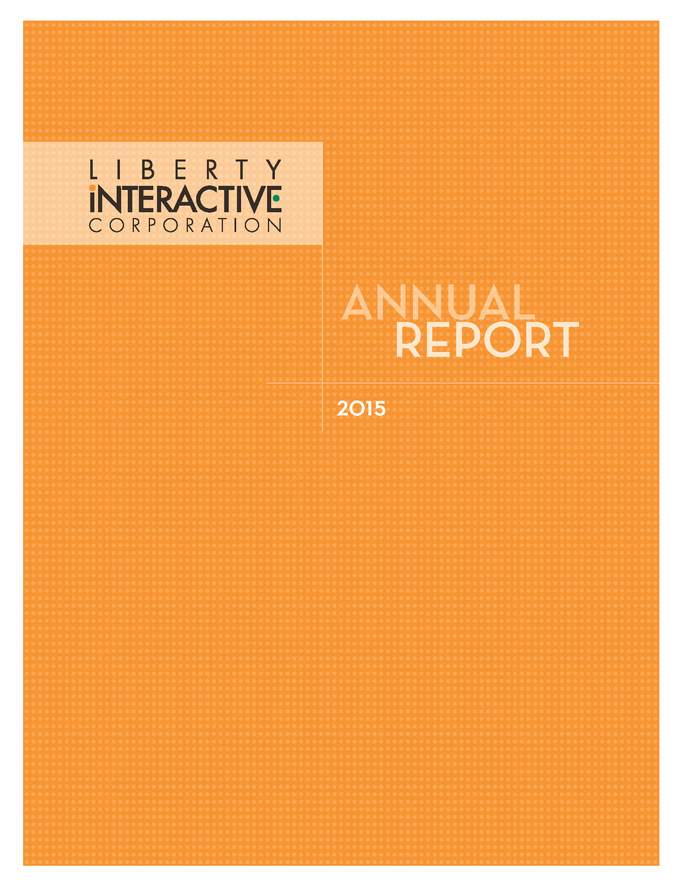
[LOGO]

CONTENTS TABLE OF LETTER TO SHAREHOLDERS ......................................... 1 STOCK PERFORMANCE .................................................. 3 INVESTMENT SUMMARY................................................ 6 FINANCIAL INFORMATION ........................................... F1 CORPORATE DATA ............................... Inside Back Cover
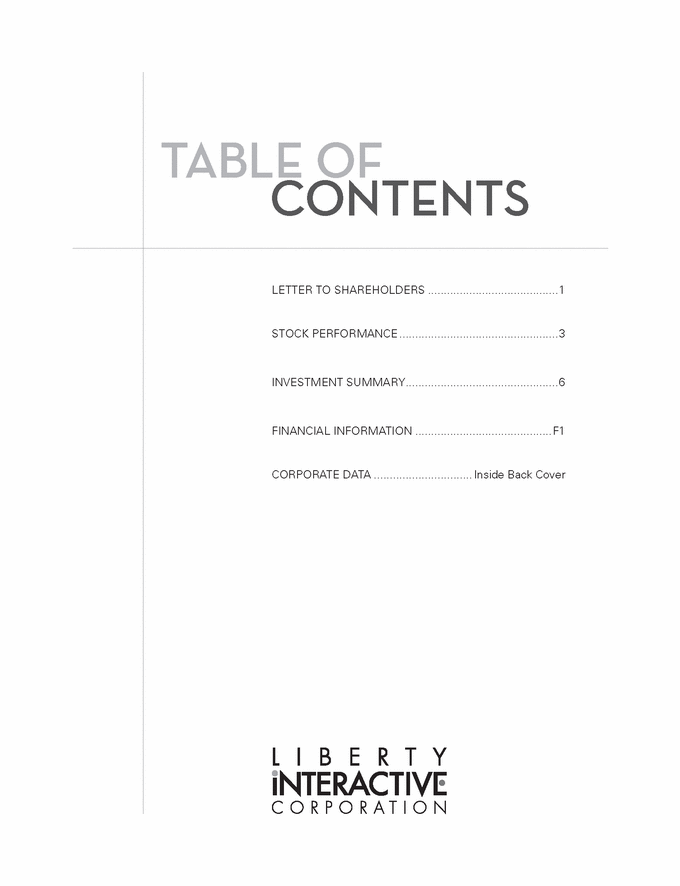
Certain statements in this Annual Report constitute forward-looking statements within the meaning of the Private Securities Litigation Reform Act of 1995, including statements regarding our business, product and marketing strategies; new service offerings; revenue growth at QVC, Inc.; the expected benefits and synergies from the acquisition of zulily; the recoverability of our goodwill and other long-lived assets; our projected sources and uses of cash; and the anticipated impact of certain contingent liabilities related to legal and tax proceedings and other matters arising in the ordinary course of business. In particular, statements in our “Letter to Shareholders” and under “Management’s Discussion and Analysis of Financial Condition and Results of Operations” and “Quantitative and Qualitative Disclosures About Market Risk” contain forward-looking statements. Where, in any forward-looking statement, we express an expectation or belief as to future results or events, such expectation or belief is expressed in good faith and believed to have a reasonable basis, but there can be no assurance that the expectation or belief will result or be achieved or accomplished. The following include some but not all of the factors that could cause actual results or events to differ materially from those anticipated: • customer demand for our products and services and our ability to adapt to changes in demand; • competitor responses to our products and services; • changes in the nature of key strategic relationships with partners, distributors, suppliers and vendors; • domestic and international economic and business conditions and industry trends; • consumer spending levels, including the availability and amount of individual consumer debt; • increased digital TV penetration and the impact on channel positioning of our programs; • the levels of online traffic to our businesses’ websites and our ability to convert visitors into consumers or contributors; • changes in distribution and viewing of television programming, including the expanded deployment of personal video recorders, video on demand and IP television and their impact on home shopping programming; • rapid technological changes; • uncertainties inherent in the development and integration of new business lines and business strategies; • our future financial performance, including availability, terms and deployment of capital; • the regulatory and competitive environment of the industries in which we operate; • failure to protect the security of personal information about our customers, subjecting us to potentially costly government enforcement actions or private litigation and reputational damage; • our ability to successfully integrate and recognize anticipated efficiencies and benefits from the businesses we acquire; • the ability of suppliers and vendors to deliver products, equipment, software and services; • the outcome of any pending or threatened litigation; • availability of qualified personnel; • threatened terrorist attacks, political unrest in international markets and ongoing military action around the world; • our ability to complete the proposed spin-off of CommerceHub, Inc. and split-off of Liberty Expedia Holdings, Inc.; and • changes in, or failure or inability to comply with, government regulations, including, without limitation, regulations of the Federal Communications Commission, and adverse outcomes from regulatory proceedings; • fluctuations in foreign currency exchange rates. These forward-looking statements and such risks, uncertainties and other factors speak only as of the date of this Annual Report, and we expressly disclaim any obligation or undertaking to disseminate any updates or revisions to any forward-looking statement contained herein, to reflect any change in our expectations with regard thereto, or any other change in events, conditions or circumstances on which any such statement is based. When considering such forward-looking statements, you should keep in mind any risk factors identified and other cautionary statements contained in our publicly filed documents, including our most recent Forms 10-K and 10-Q. Such risk factors and statements describe circumstances which could cause actual results to differ materially from those contained in any forward-looking statement. This Annual Report includes information concerning public companies in which we have non-controlling interests that file reports and other information with the SEC in accordance with the Securities Exchange Act of 1934, as amended. Information contained in this Annual Report concerning those companies has been derived from the reports and other information filed by them with the SEC. If you would like further information about these companies, the reports and other information they file with the SEC can be accessed on the Internet website maintained by the SEC at www.sec.gov. Those reports and other information are not incorporated by reference in this Annual Report. ANNU AL REPOR T 20 15
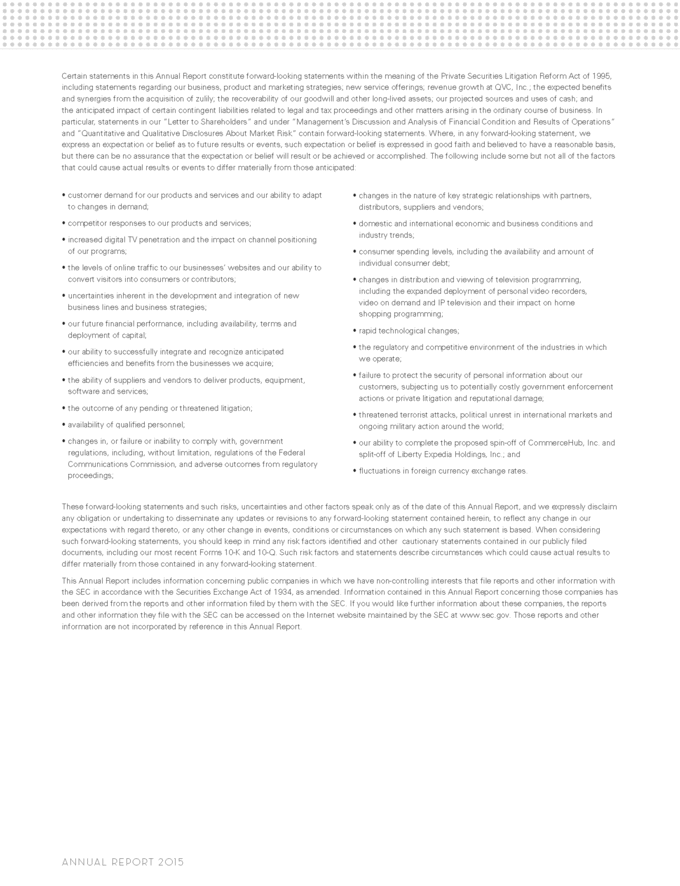
LETTER T O SHAREHOLDER S good times AND bad; we can adjust our business mix more nimbly than other retailers; product and profit margins are increasing • Shipping pressures from customers demanding free and fast › Reality—less pressure if total value is seen as compelling, customers factor in QVC’s honest pricing and fair shipping rates; exclusivity creates reasons to buy; same or next day shipping matters less when purchases are unplanned; new US shipping policies introduced in 2015 targeted at new customers • Customers will migrate to Amazon › Reality—our customers are already Amazon customers, and it offers a complementary service; we still have significant share to take from brick and mortar retailers • Cord cutting will pressure QVC’s business › Reality—unlikely to be material for many years and cord cutting is done by younger, male demographic; viewership is increasing; over-the-top (OTT) likely provides more opportunity than risk QVC truly is a differentiated shopping experience, and we will continue to exploit the advantages provided by our unique model. We were pleased to complete the acquisition of zulily in October of 2015. The zulily team built an impressive business which grew to over $1 billion in revenue in less than five years, with over 5 million active customers and very attractive free cash flow characteristics. The customer value propositions, engagement models and cultures of QVC and zulily are remarkably similar, and we couldn’t be more pleased with zulily’s recent results and how well the teams are working together. While the two companies offer similar value propositions, the customer overlap is very small at just 6%, which offers a large cross-selling opportunity. We’ve already begun to address the low-hanging fruit, such as featuring QVC’s TSV on zulily or sharing QVC hosts’ zulily experiences on-air, and are seeing positive results. zulily sends over 20 million emails per day, offering 100 largely boutique events to its loyal user base. Its best-in-class personalization technology and ability to make real time adjustments to the website are remarkable, and we look forward to extending these capabilities to the QVC platform. Darrell Cavens continues to lead the charge at zulily, and we added the expertise of co-founder, Mark Vadon, to the Liberty Interactive board. In 2015, we returned $785 million to shareholders through share repurchases and raised QVC, Inc.’s leverage to 2.8x by using cash for a portion of the zulily acquisition. We feel very comfortable in our ability to maintain share continued on page 2 Dear Fellow Shareholders, While we didn’t have any “major” structural changes this year at Liberty Interactive, the level of activity was still quite high. We did our first major acquisition to complement QVC, invested the majority of the available cash of Liberty Ventures and announced the separations of CommerceHub and Liberty Expedia Holdings. All of these major actions, along with smaller ones, were taken with the goal of providing clarity and driving value over the long-term. QVC GROUP 2015 and the beginning of 2016 have proven to be a very uneven retail environment. Despite this challenging macro-economic overlay, QVC continues to deliver, by sticking to its strategy of providing a differentiated shopping experience built on the pillars of discovery, stories, people and service. Over the past year, Mike George and his teams have continued to evolve and grow the business. In Q4 of 2015, both eCommerce revenue and mobile order penetration exceeded 50% for the first time in the US. On the technology front, the QVC app on Apple TV has been hailed as an innovative example of the future of interactive television and eCommerce. In many ways, 2015 was a year of meaningful, transformative investments for QVC, keeping Mike and his team incredibly busy while setting the stage for an exciting road ahead. The One Q transformation was activated, leveraging the best of QVC’s worldwide capabilities and sharing these practices across markets. zulily joined the QVC family, as we will discuss in more detail below. QVC’s shipping and handling approach was revamped with new policies introduced in the US and the announced launch of the first West Coast distribution center to open later this year. The team announced the planned startup of a Global Business Services center in Krakow Poland, and the launch of France extends QVC’s reach to its seventh market. Suffice it to say—it was a busy year in West Chester, PA. Perhaps most impressive of all, QVC saw local currency revenue growth in every one of its countries in 2015. The QVC team did a fantastic job of addressing the perceived risks to the QVC business at its investor meeting in May, and we think they deserve retelling here: • Customer growth—new customers are harder to get or of lower value › Reality—new customer acquisition and value are stable and improving • Weak promotional environment undermines growth and profitability › Reality—QVC has a proven record of growth in both ANNU AL REPOR T 20 15 1
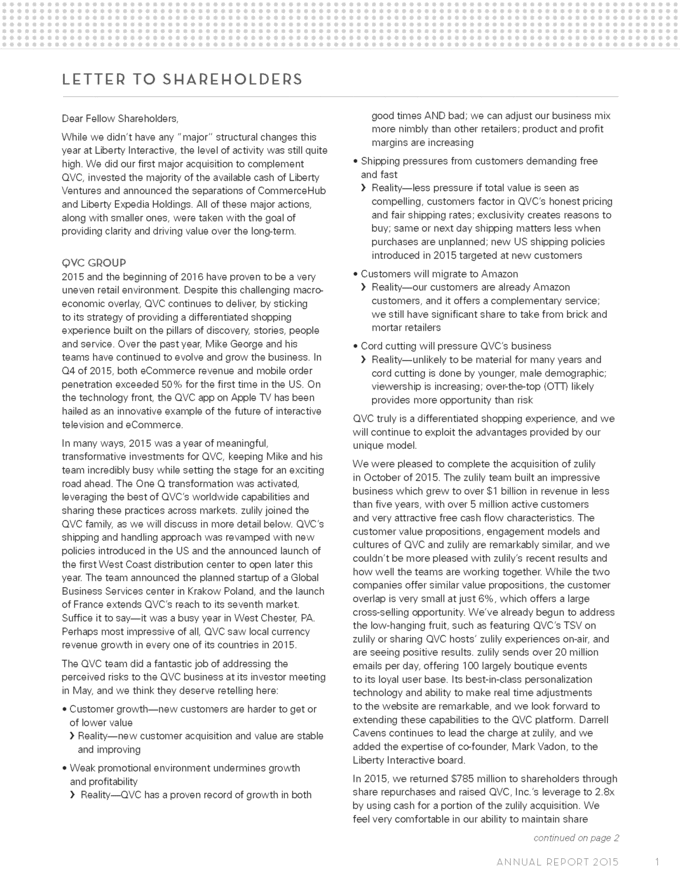
LETTER T O SHAREHOLDER S, C ONTINUED repurchases at a level approximately equal to free cash flow and naturally de-lever with business growth. aligned through our equity ownership and compensation; we maintain the shared, focused goal of maximizing shareholder value. LIBERTY VENTURES GROUP For Liberty Ventures, change is a constant. As planned, we previously accumulated a significant amount of cash and were waiting for that transformational deal. We were pleased to find it with our investment in Liberty Broadband as part of Charter’s merger with Time Warner Cable completed in May 2016. The structure of this transaction also demonstrated our ability to raise additional capital with strong partners in order to write a large check, a key differentiator for us in today’s deal-making landscape. We are happy to be players in cable consolidation and backers of Tom Rutledge and the team at Charter—early returns are promising. We continue to execute on our strategy, and in the past year, we sold Backcountry.com and announced the spin-off of CommerceHub and the split-off of Liberty Expedia Holdings. We think this will further rationalize the structure and reduce trading discounts with the added upside of providing additional cash for Liberty in the form of a dividend from Liberty Expedia. Although our cash position was reduced by our aforementioned investment in Liberty Broadband, we have the ability to raise significant capital against our vast public portfolio of securities to bolster our cash position should we need to do so. We’ve long maintained that CommerceHub was a special company with great potential. Recent disclosure of CommerceHub financials substantiates these claims. Over the past few years, Frank Poore has built CommerceHub into a powerful eCommerce fulfillment platform serving approximately 9,500 trading partners. This powerful network of retailers, distributors, brands and marketplaces facilitated an estimated $11.6 billion of gross merchandise value in 2015. CommerceHub’s core solution allows retailers to radically increase online assortment through so-called “virtual inventory”, while avoiding the onerous capital costs of carrying physical inventory and building warehouses. With the winds of eCommerce growth at its back and one of the deepest competitive moats we’ve observed, CommerceHub is well positioned for life as a newly public company. Unfortunately, the discount to net asset value persists and has actually widened. We get questions on this often and, honestly, we are scratching our heads as well. Liberty Ventures has always been one of our more complicated equities, but we feel it’s probably in the simplest form it’s ever been and on the path to further simplification. We will work to decrease this discount; our interests are LOOKING AHEAD We are pleased with the progress we made over the last year but understand we still have work to do for the market to understand and appreciate the QVC model and to reduce the complexity and trading discount at Liberty Ventures. We are grateful for your continued trust in us as we evolve the structure of Liberty Interactive. We look forward to seeing many of you at this year’s annual investor meeting, which will take place on November 10th at the TimesCenter at 242 West 41st Street in New York City. We appreciate your ongoing support. Very truly yours, Gregory B. Maffei President & Chief Executive Officer John C. Malone Chairman of the Board 2 ANNU AL REPOR T 20 15
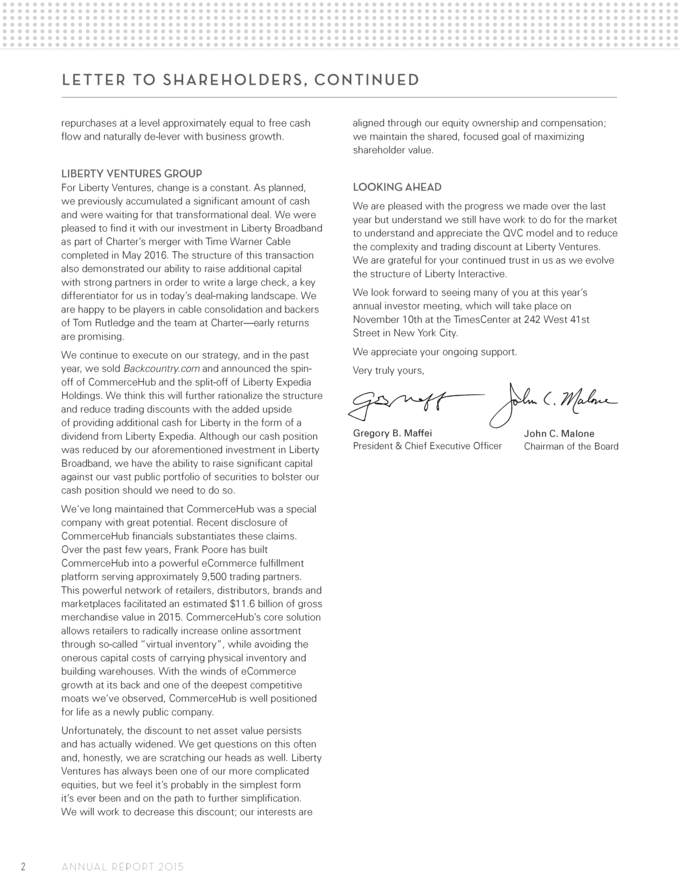
S T OCK PERFORMANCE The following graph compares the percentage change in the cumulative total shareholder return on the Series A and Series B QVC Group common stock (formerly referred to as the Series A and Series B Liberty Interactive common stock) from December 31, 2010 through December 31, 2015, to the percentage change in the cumulative total return on the S&P 500 Index and the S&P Retail Index. The Series A and Series B QVC Group stock performance includes (i) the performance of the pro rata portion of the shares of the Liberty Ventures Group, which began trading on August 10, 2012, (ii) the impact of the Liberty Ventures Group rights offering, (iii) the spin-off of Liberty TripAdvisor Holdings, Inc., which was completed on August 27, 2014, assuming a sale of the resulting Liberty TripAdvisor shares on the one-year anniversary of the spin-off and reinvestment of the proceeds in Liberty Ventures common stock and (iv) the distribution of Series A and Series B Liberty Ventures shares to QVC Group shareholders as part of the reattribution transaction (ex-dividend date of October 15, 2014). Note: Trading data for all Series B shares is limited as they are thinly traded. 3 ANNU AL REPOR T 20 15 12/31/2010 12/31/2011 12/31/2012 12/31/2013 12/31/2014 12/31/2015 Series A QVC Group $100.00 $102.85 $149.60 $234.04 $271.30 $271.71 Series B QVC Group $100.00 $104.50 $150.74 $237.05 $276.63 $274.32 S&P 500 Index $100.00 $100.00 $113.40 $146.97 $164.71 $162.52 S&P Retail Index $100.00 $96.31 $100.89 $120.40 $144.53 $125.78
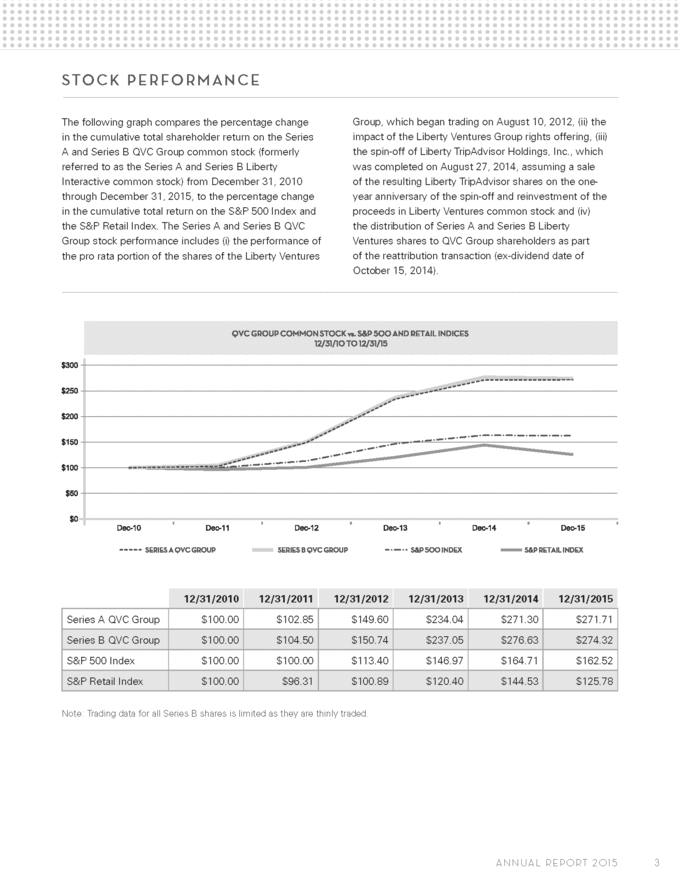
S T OCK PERFORMANCE The following graph compares the percentage change in the cumulative total shareholder return on the Series A and Series B Liberty Ventures common stock from August 10, 2012 through December 31, 2015, to the percentage change in the cumulative total return on the S&P 500 Index and the S&P 500 Information Technology Index. Liberty Ventures Group performance includes the spin-off of Liberty TripAdvisor Holdings, Inc., which was completed on August 27, 2014, assuming a sale of the resulting Liberty TripAdvisor shares on the one-year anniversary of the spin-off and reinvestment of the proceeds in Liberty Ventures common stock. Note: LVNTA began trading on 8/10/12, LVNTB first priced on 8/15/12. Liberty TripAdvisor Series A and B shares began trading “regular way” on 8/28/14. Trading data for all Series B shares is limited as they are thinly traded. 4 ANNU AL REPOR T 20 15 8/10/2012 12/31/2012 12/31/2013 12/31/2014 12/31/2015 Series A Liberty Ventures $100.00 $150.58 $272.42 $287.20 $327.84 Series B Liberty Ventures $100.00 $144.12 $256.43 $272.15 $309.71 S&P 500 Index $100.00 $101.45 $131.47 $146.45 $145.39 S&P 500 Information Technology Index $100.00 $96.24 $121.49 $143.58 $149.71
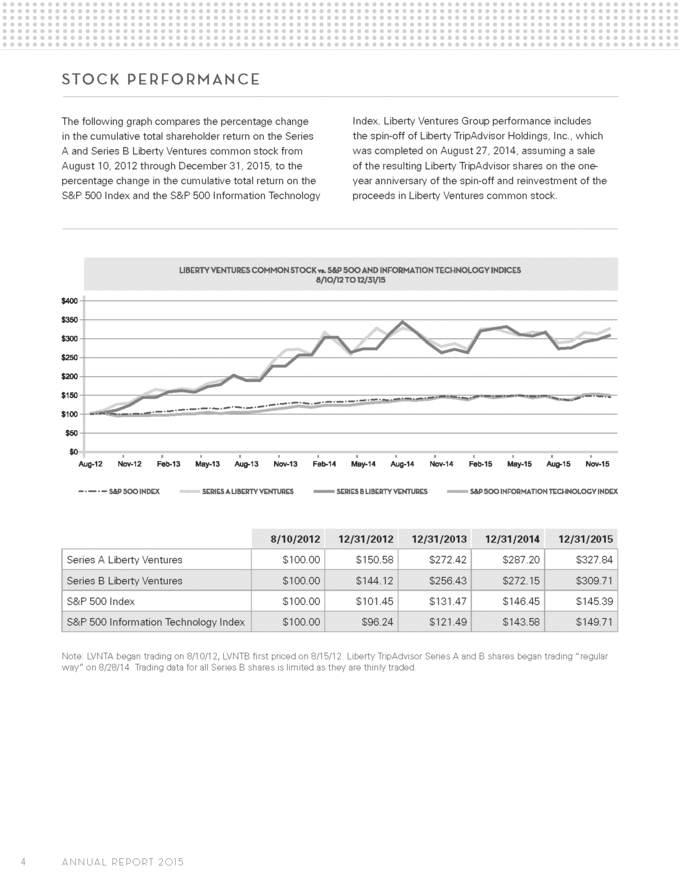
S T OCK PERFORMANCE The following graph compares the percentage change in the cumulative total shareholder return on Series A and Series B QVC Group common stock (formerly referred to as the Series A and Series B Liberty Interactive common stock) from August 10, 2012 (the day following the creation of the Liberty Ventures tracking stock) through December 31, 2015, to the percentage change in the cumulative total return on the S&P 500 Index and the S&P 500 Retail Index. QVC Group performance includes the distribution of Series A and Series B Liberty Ventures shares to QVC Group shareholders as part of the reattribution transaction (ex-dividend date of October 15, 2014). Note: Trading data for all Series B shares is limited as they are thinly traded. ANNU AL REPOR T 20 15 5 8/10/2012 12/31/2012 12/31/2013 12/31/2014 12/31/2015 Series A QVC Group $100.00 $112.33 $167.52 $198.53 $192.54 Series B QVC Group $100.00 $113.04 $170.38 $203.19 $194.79 S&P 500 Index $100.00 $101.45 $131.47 $146.45 $145.39 S&P Retail Index $100.00 $91.43 $109.10 $130.97 $113.98
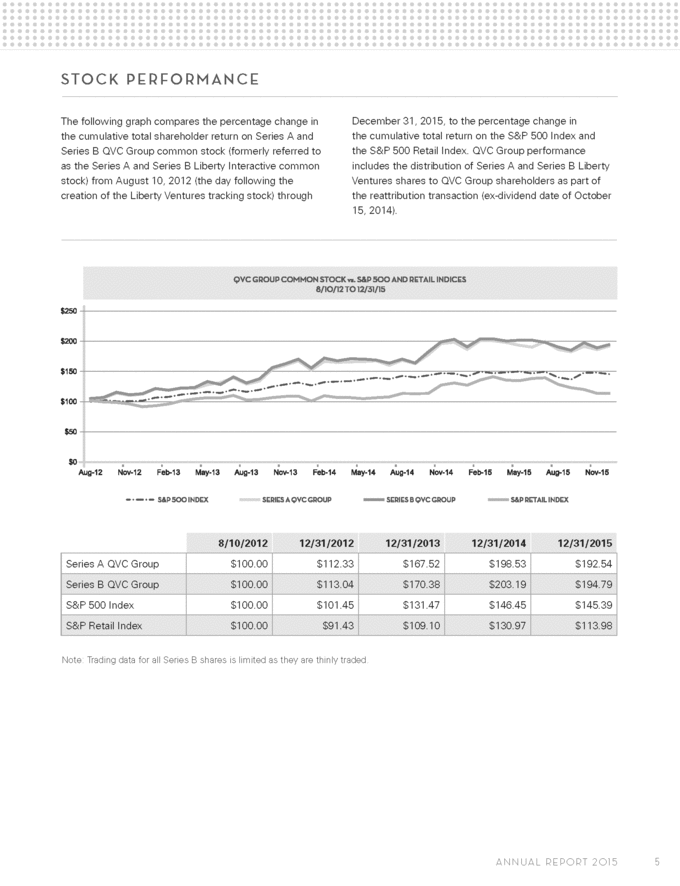
INVES TMENT SUMMAR Y Based on publicly available information as of May 31, 2016 — libertyinteractive.com/asset-list.aspx Liberty Interactive Corporation operates and owns interests in a broad range of digital commerce businesses. Those interests are currently attributed to two tracking stock groups: the QVC Group and Liberty Ventures Group. The following tables set forth some of Liberty Interactive Corporation’s assets that are held directly and indirectly through partnerships, joint ventures, common stock investments and/or instruments convertible into common stock. Ownership percentages in the tables are approximate and, where applicable, assume conversion to common stock by Liberty Interactive Corporation and, to the extent known by Liberty Interactive Corporation, other holders. In some cases, Liberty Interactive Corporation’s interest may be subject to buy/sell procedures, repurchase rights or dilution. 6 ANNU AL REPOR T 20 15 Q V C GROUP ENTITY DESCRIPTION OF OPERATING BUSINESS ATTRIBUTED SHARE COUNT (1) (in millions) ATTRIBUTED OWNERSHIP (2) HSN, Inc. (NASDAQ: HSNI) An interactive entertainment and lifestyle retailer offering an assortment of products through television home shopping programming on HSN television networks and HSN.com, among other channels and mediums. 20.0 38% QVC, Inc. One of the world’s leading video and digital commerce retailers, offering a curated collection of brands to millions of customers around the globe each day through broadcast, Internet, and mobile sales outlets. N/A 100% zulily, llc A leading pure-play online retailer focused on delivering a boutique experience every day—all at incredible prices. zulily offers a highly personalized experience through its innovative technology and always-fresh curated collection of products for the whole family, including clothing, home décor, toys, gifts and more. N/A 100%
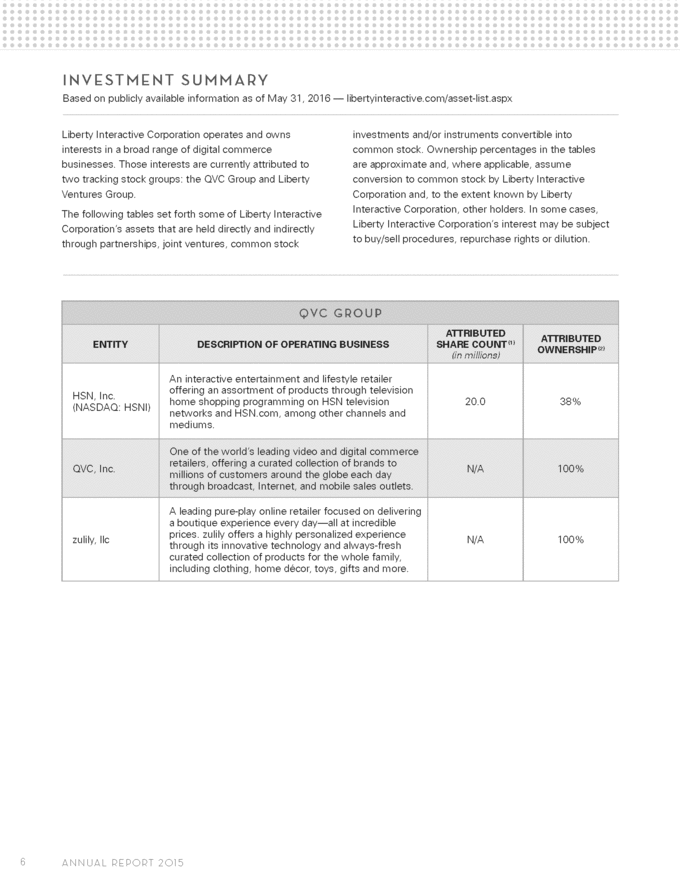
INVES TMENT SUMMAR Y OWNERSHIP (2) solutions to residential and commercial customers. ANNU AL REPOR T 20 15 7 LIBER TY VENTURES GROUP ENTITY DESCRIPTION OF OPERATING BUSINESS ATTRIBUTED SHARE COUNT (1) (in millions) ATTRIBUTED Bodybuilding.com, LLC An internet retailer of sports, fitness and dietary supplements and other health and wellness products. Also hosts an online site where visitors can network and exchange information related to bodybuilding. N/A 100% Brit Media, Inc. (Brit + Co) Online lifestyle platform offering content, e-classes and eCommerce to millennial women. N/A 7% Charter Communications, Inc. (NYSE: CHTR) One of the largest providers of cable services in the United States, offering a variety of entertainment, information and communications 5.4(3) 2% Commerce Technologies, Inc. (CommerceHub) Cloud-based e-commerce fulfillment and marketing software platform of integrated supply, demand and delivery solutions for large retailers, online marketplaces and digital marketing channels, as well as consumer brands, manufacturers, distributors and other market participants. N/A 99% Evite, Inc. Leading online invitation and social event planning service on the web. N/A 100% Expedia, Inc. (NASDAQ: EXPE) Empowers business and leisure travelers with the tools and information needed to research, plan, book and experience travel. It also provides wholesale travel to offline retail travel agents. Expedia’s main brands include: Expedia.com®, Hotels.com®, Travelocity®, Hotwire.com™, Classic Vacations®, trivago, HomeAway and Orbitz Worldwide. 23.6(4) 16%(5) FTD Companies, Inc. (NASDAQ: FTD) A premier floral and gifting company with a presence in the United States, Canada, the United Kingdom and the Republic of Ireland. 10.2 37% giggle, Inc. A trusted resource for today’s design-conscious new parent with retail stores around the United States, an extensive e-commerce business, a licensed products business, and a signature line of giggle baby products. N/A 32% Interval Leisure Group, Inc. (NASDAQ: IILG) Leading global provider of non-traditional lodging, encompassing a portfolio of leisure businesses from vacation exchange and rental to vacation ownership. 16.6 13%
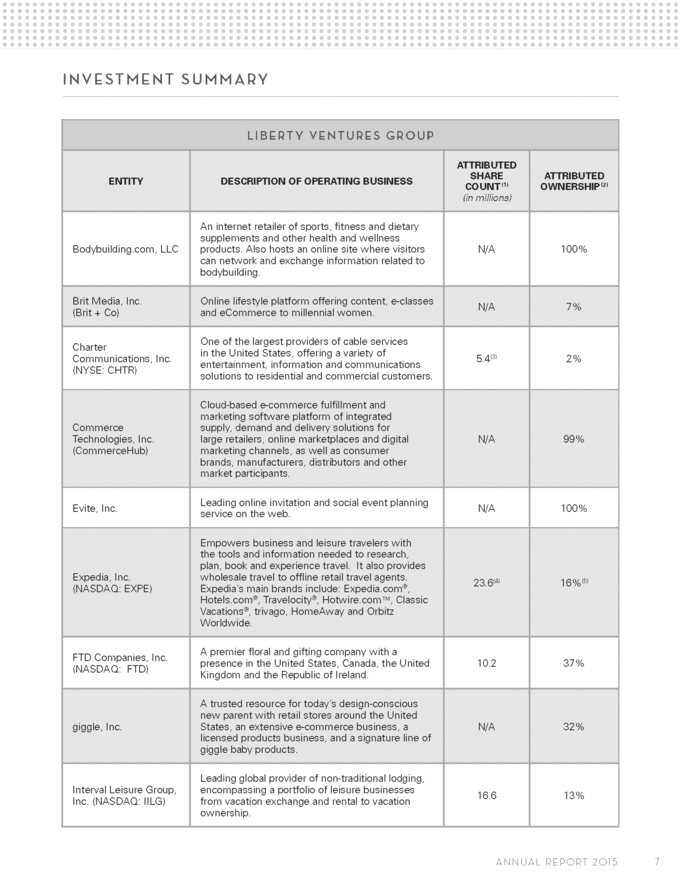
INVES TMENT SUMMAR Y OWNERSHIP (2) 1) Applicable only for publicly-traded entities. 2) Represents undiluted ownership interest. 3) Liberty Interactive Corporation has granted to Liberty Broadband Corporation a proxy and a right of first refusal with respect to its Charter shares. 4) Includes 12.8m Series B shares. 5) Liberty Interactive Corporation owns approximately 16% of Expedia common stock representing an approximate 52% voting interest. The Chairman of Expedia currently has the authority to vote these shares. 8 ANNU AL REPOR T 20 15 LIBER TY VENTURES GROUP ( C ONTINUED ) ENTITY DESCRIPTION OF OPERATING BUSINESS ATTRIBUTED SHARE COUNT (1) (in millions) ATTRIBUTED Liberty Broadband Corporation (NASDAQ: LBRDK) Liberty Broadband Corporation holds ownership interests in Charter Communications, Inc. and TruePosition, Inc. 42.7 24% LendingTree, Inc. (NASDAQ: TREE) An online lending and real estate business that matches consumers with lenders and loan brokers. 2.8 23% Liberty Israel Venture Fund II, LLC Investment fund focused on Israeli technology companies. N/A 80% Quid, Inc. Software company that combines natural language processing and visualization techniques to make it easy to analyze very large amounts of data in a relatively short amount of time. N/A 18% Time Inc. (NYSE: TIME) One of the largest media companies in the world, with influential brands such as TIME, PEOPLE, Sports Illustrated, InStyle, Real Simple, Wallpaper*, Travel + Leisure and Food & Wine. 0.5 <1% Time Warner Inc. (NYSE: TWX) Media and entertainment company whose businesses include cable networks and digital media properties, premium pay, streaming and basic tier television services and television, feature film, home video and video game production and distribution. 4.3 <1%
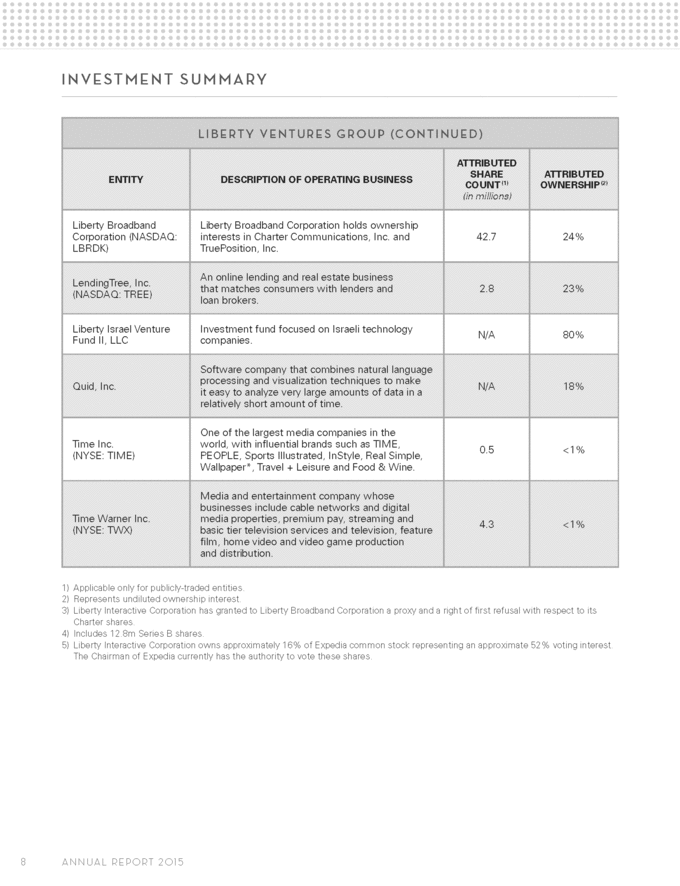
THIS PA GE HAS BEEN INTENTIONAL LY LEFT BLANK.

THIS PA GE HAS BEEN INTENTIONAL LY LEFT BLANK.

Market for Registrant's Common Equity, Related Stockholder Matters and Issuer Purchases of Equity Securities. Market Information In order to bring Liberty into compliance with a Nasdaq listing requirement regarding the minimum number of publicly held shares of the Series B Liberty Ventures common stock, on April 11, 2014, a two for one stock split of Series A and Series B Liberty Ventures common stock was effected by means of a dividend that was paid on April 11, 2014 of one share of Series A or Series B Liberty Ventures common stock to holders of each share of Series A or Series B Liberty Ventures common stock, respectively, held by them as of 5:00 pm, New York City time, on April 4, 2014. Accordingly, the high and low sales prices of LVNTA and LVNTB common stock have been retroactively restated in the table below. On October 3, 2014, Liberty reattributed from the Interactive Group to the Ventures Group approximately $1 billion in cash and its Digital Commerce companies. Subsequent to the reattribution, the Interactive Group is now referred to as the QVC Group. In connection with the reattribution, the Liberty Interactive tracking stock trading symbol “LINTA” was changed to "QVCA" and the "LINTB" trading symbol to "QVCB," effective October 7, 2014. Effective June 4, 2015, the name of the “Liberty Interactive common stock” was changed to the “QVC Group common stock.” Each series of our common stock trades on the Nasdaq Global Select Market. The following table sets forth the range of high and low sales prices of shares of our common stock for the years ended December 31, 2015 and 2014. QVC Group Series A (QVCA) Series B (QVCB) High Low High Low 2014 First quarter (1) Second quarter (1) Third quarter (1) Fourth quarter (1) 2015 First quarter Second quarter Third quarter Fourth quarter $ $ $ $ 30.12 30.68 30.23 30.60 25.58 27.76 26.95 22.37 30.00 31.10 30.17 31.40 25.01 27.70 27.04 23.73 $ $ $ $ 29.73 29.70 31.62 28.71 27.03 27.01 24.72 25.01 30.10 30.06 30.75 28.26 27.45 27.91 25.80 26.02 F-1
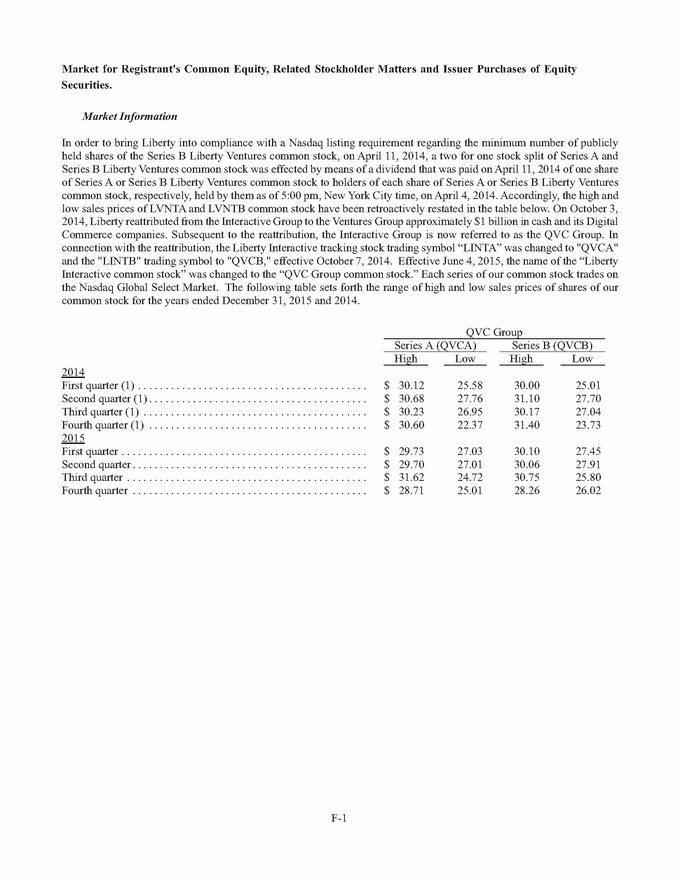
Liberty Ventures Series A (LVNTA) Series B (LVNTB) High Low High Low 2014 First quarter Second quarter (April 1 - April 11) Second quarter (April 12 - June 30) (2) Third quarter (July 1 - August 27) (3) Third quarter (August 28 - September 30) (3)Fourth quarter 2015 First quarter Second quarter Third quarter Fourth quarter $ $ $ $ $ $ 74.21 68.66 73.96 75.95 39.95 38.32 55.63 56.06 54.67 68.45 36.40 25.12 74.66 71.93 67.03 80.02 42.66 39.80 60.65 58.02 56.24 71.72 39.50 29.12 $ $ $ $ 42.39 45.43 43.78 45.39 35.01 38.87 35.49 39.79 40.63 43.57 43.65 45.31 36.04 36.92 38.03 40.27 (1) Previously reflected under the LINTA or LINTB ticker symbol, respectively, for the respective period through October 6, 2014. As discussed above and in the accompanying consolidated financial statements in Part II of this report, Liberty completed a two for one stock split on April 11, 2014 on its Series A and Series B Liberty Ventures common stock. As discussed in Part I of this report, the TripAdvisor Holdings Spin-Off was effected on August 27, 2014 as a pro-rata dividend of shares of TripAdvisor Holdings to the stockholders of Liberty’s Series A and Series B Liberty Ventures common stock. (2) (3) Holders As of January 31, 2016, there were 2,173 and 104 record holders of our Series A and Series B QVC Group common stock, respectively, and 1,653 and 83 record holders of our Series A and Series B Liberty Ventures common stock, respectively. The foregoing numbers of record holders do not include the number of stockholders whose shares are held nominally by banks, brokerage houses or other institutions, but include each such institution as one shareholder. Dividends We have not paid any cash dividends on our common stock, and we have no present intention of so doing. Payment of cash dividends, if any, in the future will be determined by our board of directors in light of our earnings, financial condition and other relevant considerations. Securities Authorized for Issuance Under Equity Compensation Plans Information required by this item will be included in an amendment to this Form 10-K that will be filed with the Securities and Exchange Commission on or before April 29, 2016. Purchases of Equity Securities by the Issuer Share Repurchase Programs On several occasions our board of directors has authorized a share repurchase program for our Series A and Series B QVC Group common stock. On each of May 5, 2006, November 3, 2006 and October 30, 2007 our board authorized the repurchase of $1 billion of Series A and Series B Liberty Interactive common stock for a total of $3 billion. These previous authorizations remained effective following the LMC Split-Off, notwithstanding the fact that the Liberty Interactive common stock ceased to be a tracking stock during the period following the LMC Split-Off and prior to the creation of our Liberty Ventures common stock in August 2012. On February 22, 2012 the board authorized the repurchase of an additional $700 million of Series A and Series B Liberty Interactive common. Additionally, on each of October 30, 2012 F-2
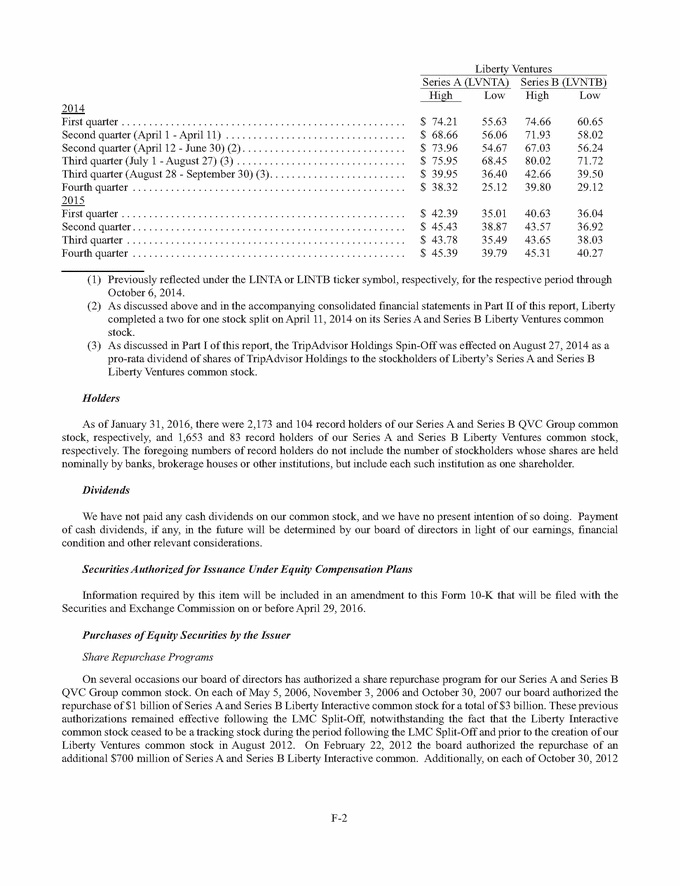
and February 27, 2014, the board authorized the repurchase of an additional $1 billion of Series A and Series B Liberty Interactive common stock. In connection with the TripAdvisor Holdings Spin-Off during August 2014, the board authorized $350 million for the repurchase of either the Liberty Interactive or Liberty Ventures tracking stocks. In October 2014, the board authorized the repurchase of an additional $650 million of Series A and Series B Liberty Ventures common stock. In August 2015, the board authorized the repurchase of an additional $1 billion of Series A or Series B QVC Group common stock. A summary of the repurchase activity for the three months ended December 31, 2015 is as follows: Series A QVC Group Common Stock (QVCA) (d) Maximum Number (or Approximate Dollar Value) of Shares that May Yet Be purchased Under the Plans or Programs (c) Total Number of Shares Purchased as Part of Publicly Announced Plans or Programs (a) Total Number of Shares Purchased (b) Average Price Paid per Share Period October 1 - 31, 2015 November 1 - 30, 2015 December 1 - 31, 2015 Total 2,665,212 2,669,832 4,092,300 $ $ $ 27.44 26.57 26.79 2,665,212 2,669,832 4,092,300 $ $ $ 1,130 million 1,059 million 949 million 9,427,344 9,427,344 21,049 shares of Series A QVC Group common stock and 4,633 shares of Series A Liberty Ventures common stock were surrendered by certain of our officers and employees to pay withholding taxes and other deductions in connection with the vesting of their restricted stock during the three months ended December 31, 2015. F-3
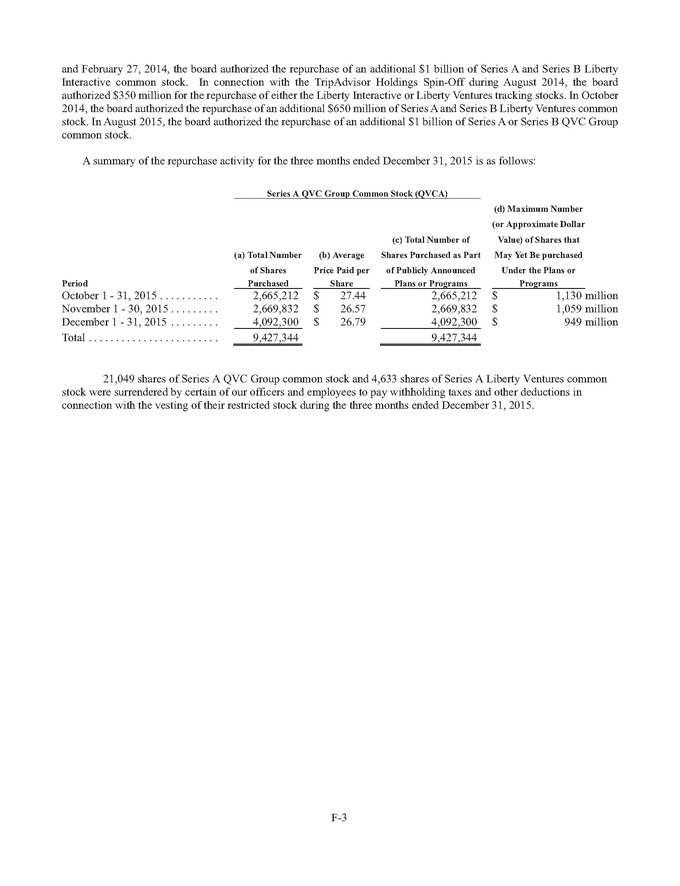
Selected Financial Data. The following tables present selected historical information relating to our financial condition and results of operations for the past five years. Certain prior period amounts have been reclassified for comparability with the current year presentation. The following data should be read in conjunction with our consolidated financial statements. December 31, 2015 2014 2013 2012 2011 amounts in millions Summary Balance Sheet Data: Cash and cash equivalents Investments in available-for-sale securities and other cost investments Investment in affiliates Intangibles not subject to amortization Assets of discontinued operations (1) (2) Total assets (2) Long-term debt Deferred income tax liabilities Liabilities of discontinued operations (1) (2) Equity (2) Noncontrolling interest (1) $ 2,449 2,306 902 2,291 846 $ $ $ $ $ $ $ $ $ $ 1,353 1,641 9,485 — 21,180 7,481 3,502 — 6,875 88 1,224 1,633 7,893 — 18,598 7,062 2,821 — 5,780 107 1,313 1,237 8,383 7,095 24,642 6,072 2,926 1,452 11,435 4,499 1,720 851 8,424 7,428 26,223 5,873 2,935 1,748 12,051 4,489 1,168 951 8,450 349 17,309 4,818 2,897 19 6,627 134 Years ended December 31, 2015 2014 2013 2012 2011 amounts in millions, except per share amounts Summary Statement of Operations Data: Revenue Operating income (loss). Interest expense. Share of earnings (losses) of affiliates Realized and unrealized gains (losses) on financial instruments, net Gains (losses) on transactions, net Gains (losses) on dilution of investments in affiliates Earnings (loss) from continuing operations (3): Liberty Capital common stock Liberty Interactive Corporation common stock QVC Group common stock. Liberty Ventures common stock $ $ $ $ $ $ $ 9,989 1,116 (360) (60) 114 110 314 10,499 1,188 (387) 39 (57) 74 (2) 10,219 1,136 (380) 33 (22) (1) 1 9,888 1,163 (466) 47 (351) 443 (5) 9,461 1,133 (426) 139 84 — 9 NA NA 674 237 NA NA 575 3 NA NA 500 54 NA 33 291 281 10 576 NA NA $ $ 911 578 554 605 586 Basic earnings (loss) from continuing operations attributable to Liberty Interactive Corporation stockholders per common share (4): Series A and Series B Liberty Capital common stock Series A and Series B Liberty Interactive Corporation common stock Series A and Series B QVC Group common stock Series A and Series B Liberty Ventures common stock Diluted earnings (loss) from continuing operations attributable to Liberty Interactive Corporation stockholders per common share (4): Series A and Series B Liberty Capital common stock Series A and Series B Liberty Interactive Corporation common stock Series A and Series B QVC Group common stock Series A and Series B Liberty Ventures common stock NA NA 1.35 1.61 NA NA 1.10 0.03 NA NA 0.88 0.74 NA — 0.48 4.26 0.12 0.88 NA NA $ $ NA NA 1.33 1.60 NA NA 1.09 0.03 NA NA 0.86 0.73 NA — 0.47 4.19 0.12 0.87 NA NA $ $ (1) On December 11, 2012, we acquired approximately 4.8 million additional shares of common stock of TripAdvisor, Inc. ("TripAdvisor") (an additional 4% equity ownership interest), for $300 million, along with the right to control the vote of the shares of TripAdvisor's common stock and class B common stock we own. Following the transaction we owned approximately 22% of the equity and 57% of the total votes of all classes of TripAdvisor common stock. On F-4
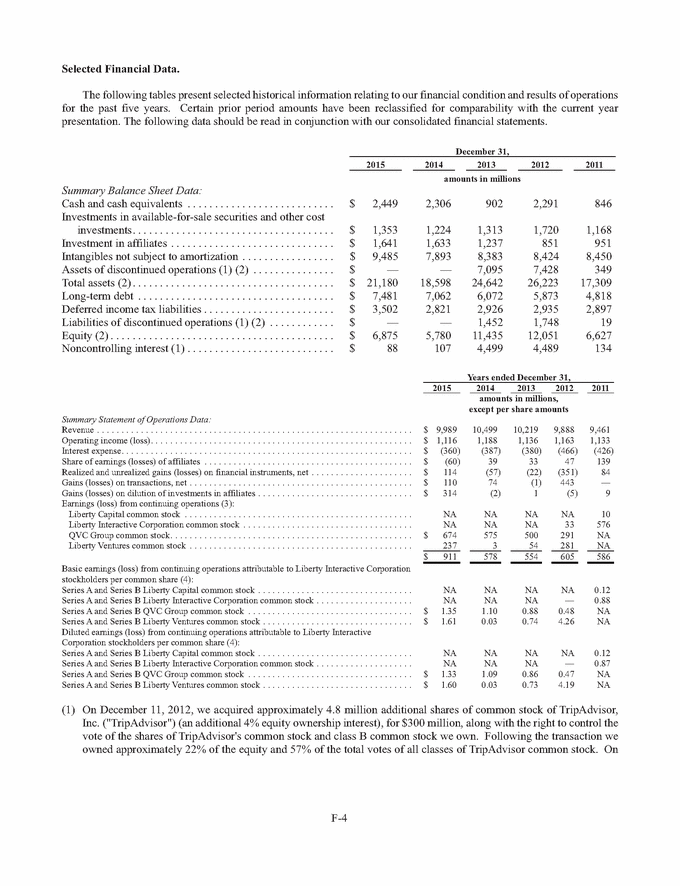
August 27, 2014, we completed the TripAdvisor Holdings Spin-Off. TripAdvisor Holdings is comprised of Liberty’s former interest in TripAdvisor as well as BuySeasons, Inc., Liberty’s former wholly-owned subsidiary, and corporate level debt. Following the completion of the TripAdvisor Holdings Spin-Off, Liberty and TripAdvisor Holdings operate as separate, publicly traded companies, and neither has any stock ownership, beneficial or otherwise, in the other. The consolidated financial statements of Liberty have been prepared to reflect TripAdvisor Holdings as discontinued operations. However, noncontrolling interest attributable to our former ownership interest in TripAdvisor is included in the noncontrolling interest line item in the consolidated balance sheet from the date of acquisition until the date of completion of the TripAdvisor Holdings Spin-Off. See note 6 of the accompanying consolidated financial statements for further details on the TripAdvisor Holdings Spin-Off. (2) On September 23, 2011, Liberty completed the LMC Split-Off. At the time of the LMC Split-Off, LMC owned all the assets, businesses and liabilities previously attributed to the Capital and Starz tracking stock groups. The LMC Split-Off was effected by means of a redemption of all of the Liberty Capital common stock and Liberty Starz common stock of Liberty in exchange for the common stock of LMC. (3) Includes earnings (losses) from continuing operations attributable to the noncontrolling interests of $42 million, $40 million, $45 million, $63 million and $53 million for the years ended December 31, 2015, 2014, 2013, 2012, and 2011, respectively. (4) Basic and diluted earnings per share have been calculated for Liberty Capital and Liberty Starz common stock for the period subsequent to March 3, 2008 through September 23, 2011. Basic and diluted EPS have been calculated for Liberty Interactive Corporation common stock for the periods from May 9, 2006 to August 9, 2012. Basic and diluted EPS have been calculated for QVC Group common stock and Liberty Ventures common stock subsequent to August 9, 2012. F-5
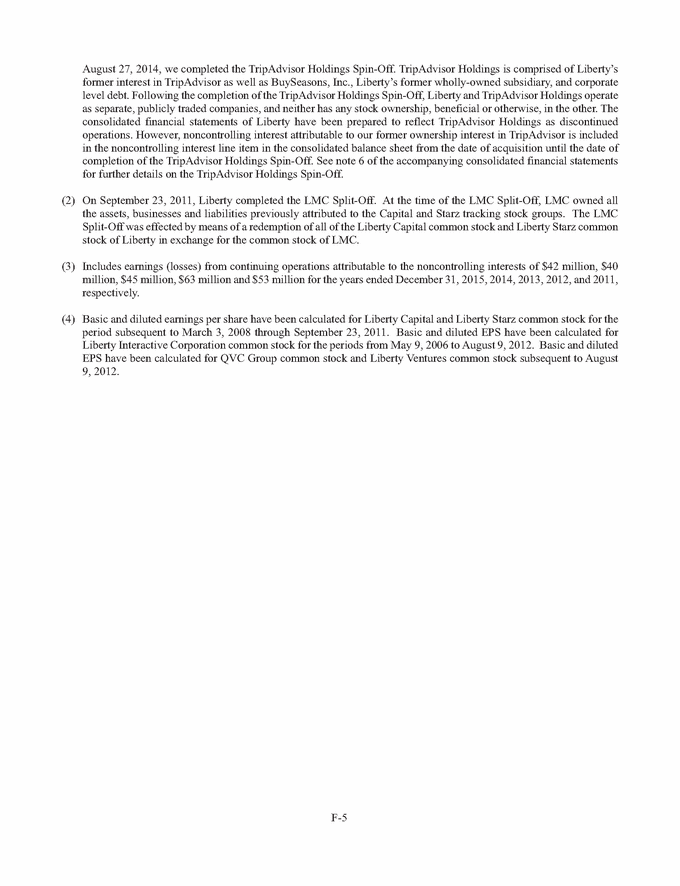
Management's Discussion and Analysis of Financial Condition and Results of Operations The following discussion and analysis provides information concerning our results of operations and financial condition. This discussion should be read in conjunction with our accompanying consolidated financial statements and the notes thereto. Overview We own controlling and non-controlling interests in a broad range of video and on-line commerce companies. Our largest business and reportable segment, is QVC, Inc. (“QVC”). QVC markets and sells a wide variety of consumer products in the United States and several foreign countries, primarily by means of its televised shopping programs and via the Internet through its domestic and international websites and mobile applications. On October 1, 2015, we acquired zulily, inc. (“zulily”) (now known as zulily, llc), an online retailer offering customers a fun and entertaining shopping experience with a fresh selection of new product styles launched every day. See note 5 of the accompanying consolidated financial statements for further details on the acquisition of zulily. Our “Corporate and Other” category includes entire or majority interests in consolidated subsidiaries, which operate on-line commerce businesses in a broad range of retail categories, ownership interests in unconsolidated businesses and corporate expenses. These consolidated subsidiaries include Bodybuilding.com, LLC ("Bodybuilding"), CommerceHub, Evite, Inc. (“Evite”), Provide Commerce, Inc. (“Provide”) (through December 31, 2014, see note 9 of the accompanying consolidated financial statements), and Backcountry.com, Inc. ("Backcountry") (through June 30, 2015, see note 6 of the accompanying consolidated financial statements), (collectively, the “Digital Commerce” businesses). Backcountry operates websites offering sports gear and clothing for outdoor and active individuals in a variety of categories. Bodybuilding manages websites related to sports nutrition, body building and fitness. CommerceHub provides a cloud-based platform for online retailers and their suppliers (manufacturers, and distributors) to sell products to consumers without physically owning inventory, or managing the fulfillment of those products. Evite is an online invitation and social event planning service on the Web. Provide operates an e-commerce marketplace of websites for perishable goods, including flowers, fruits and desserts, as well as upscale personalized gifts. We also hold ownership interests in Expedia, Inc., FTD Companies, Inc. (“FTD”), HSN, Inc., Interval Leisure Group, Inc. and LendingTree, which we account for as equity method investments; and we continue to maintain investments and related financial instruments in public companies such as Time Warner Inc. and Time Warner Cable Inc., which are accounted for at their respective fair market values. On August 9, 2012, Liberty completed the approved recapitalization of its common stock through the creation of the Liberty Interactive common stock and Liberty Ventures common stock as tracking stocks. In the recapitalization, each holder of Liberty Interactive Corporation common stock remained a holder of the same amount and series of Liberty Interactive common stock and received 0.05 of a share of the corresponding series of Liberty Ventures common stock, by means of a dividend, with cash issued in lieu of fractional shares of Liberty Ventures common stock. On October 3, 2014, Liberty reattributed from the QVC Group to the Ventures Group its Digital Commerce businesses which were valued at $1.5 billion, and approximately $1 billion in cash. In connection with the reattribution, each holder of Liberty Interactive common stock received 0.14217 of a share of the corresponding series of Liberty Ventures common stock for each share of Liberty Interactive common stock held as of the record date, with cash paid in lieu of fractional shares. The distribution date for the dividend was on October 20, 2014, and the Liberty Interactive common stock began trading ex-dividend on October 15, 2014 which resulted in an aggregate of 67.7 million shares of Series A and Series B Liberty Ventures common stock being issued. The reattribution of the Digital Commerce companies is presented on a prospective basis from the date of the reattribution in Liberty’s consolidated financial statements and attributed financial information, with October 1, 2014 used as a proxy for the date of the reattribution. Other than the issuance of Liberty Ventures shares in the fourth quarter of 2014, the reattribution had no consolidated impact on Liberty. Effective June 4, 2015, the name of the “Liberty Interactive common stock” was changed to the “QVC Group common stock.” The term "Ventures Group" does not represent a separate legal entity, rather it represents those businesses, assets and liabilities that have been attributed to that group. Following the reattribution, the Ventures Group is comprised primarily of our interests in Bodybuilding, CommerceHub, Evite, Provide (through December 31, 2014), Backcountry (through June F-6
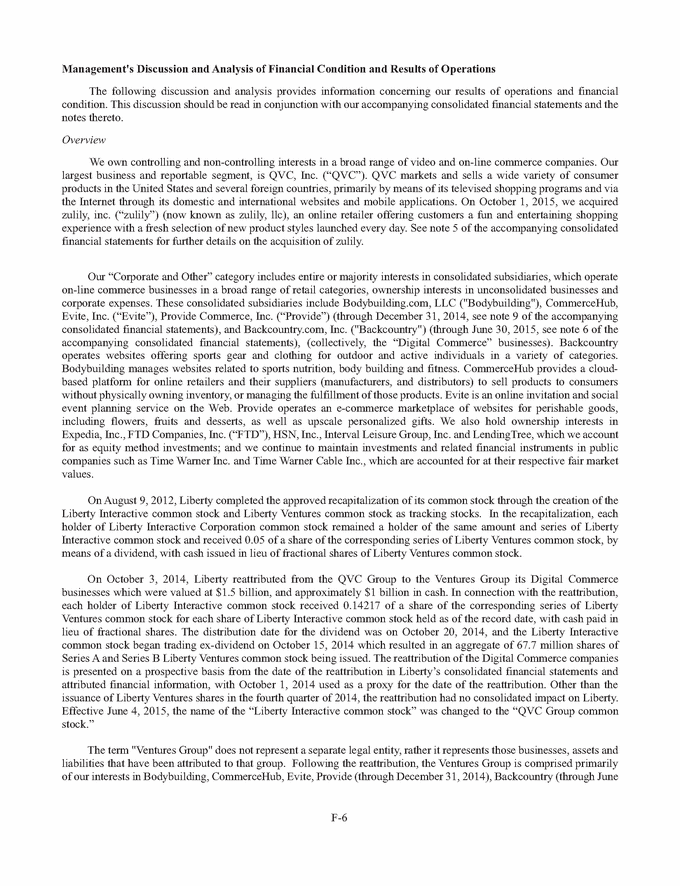
30, 2015), Expedia, Inc., FTD, Interval Leisure Group, Inc., LendingTree, investments in Time Warner Inc. and Time Warner Cable Inc., as well as cash in the amount of approximately $2,023 million (at December 31, 2015), including subsidiary cash. The Ventures Group also has attributed to it certain liabilities related to our Exchangeable Debentures and certain deferred tax liabilities. The Ventures Group is primarily focused on the maximization of the value of these investments and investing in new business opportunities. The term "QVC Group" does not represent a separate legal entity, rather it represents those businesses, assets and liabilities that have been attributed to that group. The QVC Group is primarily focused on our video operating businesses. Following the reattribution, the QVC Group has attributed to it the remainder of our businesses and assets, including our wholly-owned subsidiaries QVC and zulily (as of October 1, 2015), and our 38% interest in HSN, Inc. as well as cash in the amount of approximately $426 million (at December 31, 2015), including subsidiary cash. Disposals On August 27, 2014, Liberty completed the TripAdvisor Holdings Spin-Off. TripAdvisor Holdings is comprised of Liberty’s former 22% economic and 57% voting interest in TripAdvisor as well as BuySeasons, Liberty’s former wholly-owned subsidiary, and a corporate level net debt balance of $350 million. In connection with the TripAdvisor Holdings Spin-Off during August 2014, TripAdvisor Holdings drew down $400 million in margin loans and distributed approximately $350 million to Liberty. Concurrently with the margin loans, Liberty and TripAdvisor Holdings entered into a promissory note whereby TripAdvisor Holdings may request, if the closing price per share of TripAdvisor common stock were to fall below certain minimum values, up to $200 million in funds from Liberty. The TripAdvisor Holdings Spin-Off has been recorded at historical cost due to the pro rata nature of the distribution. Following the completion of the TripAdvisor Holdings Spin-Off, Liberty and TripAdvisor Holdings operate as separate, publicly traded companies, and neither has any stock ownership, beneficial or otherwise, in the other. The consolidated financial statements of Liberty have been prepared to reflect TripAdvisor Holdings as discontinued operations. Accordingly, the assets and liabilities, revenue, costs and expenses, and cash flows of the businesses, assets and liabilities owned by TripAdvisor Holdings at the time of the TripAdvisor Holdings Spin-Off have been excluded from the respective captions in the accompanying consolidated balance sheets, statements of operations, comprehensive earnings and cash flows in such consolidated financial statements. On December 31, 2014, Liberty sold Provide to FTD. Under the terms of the transaction, Liberty received approximately 10.2 million shares of FTD common stock representing approximately 35% of the combined company and approximately $145 million in cash. We recognized a gain of $75 million as a result of this transaction, which is included in the Gains (losses) on transactions, net line item in the consolidated statements of operations. Given our significant continuing involvement with FTD, Provide is not presented as a discontinued operation in the consolidated financial statements of Liberty. On June 30, 2015, Liberty sold Backcountry for aggregate consideration, including assumption of debt, amounts held in escrow, and a noncontrolling interest, of approximately $350 million. The sale resulted in a $105 million gain, which is included in “Gains (losses) on transactions, net” in the accompanying consolidated statements of operations. Backcountry is included in the Digital Commerce companies through June 30, 2015 and is not presented as a discontinued operation as the sale did not represent a strategic shift that has a major effect on Liberty’s operations and financial results. Strategies and Challenges QVC. QVC's goal is to become the preeminent global multimedia shopping community for people who love to shop, and to offer a shopping experience that is as much about entertainment and enrichment as it is about buying. QVC's objective is to provide an integrated shopping experience that utilizes all forms of media including television, the internet and mobile devices. QVC intends to employ several strategies to achieve these goals and objectives. Among these strategies are to (i) extend the breadth, relevance and exposure of the QVC brand; (ii) source products that represent unique quality and value; (iii) create engaging presentation content in televised programming, mobile and online; (iv) leverage customer loyalty and continue multi-platform expansion; and (v) create a compelling and differentiated customer experience. In addition, QVC expects to expand globally by leveraging its existing systems, infrastructure and skills in other countries around the world. F-7
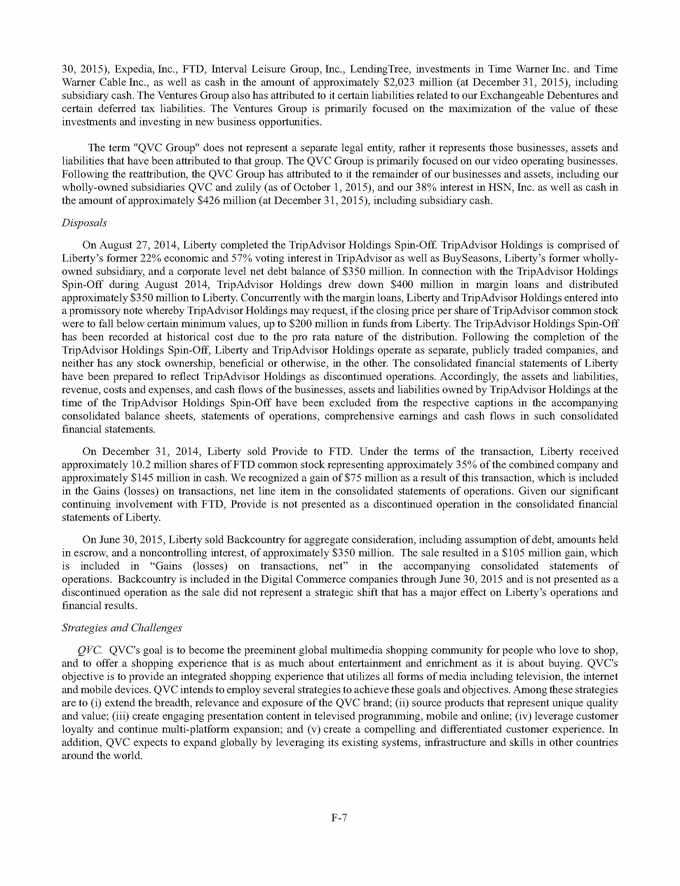
QVC's future net revenue growth will primarily depend on international expansion, sales growth from e-commerce and mobile platforms, additions of new customers from households already receiving QVC's television programming and increased spending from existing customers. QVC's future net revenue may also be affected by (i) the willingness of cable television and direct-to-home satellite system operators to continue carrying QVC's programming service; (ii) QVC's ability to maintain favorable channel positioning, which may become more difficult due to governmental action or from distributors converting analog customers to digital; (iii) changes in television viewing habits because of personal video recorders, video-on-demand and internet video services; and (iv) general economic conditions. The prolonged economic uncertainty in various regions of the world in which our subsidiaries and affiliates operate could adversely affect demand for QVC’s products and services since a substantial portion of QVC’s revenue is derived from discretionary spending by individuals, which typically falls during times of economic instability. Global financial markets continue to experience disruptions, including increased volatility and diminished liquidity and credit availability. If economic and financial market conditions in the U.S. or other key markets, including Japan and Europe, remain uncertain, persist, or deteriorate further, QVC’s customers may respond by suspending, delaying, or reducing their discretionary spending. A suspension, delay or reduction in discretionary spending could adversely affect revenue. Accordingly, QVC’s ability to increase or maintain revenue and earnings could be adversely affected to the extent that relevant economic environments remain weak or decline. Such weak economic conditions may also inhibit QVC’s expansion into new European and other markets. QVC is currently unable to predict the extent of any of these potential adverse effects. zulily. zulily’s objective is to be the leading online retail destination for moms. zulily’s goal is to be part of its customers’ daily routine, allowing them to visit zulily sites and discover a selection of fresh, new and affordable merchandise curated for them every morning. zulily intends to employ the following strategies to achieve these goals and objectives (i) acquire new customers; (ii) increase customer loyalty and repeat purchasing; (iii) add new vendors and strengthen existing vendor relationships; and (iv) invest in mobile platform. In addition, zulily expects to invest in and develop international markets. zulily has limited contractual assurances of continued supply, pricing or access to new products, and vendors could change the terms upon which they sell to zulily or discontinue selling to zulily for future sales at any time. As zulily grows, continuing to identify a sufficient number of new emerging brands and smaller boutique vendors may become more and more of a challenge. If zulily is not able to identify and effectively promote these new brands, it may lose customers to competitors. Even if zulily identifies new vendors, it may not be able to purchase desired merchandise in sufficient quantities on acceptable terms in the future, and products from alternative sources, if any, may be of a lesser quality or more expensive than those from existing vendors. In addition, larger national brands may offer products that are less unique, and it may be easier for zulily’s competitors to offer such products at prices or upon terms that may be compelling to consumers. An inability to purchase suitable merchandise on acceptable terms or to source new vendors could have an adverse effect on zulily’s business. To support its large and diverse base of vendors and its flash sales model that requires constantly changing products, zulily must incur costs related to its merchandising team, photography studios and creative personnel. As zulily grows, it may not be able to continue to expand its product offerings in a cost-effective manner. In addition, the variety in size and sophistication of zulily’s vendors presents different challenges to its infrastructure and operations. zulily’s emerging brands and smaller boutique vendors may be less experienced in manufacturing and shipping, which in the past has led to inconsistencies in quality, delays in the delivery of merchandise or additional fulfillment cost. zulily’s larger national brands may impose additional requirements or offer less favorable terms than smaller vendors related to margins and inventory ownership and risk and may also be unable to ship products timely. If zulily is unable to maintain and effectively manage its relationships with emerging brands and smaller boutique vendors or larger national brands, zulily’s business could be adversely affected. F-8
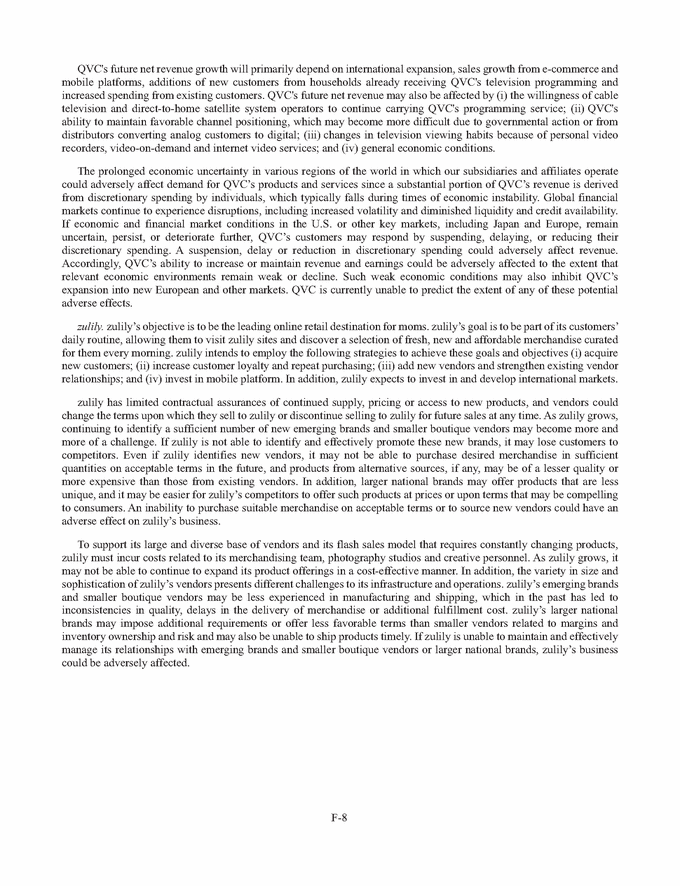
Results of Operations—Consolidated General. We provide in the tables below information regarding our Consolidated Operating Results and Other Income and Expense, as well as information regarding the contribution to those items from our principal reportable segments. The "Corporate and other" category consists of those assets or businesses which we do not disclose separately, including our Digital Commerce businesses, which are included in the QVC Group results through the date of reattribution and in the Ventures Group thereafter. For a more detailed discussion and analysis of the financial results of the principal reporting segment, see "Results of Operations - Businesses" below. Operating Results Years ended December 31, 2015 2014 2013 amounts in millions Revenue QVC Group QVC zulily Corporate and other Total QVC Group Ventures Group Corporate and other Total Ventures Group Consolidated Liberty $ 8,743 426 — 8,801 NA 1,227 8,623 NA 1,596 9,169 10,028 10,219 820 471 — 820 471 — $ 9,989 10,499 10,219 Adjusted OIBDA QVC Group QVC zulily Corporate and other Total QVC Group Ventures Group Corporate and other Total Ventures Group Consolidated Liberty 1,894 21 (28) 1,910 NA 29 1,841 NA 83 1,887 1,939 1,924 59 26 (11) 59 26 (11) $ 1,946 1,965 1,913 Operating Income (Loss) QVC Group QVC zulily Corporate and other Total QVC Group Ventures Group Corporate and other Total Ventures Group Consolidated Liberty $ 1,275 (53) (52) 1,279 NA (73) 1,245 NA (90) 1,170 1,206 1,155 (54) (18) (19) (54) (18) (19) $ 1,116 1,188 1,136 Revenue. Our consolidated revenue decreased 4.9% and increased 2.7% for the years ended December 31, 2015 and 2014, respectively, as compared to the corresponding prior year periods. QVC’s revenue decreased $58 million and increased $178 million for the years ended December 31, 2015 and 2014, respectively, as compared to the corresponding prior year periods. zulily’s revenue for the period October 1, 2015 (date of acquisition) through December 31, 2015 was $426 million. Ignoring the reattribution, total Corporate and other revenue decreased $878 million for the year ended December 31, 2015, as compared to the corresponding prior year period, primarily due to the sale of Provide in December 2014 ($666 million) and sale of Backcountry in June 2015 ($244 million), partially offset by an increase of $23 million at F-9
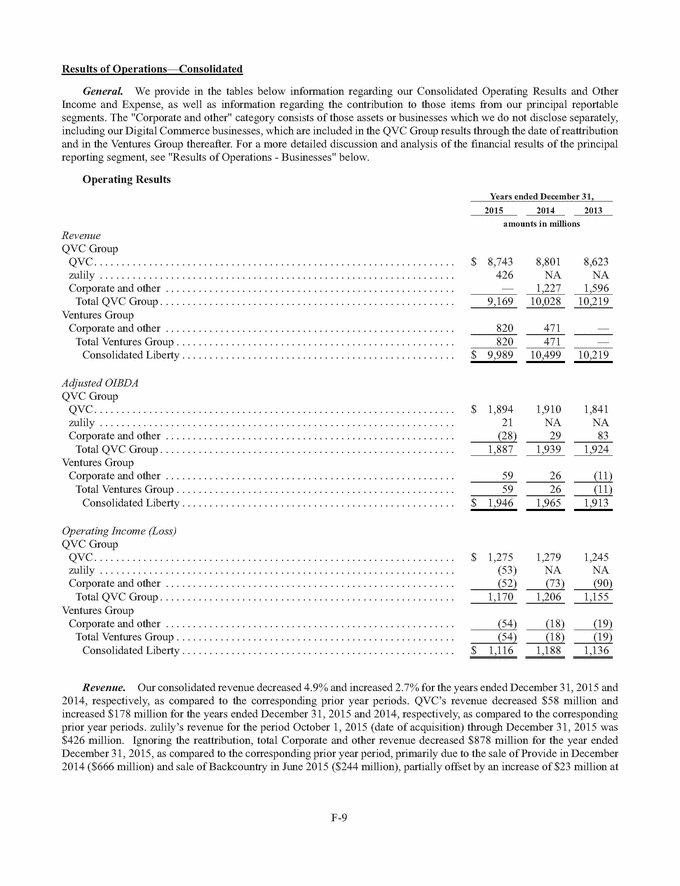
CommerceHub and increase of $8 million at Bodybuilding. CommerceHub revenue growth was driven by an acquisition during the first quarter of 2015 and growth in active customers (vendors and suppliers), which increased the number of aggregate transactions processed through the CommerceHub platform. The increase in Bodybuilding revenue for the year ended December 31, 2015 was primarily due to increased order volume, driven by increased unique website visitors, on slightly decreased average order values. Ignoring the reattribution, total Corporate and other revenue increased $102 million for the year ended December 31, 2014, primarily due to increases of $37 million at Backcountry, $34 million at Bodybuilding and $15 million at CommerceHub. Backcountry revenue increased as a result of increased order volume and an increase in average order value. The increase in Bodybuilding revenue was primarily due to increased order volume on flat average order values. CommerceHub revenue growth was primarily attributed to growth in active customers who pay a license and setup fee and an increase in the number of aggregate transactions processed for which CommerceHub earns a per transaction fee. See "Results of Operations - Businesses" below for a more complete discussion of the results of operations of QVC and zulily. Adjusted OIBDA. We define Adjusted OIBDA as revenue less cost of sales, operating expenses and selling, general and administrative ("SG&A") expenses (excluding stock compensation). Our chief operating decision maker and management team use this measure of performance in conjunction with other measures to evaluate our businesses and make decisions about allocating resources among our businesses. We believe this is an important indicator of the operational strength and performance of our businesses, including each business's ability to service debt and fund capital expenditures. In addition, this measure allows us to view operating results, perform analytical comparisons and benchmarking between businesses and identify strategies to improve performance. This measure of performance excludes such costs as depreciation and amortization, stock-based compensation and restructuring and impairment charges that are included in the measurement of operating income pursuant to GAAP. Accordingly, Adjusted OIBDA should be considered in addition to, but not as a substitute for, operating income, net income, cash flow provided by operating activities and other measures of financial performance prepared in accordance with GAAP. See note 19 to the accompanying consolidated financial statements for a reconciliation of Adjusted OIBDA to earnings (loss) from continuing operations before income taxes. Consolidated Adjusted OIBDA decreased $19 million and increased $52 million for the years ended December 31, 2015 and 2014, respectively, as compared to the corresponding prior year periods. QVC’s Adjusted OIBDA decreased $16 million for the year ended December 31, 2015 and increased $69 million for the year ended December 31, 2014, as compared to the corresponding prior year periods. zulily’s Adjusted OIBDA for the period October 1, 2015 (date of acquisition) through December 31, 2015 was $21 million, excluding certain purchase accounting adjustments. Ignoring the reattribution, total Corporate and other Adjusted OIBDA decreased $23 million for the year ended December 31, 2015, as compared to the corresponding prior year period, primarily due to the sale of Provide in December 2014 ($8 million) and the sale of Backcountry in June 2015 ($15 million). Ignoring the reattribution, total Corporate and other Adjusted OIBDA decreased $17 million for the year ended December 31, 2014, as compared to the corresponding prior year period. The decrease was primarily due to decreases of $22 million at Provide, resulting from slower revenue growth and the impact of shipping issues related to a storm in the first quarter of 2014, partially offset by increases in Adjusted OIBDA at Backcountry, Bodybuilding and Commerce Hub. See "Results of Operations - Businesses" below for a more complete discussion of the results of operations of QVC and zulily. Stock-based compensation. Stock-based compensation includes compensation related to (1) options and stock appreciation rights ("SARs") for shares of our common stock that are granted to certain of our officers and employees, (2) phantom stock appreciation rights ("PSARs") granted to officers and employees of certain of our subsidiaries pursuant to private equity plans and (3) amortization of restricted stock grants. We recorded $127 million, $108 million and $118 million of stock compensation expense for the years ended December 31, 2015, 2014 and 2013, respectively. The increase of $19 million in stock-based compensation during 2015 was primarily attributable to an increase in stock-based compensation at a few subsidiaries due to the growth in the fair value of those entities and due to options granted to zulily employees upon acquisition. The decrease of $10 million in stock-based compensation during 2014 was primarily attributable to slightly fewer options being granted in recent years which resulted in less stock-based compensation expense being recognized. As of December 31, 2015, the total unrecognized compensation cost related to unvested Liberty equity awards was approximately $113 million. Such amount will be recognized in our consolidated statements of operations over a weighted average period of approximately 2.4 years. F-10
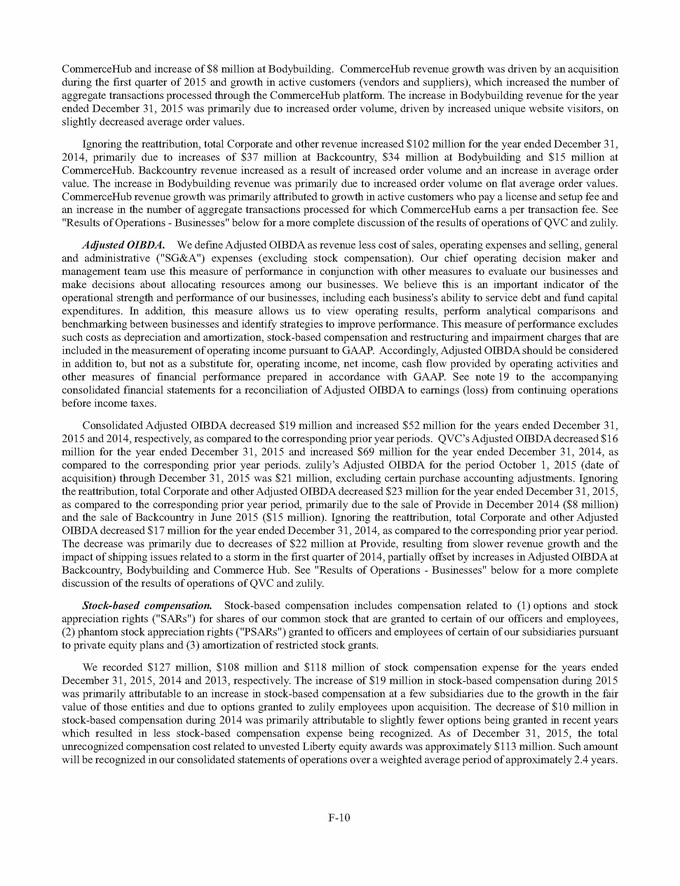
Operating income. Our consolidated operating income decreased $72 million and increased $52 million for the years ended December 31, 2015 and 2014, respectively, as compared to the corresponding prior year periods. QVC’s operating income was relatively flat for the year ended December 31, 2015 and increased $34 million for the year ended December 31, 2014, as compared to the corresponding prior year periods. zulily’s operating losses for the period October 1, 2015 (date of acquisition) through December 31, 2015 were $54 million. Ignoring the reattribution, operating losses for Corporate and other increased $13 million for the year ended December 31, 2015, as compared to the corresponding prior year period, primarily due to $28 million of decreases in operating income at CommerceHub, $7 million of decreases at Backcountry, and $6 million of decreases at Bodybuilding, partially offset by improvements of $13 million at Evite and $11 million at Provide. Operating losses improved $18 million for the year ended December 31, 2014, as compared to the corresponding prior year period, primarily due to $21 million improvements in operating results at Provide. See "Results of Operations - Businesses" below for a more complete discussion of the results of operations of QVC and zulily. Other Income and Expense Components of Other Income (Expense) are presented in the table below. Years ended December 31, 2015 2014 2013 amounts in millions Interest expense QVC Group Ventures Group Consolidated Liberty $ (283) (77) (312) (75) (290) (90) $ (360) (387) (380) Share of earnings (losses) of affiliates QVC Group Ventures Group Consolidated Liberty $ 55 (115) 51 (12) 48 (15) $ (60) 39 33 Realized and unrealized gains (losses) on financial instruments, net QVC Group Ventures Group Consolidated Liberty $ 42 72 (22) (35) (12) (10) $ 114 (57) (22) Gains (losses) on transactions, net QVC Group Ventures Group Consolidated Liberty $ — 110 — 74 (1) — $ 110 74 (1) Gains (losses) on dilution of investments in affiliates QVC Group Ventures Group Consolidated Liberty $ — 314 (2) — 4 (3) $ 314 (2) 1 Other, net QVC Group Ventures Group Consolidated Liberty $ (6) 25 (41) 22 (58) 28 $ 19 (19) (30) Interest expense. Interest expense decreased $27 million and increased $7 million for the years ended December 31, 2015 and 2014, respectively, as compared to the corresponding prior year periods. The decrease in interest expense for the year ended December 31, 2015 is attributable to QVC’s refinancing activities resulting in a lower average interest rate. F-11
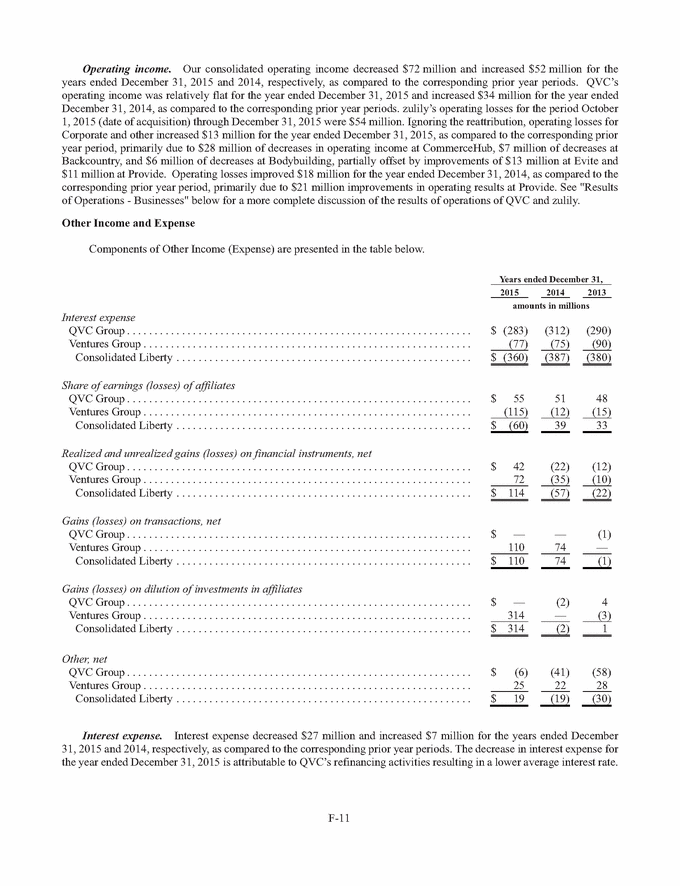
The increase in interest expense for the year ended December 31, 2014 was due to increased utilization of the QVC credit facility during the year. Share of earnings (losses) of affiliates. The following table presents our share of earnings (losses) of affiliates: Years ended December 31, 2015 2014 2013 amounts in millions QVC Group HSN, Inc. Other Total QVC Group Ventures Group Expedia, Inc. FTD, Inc. Other Total Ventures Group Consolidated Liberty $ 64 (9) 60 (9) 61 (13) 55 51 48 118 (83) (150) 58 — (70) 31 — (46) (115) (12) (15) $ (60) 39 33 The increase in Liberty’s share of Expedia’s earnings between December 31, 2015 and 2014 is primarily due to a significant gain Expedia recognized on the sale of a business during the year ended December 31, 2015. On December 31, 2014, Liberty acquired an approximate 35% interest in FTD, Inc. (“FTD”). Liberty’s share of FTD’s losses was $83 million for the year ended December 31, 2015. The carrying value of Liberty’s investment in FTD was impaired to the fair value as of December 31, 2015. The share of earnings (losses) of affiliates for the year ended December 31, 2014 was relatively flat based on the operating results of the equity affiliates. The Other category for the Ventures Group is comprised of investments in LendingTree, Interval Leisure Group, alternative energy investments and other investments. The alternative energy investments generally operate at a loss but provide favorable tax attributes recorded through the income tax (expense) benefit line item in the consolidated statements of operations. During the year ended December 31, 2015, Liberty recorded an impairment of approximately $98 million related to one of its alternative energy investments which has underperformed operationally. Realized and unrealized gains (losses) on financial instruments. Realized and unrealized gains (losses) on financial instruments are comprised of changes in the fair value of the following: Years ended December 31, 2015 2014 2013 amounts in millions Fair value option securities Exchangeable senior debentures Other derivatives $ 84 30 — 173 (230) — 514 (553) 17 $ 114 (57) (22) The changes in these accounts are due primarily to market factors and changes in the fair value of the underlying stocks or financial instruments to which these relate. Gains (losses) on transactions, net. The gain on transactions for the year ended December 31, 2015 primarily relates to the sale of Backcountry on June 30, 2015, which resulted in a $105 million gain. The gain on transactions during the year ended December 31, 2014 is due to the sale of Provide to FTD. Gains (losses) on dilution of investments in affiliates. Liberty recognized gains on dilution of investments in affiliates of $314 million during the year ended December 31, 2015, losses of $2 million during the year ended December 31, 2014 and gains of $1 million during the year ended December 31, 2013. The significant dilution gain in 2015 is due to an acquisition by Expedia that was executed through the issuance of stock. This diluted Liberty’s ownership percentage at a price greater than our cost basis. F-12
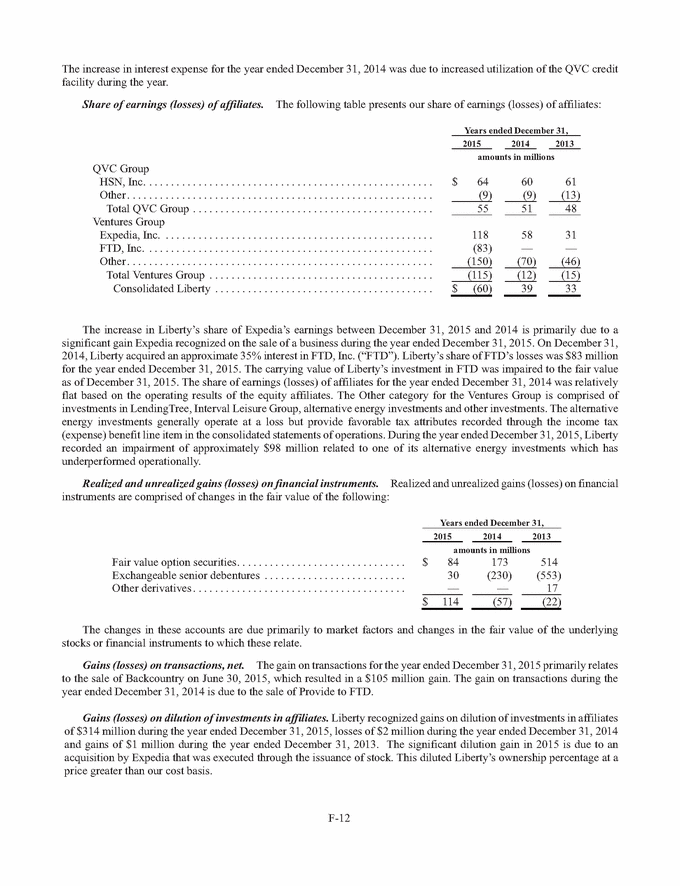
Income taxes. Our effective tax rate for the years ended December 31, 2015, 2014, and 2013 was 27.3%, 30.9% and 24.8%, respectively. The effective tax rate is less than the U.S. federal tax rate of 35% during all years presented primarily due to tax credits derived from our alternative energy investments. In addition, in 2015, Liberty recognized tax benefits related to the receipt of taxable dividends that are subject to dividends received deductions. The effective tax rate during 2014 and 2013 was further impacted by a change in the corporate effective state rate for outstanding deferred tax liabilities and assets at Liberty due to a change in the apportionment of income to various states. Net earnings. We had net earnings of $911 million, $626 million and $580 million for the years ended December 31, 2015, 2014 and 2013, respectively. The change in net earnings was the result of the above-described fluctuations in our revenue, expenses and other gains and losses. Liquidity and Capital Resources As of December 31, 2015 substantially all of our cash and cash equivalents are invested in U.S. Treasury securities, other government securities or government guaranteed funds, AAA rated money market funds and other highly rated financial and corporate debt instruments. The following are potential sources of liquidity: available cash balances, cash generated by the operating activities of our wholly-owned subsidiaries (to the extent such cash exceeds the working capital needs of the subsidiaries and is not otherwise restricted), net proceeds from asset sales, monetization of our public investment portfolio, outstanding debt facilities, debt and equity issuances, and dividend and interest receipts. During the year, there were no changes to our corporate debt credit ratings or our consolidated subsidiaries' debt credit ratings. Liberty and QVC are in compliance with their debt covenants as of December 31, 2015. As of December 31, 2015, Liberty's liquidity position consisted of the following: Cash and cash Marketable Available-for-equivalents securities sale securities amounts in millions QVC zulily Corporate and other Total QVC Group $ 326 56 44 — — 12 — — 4 426 12 4 Corporate and other Total Ventures Group Consolidated Liberty 2,023 898 1,349 2,023 898 1,349 $ 2,449 910 1,353 To the extent that the Company recognizes any taxable gains from the sale of assets, we may incur tax expense and be required to make tax payments, thereby reducing any cash proceeds. Additionally, we have $434.8 million available for borrowing under the QVC credit facility at December 31, 2015. As of December 31, 2015, QVC had approximately $195 million of cash and cash equivalents held in foreign subsidiaries. F-13
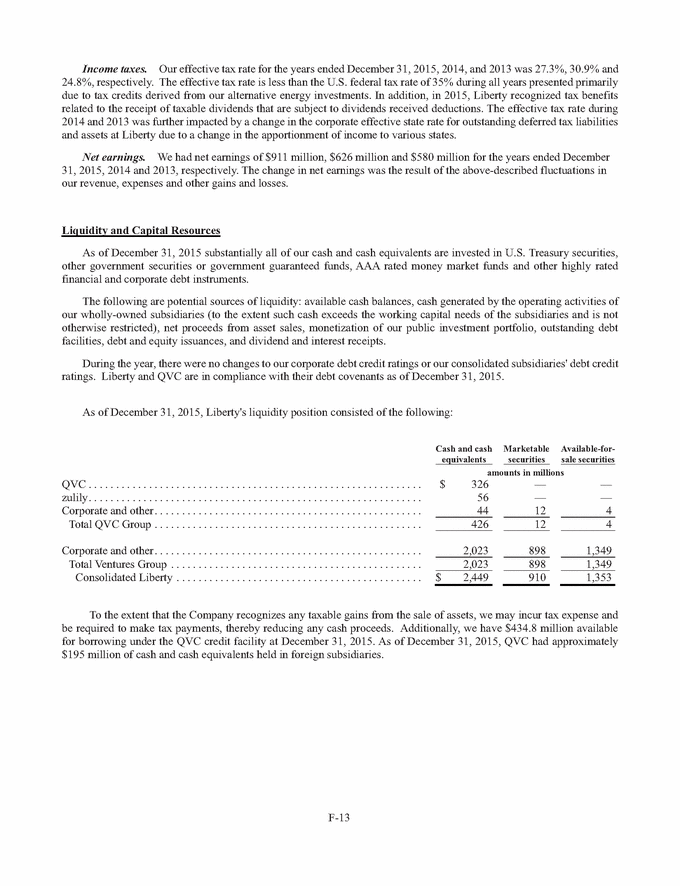
Additionally, our operating businesses have generated, on average, more than $1 billion in annual cash provided by operating activities over the prior three years and we do not anticipate any significant reductions in that amount in future periods. Years ended December 31, 2015 2014 2013 Cash Flow Information QVC Group cash provided (used) by operating activities Ventures Group cash provided (used) by operating activities Net cash provided (used) by operating activities QVC Group cash provided (used) by investing activities. Ventures Group cash provided (used) by investing activities. Net cash provided (used) by investing activities. QVC Group cash provided (used) by financing activities Ventures Group cash provided (used) by financing activities Net cash provided (used) by financing activities amounts in millions $ 981 65 1,204 436 985 42 $ 1,046 1,640 1,027 $ (909) 98 (281) (177) (356) 194 $ (811) (458) (162) $ (65) (24) (1,036) 970 (686) (1,522) $ (89) (66) (2,208) QVC Group During the year ended December 31, 2015, the QVC Group uses of cash were primarily acquisitions, net of cash acquired, of $824 million and the repurchase of Series A QVC Group common stock of $785 million. Additionally, the QVC Group had approximately $223 million of capital expenditures during the year ended December 31, 2015. These uses of cash were funded by cash provided by operating activities, additional net borrowings of debt of $725 million and the receipt of approximately $200 million in cash from a special dividend declared by HSNi. Approximately $54 million in cash from the special dividend received from HSNi was passed through to the HSNi exchangeable bondholders. The projected uses of QVC Group cash are the cost to service outstanding debt, approximately $270 million in interest payments on QVC and corporate level debt, anticipated capital improvement spending of approximately $240 million and the continued buyback of QVC Group common stock under the approved share buyback program. Ventures Group During the year ended December 31, 2015, the Ventures Group uses of cash were primarily the repayment of certain debt obligations of $567 million and investments in and loans to cost and equity investees of $143 million. These uses of cash for the Ventures Group were funded by proceeds from dispositions of $271 million and the refinancing of certain debt obligations of $589 million. The projected uses of Ventures Group cash are approximately $52 million in interest payments to service outstanding debt, anticipated capital improvement spending of approximately $38 million and further investments in existing or new businesses through continued investment activity. In addition, subject to the satisfaction of the applicable closing conditions, cash from the Liberty Ventures Group is expected to be used to fund Liberty’s $2.4 billion investment in Liberty Broadband (see note 2 in the accompanying consolidated financial statements). Consolidated During the year ended December 31, 2015, Liberty's primary uses of cash were $3,811 million of repayments on outstanding debt, acquisitions, net of cash acquired, of $844 million and repurchases of Series A QVC Group common stock of $785 million. These uses of cash were funded primarily with borrowings of $4,558 million and cash provided by operating activities. The projected uses of Liberty’s cash, outside of normal operating expenses (inclusive of tax payments), are the costs to service outstanding debt, approximately $322 million for interest payments on outstanding debt, corporate level and other subsidiary debt, anticipated capital improvement spending of approximately $278 million, the repayment of certain debt obligations and the potential buyback of common stock under the approved share buyback program and additional investments in existing or new businesses. Subject to the satisfaction of the applicable closing conditions, we expect to invest up to $2.4 billion in Liberty Broadband (see note 2 in the accompanying consolidated financial statements). We also may be required to make net payments of income tax liabilities to settle items under discussion with tax authorities. We F-14
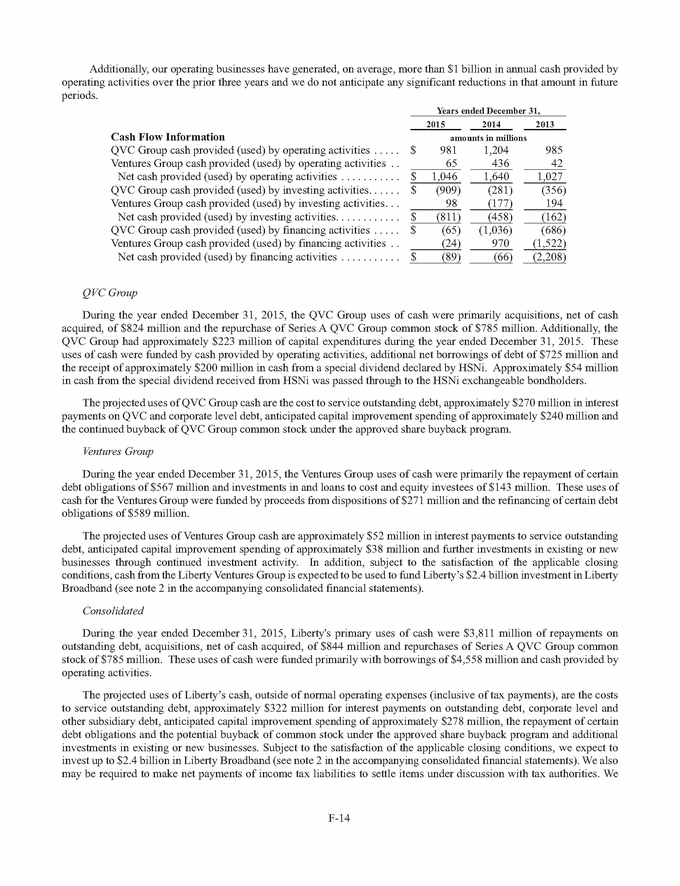
expect that cash on hand and cash provided by operating activities in future periods and outstanding borrowing capacity will be sufficient to fund projected uses of cash. Off-Balance Sheet Arrangements and Aggregate Contractual Obligations In connection with agreements for the sale of assets by our company, we may retain liabilities that relate to events occurring prior to the sale, such as tax, environmental, litigation and employment matters. We generally indemnify the purchaser in the event that a third party asserts a claim against the purchaser that relates to a liability retained by us. These types of indemnification obligations may extend for a number of years. We are unable to estimate the maximum potential liability for these types of indemnification obligations as the sale agreements may not specify a maximum amount and the amounts are dependent upon the outcome of future contingent events, the nature and likelihood of which cannot be determined at this time. Historically, we have not made any significant indemnification payments under such agreements and no amount has been accrued in the accompanying consolidated financial statements with respect to these indemnification obligations. We have contingent liabilities related to legal and tax proceedings and other matters arising in the ordinary course of business. Although it is reasonably possible we may incur losses upon conclusion of such matters, an estimate of any loss or range of loss cannot be made. In the opinion of management, it is expected that amounts, if any, which may be required to satisfy such contingencies will not be material in relation to the accompanying consolidated financial statements. Information concerning the amount and timing of required payments, both accrued and off-balance sheet, under our contractual obligations, excluding uncertain tax positions as it is undeterminable when payments will be made, is summarized below. Payments due by period Less than 1 year 2 - 3 years 4 - 5 years After 5 years Total amounts in millions Consolidated contractual obligations Long-term debt (1) Interest payments (2) Operating lease obligations Build to suit lease. Purchase orders and other obligations Total $ 8,685 6,030 310 96 1,576 390 322 41 — 1,488 56 644 73 11 59 2,265 576 59 12 29 5,974 4,488 137 73 — $ 16,697 2,241 843 2,941 10,672 (1) Amounts are reflected in the table at the outstanding principal amount, assuming the debt instruments will remain outstanding until the stated maturity date, and may differ from the amounts stated in our consolidated balance sheet to the extent debt instruments (i) were issued at a discount or premium or (ii) have elements which are reported at fair value in our consolidated balance sheets. Amounts also include capital lease obligations. Amounts do not assume additional borrowings or refinancings of existing debt. (2) Amounts (i) are based on our outstanding debt at December 31, 2015, (ii) assume the interest rates on our variable rate debt remain constant at the December 31, 2015 rates and (iii) assume that our existing debt is repaid at maturity. Critical Accounting Estimates The preparation of our financial statements in conformity with GAAP requires us to make estimates and assumptions that affect the reported amounts of assets and liabilities at the date of the financial statements and the reported amounts of revenue and expenses during the reporting period. Listed below are the accounting estimates that we believe are critical to our financial statements due to the degree of uncertainty regarding the estimates or assumptions involved and the magnitude of the asset, liability, revenue or expense being reported. All of these accounting estimates and assumptions, F-15
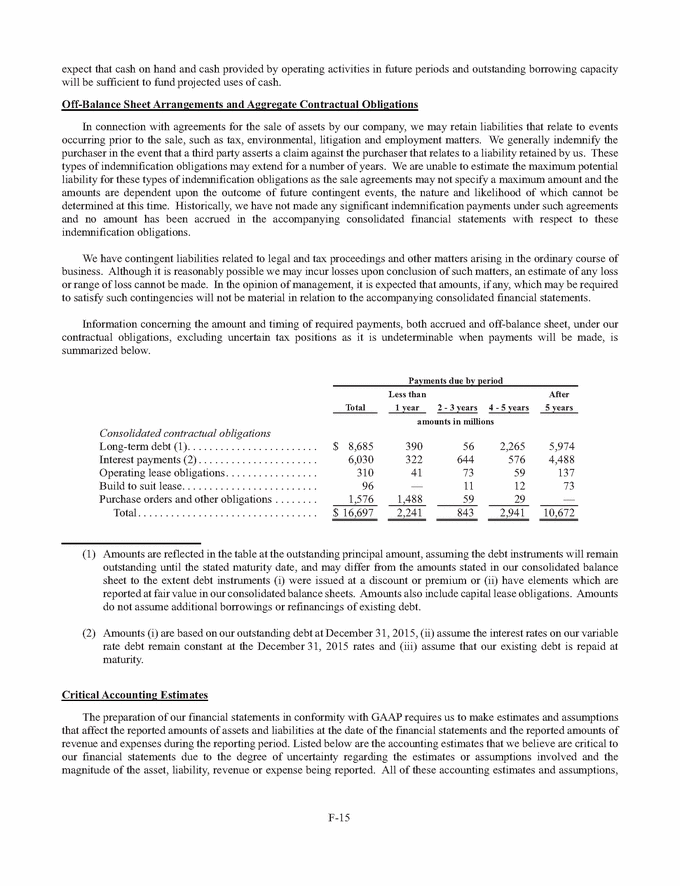
as well as the resulting impact to our financial statements, have been discussed with the audit committee of our board of directors. Fair Value Measurements Financial Instruments. We record a number of assets and liabilities in our consolidated balance sheets at fair value on a recurring basis, including available-for-sale ("AFS") securities, financial instruments and our exchangeable senior debentures. GAAP provides a hierarchy that prioritizes inputs to valuation techniques used to measure fair value into three broad levels. Level 1 inputs are quoted market prices in active markets for identical assets or liabilities that the reporting entity has the ability to access at the measurement date. We use quoted market prices, or Level 1 inputs, to value all our Fair Value Option Securities. As of December 31, 2015 and 2014, the carrying value of our Fair Value Option securities was $1,294 million and $1,220 million, respectively. Level 2 inputs, other than quoted market prices included within Level 1, are observable for the asset or liability, either directly or indirectly. We use quoted market prices to determine the fair value of our exchangeable senior debentures. However, these debentures are not traded on active markets as defined in GAAP, so these liabilities fall in Level 2. As of December 31, 2015, the principal amount and carrying value of our exchangeable debentures were $2,416 million and $2,480 million, respectively. Level 3 inputs are unobservable inputs for an asset or liability. We currently have no Level 3 financial instrument assets or liabilities. Non-Financial Instruments. Our non-financial instrument valuations are primarily comprised of our annual assessment of the recoverability of our goodwill and other nonamortizable intangibles, such as trademarks and our evaluation of the recoverability of our other long-lived assets upon certain triggering events. If the carrying value of our long-lived assets exceeds their undiscounted cash flows, we are required to write the carrying value down to fair value. Any such writedown is included in impairment of long-lived assets in our consolidated statements of operations. A high degree of judgment is required to estimate the fair value of our long-lived assets. We may use quoted market prices, prices for similar assets, present value techniques and other valuation techniques to prepare these estimates. We may need to make estimates of future cash flows and discount rates as well as other assumptions in order to implement these valuation techniques. Due to the high degree of judgment involved in our estimation techniques, any value ultimately derived from our long-lived assets may differ from our estimate of fair value. As each of our operating segments has long-lived assets, this critical accounting policy affects the financial position and results of operations of each segment. As of December 31, 2015, the intangible assets not subject to amortization for each of our significant reportable segments were as follows: Goodwill Trademarks To tal amounts in millions 2,428 920 QVC zulily Corporate and other $ 5,149 860 103 7,577 1,780 128 25 $ 6,112 3,373 9,485 We perform our annual assessment of the recoverability of our goodwill and other non-amortizable intangible assets during the fourth quarter of each year. We utilize a qualitative assessment for determining whether step one of the goodwill impairment analysis is necessary. The accounting guidance permits entities to first assess qualitative factors to determine whether it is more likely than not that the fair value of a reporting unit is less than its carrying amount as a basis for determining whether it is necessary to perform the two-step goodwill impairment test. In evaluating goodwill on a qualitative basis the Company reviews the business performance of each reporting unit and evaluates other relevant factors as identified in the relevant accounting guidance to determine whether it is more likely than not that an indicated impairment exists for any of our reporting units. The Company considers whether there are any negative macroeconomic conditions, industry specific conditions, market changes, increased competition, increased costs in doing business, management challenges, the legal environments and how these factors might impact company specific performance in F-16
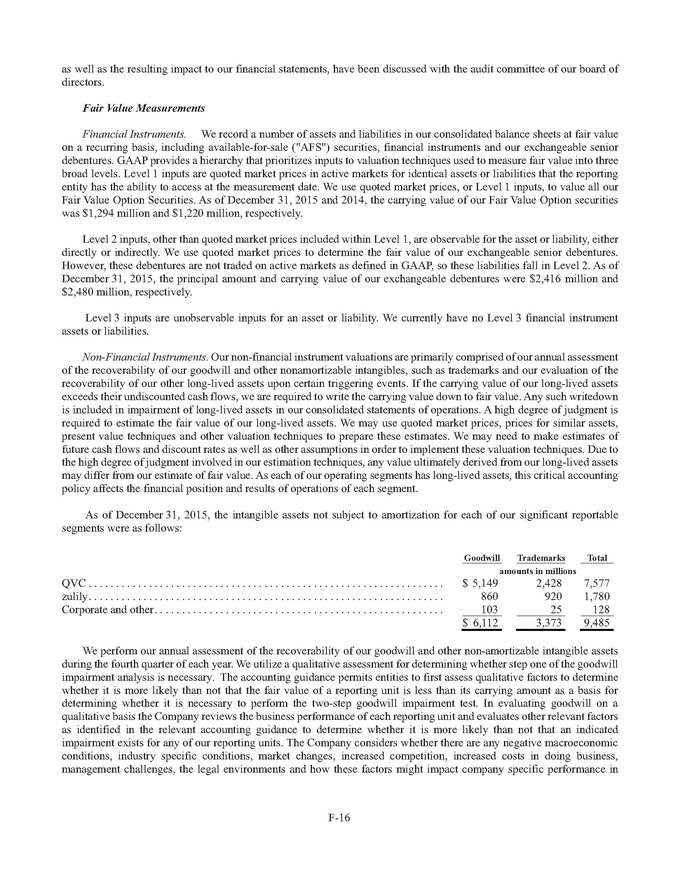
future periods. As part of the analysis the Company also considers fair value determinations for certain reporting units that have been made at various points throughout the current and prior years for other purposes. There were no goodwill and other intangible impairments in 2015. During the years ended December 31, 2014 and 2013 we recorded $7 million and $30 million, respectively, in goodwill and other intangibles impairments for certain of our Digital Commerce companies, primarily Evite. Continued declining operating results as compared to budgeted results and certain trends required a Step 2 impairment test and a determination of fair value for these subsidiaries. Fair value for these subsidiaries, including intangible assets and goodwill, was determined using the respective companies’ projections of future operating performance and applying a combination of market multiples and a discounted cash flow calculation (Level 3). Carrying Value of Investments. We periodically evaluate our investments to determine if decreases in fair value below our cost bases are other than temporary. If a decline in fair value is determined to be other than temporary, we are required to reflect such decline in our consolidated statements of operations. Other than temporary declines in fair value of our cost investments are recognized on a separate line in our consolidated statements of operations, and other than temporary declines in fair value of our equity method investments are included in share of earnings (losses) of affiliates in our consolidated statements of operations. The primary factors we consider in our determination of whether declines in fair value are other than temporary are the length of time that the fair value of the investment is below our carrying value; the severity of the decline; and the financial condition, operating performance and near term prospects of the investee. In addition, we consider the reason for the decline in fair value, be it general market conditions, industry specific or investee specific; analysts' ratings and estimates of 12 month share price targets for the investee; changes in stock price or valuation subsequent to the balance sheet date; and our intent and ability to hold the investment for a period of time sufficient to allow for a recovery in fair value. Fair value of our publicly traded cost and equity investments is based on the market prices of the investments at the balance sheet date. We estimate the fair value of our other cost and equity investments using a variety of methodologies, including cash flow multiples, discounted cash flow, per subscriber values, or values of comparable public or private businesses. Impairments are calculated as the difference between our carrying value and our estimate of fair value. As our assessment of the fair value of our investments and any resulting impairment losses and the timing of when to recognize such charges requires a high degree of judgment and includes significant estimates and assumptions, actual results could differ materially from our estimates and assumptions. Our evaluation of the fair value of our investments and any resulting impairment charges are made as of the most recent balance sheet date. Changes in fair value subsequent to the balance sheet date due to the factors described above are possible. Subsequent decreases in fair value will be recognized in our consolidated statements of operations in the period in which they occur to the extent such decreases are deemed to be other than temporary. Subsequent increases in fair value will be recognized in our consolidated statements of operations only upon our ultimate disposition of the investment. During the year ended December 31, 2015, Liberty recorded an impairment of approximately $98 million related to one of our alternative energy investments which has underperformed operationally. In addition, during the year ended December 31, 2015, Liberty recorded an impairment of our investment in FTD, as our carrying value per share was below the trading price for a significant period of time. Retail Related Adjustments and Allowances. QVC records adjustments and allowances for sales returns, inventory obsolescence and uncollectible receivables. Each of these adjustments is estimated based on historical experience. Sales returns are calculated as a percent of sales and are netted against revenue in our consolidated statements of operations. For the years ended December 31, 2015, 2014 and 2013, sales returns represented 19.1%, 19.4% and 19.8% of QVC's gross product revenue, respectively. The inventory obsolescence reserve is calculated as a percent of QVC's inventory at the end of a reporting period based on, among other factors, the average inventory balance for the preceding 12 months and historical experience with liquidated inventory. The change in the reserve is included in cost of retail sales in our consolidated statements of operations. At December 31, 2015, QVC's inventory was $929 million, which was net of the obsolescence adjustment of $84 million. QVC's allowance for doubtful accounts is calculated as a percent of accounts receivable at the end of a reporting period, and the change in such allowance is recorded as bad debt expense in our consolidated statements of operations. At December 31, 2015, QVC's trade accounts receivable were $1,370 million, net of the allowance for doubtful accounts of $86 million. Each of these estimates requires management judgment and may not reflect actual results. F-17
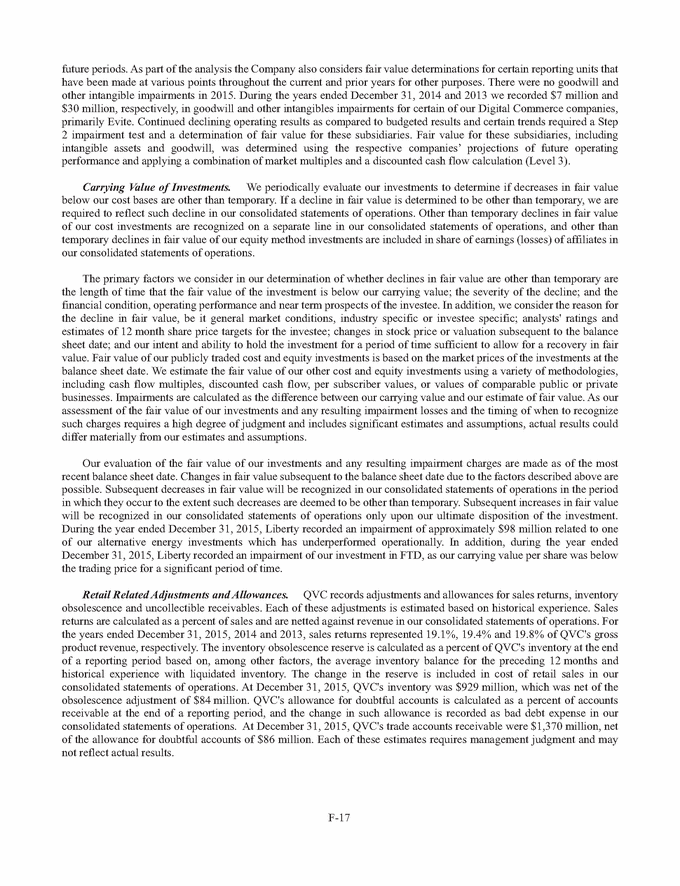
Income Taxes. We are required to estimate the amount of tax payable or refundable for the current year and the deferred income tax liabilities and assets for the future tax consequences of events that have been reflected in our financial statements or tax returns for each taxing jurisdiction in which we operate. This process requires our management to make judgments regarding the timing and probability of the ultimate tax impact of the various agreements and transactions that we enter into. Based on these judgments we may record tax reserves or adjustments to valuation allowances on deferred tax assets to reflect the expected realizability of future tax benefits. Actual income taxes could vary from these estimates due to future changes in income tax law, significant changes in the jurisdictions in which we operate, our inability to generate sufficient future taxable income or unpredicted results from the final determination of each year's liability by taxing authorities. These changes could have a significant impact on our financial position. Results of Operations—Businesses QVC. QVC is a retailer of a wide range of consumer products, which are marketed and sold primarily by merchandise-focused televised shopping programs, the Internet and mobile applications. In the United States, QVC's live programming is distributed via its nationally televised shopping program to approximately 107 million households for 24 hours per day, 364 days per year. Internationally, QVC's program services reach approximately 137 million households based in Germany, Austria, the U.K., Republic of Ireland, Italy, Japan, and France. QVC-International distributes programming live between eight and twenty-four hours per day, and an additional seven to sixteen hours per day of recorded programming, depending on the market. QVC’s Japanese operations are conducted through a joint venture with Mitsui & Co. LTD ("Mitsui") for a television and multimedia retailing service in Japan. QVC-Japan is owned 60% by QVC and 40% by Mitsui. QVC and Mitsui share in all profits and losses based on their respective ownership interests. During the years ended December 31, 2015, 2014 and 2013, QVC-Japan paid dividends to Mitsui of $36 million, $42 million and $45 million, respectively. QVC also has a joint venture with CNR Media Group, formerly known as China Broadcasting Corporation, a limited liability company owned by China National Radio (''CNR''). The Company owns a 49% interest in a CNR subsidiary, CNR Home Shopping Co., Ltd. (''CNRS''). CNRS operates a retail business in China through a shopping television channel with an associated website. Live programming is distributed for 17 hours per day and recorded programming for seven hours per day. The CNRS joint venture is accounted for as an equity method investment. In June 2015, QVC expanded its global presence into France, launching its website on June 23, 2015 followed by the launch of television programming on August 1, 2015. In addition, during the year ended December 31, 2015, QVC put into action the One Q Reorganization Plan which reorganized its department reporting structure. The purpose of the plan is to reorganize the reporting structure for a shared services arrangement to support the U.S. and international operations. F-18
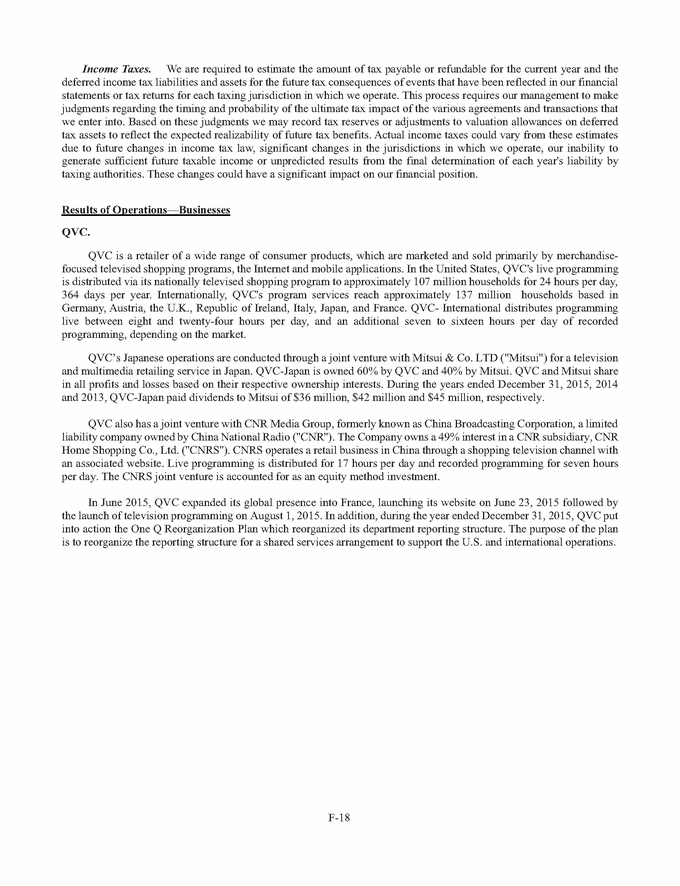
QVC's operating results were as follows: Years ended December 31, 2015 2014 2013 amounts in millions Net revenue Cost of sales Gross profit Operating expenses SG&A expenses (excluding stock-based compensation) Adjusted OIBDA Stock-based compensation Depreciation and amortization Operating income $ 8,743 (5,528) 8,801 (5,547) 8,623 (5,465) 3,215 (607) (714) 3,254 (618) (726) 3,158 (610) (707) 1,894 (31) (588) 1,910 (44) (587) 1,841 (38) (558) $ 1,275 1,279 1,245 Net revenue was generated from the following geographical areas: Years ended December 31, 2015 2014 2013 amounts in millions QVC-U.S QVC-International. $ 6,257 2,486 6,055 2,746 5,844 2,779 $ 8,743 8,801 8,623 QVC's consolidated net revenue decreased 0.7% and increased 2.1% for the years ended December 31, 2015 and 2014, respectively, as compared to the corresponding prior years. The 2015 decrease of $58 million in net revenue was primarily comprised of $357 million of unfavorable foreign currency rate adjustments, a decrease in net shipping and handling revenue of $81 million in the U.S., a $74 million increase in estimated product returns, and a $15 million decrease in other revenue primarily in the U.S. These decreases were offset by $330 million due to a 3.4% increase in units sold both in the U.S. and internationally and $139 million due to a 1.4% increase in the consolidated average selling price per unit (ASP). The increase in estimated product returns was primarily in the U.S. and Germany due to sales mixes and an increase in units shipped. As expected, shipping and handling revenue decreased in the U.S. as a result of QVC's new shipping and handling pricing which became effective February 2, 2015 that provides for changes in standard shipping rates and a change in QVC's shipping and handling refund policy. The 2014 increase of $178 million in net revenue was primarily comprised of $225 million due to a 2.3% increase in units sold, partially offset by $49 million of unfavorable foreign currency rate adjustments, primarily in Japan. Additionally, net revenue was positively impacted by a decrease in the return rate from 19.8% in 2013 to 19.4% in 2014. This was driven by international improvements in home and beauty. During the years ended December 31, 2015 and 2014, the changes in revenue and expenses were affected by changes in the exchange rates for the Japanese Yen, the Euro and the U.K. Pound Sterling. In the event the U.S. Dollar continues to strengthen against these foreign currencies in the future, QVC's revenue and operating cash flow will be negatively affected. The percentage increase (decrease) in net revenue for each of QVC's geographic areas in U.S. Dollars and in constant currency was as follows: Year ended December 31, 2015 Year ended December 31, 2014 U.S. dollars Constant currency U.S. dollars Constant currency QVC-US 3.3 % 3.3 % 3.5 % 3.6 % (1.2)% 3.6 % 0.6 % QVC-International.(9.5)% F-19
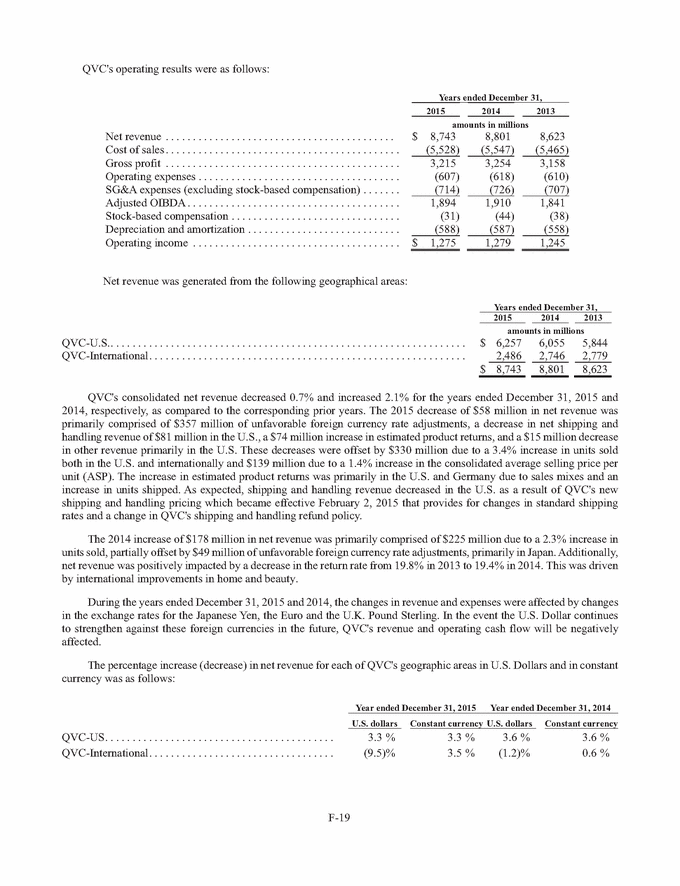
In 2015, QVC-U.S. net revenue growth was primarily due to 4.0% increase in units shipped and a 1.2% increase in ASP offset by the increase in estimated product returns and lower shipping and handling revenue as discussed in the above paragraph. QVC-U.S. experienced shipped sales growth in all categories except jewelry and electronics. QVC-International net revenue growth in constant currency was primarily due to a 2.2% increase in units shipped, driven mainly by the U.K., and a 1.6% increase in ASP, mainly in Germany, offset by the increase in estimated product returns. QVC-International experienced shipped sales growth in constant currency in all categories except electronics. In 2014, QVC-U.S. net revenue growth was primarily due to a 4.7% increase in units shipped offset by a 0.9% decrease in ASP. QVC-U.S. experienced shipped sales growth in all categories except electronics. QVC-International net revenue growth in constant currency was primarily due to a 1.2% increase in ASP and a favorable impact on estimated product returns offset by a 1.7% decrease in units shipped. QVC-International experienced shipped sales growth in constant currency in electronics, home, and beauty, which was offset by decreases in jewelry, apparel, and accessories. QVC's gross profit percentage was 36.8%, 37.0% and 36.6% for the years ended December 31, 2015, 2014 and 2013, respectively. The slight decrease in gross profit percentage in 2015 was primarily due to increased obsolescence and freight costs in the U.S partially offset by increased product margins in the U.S. and internationally. The increase in gross profit percentage in 2014 and 2013 was primarily due to improved product margins in the U.S. and U.K. QVC's operating expenses are principally comprised of commissions, order processing and customer service expenses, credit card processing fees, and telecommunications expenses. Operating expenses decreased $11 million or 1.8% and increased $8 million or 1.3% for the years ended December 31, 2015 and 2014, respectively. The decrease in 2015 was primarily due to favorable foreign currency exchange rates of $29 million, partially offset by a $9 million increase in commissions expenses and an $8 million increase in credit card fees. The increase in commissions expenses was primarily due to increased sales in the U.S. The increase in credit card fees was primarily due to increased sales combined with a higher mix of purchases from customers using credit cards with higher rates charged to merchants, primarily in the U.S. The increase in 2014 was primarily due to a $5 million increase in each of customer service, commissions expenses and credit card processing fees, partially offset by favorable foreign currency exchange rates of $6 million and other expenses. The increase in customer service expenses was primarily due to the launch of the new European systems platform that created some short-term disruptions and resulted in additional talk times and an increase in the U.S. due to volume associated with the sales increase. The increase in commission expenses was primarily due to higher programming distribution costs in Japan and sales increases in the U.S. The increase in credit card fees was primarily due to the U.S. sales increase and lower usage of the Q Card combined with a higher mix of purchases from customers using credit cards with higher rates charged to merchants. QVC's SG&A expenses include personnel, information technology, provision for doubtful accounts, credit card income, production costs and marketing and advertising expenses. Such expenses decreased $12 million, and remained consistent as a percent of net revenue at 8.2% and increased $19 million, and remained consistent as a percent of net revenue at 8.2% for the year ended December 31, 2014. The decrease in 2015 was primarily related to a $48 million favorable impact of exchange rates, a $12 million increase in credit card income, and a $10 million decrease in bad debt expense, partially offset by a $53 million increase in personnel expense. The increase in credit card income was due to favorable economics of the Q card portfolio in the U.S. The decrease in bad debt was mainly due to a lower electronics Easy-Pay mix, higher usage of the Q Card in the U.S. and lower write-offs in Germany. The increase in personnel expenses was primarily due to severance costs related to the establishment of the Global Business Service center and One Q, and also due to merit, bonus and benefits increases in the U.S. and internationally, including the start-up in France. F-20
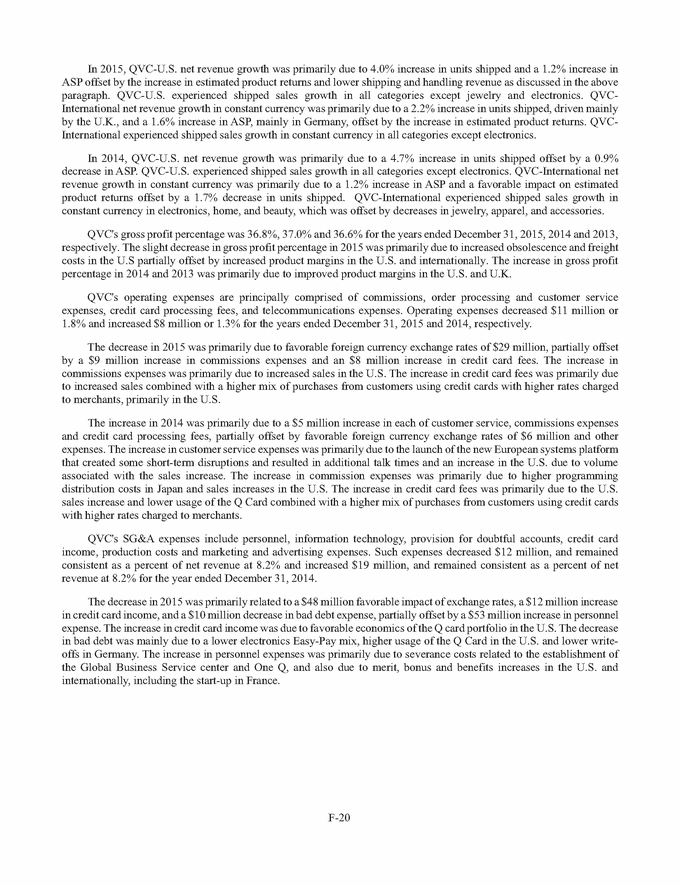
The increase in 2014 was primarily related to a $12 million increase in the provision for doubtful accounts, an $11 million increase in outside services expenses, and a $14 million increase in personnel expense, partially offset by a $17 million increase in credit card income and a $3 million favorable impact of exchange rates. The increase in the provision for doubtful accounts was primarily due to the increased use of Easy-Pay in the U.S. and Germany. The increase in outside services expenses was primarily due to information technology and commerce platform projects and global market expansion expenses. The increase in personnel expenses was primarily due to merit, benefits and severance increases in the U.S. and the France start-up. The increase in programming and production costs was primarily due to increased manpower costs in the U.S., partially offset by declines in Germany. The increase in credit card income was primarily due to the more favorable economics of the Q Card portfolio in the U.S. and higher bank reserve requirements associated with the U.S. regulatory environment in the prior year. In 2014, QVC-U.S. amended and restated its agreement with a large consumer financial services company (the "Bank") pursuant to which the Bank provides revolving credit directly to QVC's customers for the sole purpose of purchasing merchandise or services with a QVC branded credit card. The agreement provides more favorable economic terms for QVC and was effective August 1, 2014. Depreciation and amortization consisted of the following: Years ended December 31, 2015 2014 2013 amounts in millions Affiliate agreements Customer relationships Acquisition related amortization. Property and equipment Software amortization Channel placement amortization and related expenses Total depreciation and amortization $ 146 170 150 173 150 172 316 134 93 45 323 135 93 36 322 127 78 31 $ 588 587 558 The increases in software amortization in 2015 and 2014 were primarily due to solutions to enhance customer service and productivity. F-21
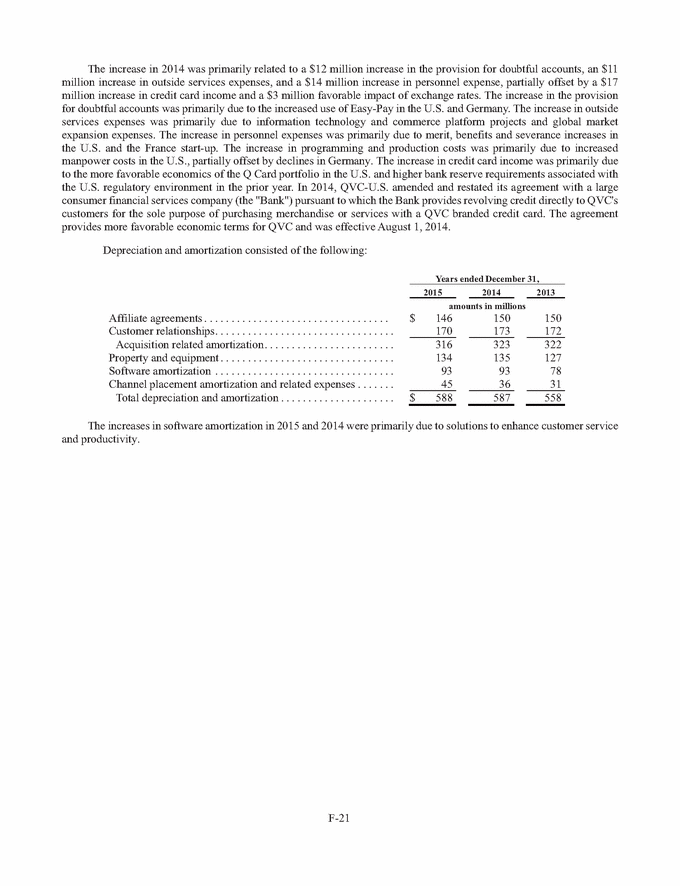
zulily. Liberty acquired zulily on October 1, 2015. Prior to the acquisition, zulily utilized a retail calendar, whereby each fiscal year ended on the Sunday closest to December 31. Upon acquisition by Liberty, zulily changed its year end to December 31 on a prospective basis, resulting in four additional days in the year ended December 31, 2015 as compared to the year ended December 28, 2014. Although zulily’s results are only included in Liberty’s results for the period October 1, 2015 through December 31, 2015, we believe a discussion of zulily’s stand alone results, including certain one-time purchase accounting related adjustments detailed below, promotes a better understanding of the overall results of its business. zulily has reclassified certain costs between financial statement line items to conform with Liberty’s reporting structure for ease of comparability for all reporting periods. zulily's operating results for the last three years were as follows: Years ended December 31, December 28,December 29, 2015 2014 2013 amounts in millions Net revenue Cost of sales Gross profit Operating expenses SG&A expenses (excluding stock-based compensation and acquisition related expenses) Adjusted OIBDA Acquisition related expenses Stock-based compensation Depreciation and amortization Deferred revenue adjustment Operating income (loss) $ 1,361 (978) 1,201 (894) 696 (512) 383 (43) 307 (40) 184 (26) (269) (223) (131) 71 (30) (19) (83) (17) 44 — (15) (13) — 27 — (8) (6) — $ (78) 16 13 Net revenue consists primarily of sales of women's, children's and men's apparel, children's merchandise and other product categories such as kitchen accessories and home décor. zulily recognizes product sales at the time all revenue recognition criteria has been met, which is generally at delivery. Net revenue represents the sales of these items plus shipping and handling charges to customers, net of estimated returns and promotional discounts. Net revenue is primarily driven by growth in zulily’s active customers, the frequency with which customers purchase and average order value. zulily's consolidated net revenue increased 13.3% and 72.6% for the years ended December 31, 2015 and December 28, 2014, respectively, as compared to the corresponding prior years. The increase in net revenue for the year ended December 31, 2015 was primarily attributed to an 11.6% increase in total orders placed. The increase in zulily’s net revenue for the year ended December 28, 2014 compared to the year ended December 29, 2013 was primarily driven by a 67% increase in total orders placed. zulily's gross profit percentage was 28.1%, 25.6% and 26.4% for the years ended December 31, 2015, December 28, 2014 and December 29, 2013, respectively. The increase in gross profit for the year ended December 31, 2015 was primarily attributed to improved operational performance driven by investments in transportation and fulfillment center automation. Gross profit percentage for the year ended December 28, 2014 was lower as compared to the year ended December 29, 2013 as a result of additional incremental labor in its fulfillment centers to support higher unit volumes and higher fulfillment costs as zulily began operating the new Nevada fulfillment center and automated its Ohio facility. zulily’s operating expenses are principally comprised of credit card processing fees and customer service expenses. Operating expenses increased $3 million, or 7.5%, and $14 million, or 53.8%, for the years ended December 31, 2015 and December 28, 2014, respectively. The increase in operating expenses was primarily attributed to an increase in credit card processing fees which are driven by higher sales volume. zulily’s SG&A expenses include personnel related costs for general corporate functions, marketing and advertising expenses, information technology, and the costs associated with the use by these functions of facilities and equipment, including rent. These expenses increased $46 million, and as a percentage of net revenue, increased from 18.6% to 19.8% for the year ended December 31, 2015. The increase in SG&A expenses as compared to the year ended December 28, 2014 F-22
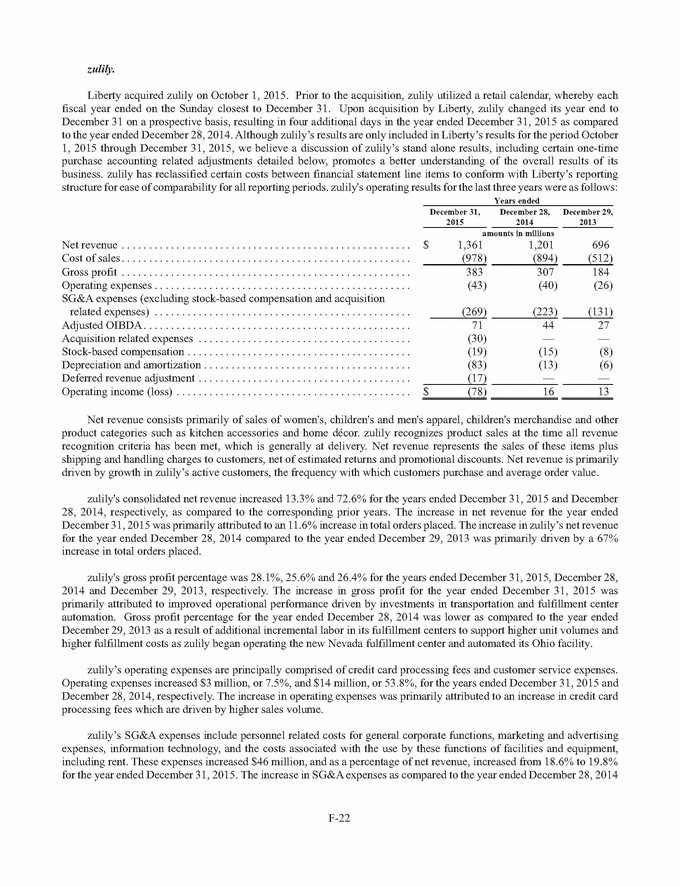
was attributable to higher personnel related costs, increased rent and facilities expenses as a result of an increase in square footage occupied in order to support its business growth, and higher marketing-related expenses attributable to increased subscriber acquisition costs as zulily realigned its marketing strategy to focus on higher lifetime value customers. zulily’s SG&A expenses increased $92 million but declined as a percentage of net revenue from 18.8% to 18.6%, for the year ended December 28, 2014. The increase in SG&A expenses for the year ended December 28, 2014 compared to the year ended December 29, 2013 was primarily due to increased personnel related costs, higher rent and other facilities expenses, and increased marketing-related expenses as a result of increased spending on paid online marketing channels, including display advertising, keyword search campaigns, search engine optimization and social media. zulily’s stock-based compensation expense increased $4 million, or 26.7%, for the year ended December 31, 2015. The increase in stock-based compensation expense was the result of incremental increases in headcount during the year ended December 31, 2015 as compared to the year ended December 28, 2014. zulily’s stock-based compensation expense increased $7 million, or 87.5%, for the year ended December 28, 2014. The increase in stock-based compensation expense for the year ended December 28, 2014 as compared to the year ended December 29, 2013 was primarily attributed to increases in headcount across functions to support business growth. zulily’s depreciation and amortization expense increased $70 million for the year ended December 31, 2015. The increase is primarily attributed to amortization of intangible assets as a result of purchase accounting. To a lesser extent, the increase in depreciation and amortization was related to additional automation equipment and leasehold improvements in its fulfillment centers. zulily’s depreciation and amortization increased $7 million for the year ended December 28, 2014 as compared to the year ended December 29, 2013 zulily’s results for the year ended December 31, 2015, including certain one-time purchase accounting related adjustments, were as follows (amounts in millions): Post-Acquisition: Pre-Acquisition: Deferred Revenue October 1, 2015 - December 29, 2014 - 2015 December 31, 2015 Adjustment September 30, 2015 To tal Net revenue $ 426 (318) 17 — 918 (660) 1,361 (978) Cost of sales Gross profit Operating expenses SG&A expenses (excluding stock-based compensation and acquisition related expenses) Adjusted OIBDA Acquisition related expenses Stock-based compensation Depreciation and amortization Deferred revenue adjustment 108 (13) 17 — 258 (30) 383 (43) (74) — (195) (269) 21 — (5) (69) — 17 — — — (17) 33 (30) (14) (14) — 71 (30) (19) (83) (17) Operating income (loss) $ (53) — (25) (78) The results of operations for the year ended December 31, 2015 include approximately $30 million in costs associated with the closing of the acquisition. The results of operations for the period October 1, 2015 through December 31, 2015 include approximately $63 million of depreciation and amortization as a result of purchase accounting related to new intangible assets and to a lesser extent stepped up valuation on assets existing prior to the date of the acquisition. Additionally, as a result of our application of purchase accounting, zulily’s deferred revenue was adjusted to fair value, based on a broader market margin, instead of a company specific margin. This adjustment had the one-time impact of lowering revenue and Adjusted OIBDA in the post-acquisition period. F-23
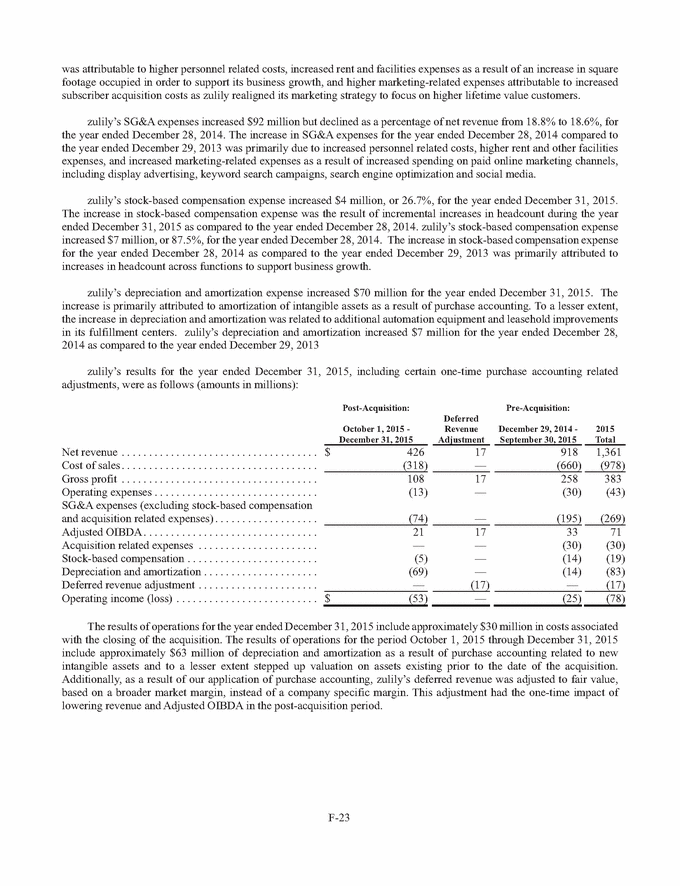
Quantitative and Qualitative Disclosures about Market Risk. We are exposed to market risk in the normal course of business due to our ongoing investing and financial activities and the conduct of operations by our subsidiaries in different foreign countries. Market risk refers to the risk of loss arising from adverse changes in stock prices, interest rates and foreign currency exchange rates. The risk of loss can be assessed from the perspective of adverse changes in fair values, cash flows and future earnings. We have established policies, procedures and internal processes governing our management of market risks and the use of financial instruments to manage our exposure to such risks. We are exposed to changes in interest rates primarily as a result of our borrowing and investment activities, which include investments in fixed and floating rate debt instruments and borrowings used to maintain liquidity and to fund business operations. The nature and amount of our long-term and short-term debt are expected to vary as a result of future requirements, market conditions and other factors. We manage our exposure to interest rates by maintaining what we believe is an appropriate mix of fixed and variable rate debt. We believe this best protects us from interest rate risk. We have achieved this mix by (i) issuing fixed rate debt that we believe has a low stated interest rate and significant term to maturity, (ii) issuing variable rate debt with appropriate maturities and interest rates and (iii) entering into interest rate swap arrangements when we deem appropriate. As of December 31, 2015, our debt is comprised of the following amounts: Variable rate debt Fixed rate debt Principal amount Weighted avg interest rate Principal amount Weighted avg interest rate dollar amounts in millions QVC Group QVC Corporate and other Ventures Group Corporate and other $ $ 1,815 — 1.70 % NA $ $ 3,622 1,137 4.6 % 6.1 % $ 32 2.5 % $ 2,079 2.5 % We are exposed to changes in stock prices primarily as a result of our significant holdings in publicly traded securities. We continually monitor changes in stock markets, in general, and changes in the stock prices of our holdings, specifically. We believe that changes in stock prices can be expected to vary as a result of general market conditions, technological changes, specific industry changes and other factors. We periodically use equity collars and other financial instruments to manage market risk associated with certain investment positions. These instruments, when utilized, are recorded at fair value based on option pricing models. At December 31, 2015, the fair value of our AFS equity securities was $1,287 million. Had the market price of such securities been 10% lower at December 31, 2015, the aggregate value of such securities would have been $129 million lower. Our stock in Expedia and other equity method affiliates which are publicly traded securities are not reflected at fair value in our balance sheets. These securities are also subject to market risk that is not directly reflected in our statements of operations. Additionally, our exchangeable senior debentures are also subject to market risk. Because we mark these instruments to fair value each reporting date, increases in the price of the respective underlying security generally result in higher liabilities and unrealized losses in our statements of operations. Liberty is exposed to foreign exchange rate fluctuations related primarily to the monetary assets and liabilities and the financial results of QVC's foreign subsidiaries. Assets and liabilities of foreign subsidiaries for which the functional currency is the local currency are translated into U.S. dollars at period-end exchange rates, and the statements of operations are generally translated at the average exchange rate for the period. Exchange rate fluctuations on translating foreign currency financial statements into U.S. dollars that result in unrealized gains or losses are referred to as translation adjustments. Cumulative translation adjustments are recorded in accumulated other comprehensive earnings (loss) as a separate component of stockholders' equity. Transactions denominated in currencies other than the functional currency are recorded based on exchange rates at the time such transactions arise. Subsequent changes in exchange rates result in transaction gains and losses, which are reflected in income as unrealized (based on period-end translations) or realized upon settlement of the transactions. Cash flows from our operations in foreign countries are translated at the average rate for the period. Accordingly, Liberty may experience economic loss and a negative impact on earnings and equity with respect to our holdings solely as a result of foreign currency exchange rate fluctuations. F-24
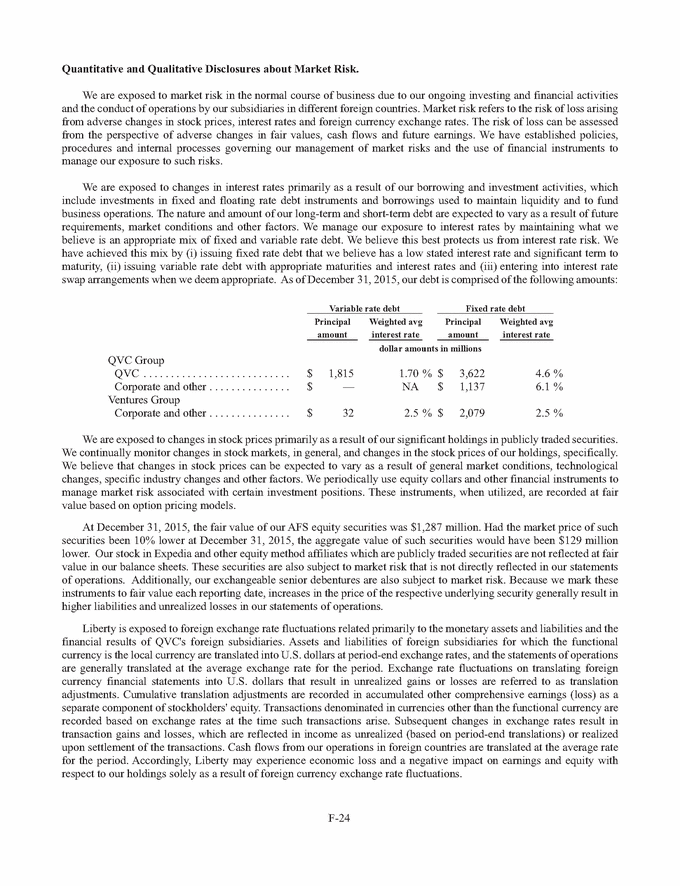
We periodically assess the effectiveness of our derivative financial instruments. With regard to interest rate swaps, we monitor the fair value of interest rate swaps as well as the effective interest rate the interest rate swap yields, in comparison to historical interest rate trends. We believe that any losses incurred with regard to interest rate swaps would be largely offset by the effects of interest rate movements on the underlying debt facilities. These measures allow our management to evaluate the success of our use of derivative instruments and to determine when to enter into or exit from derivative instruments. Financial Statements and Supplementary Data. The consolidated financial statements of Liberty Interactive Corporation are filed under this Item, beginning on page F-31. The financial statement schedules required by Regulation S-X are filed under Item 15 of this Annual Report on Form 10-K. Changes in and Disagreements with Accountants on Accounting and Financial Disclosure. None. Controls and Procedures. Disclosure Controls and Procedures In accordance with Exchange Act Rules 13a-15 and 15d-15, the Company carried out an evaluation, under the supervision and with the participation of management, including its chief executive officer and its principal accounting and financial officer (the “Executives”), of the effectiveness of its disclosure controls and procedures as of the end of the period covered by this report. Based on that evaluation, the Executives concluded that the Company's disclosure controls and procedures were not effective as of December 31, 2015 because of the material weakness in our internal control over financial reporting that is described below in “Management’s Report on Internal Control Over Financial Reporting.” However, giving full consideration to the material weakness, the Company’s management has concluded that the consolidated financial statements included in this annual report present fairly, in all material respects, the Company’s financial position, results of operations and cash flows for the periods disclosed in conformity with U.S. generally accepted accounting principles. KPMG LLP has issued its report dated February 26, 2016, which expressed an unqualified opinion on those consolidated financial statements. Management’s Report on Internal Control Over Financial Reporting See page F-27 for Management's Report on Internal Control Over Financial Reporting. See page F-28 for KPMG LLP’s attestation report regarding the effectiveness of our internal control over financial reporting. Changes in Internal Control Over Financial Reporting During the fourth quarter of 2015, the Company continued to review the design of QVC’s controls, made adjustments and continued to alleviate the noted control deficiencies. Other than these items, there was no change in the Company’s internal control over financial reporting that occurred during the Company’s quarter ended December 31, 2015, that has materially affected, or is reasonably likely to materially affect, the Company’s internal control over financial reporting. Remediation Plan for Material Weakness in Internal Control over Financial Reporting See “Item 9A. Controls and Procedures – Management’s Report on Internal Control Over Financial Reporting” and “Item 9A. Controls and Procedures – Remediation Plan for Material Weakness in Internal Control Over Financial Reporting” contained in the Company’s report on Form 10-K for the fiscal year ended December 31, 2014 for disclosure of information about the material weakness that was reported as a result of the Company’s annual assessment as of December 31, 2014 and remediation plans for that material weakness. The Company has been implementing and executing its previously disclosed remediation plans; however, based on the Company’s evaluation as of December 31, 2015, a material weakness continues to exist at December 31, 2015. F-25
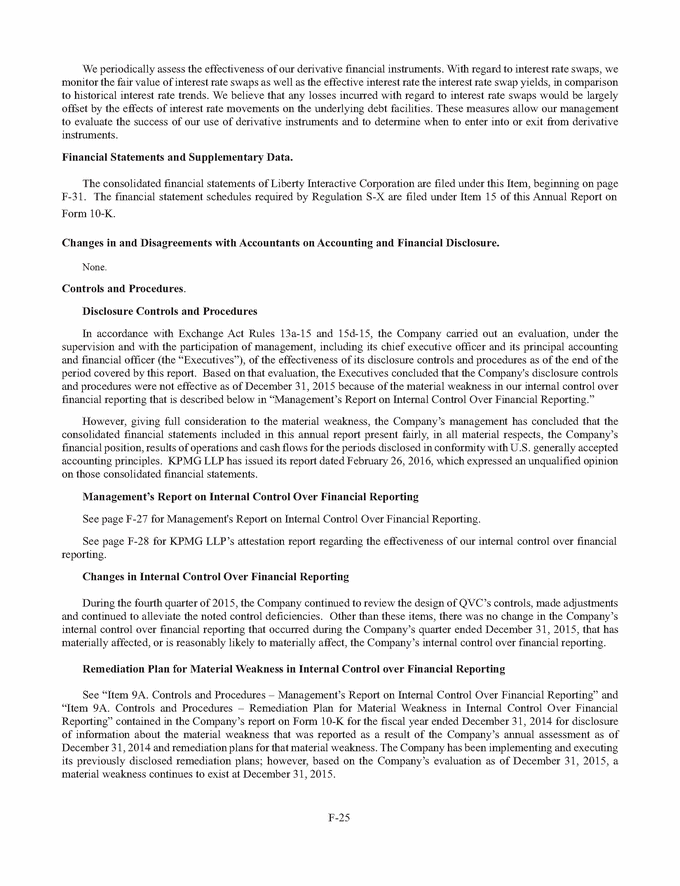
In response to the material weakness identified in Management’s Report on Internal Control Over Financial Reporting, as of December 31, 2015, the Company and QVC have implemented a plan with oversight from the Audit Committee of the Board of Directors to remediate the material weakness. The remediation efforts identified and implemented include the following: • A monitoring control was established to identify inappropriate user access and incompatible or conflicting functions. The work of the identified individuals, with such duties, were then reviewed to determine whether they inappropriately utilized the incompatible or conflicting functions to perform any inappropriate activity. • Monitoring controls over manual and post-close journal entries were enhanced to ensure that there is adequate oversight over such entries. • Additionally, procedures were established to validate the completeness and accuracy of reports used in the financial reporting process to support control activities. The Company and QVC believe the foregoing efforts effectively remediated the material weakness described in “Management's Report on Internal Control Over Financial Reporting” after the assessment date and prior to the filing of this Annual Report on Form 10-K. However, because the reliability of the internal control process requires repeatable execution, the successful on-going remediation of this material weakness will require on-going review and evidence of effectiveness. Additionally, the Company and QVC intend to continue to monitor the incompatible or conflicting roles and related end user access to determine whether additional adjustments, to reduce or eliminate the occurrences of segregation of duties issues, should be made to such roles. This could further reduce the reliance on the monitoring controls identified. Other Information. None. F-26
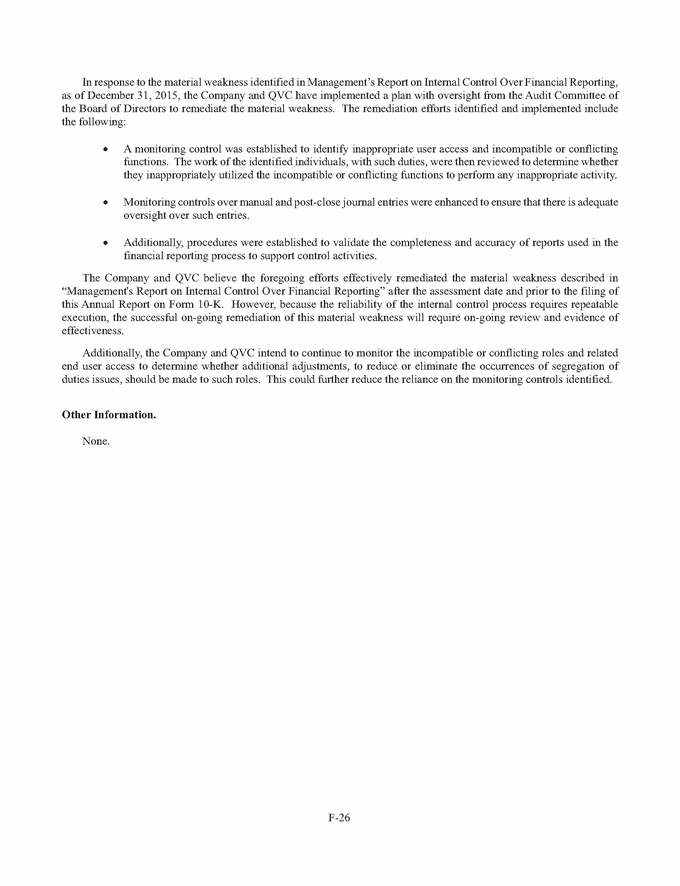
MANAGEMENT'S REPORT ON INTERNAL CONTROL OVER FINANCIAL REPORTING Liberty Interactive Corporation’s (the “Company”) management is responsible for establishing and maintaining adequate internal control over the Company’s financial reporting, as such term is defined in Rule 13a-15(f) of the Securities Exchange Act of 1934. The Company’s internal control over financial reporting is designed to provide reasonable assurance regarding the reliability of financial reporting and the preparation of financial statements for external purposes in accordance with accounting principles generally accepted in the United States of America. Because of inherent limitations, internal control over financial reporting may not prevent or detect misstatements. Also, projections of any evaluation of effectiveness to future periods are subject to the risk that controls may become inadequate because of changes in conditions, or that the degree of compliance with the policies and procedures may deteriorate. The Company’s management assessed the effectiveness of internal control over financial reporting as of December 31, 2015, using the criteria in Internal Control-Integrated Framework (2013), issued by the Committee of Sponsoring Organizations of the Treadway Commission. Based on this assessment, management has concluded that, as of December 31, 2015, our internal control over financial reporting is not effective due to the material weakness described below. The Company's assessment of internal control over financial reporting did not include the internal controls of zulily, llc, which the Company acquired in the fourth quarter of 2015. The amount of total assets and revenue of zulily, llc included in our consolidated financial statements as of and for the year ended December 31, 2015 was $2.7 billion and $426 million, respectively. A material weakness is a deficiency, or a combination of deficiencies, in internal control over financial reporting, such that there is a reasonable possibility that a material misstatement of the Company’s annual or interim financial statements will not be prevented or detected on a timely basis. Based on its evaluation of internal control over financial reporting as described above, management concluded that it did not design and maintain effective internal controls with respect to information technology controls and the associated information produced by the Company’s wholly-owned subsidiary, QVC, Inc. Specifically, the following items were not designed and operating effectively: •Segregation of duties to ensure that incompatible functions did not overlap and that the activities of individuals with incompatible functions or who have access to certain critical transactions were appropriately monitored; and •Controls over the review of manual and post-close journal entries and the completeness and accuracy of reports utilized in the financial reporting process to support control activities. While the control deficiency identified did not result in any material misstatements a reasonable possibility exists that a material misstatement to the annual or interim consolidated financial statements and disclosures will not be prevented or detected on a timely basis. The Company's independent registered public accounting firm who audited the consolidated financial statements included in the Annual Report on Form 10-K have issued an adverse report on the effectiveness of the Company's internal control over financial reporting. This attestation report appears on page F-28 of this Annual Report on Form 10-K. F-27
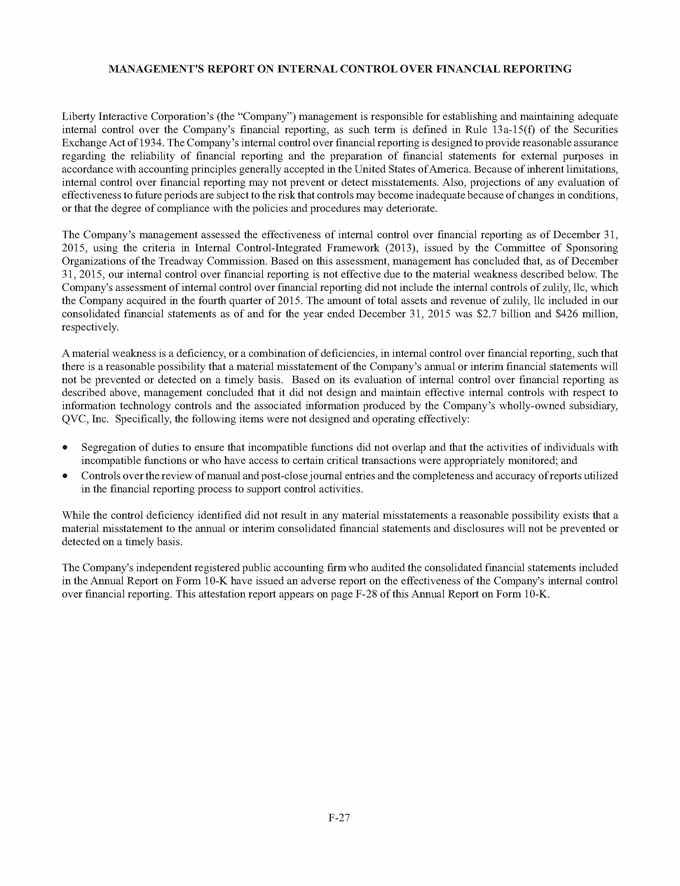
Report of Independent Registered Public Accounting Firm The Board of Directors and Stockholders Liberty Interactive Corporation: We have audited Liberty Interactive Corporation’s (the Company) internal control over financial reporting as of December 31, 2015, based on criteria established in Internal Control – Integrated Framework (2013), issued by the Committee of Sponsoring Organizations of the Treadway Commission (COSO). The Company’s management is responsible for maintaining effective internal control over financial reporting and for its assessment of the effectiveness of internal control over financial reporting, included in the accompanying Management’s Report on Internal Control Over Financial Reporting on page F-27. Our responsibility is to express an opinion on the Company’s internal control over financial reporting based on our audit. We conducted our audit in accordance with the standards of the Public Company Accounting Oversight Board (United States). Those standards require that we plan and perform the audit to obtain reasonable assurance about whether effective internal control over financial reporting was maintained in all material respects. Our audit included obtaining an understanding of internal control over financial reporting, assessing the risk that a material weakness exists, and testing and evaluating the design and operating effectiveness of internal control based on the assessed risk. Our audit also included performing such other procedures as we considered necessary in the circumstances. We believe that our audit provides a reasonable basis for our opinion. A company’s internal control over financial reporting is a process designed to provide reasonable assurance regarding the reliability of financial reporting and the preparation of financial statements for external purposes in accordance with generally accepted accounting principles. A company’s internal control over financial reporting includes those policies and procedures that (1) pertain to the maintenance of records that, in reasonable detail, accurately and fairly reflect the transactions and dispositions of the assets of the company; (2) provide reasonable assurance that transactions are recorded as necessary to permit preparation of financial statements in accordance with generally accepted accounting principles, and that receipts and expenditures of the company are being made only in accordance with authorizations of management and directors of the company; and (3) provide reasonable assurance regarding prevention or timely detection of unauthorized acquisition, use, or disposition of the company’s assets that could have a material effect on the financial statements. Because of its inherent limitations, internal control over financial reporting may not prevent or detect misstatements. Also, projections of any evaluation of effectiveness to future periods are subject to the risk that controls may become inadequate because of changes in conditions, or that the degree of compliance with the policies or procedures may deteriorate. A material weakness is a deficiency, or a combination of deficiencies, in internal control over financial reporting, such that there is a reasonable possibility that a material misstatement of the company’s annual or interim financial statements will not be prevented or detected on a timely basis. A material weakness related to the design and operating effectiveness of information technology controls and the associated information produced by the Company’s wholly-owned subsidiary, QVC, Inc. has been identified and included in management’s assessment. We also have audited, in accordance with the standards of the Public Company Accounting Oversight Board (United States), the consolidated balance sheets of the Company as of December 31, 2015 and 2014, and the related consolidated statements of operations, comprehensive earnings (loss), cash flows, and equity for each of the years in the three-year period ended December 31, 2015. This material weakness was considered in determining the nature, timing, and extent of audit tests applied in our audit of the 2015 consolidated financial statements, and this report does not affect our report dated February 26, 2016, which expressed an unqualified opinion on those consolidated financial statements. In our opinion, because of the effect of the aforementioned material weakness on the achievement of the objectives of the control criteria, the Company has not maintained effective internal control over financial reporting as of December 31, 2015, based on criteria established in Internal Control—Integrated Framework (2013) issued by the Committee of Sponsoring Organizations of the Treadway Commission (COSO). The Company acquired zulily, inc. (“zulily”) during 2015, and management excluded from its assessment of the effectiveness of the Company's internal control over financial reporting as of December 31, 2015, zulily’s internal control F-28

over financial reporting associated with total assets of $2.7 billion and total revenues of $426 million included in the consolidated financial statements of Liberty Interactive Corporation and subsidiaries as of and for the year ended December 31, 2015. Our audit of internal control over financial reporting of the Company also excluded an evaluation of internal control over financial reporting of zulily. /s/ KPMG LLP Denver, Colorado February 26, 2016 F-29
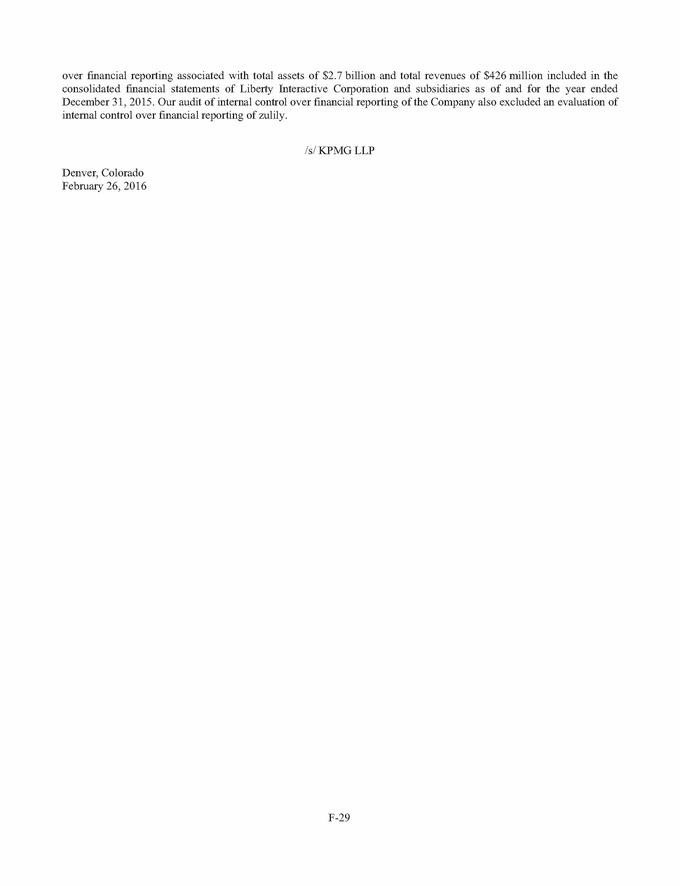
Report of Independent Registered Public Accounting Firm The Board of Directors and Stockholders Liberty Interactive Corporation: We have audited the accompanying consolidated balance sheets of Liberty Interactive Corporation and subsidiaries (the Company) as of December 31, 2015 and 2014, and the related consolidated statements of operations, comprehensive earnings (loss), cash flows, and equity for each of the years in the three-year period ended December 31, 2015. These consolidated financial statements are the responsibility of the Company’s management. Our responsibility is to express an opinion on these consolidated financial statements based on our audits. We conducted our audits in accordance with the standards of the Public Company Accounting Oversight Board (United States). Those standards require that we plan and perform the audit to obtain reasonable assurance about whether the financial statements are free of material misstatement. An audit includes examining, on a test basis, evidence supporting the amounts and disclosures in the financial statements. An audit also includes assessing the accounting principles used and significant estimates made by management, as well as evaluating the overall financial statement presentation. We believe that our audits provide a reasonable basis for our opinion. In our opinion, the consolidated financial statements referred to above present fairly, in all material respects, the financial position of the Company as of December 31, 2015 and 2014, and the results of their operations and their cash flows for each of the years in the three-year period ended December 31, 2015, in conformity with U.S. generally accepted accounting principles. As discussed in note 3 to the consolidated financial statements, in 2015 the Company adopted ASU 2015-17: Income Taxes (Topic 740): Balance Sheet Classification of Deferred Taxes. We also have audited, in accordance with the standards of the Public Company Accounting Oversight Board (United States), the Company’s internal control over financial reporting as of December 31, 2015, based on criteria established in Internal Control – Integrated Framework (2013) issued by the Committee of Sponsoring Organizations of the Treadway Commission (COSO), and our report dated February 26, 2016 expressed an adverse opinion on the effectiveness of the Company’s internal control over financial reporting. /s/ KPMG LLP Denver, Colorado February 26, 2016 F-30
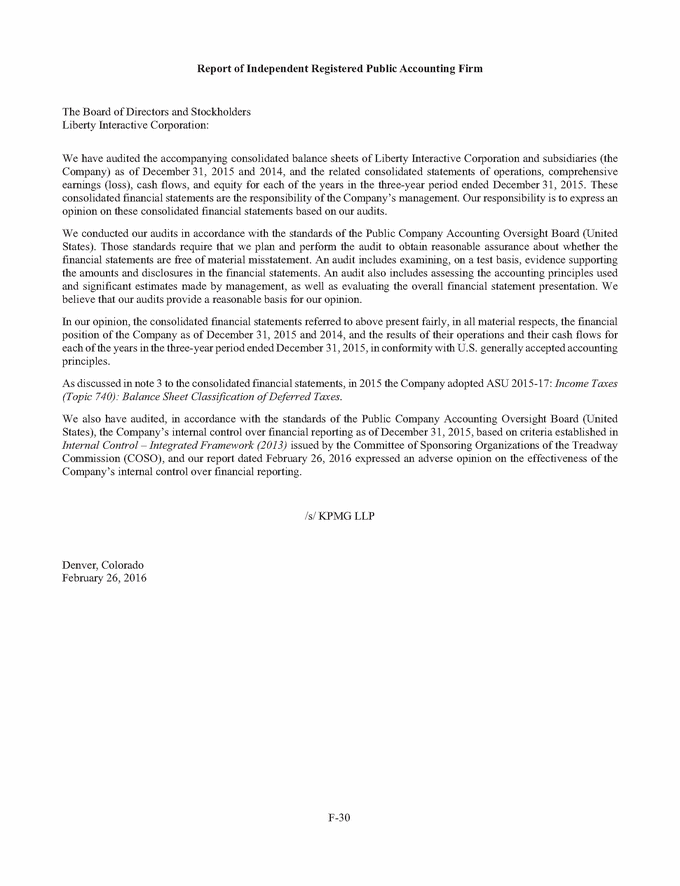
LIBERTY INTERACTIVE CORPORATION AND SUBSIDIARIES Consolidated Balance Sheets December 31, 2015 and 2014 2015 2014 Assets Current assets: Cash and cash equivalents Trade and other receivables, net Inventory, net Short-term marketable securities Other current assets. Total current assets Investments in available-for-sale securities and other cost investments (note 8) Investments in affiliates, accounted for using the equity method (note 9) amounts in millions $ 2,449 1,443 1,000 910 73 2,306 1,232 1,049 889 72 5,875 5,548 1,353 1,641 1,224 1,633 Property and equipment, at cost Accumulated depreciation 2,124 (984) 2,030 (937) 1,140 1,093 Intangible assets not subject to amortization (note 10): Goodwill Trademarks 6,112 3,373 5,404 2,489 9,485 7,893 Intangible assets subject to amortization, net (note 10) Other assets, at cost, net of accumulated amortization Total assets 1,647 39 1,185 22 $ 21,180 18,598 (continued) F-31
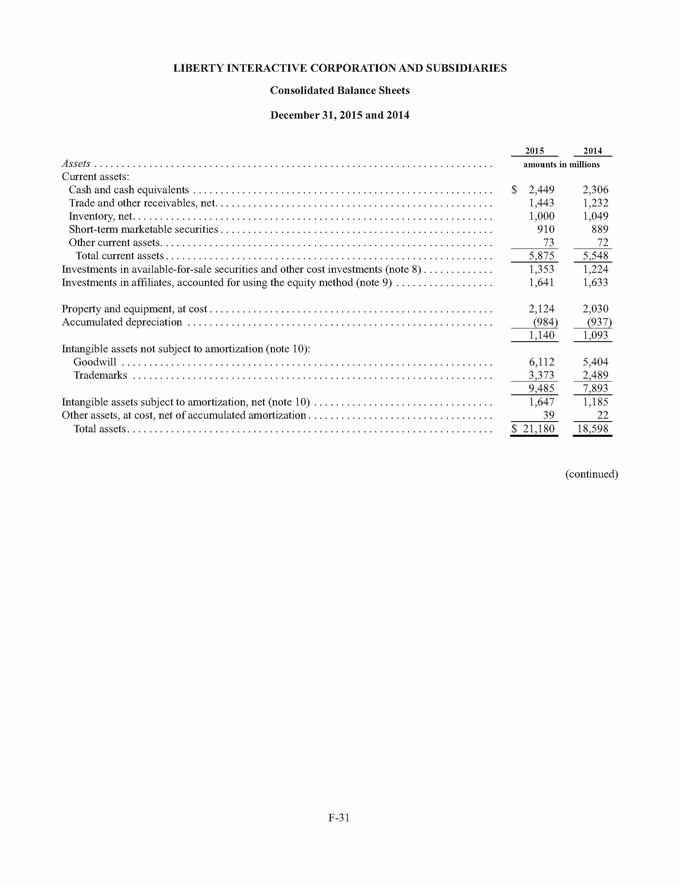
LIBERTY INTERACTIVE CORPORATION AND SUBSIDIARIES Consolidated Balance Sheets (Continued) December 31, 2015 and 2014 2015 2014 amounts in millions Liabilities and Equity Current liabilities: Accounts payable Accrued liabilities Current portion of debt (note 11) Other current liabilities Total current liabilities Long-term debt, including $2,480 million and $2,574 million measured at fair value (note 11) Deferred income tax liabilities (note 12) Other liabilities Total liabilities Equity Stockholders' equity (note 13): Preferred stock, $.01 par value. Authorized 50,000,000 shares; no shares issued Series A QVC Group common stock, $.01 par value. Authorized 4,000,000,000 shares; issued and outstanding 461,379,963 shares at December 31, 2015 and 447,451,702 shares at December 31, 2014. Series B QVC Group common stock, $.01 par value. Authorized 150,000,000 shares; issued and outstanding 29,218,527 shares at December 31, 2015 and 28,877,554 shares at December 31, 2014. Series A Liberty Ventures common stock, $.01 par value. Authorized 400,000,000 shares at December 31, 2015 and 200,000,000 shares at December 31, 2014; issued and outstanding 134,961,466 shares at December 31, 2015 and 134,525,874 shares at December 31, 2014 Series B Liberty Ventures common stock, $.01 par value. Authorized 15,000,000 shares at December 31, 2015 and 7,500,000 shares at December 31, 2014; issued and outstanding 7,092,111 shares at December 31, 2015 and 6,991,127 shares at December 31, 2014. Additional paid-in capital Accumulated other comprehensive earnings (loss), net of taxes Retained earnings Total stockholders' equity Noncontrolling interests in equity of subsidiaries Total equity Commitments and contingencies (note 18) Total liabilities and equity $ 762 784 1,226 328 735 743 946 343 3,100 2,767 7,481 3,502 222 7,062 2,821 168 14,305 12,818 — — 5 5 — — 1 1 — 370 (215) 6,626 — 4 (94) 5,757 6,787 88 5,673 107 6,875 5,780 $ 21,180 18,598 See accompanying notes to consolidated financial statements. F-32
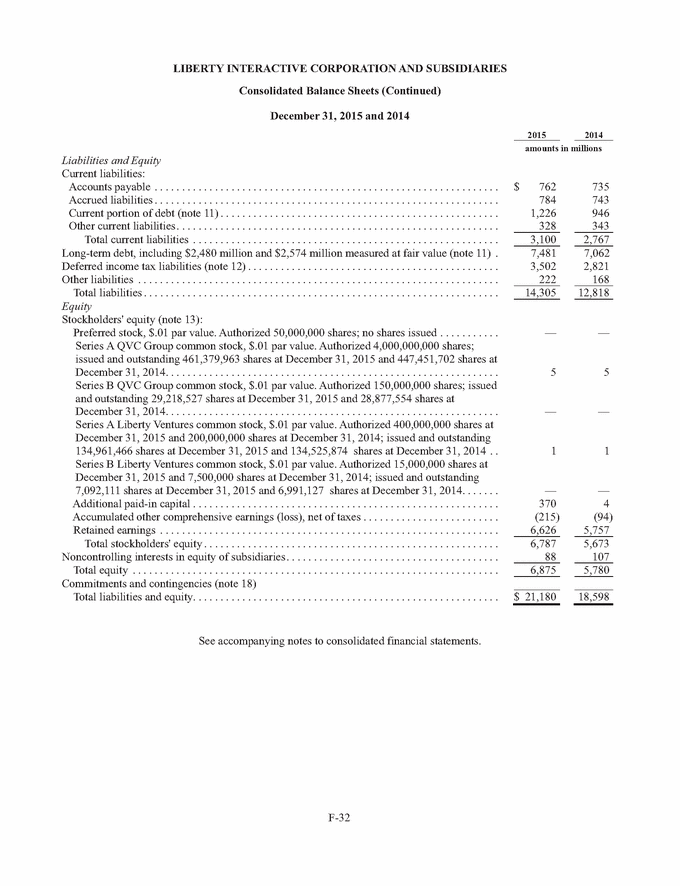
LIBERTY INTERACTIVE CORPORATION AND SUBSIDIARIES Consolidated Statements Of Operations Years ended December 31, 2015, 2014 and 2013 2015 2014 2013 amounts in millions, except per share amounts Total revenue, net Operating costs and expenses: Cost of retail sales (exclusive of depreciation shown separately below) Operating expense Selling, general and administrative, including stock-based compensation (note 3) Depreciation and amortization Impairment of intangible assets $ 9,989 10,499 10,219 6,393 699 1,078 703 — 6,684 756 1,202 662 7 6,533 732 1,159 629 30 8,873 9,311 9,083 Operating income Other income (expense): Interest expense Share of earnings (losses) of affiliates, net (note 9) Realized and unrealized gains (losses) on financial instruments, net (note 7) Gains (losses) on transactions, net Gains (losses) on dilution of investments in affiliates (note 9) Other, net 1,116 1,188 1,136 (360) (60) 114 110 314 19 (387) 39 (57) 74 (2) (19) (380) 33 (22) (1) 1 (30) 137 (352) (399) Earnings (loss) from continuing operations before income taxes Income tax (expense) benefit (note 12) Earnings (loss) from continuing operations Earnings (loss) from discontinued operations, net of taxes (note 6) Net earnings (loss) Less net earnings (loss) attributable to the noncontrolling interests Net earnings (loss) attributable to Liberty Interactive Corporation shareholders Net earnings (loss) attributable to Liberty Interactive Corporation shareholders: QVC Group common stock Liberty Ventures common stock 1,253 (342) 836 (258) 737 (183) 911 — 578 48 554 26 911 42 626 89 580 79 $ 869 537 501 640 229 520 17 438 63 $ 869 537 501 Basic net earnings (loss) from continuing operations attributable to Liberty Interactive Corporation shareholders per common share (note 3): Series A and Series B QVC Group common stock Series A and Series B Liberty Ventures common stock Diluted net earnings (loss) from continuing operations attributable to Liberty Interactive Corporation shareholders per common share (note 3): Series A and Series B QVC Group common stock Series A and Series B Liberty Ventures common stock Basic net earnings (loss) attributable to Liberty Interactive Corporation shareholders per common share (note 3): Series A and Series B QVC Group common stock Series A and Series B Liberty Ventures common stock Diluted net earnings (loss) attributable to Liberty Interactive Corporation shareholders per common share (note 3): Series A and Series B QVC Group common stock Series A and Series B Liberty Ventures common stock $ $ 1.35 1.61 1.10 0.03 0.88 0.74 $ $ 1.33 1.60 1.09 0.03 0.86 0.73 $ $ 1.35 1.61 1.07 0.19 0.85 0.86 $ $ 1.33 1.60 1.06 0.19 0.83 0.85 See accompanying notes to consolidated financial statements. F-33
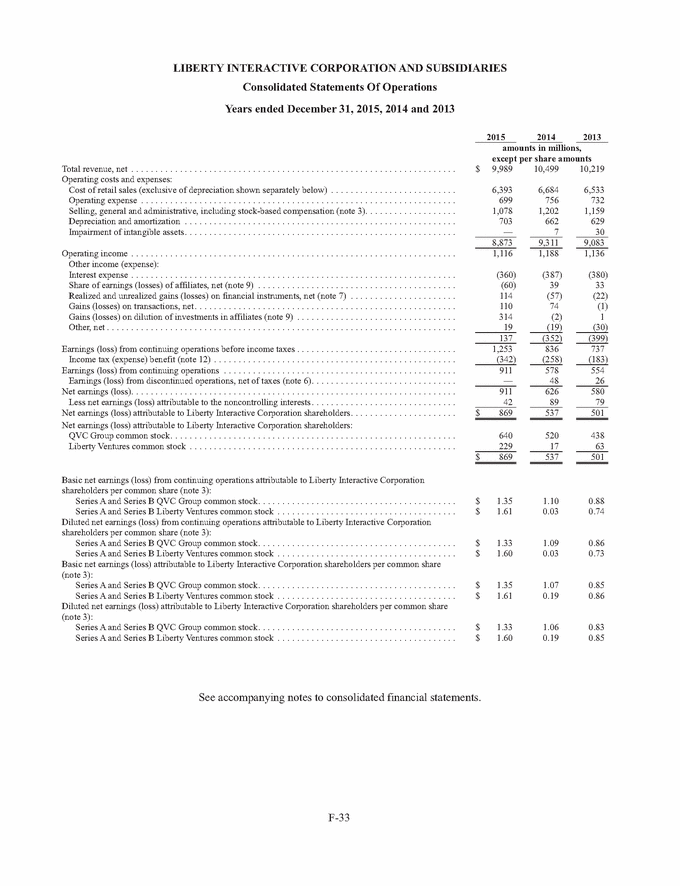
LIBERTY INTERACTIVE CORPORATION AND SUBSIDIARIES Consolidated Statements Of Comprehensive Earnings (Loss) Years ended December 31, 2015, 2014 and 2013 2015 2014 2013 amounts in millions Net earnings (loss) Other comprehensive earnings (loss), net of taxes: Foreign currency translation adjustments Share of other comprehensive earnings (loss) of equity affiliates Other comprehensive earnings (loss) from discontinued operations. Other comprehensive earnings (loss) Comprehensive earnings (loss) Less comprehensive earnings (loss) attributable to the noncontrolling interests Comprehensive earnings (loss) attributable to Liberty Interactive Corporation shareholders. Comprehensive earnings (loss) attributable to Liberty Interactive Corporation shareholders: QVC Group common stock Liberty Ventures common stock $ 911 626 580 (101) (21) — (192) (18) (1) (73) 2 (3) (122) (211) (74) 789 41 415 77 506 54 $ 748 338 452 $ 540 208 336 2 387 65 $ 748 338 452 See accompanying notes to consolidated financial statements. F-34
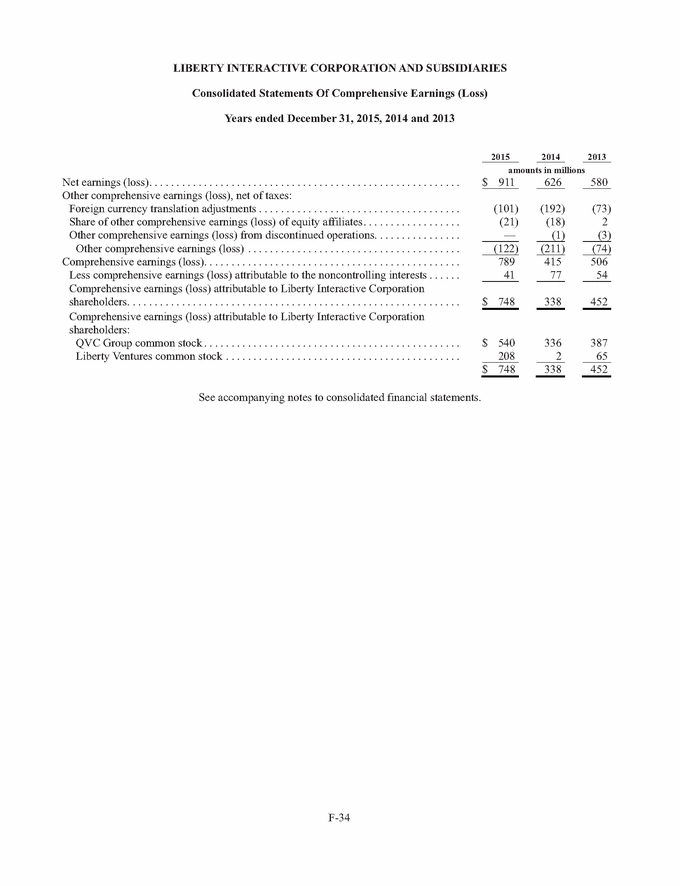
LIBERTY INTERACTIVE CORPORATION AND SUBSIDIARIES Consolidated Statements Of Cash Flows Years ended December 31, 2015, 2014 and 2013 2015 2014 2013 amounts in millions (See note 4) Cash flows from operating activities: Net earnings (loss) Adjustments to reconcile net earnings to net cash provided by operating activities: (Earnings) loss from discontinued operations Depreciation and amortization Stock-based compensation Cash payments for stock-based compensation Excess tax benefit from stock-based compensation Noncash interest expense Share of (earnings) losses of affiliates, net Cash receipts from returns on equity investments Realized and unrealized (gains) losses on financial instruments, net (Gains) losses on transactions, net (Gains) losses on dilution of investments in affiliates (Gains) losses on extinguishment of debt Impairment of intangible assets Deferred income tax expense (benefit) Other noncash charges (credits), net Changes in operating assets and liabilities Current and other assets Payables and other liabilities Net cash provided (used) by operating activities Cash flows from investing activities: Cash (paid) for acquisitions, net of cash acquired Cash proceeds from dispositions of investments Investment in and loans to cost and equity investees Cash receipts from returns of equity investments Capital expended for property and equipment Purchases of short term investments and other marketable securities Sales of short term investments and other marketable securities Other investing activities, net Net cash provided (used) by investing activities Cash flows from financing activities: Borrowings of debt Repayments of debt Repurchases of QVC Group common stock Minimum withholding taxes on net share settlements of stock-based compensation Excess tax benefit from stock-based compensation Purchase of noncontrolling interest Other financing activities, net Net cash provided (used) by financing activities Effect of foreign currency exchange rates on cash Net cash provided (used) by discontinued operations: Cash provided (used) by operating activities Cash provided (used) by investing activities Cash provided (used) by financing activities Change in available cash held by discontinued operations Net cash provided (used) by discontinued operations Net increase (decrease) in cash and cash equivalents Cash and cash equivalents at beginning of period Cash and cash equivalents at end of period $ 911 626 580 — 703 127 (16) (33) 5 60 52 (114) (110) (314) 21 — 51 (16) (48) 662 108 (15) (21) 6 (39) 45 57 (74) 2 48 7 (41) (4) (26) 629 118 (8) (13) 13 (33) 35 22 1 (1) 57 30 (22) (2) (237) (44) (84) 405 (84) (269) 1,046 1,640 1,027 (844) 271 (143) 250 (258) (1,370) 1,359 (76) — 163 (91) — (241) (864) 591 (16) (24) 1,137 (384) — (291) (959) 400 (41) (811) (458) (162) 4,558 (3,811) (785) (30) 33 (33) (21) 4,506 (3,749) (785) (26) 21 — (33) 4,361 (5,415) (1,089) (21) 13 — (57) (89) (66) (2,208) (3) (46) (24) — — — — 273 (194) 371 (116) 333 (198) (172) 15 — 334 (22) 143 2,306 1,404 902 (1,389) 2,291 $ 2,449 2,306 902 See accompanying notes to consolidated financial statements. F-35
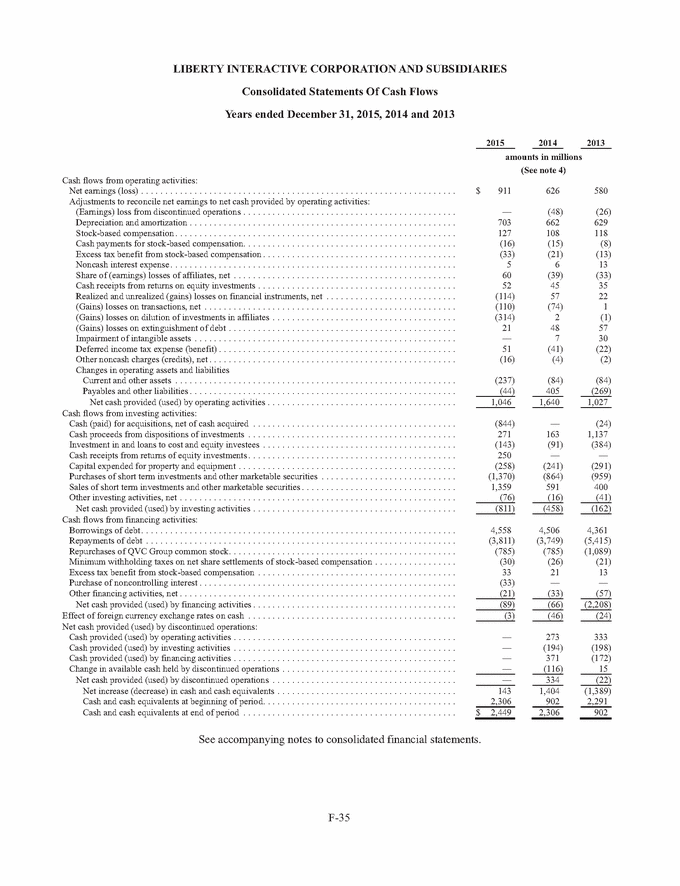
LIBERTY INTERACTIVE CORPORATION AND SUBSIDIARIES Consolidated Statement Of Equity Years ended December 31, 2015, 2014 and 2013 Stockholders' Equity QVC Group Liberty Ventures Accumulated other comprehensive earnings Noncontrolling interest in equity of subsidiaries Additional paid-in capital Preferred Stock Retained Earnings Total equity Series A Series B Series A Series B amounts in millions 2,224 — — 93 (38) 23 5 (1,089) — (63) (7) (2) Balance at January 1, 2013 Net earnings Other comprehensive earnings (loss) Stock-based compensation Minimum withholding taxes on net share settlements of stock-based compensation Excess tax benefits on stock-based compensation Stock issued upon exercise of stock options Series A QVC Group stock repurchases Distribution to noncontrolling interest Shares repurchased by subsidiary Shares issued by subsidiary Other Balance at December 31, 2013 Net earnings Other comprehensive earnings (loss) Stock-based compensation Minimum withholding taxes on net share settlements of stock-based compensation Excess tax benefits on stock-based compensation Stock issued upon exercise of stock options Series A QVC Group stock repurchases Distribution to noncontrolling interest Shares issued by subsidiary Distribution of Liberty TripAdvisor Holdings, Inc. Balance at December 31, 2014 Net earnings Other comprehensive earnings (loss) Stock-based compensation Minimum withholding taxes on net share settlements of stock-based compensation Excess tax benefits on stock-based compensation Stock issued upon exercise of stock options Series A QVC Group stock repurchases Distribution to noncontrolling interest Acquisition of zulily Acquisition of noncontrolling interest Other Balance at December 31, 2015 $ — — — — — — — — — — — — 5 — — — — — — — — — — — — — — — — — — — — — — — 1 — — — — — — — — — — — — — — — — — — — — — — — 148 — (49) — — — — — — — — — 5,184 501 — — — — — — — — — — 4,489 79 (25) 49 — — — — (45) (82) 34 — 12,051 580 (74) 142 (38) 23 5 (1,089) (45) (145) 27 (2) $ — — — — — — — — — — — 5 — — — — — — — — — — — — — — — — — — — — — 1 — — — — — — — — — — — — — — — — — — — — — 1,146 — — 103 (58) 35 36 (785) — (8) (465) 99 — (199) — — — — — — — 6 5,685 537 — — — — — — — — (465) 4,499 89 (12) 39 — — — — (42) 8 (4,474) 11,435 626 (211) 142 (58) 35 36 (785) (42) — (5,398) $ — — — — — — — — — — — — 5 — — — — — — — — — — — — — — — — — — — — — — — 1 — — — — — — — — — — — — — — — — — — — — — — — 4 — — 70 (30) 16 40 (785) — 1,087 (31) (1) (94) — (121) — — — — — — — — — 5,757 869 — — — — — — — — — — 107 42 (1) — — — — — (58) — (2) — 5,780 911 (122) 70 (30) 16 40 (785) (58) 1,087 (33) (1) $ — 5 — 1 — 370 (215) 6,626 88 6,875 See accompanying notes to consolidated financial statements. F-36
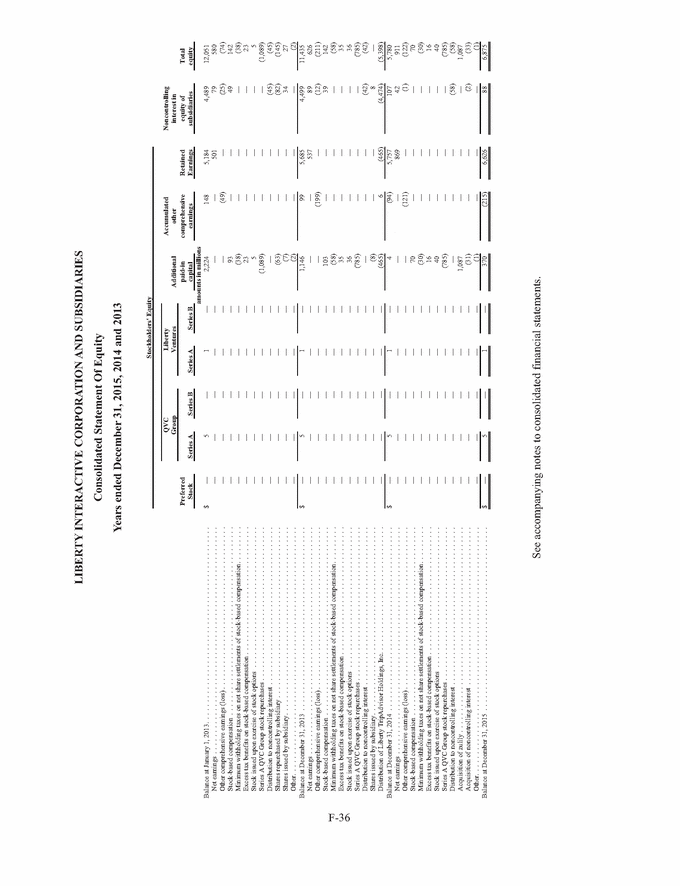
LIBERTY INTERACTIVE CORPORATION AND SUBSIDIARIES Notes to Consolidated Financial Statements December 31, 2015, 2014 and 2013 (1) Basis of Presentation The accompanying consolidated financial statements include the accounts of Liberty Interactive Corporation (formerly known as Liberty Media Corporation) and its controlled subsidiaries (collectively, "Liberty" or the "Company" unless the context otherwise requires). All significant intercompany accounts and transactions have been eliminated in consolidation. Liberty, through its ownership of interests in subsidiaries and other companies, is primarily engaged in the video and on-line commerce industries in North America, Europe and Asia. As further discussed in note 6, on August 27, 2014, Liberty completed the spin-off to holders of its Liberty Ventures common stock shares of its former wholly-owned subsidiary, Liberty TripAdvisor Holdings, Inc. (“TripAdvisor Holdings”) (the “TripAdvisor Holdings Spin-Off”). TripAdvisor Holdings is comprised of Liberty’s former 22% economic and 57% voting interest in TripAdvisor, Inc. (“TripAdvisor”) as well as BuySeasons, Inc. (“BuySeasons”), Liberty’s former wholly-owned subsidiary, and a corporate level net debt balance of $350 million. In connection with the TripAdvisor Holdings Spin-Off during August 2014, TripAdvisor Holdings drew down $400 million in margin loans and distributed approximately $350 million to Liberty. Concurrently with the margin loans, Liberty and TripAdvisor Holdings entered into a promissory note whereby TripAdvisor Holdings may request, if the closing price per share of TripAdvisor common stock were to fall below certain minimum values, up to $200 million in funds from Liberty. The TripAdvisor Holdings Spin-Off has been recorded at historical cost due to the pro rata nature of the distribution. Following the completion of the TripAdvisor Holdings Spin-Off, Liberty and TripAdvisor Holdings operate as separate, publicly traded companies, and neither has any stock ownership, beneficial or otherwise, in the other. The consolidated financial statements of Liberty have been prepared to reflect TripAdvisor Holdings as discontinued operations. Accordingly, the assets and liabilities, revenue, costs and expenses, and cash flows of the businesses, assets and liabilities owned by TripAdvisor Holdings at the time of the TripAdvisor Holdings Spin-Off have been excluded from the respective captions in the accompanying consolidated balance sheets, statements of operations, comprehensive earnings (loss) and cash flows in such consolidated financial statements. Additionally, on October 3, 2014, Liberty announced that its board of directors approved the change in attribution from the Interactive Group (which we refer to as the QVC Group) to the Ventures Group of its Digital Commerce companies (defined below) and cash. The reattributed Digital Commerce companies are comprised of Liberty’s subsidiaries Backcountry.com, Inc. (“Backcountry”), Bodybuilding.com, LLC (“Bodybuilding”), CommerceHub, Evite, Inc. (“Evite”), and Provide Commerce, Inc. (“Provide”) (collectively, the “Digital Commerce” companies). See note 2 for additional information on the reattribution. On December 31, 2014, Liberty announced the closing of the acquisition by FTD Companies, Inc. ("FTD") of Provide (the “FTD Transaction”). Under the terms of the transaction, Liberty received approximately 10.2 million shares of FTD common stock representing approximately 35% of the combined company and approximately $145 million in cash. We recognized a gain of $75 million as a result of this transaction, which is included in the Gains (losses) on transactions, net line item in the consolidated statement of operations. Subsequent to completion of the transaction, Liberty accounts for FTD as an equity-method affiliate based on the ownership level and board representation. The FTD Transaction resulted in a non-cash investing addition of $355 million to the investments in affiliates, accounted for using the equity method line item within the consolidated balance sheets. Given our significant continuing involvement with FTD, Provide is not presented as a discontinued operation in the consolidated financial statements of Liberty. On October 1, 2015, Liberty acquired all the outstanding shares of zulily, inc. (“zulily”) (now known as zulily, llc). zulily is an online retailer offering customers a fun and entertaining shopping experience with a fresh selection of new F-37
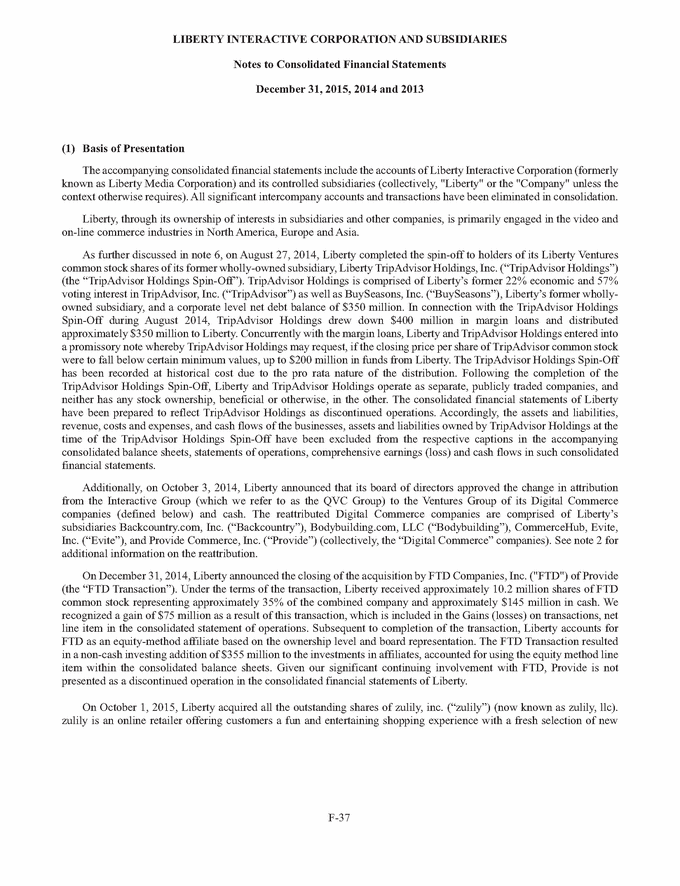
LIBERTY INTERACTIVE CORPORATION AND SUBSIDIARIES Notes to Consolidated Financial Statements (Continued) December 31, 2015, 2014 and 2013 product styles launched every day. Effective October 1, 2015, zulily is attributed to the QVC Group. See note 5 for additional information related to the acquisition. On November 12, 2015, Liberty announced that its board of directors authorized management to pursue a plan to spin-off to holders of its Liberty Ventures common stock shares of newly formed companies to be called CommerceHub, Inc. and Liberty Expedia Holdings, Inc. (“Expedia Holdings”). CommerceHub, Inc. is expected to be comprised of the CommerceHub business. Expedia Holdings is expected to be comprised of, among other things, Liberty’s entire interest in Expedia, Inc. as well as Bodybuilding. The applicable record dates, distribution dates and distribution ratios for the spin-offs will be announced at a later date. Each of the spin-offs is intended to be tax-free to stockholders of Liberty Ventures and will be subject to various conditions including the receipt of an opinion of tax counsel. Subject to the satisfaction of the applicable conditions, the completion of each of the spin-offs is expected to occur in the first half of 2016. On September 23, 2011, Liberty completed the split-off of a wholly owned subsidiary, Liberty Media Corporation ("LMC") (formerly known as Liberty CapStarz, Inc. and prior thereto known as Liberty Splitco, Inc.) (the "LMC Split-Off"). Prior to the LMC Split-Off, Liberty's equity was structured into three separate tracking stocks, Liberty Interactive common stock, Liberty Starz common stock and Liberty Capital common stock, which were intended to track and reflect the economic performance of the separate businesses, assets and liabilities attributed to each group. These attributed businesses, assets and liabilities were not separate legal entities and therefore no group could own assets, issue securities or enter into legally binding agreements. Holders of the tracking stocks did not have direct claim to the group's stock or assets and were not represented by separate boards of directors. At the time of the LMC Split-Off, LMC owned all the assets, businesses and liabilities previously attributed to the Liberty Capital and Liberty Starz tracking stock groups. The LMC Split-Off was effected by means of a redemption of all of the Liberty Capital common stock and Liberty Starz common stock of Liberty in exchange for the common stock of LMC. This transaction was accounted for at historical cost due to the pro rata nature of the distribution. Following the LMC Split-Off, Liberty and LMC operate as separate, publicly traded companies, and neither has any stock ownership, beneficial or otherwise, in the other. In connection with the LMC Split-Off, Liberty and LMC entered into certain agreements in order to govern certain of the ongoing relationships between the two companies after the LMC Split-Off and to provide for an orderly transition. These agreements include a Reorganization Agreement, a Services Agreement, a Facilities Sharing Agreement and a Tax Sharing Agreement. The Tax Sharing Agreement provides for the allocation and indemnification of tax liabilities and benefits between Liberty and LMC and other agreements related to tax matters. Liberty is party to on-going discussions with the IRS under the Compliance Assurance Process audit program. The IRS may propose adjustments that relate to tax attributes allocated to and income allocable to LMC in the LMC Split-Off. Any potential outcome associated with any proposed adjustments would be covered by the Tax Sharing Agreement and are not expected to have any impact on Liberty's financial position. Pursuant to the Services Agreement, LMC will provide Liberty with general and administrative services including legal, tax, accounting, treasury and investor relations support. Liberty will reimburse LMC for direct, out-of-pocket expenses incurred by LMC in providing these services and for Liberty's allocable portion of costs associated with any shared services or personnel based on an estimated percentage of time spent providing services to Liberty. Under the Facilities Sharing Agreement, Liberty will share office space with LMC and related amenities at LMC's corporate headquarters. Under these various agreements approximately $13 million, $11 million and $15 million of these allocated expenses were reimbursed from Liberty to LMC for the years ended December 31, 2015, 2014 and 2013, respectively. (2) Tracking Stocks On August 9, 2012 Liberty completed the approved recapitalization of its common stock through the creation of the Liberty Interactive common stock and Liberty Ventures common stock as tracking stocks. In the recapitalization, each holder of Liberty Interactive Corporation common stock remained a holder of the same amount and series of Liberty Interactive common stock and received 0.05 of a share of the corresponding series of Liberty Ventures common stock, by means of a dividend, with cash issued in lieu of fractional shares of Liberty Ventures common stock. F-38
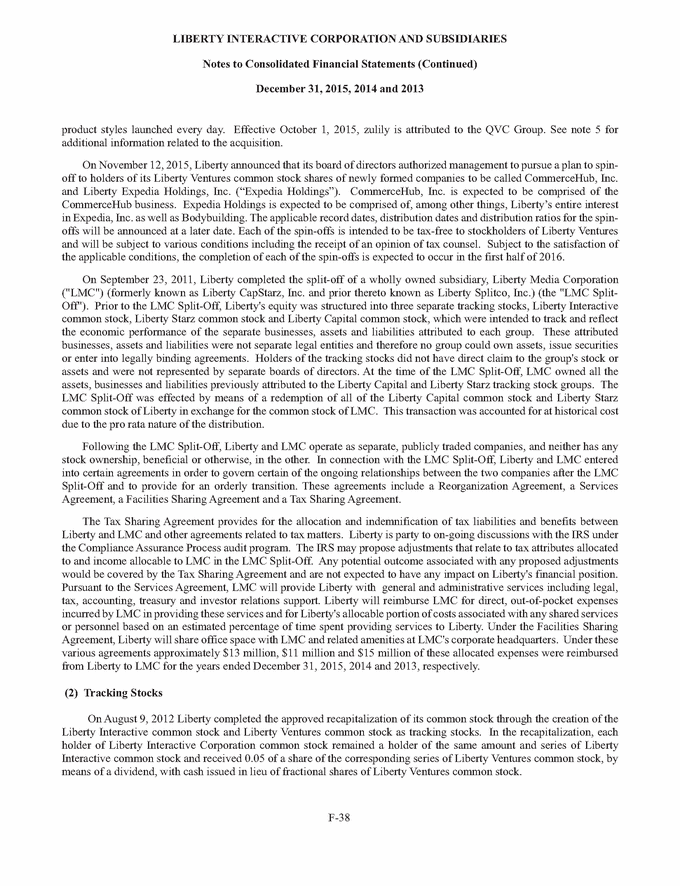
LIBERTY INTERACTIVE CORPORATION AND SUBSIDIARIES Notes to Consolidated Financial Statements (Continued) December 31, 2015, 2014 and 2013 On February 27, 2014, Liberty's board approved a two for one stock split of Series A and Series B Liberty Ventures common stock, effected by means of a dividend. The stock split was done in order to bring Liberty into compliance with a Nasdaq listing requirement regarding the minimum number of publicly held shares of the Series B Liberty Ventures common stock. In the stock split, a dividend was paid on April 11, 2014 of one share of Series A or Series B Liberty Ventures common stock to holders of each share of Series A or Series B Liberty Ventures common stock, respectively, held by them as of 5:00 pm, New York City time, on April 4, 2014. The stock split has been recorded retroactively for all periods presented for comparability purposes. As discussed in note 1, on October 3, 2014, Liberty announced that its board of directors approved the change in attribution from the QVC Group to the Ventures Group its Digital Commerce companies and cash, which was provided by QVC as a result of a draw-down of QVC’s credit facility. The reattribution of the Digital Commerce companies is presented on a prospective basis from the date of the reattribution in Liberty’s consolidated financial statements and attributed financial information, with October 1, 2014 used as a proxy for the date of the reattribution. In exchange for the Digital Commerce companies and $970 million of cash (collectively, the "Reattributed Assets"), an inter-group interest in the Ventures Group was created in favor of the QVC Group. This inter-group interest was represented as a number of shares of Liberty Ventures common stock issuable to the QVC Group, which we refer to as the "Inter-Group Interest Shares" (as calculated below). Immediately following the reattribution on October 3, 2014, Liberty's board declared a dividend of the Inter-Group Interest Shares to the holders of Series A and Series B Liberty Interactive common stock in full elimination of the inter-group interest. In connection with the payment of the dividend, typical antidilution adjustments were made to outstanding options of Liberty Interactive common stock equity incentive awards, and the Liberty board has reattributed cash commensurate with the fair value of options assumed (outside of the Reattributed Assets) to the Ventures Group relating to its assumption of liabilities related to those awards. In the dividend, the Inter-Group Interest Shares were allocated, pro-rata, to the outstanding shares of Series A and Series B Liberty Interactive common stock at 5:00 p.m., New York City time, on October 13, 2014, the record date for the dividend, such that each holder of Liberty Interactive common stock received 0.14217 of a share of the corresponding series of Liberty Ventures common stock for each share of Liberty Interactive common stock held as of the record date, with cash paid in lieu of fractional shares. The distribution date for the dividend was on October 20, 2014, and the Liberty Interactive common stock began trading ex-dividend on October 15, 2014. The distribution resulted in 67,671,232 shares of combined Series A and Series B Liberty Ventures common stock being issued. The Inter-Group Interest Shares were allocated such that the number of shares of Series A Liberty Ventures common stock and shares of Series B Liberty Ventures common stock issued in the dividend were in the same proportion as the shares of Series A Liberty Interactive common stock and Series B Liberty Interactive common stock outstanding on the record date, with each share of Series A Liberty Interactive common stock and each share of Series B Liberty Interactive common stock receiving the same fraction of a share of Series A or Series B Liberty Ventures common stock, as the case may be. In connection with the reattribution, the Liberty Interactive tracking stock trading symbol “LINTA” was changed to "QVCA" and the "LINTB" trading symbol to "QVCB," effective October 7, 2014. Other than the issuance of Liberty Ventures shares in the fourth quarter of 2014, the reattribution of tracking stock groups has no consolidated impact on Liberty. Tracking stock is a type of common stock that the issuing company intends to reflect or "track" the economic performance of a particular business or "group," rather than the economic performance of the company as a whole. Liberty has two tracking stocks—QVC Group common stock and Liberty Ventures common stock, which are intended to track and reflect the economic performance of the QVC Group and Ventures Group, respectively. While the QVC Group and the Ventures Group have separate collections of businesses, assets and liabilities attributed to them, no group is a separate legal entity and therefore cannot own assets, issue securities or enter into legally binding agreements. Holders of tracking stock have no direct claim to the group's stock or assets and are not represented by separate boards of directors. Instead, F-39
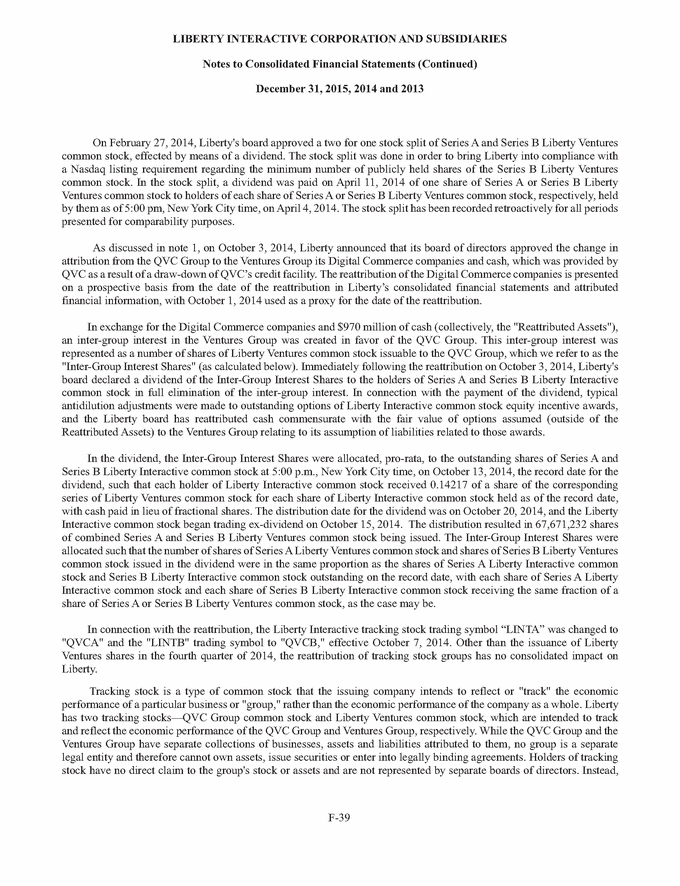
LIBERTY INTERACTIVE CORPORATION AND SUBSIDIARIES Notes to Consolidated Financial Statements (Continued) December 31, 2015, 2014 and 2013 holders of tracking stock are stockholders of the parent corporation, with a single board of directors and subject to all of the risks and liabilities of the parent corporation. The term "Ventures Group" does not represent a separate legal entity, rather it represents those businesses, assets and liabilities that have been attributed to that group. Following the reattribution, the Ventures Group is comprised primarily of our interests in Expedia, Inc., Interval Leisure Group, Inc., LendingTree, our Digital Commerce companies, investments in Time Warner Inc. and Time Warner Cable Inc., as well as cash in the amount of approximately $2,023 million (at December 31, 2015), including subsidiary cash. The Ventures Group also has attributed to it certain liabilities related to our Exchangeable Debentures and certain deferred tax liabilities. The Ventures Group is primarily focused on the maximization of the value of these investments and investing in new business opportunities. The term "QVC Group" does not represent a separate legal entity, rather it represents those businesses, assets and liabilities that have been attributed to that group. The QVC Group is primarily comprised of our merchandise-focused televised-shopping programs, Internet and mobile application businesses. Following the reattribution, the QVC Group has attributed to it the remainder of our businesses and assets, including our wholly-owned subsidiaries QVC and zulily (as of October 1, 2015) and our 38% interest in HSN, Inc. as well as cash in the amount of approximately $426 million (at December 31, 2015), including subsidiary cash. In May 2015, Liberty announced its entry into an agreement with Liberty Broadband Corporation ("Liberty Broadband"), a separate publicly traded company, whereby Liberty will invest up to $2.4 billion in Liberty Broadband in connection with (and contingent upon) the closing of the proposed merger of Charter Communications, Inc. ("Charter") and Time Warner Cable Inc. ("TWC"). The proceeds of this investment will be used by Liberty Broadband to fund, in part, its agreement to acquire $4.3 billion of Charter stock. Liberty Broadband's acquisition will be made in support of (and contingent upon) the closing of the Charter-TWC merger. In connection with these transactions, it is expected that Charter will undergo a corporate reorganization, resulting in New Charter, a current subsidiary of Charter, becoming the publicly traded parent company. Liberty's investment in Liberty Broadband will be funded using cash and short term investments and will be attributed to the Ventures Group. Liberty, along with third party investors, all of whom will invest on the same terms as Liberty, have agreed to purchase newly issued shares of Liberty Broadband Series C common stock (the "Series C Shares") at a per share price of $56.23, which was determined based upon the fair value of Liberty Broadband's net assets on a sum-of-the parts basis at the time the investment agreements were executed. In the aggregate, Liberty Broadband has entered into investment agreements with respect to $4.4 billion of its Series C Shares. Liberty's investment in Liberty Broadband is subject to customary closing conditions and funding will only occur upon the completion of the Charter-TWC merger. Liberty Broadband has received stockholder approval for the issuance of the Series C Shares in accordance with the rules and requirements of the Nasdaq Stock Market. Further, Liberty Broadband has the right, and may determine, to incur debt financing (subject to certain conditions) to fund a portion of the purchase price for its investment in New Charter, in which case Liberty Broadband may reduce the aggregate subscription for Series C Shares by up to 25%, with such reduction applied pro rata to all investors, including Liberty. Liberty and Liberty Broadband have also entered into an agreement with Charter which provides that Liberty and Liberty Broadband will exchange, in a tax-free transaction, the shares of TWC common stock held by each company for shares of New Charter Class A common stock (subject to certain limitations). In addition, Liberty has also agreed to grant Liberty Broadband a proxy over the shares of New Charter stock it receives in the exchange, along with a right of first refusal with respect to the underlying New Charter stock. As the outcome of the transaction with Liberty Broadband and the Charter-TWC merger are uncertain due to pending regulatory approvals, Liberty has not reflected any financial impacts in the consolidated financial statements related to the respective agreements as of December 31, 2015. F-40
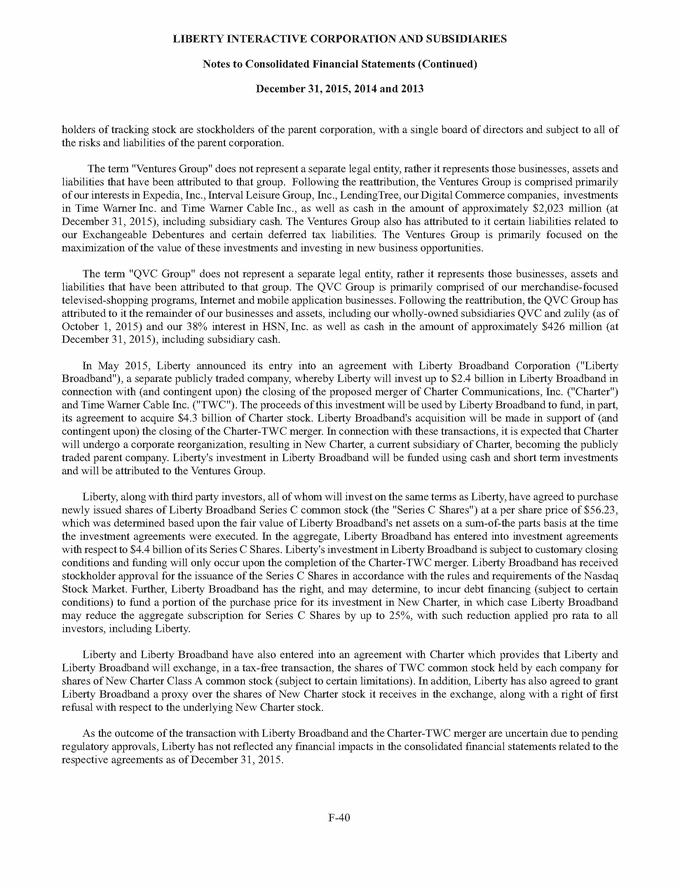
LIBERTY INTERACTIVE CORPORATION AND SUBSIDIARIES Notes to Consolidated Financial Statements (Continued) December 31, 2015, 2014 and 2013 See Exhibit 99.1 to this Annual Report on Form 10-K for unaudited attributed financial information for Liberty's tracking stock groups. (3) Summary of Significant Accounting Policies Cash and Cash Equivalents Cash equivalents consist of investments which are readily convertible into cash and have maturities of three months or less at the time of acquisition. Receivables Receivables are reflected net of an allowance for doubtful accounts and sales returns. A provision for bad debts is provided as a percentage of accounts receivable based on historical experience and included in selling, general and administrative expense. A provision for vendor receivables are determined based on an estimate of probable expected losses and included in cost of goods sold. A summary of activity in the allowance for doubtful accounts is as follows: Balance beginning of year Additions Balance end of year Charged to expense Other Deductions-write-offs amounts in millions 2015 2014 2013 $ $ $ 92 86 76 84 95 81 (1) (2) 1 (88) (87) (72) 87 92 86 Inventory Inventory, consisting primarily of products held for sale, is stated at the lower of cost or market. Cost is determined by the average cost method, which approximates the first-in, first-out method. Assessments about the realizability of inventory require the Company to make judgments based on currently available information about the likely method of disposition including sales to individual customers, returns to product vendors, liquidations and the estimated recoverable values of each disposition category. Inventory is stated net of inventory obsolescence reserves of $87 million and $86 million for the years ended December 31, 2015 and 2014, respectively. In July 2015, the Financial Accounting Standards Board (“FASB”) issued new accounting guidance that changes the measurement principle for inventory from the lower of cost or market to lower of cost and net realizable value. The new principle is part of the FASB’s simplification initiative and applies to entities that measure inventory using a method other than last-in, first-out (LIFO) or the retail inventory method. The new standard is effective for the Company for fiscal years and interim periods beginning after December 15, 2016. The Company has determined there is no significant effect of the standard on its ongoing financial reporting. Investments All marketable equity and debt securities held by the Company are classified as available-for-sale ("AFS") and are carried at fair value generally based on quoted market prices. U.S. generally accepted accounting principles ("GAAP") permit entities to choose to measure many financial instruments, such as AFS securities, and certain other items at fair value and to recognize the changes in fair value of such instruments in the entity's statements of operations (the "fair value option"). Liberty had previously entered into economic hedges for certain of its non-strategic AFS securities (although such instruments were not accounted for as fair value hedges by the Company). Changes in the fair value of these economic hedges were reflected in Liberty's statements of operations as unrealized gains (losses). In order to better match the changes in fair value of the subject AFS securities and the changes in fair value of the corresponding economic hedges in the Company's financial statements, Liberty has elected the fair value option for those of its AFS securities which it considers to be non-strategic ("Fair Value Option Securities"). Accordingly, changes in the fair value of Fair Value Option Securities, F-41
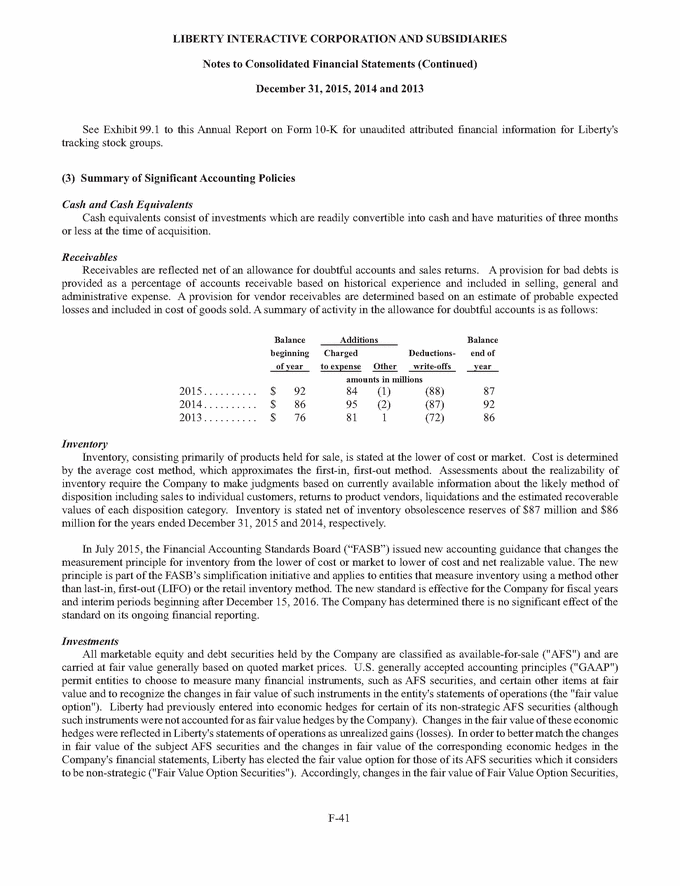
LIBERTY INTERACTIVE CORPORATION AND SUBSIDIARIES Notes to Consolidated Financial Statements (Continued) December 31, 2015, 2014 and 2013 as determined by quoted market prices, are reported in realized and unrealized gains (losses) on financial instruments in the accompanying consolidated statements of operations. The total value of AFS securities for which the Company has elected the fair value option aggregated $1,294 million and $1,220 million as of December 31, 2015 and 2014, respectively. Other investments in which the Company's ownership interest is less than 20%, unless the Company has the ability to exercise significant influence, and that are not considered marketable securities are carried at cost. For those investments in affiliates in which the Company has the ability to exercise significant influence, the equity method of accounting is used. Under this method, the investment, originally recorded at cost, is adjusted to recognize the Company's share of net earnings or losses of the affiliate as they occur rather than as dividends or other distributions are received. Losses are limited to the extent of the Company's investment in, advances to and commitments for the investee. In the event the Company is unable to obtain accurate financial information from an equity affiliate in a timely manner, the Company records its share of earnings or losses of such affiliate on a lag. Changes in the Company's proportionate share of the underlying equity of an equity method investee, which result from the issuance of additional equity securities by such equity investee, are recognized in the statements of operations through the gains (losses) on dilution of investments in affiliates line item. To the extent there is a difference between our ownership percentage in the underlying equity of an equity method investee and our carrying value, such difference is accounted for as if the equity method investee were a consolidated subsidiary. The Company continually reviews its equity investments and its AFS securities which are not Fair Value Option Securities to determine whether a decline in fair value below the carrying value is other than temporary. The primary factors the Company considers in its determination are the length of time that the fair value of the investment is below the Company's carrying value; the severity of the decline; and the financial condition, operating performance and near term prospects of the investee. In addition, the Company considers the reason for the decline in fair value, be it general market conditions, industry specific or investee specific; analysts' ratings and estimates of 12 month share price targets for the investee; changes in stock price or valuation subsequent to the balance sheet date; and the Company's intent and ability to hold the investment for a period of time sufficient to allow for a recovery in fair value. If the decline in fair value is deemed to be other than temporary, the carrying value of the security is written down to fair value. In situations where the fair value of an investment is not evident due to a lack of a public market price or other factors, the Company uses its best estimates and assumptions to arrive at the estimated fair value of such investment. The Company's assessment of the foregoing factors involves considerable management judgment and accordingly, actual results may differ materially from the Company's estimates and judgments. Writedowns for AFS securities which are not Fair Value Option Securities would be included in the consolidated statements of operations as other than temporary declines in fair values of investments. Writedowns for equity method investments would be included in share of earnings (losses) of affiliates. Derivative Instruments and Hedging Activities All of the Company's derivatives, whether designated in hedging relationships or not, are recorded on the balance sheet at fair value. If the derivative is designated as a fair value hedge, the changes in the fair value of the derivative and of the hedged item attributable to the hedged risk are recognized in earnings. If the derivative is designated as a cash flow hedge, the effective portions of changes in the fair value of the derivative are recorded in other comprehensive earnings and are recognized in the statements of operations when the hedged item affects earnings. Ineffective portions of changes in the fair value of cash flow hedges are recognized in earnings. If the derivative is not designated as a hedge, changes in the fair value of the derivative are recognized in earnings. The Company generally enters into derivative contracts that it intends to designate as a hedge of a forecasted transaction or the variability of cash flows to be received or paid related to a recognized asset or liability (cash flow hedge). For all hedging relationships, the Company formally documents the hedging relationship and its risk management objective and strategy for undertaking the hedge, the hedging instrument, the hedged item, the nature of the risk being hedged, how the hedging instrument's effectiveness in offsetting the hedged risk will be assessed prospectively and retrospectively, and F-42
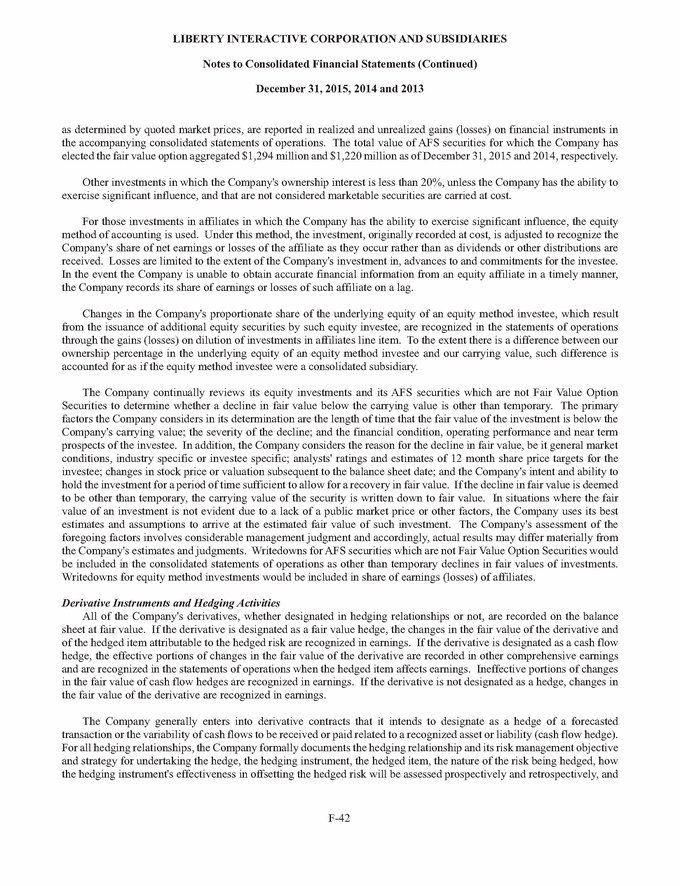
LIBERTY INTERACTIVE CORPORATION AND SUBSIDIARIES Notes to Consolidated Financial Statements (Continued) December 31, 2015, 2014 and 2013 a description of the method of measuring ineffectiveness. The Company also formally assesses, both at the hedge's inception and on an ongoing basis, whether the derivatives that are used in hedging transactions are highly effective in offsetting cash flows of hedged items. Changes in the fair value of a derivative that is highly effective and that is designated and qualifies as a cash flow hedge are recorded in accumulated other comprehensive income to the extent that the derivative is effective as a hedge, until earnings are affected by the variability in cash flows of the designated hedged item. The ineffective portion of the change in fair value of a derivative instrument that qualifies as a cash flow hedge is reported in earnings. During the year ended December 31, 2015, QVC entered into a hedge of a net investment in a foreign subsidiary. The purpose of the investment is to protect QVC's investment in the foreign subsidiary against the variability of the U.S. dollar and Euro exchange rate. Property and Equipment Property and equipment consisted of the following: December 31,December 31, 2015 2014 amounts in millions 197 947 909 Land Buildings and improvements Support equipment Projects in progress Total property and equipment $ 205 935 847 43 71 $ 2,124 2,030 Property and equipment, including significant improvements, is stated at cost. Depreciation is computed using the straight-line method using estimated useful lives of 2 to 15 years for support equipment and 8 to 20 years for buildings and improvements. Depreciation expense for the years ended December 31, 2015, 2014 and 2013 was $153 million, $158 million and $147 million, respectively. Intangible Assets Intangible assets with estimable useful lives are amortized over their respective estimated useful lives to their estimated residual values, and reviewed for impairment upon certain triggering events. Goodwill and other intangible assets with indefinite useful lives (collectively, "indefinite lived intangible assets") are not amortized, but instead are tested for impairment at least annually. Our annual impairment assessment of our indefinite-lived intangible assets is performed during the fourth quarter of each year. The Company utilizes a qualitative assessment for determining whether step one of the goodwill impairment analysis is necessary. The accounting guidance permits entities to first assess qualitative factors to determine whether it is more likely than not that the fair value of a reporting unit is less than its carrying amount as a basis for determining whether it is necessary to perform the two-step goodwill impairment test. In evaluating goodwill on a qualitative basis the Company reviews the business performance of each reporting unit and evaluates other relevant factors as identified in the relevant accounting guidance to determine whether it was more likely than not that an indicated impairment exists for any of our reporting units. The Company considers whether there are any negative macroeconomic conditions, industry specific conditions, market changes, increased competition, increased costs in doing business, management challenges, the legal environments and how these factors might impact company specific performance in future periods. As part of the analysis the Company also considers fair value determinations for certain reporting units that have been made at various points throughout the current year and prior year for other purposes. F-43
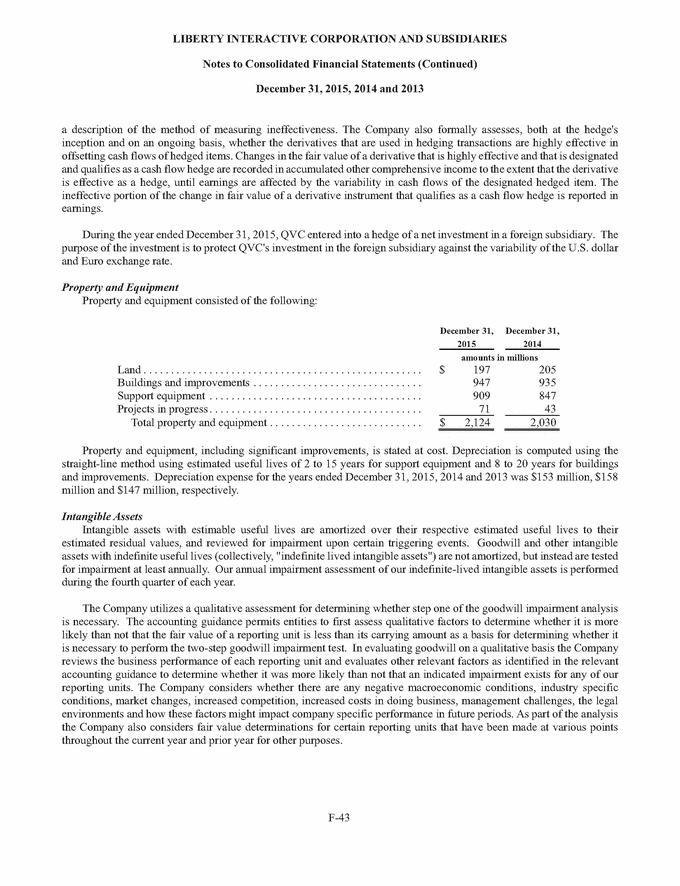
LIBERTY INTERACTIVE CORPORATION AND SUBSIDIARIES Notes to Consolidated Financial Statements (Continued) December 31, 2015, 2014 and 2013 If a step one test is considered necessary based on the qualitative factors, the Company compares the estimated fair value of a reporting unit to its carrying value. Developing estimates of fair value requires significant judgments, including making assumptions about appropriate discount rates, perpetual growth rates, relevant comparable market multiples, public trading prices and the amount and timing of expected future cash flows. The cash flows employed in Liberty's valuation analyses are based on management's best estimates considering current marketplace factors and risks as well as assumptions of growth rates in future years. There is no assurance that actual results in the future will approximate these forecasts. For those reporting units whose carrying value exceeds the fair value, a second test is required to measure the impairment loss (the "Step 2 Test"). In the Step 2 Test, the fair value (Level 3) of the reporting unit is allocated to all of the identifiable assets and liabilities of the reporting unit with any residual value being allocated to goodwill. Any excess of the carrying value of the goodwill over this allocated amount is recorded as an impairment charge. The accounting guidance also permits entities to first perform a qualitative assessment to determine whether it is more likely than not that an indefinite-lived intangible asset is impaired. If the qualitative assessment supports that it is more likely than not that the carrying value of the Company’s indefinite-lived intangible assets, other than goodwill, exceeds its fair value, then a quantitative assessment is performed. If the carrying value of an indefinite-lived intangible asset exceeds its fair value, an impairment loss is recognized in an amount equal to that excess. Impairment of Long-lived Assets The Company periodically reviews the carrying amounts of its property and equipment and its intangible assets (other than goodwill and indefinite-lived intangibles) to determine whether current events or circumstances indicate that such carrying amounts may not be recoverable. If the carrying amount of the asset group is greater than the expected undiscounted cash flows to be generated by such asset group, including its ultimate disposition, an impairment adjustment is to be recognized. Such adjustment is measured by the amount that the carrying value of such asset groups exceeds their fair value. The Company generally measures fair value by considering sale prices for similar asset groups or by discounting estimated future cash flows using an appropriate discount rate. Considerable management judgment is necessary to estimate the fair value of asset groups. Accordingly, actual results could vary significantly from such estimates. Asset groups to be disposed of are carried at the lower of their financial statement carrying amount or fair value less costs to sell. Noncontrolling Interests The Company reports noncontrolling interests of subsidiaries within equity in the balance sheet and the amount of consolidated net income attributable to the parent and to the noncontrolling interest is presented in the statements of operations. Also, changes in ownership interests in subsidiaries in which the Company maintains a controlling interest are recorded in equity. Foreign Currency Translation The functional currency of the Company is the United States (''U.S.'') dollar. The functional currency of the Company's foreign operations generally is the applicable local currency for each foreign subsidiary. Assets and liabilities of foreign subsidiaries are translated at the spot rate in effect at the applicable reporting date, and the consolidated statements of operations are translated at the average exchange rates in effect during the applicable period. The resulting unrealized cumulative translation adjustment, net of applicable income taxes, is recorded as a component of accumulated other comprehensive earnings in stockholders' equity. Transactions denominated in currencies other than the functional currency are recorded based on exchange rates at the time such transactions arise. Subsequent changes in exchange rates result in transaction gains and losses which are reflected in the accompanying consolidated statements of operations and comprehensive earnings (loss) as unrealized (based on the applicable period-end exchange rate) or realized upon settlement of the transactions. Revenue Recognition Retail revenue is recognized at the time of delivery to customers. The revenue for shipments in-transit is recorded as deferred revenue and included in other current liabilities. Additionally, service revenue, which is less than one percent of F-44
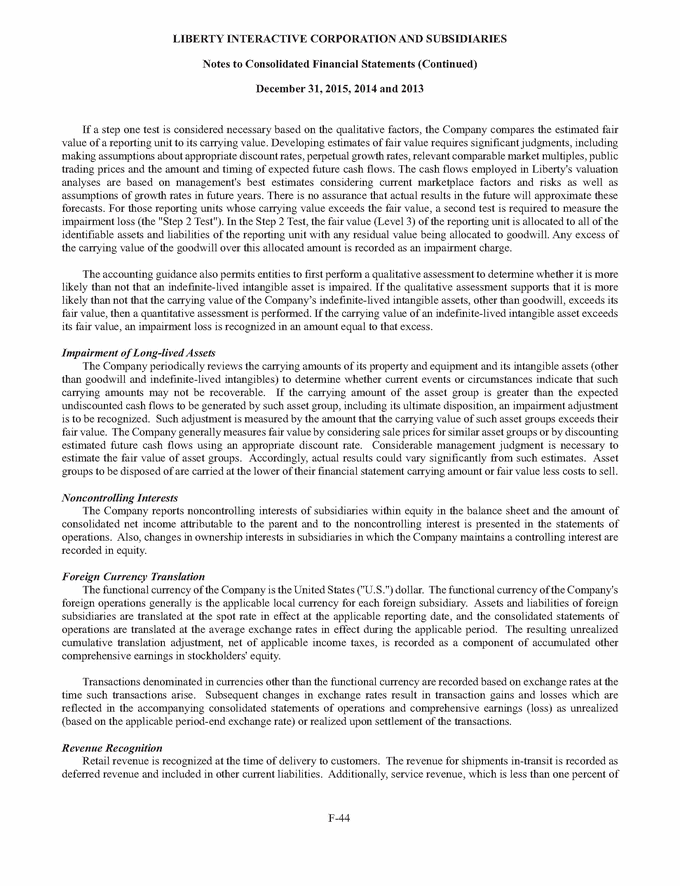
LIBERTY INTERACTIVE CORPORATION AND SUBSIDIARIES Notes to Consolidated Financial Statements (Continued) December 31, 2015, 2014 and 2013 overall revenue, is recognized when the applicable criteria are met: persuasive evidence of an arrangement exists, services have been rendered, the price is fixed and determinable and collectability is reasonably assured. An allowance for returned merchandise is provided as a percentage of sales based on historical experience. The total reduction in sales due to returns for the years ended December 31, 2015, 2014 and 2013 aggregated $2,037 million, $2,123 million and $2,134 million, respectively. Sales tax collected from customers on retail sales is recorded on a net basis and is not included in revenue. In May 2014, the FASB issued new accounting guidance on revenue from contracts with customers. The new guidance requires an entity to recognize the amount of revenue to which it expects to be entitled for the transfer of promised goods or services to customers. The updated guidance will replace most existing revenue recognition guidance in GAAP when it becomes effective and permits the use of either a retrospective or cumulative effect transition method. This guidance is effective for fiscal years, and interim periods within those fiscal years, beginning after December 15, 2017, with early application permitted. The Company has not yet selected a transition method nor has it determined the effect of the standard on its ongoing financial reporting. Cost of Sales Cost of sales primarily includes actual product cost, provision for obsolete inventory, buying allowances received from suppliers, shipping and handling costs and warehouse costs. Advertising Costs Advertising costs generally are expensed as incurred. Advertising expense aggregated $154 million, $271 million and $258 million for the years ended December 31, 2015, 2014 and 2013, respectively. Advertising costs are reflected in the selling, general and administrative expense line item in our consolidated statements of operations. Stock-Based Compensation As more fully described in note 15, the Company has granted to its directors, employees and employees of its subsidiaries options, restricted stock and stock appreciation rights ("SARs") to purchase shares of Liberty Interactive and/or Liberty Ventures common stock ("Liberty common stock") (collectively, "Awards"). The Company measures the cost of employee services received in exchange for an Award of equity instruments (such as stock options and restricted stock) based on the grant-date fair value of the Award, and recognizes that cost over the period during which the employee is required to provide service (usually the vesting period of the Award). The Company measures the cost of employee services received in exchange for an Award of liability instruments (such as stock appreciation rights that will be settled in cash) based on the current fair value of the Award, and remeasures the fair value of the Award at each reporting date. Stock compensation expense was $127 million, $108 million and $118 million for the years ended December 31, 2015, 2014 and 2013, respectively, included in selling, general and administrative expense in the accompanying consolidated statements of operations. Income Taxes The Company accounts for income taxes using the asset and liability method. Deferred tax assets and liabilities are recognized for the future tax consequences attributable to differences between the financial statement carrying value amounts and income tax bases of assets and liabilities and the expected benefits of utilizing net operating loss and tax credit carryforwards. The deferred tax assets and liabilities are calculated using enacted tax rates in effect for each taxing jurisdiction in which the Company operates for the year in which those temporary differences are expected to be recovered or settled. Net deferred tax assets are then reduced by a valuation allowance if the Company believes it more likely than not such net deferred tax assets will not be realized. The effect on deferred tax assets and liabilities of an enacted change in tax rates is recognized in income in the period that includes the enactment date. F-45
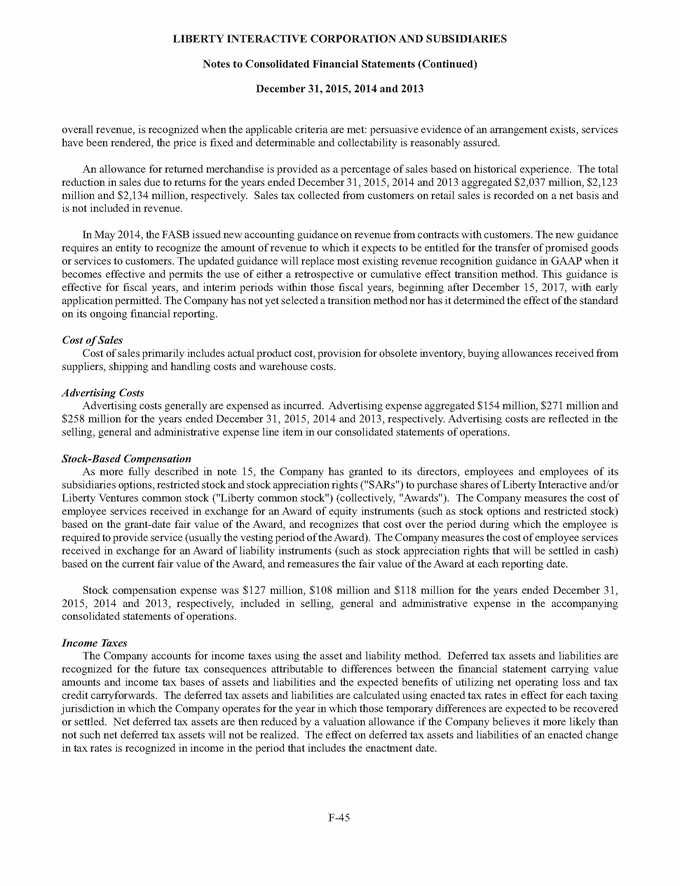
LIBERTY INTERACTIVE CORPORATION AND SUBSIDIARIES Notes to Consolidated Financial Statements (Continued) December 31, 2015, 2014 and 2013 When the tax law requires interest to be paid on an underpayment of income taxes, the Company recognizes interest expense from the first period the interest would begin accruing according to the relevant tax law. Such interest expense is included in interest expense in the accompanying consolidated statements of operations. Any accrual of penalties related to underpayment of income taxes on uncertain tax positions is included in other income (expense) in the accompanying consolidated statements of operations. In November 2015, the FASB issued new accounting guidance to simplify the presentation of deferred income taxes. The new guidance requires that deferred tax liabilities and assets be classified as noncurrent in a classified balance sheet and permits the use of either a retrospective or prospective transition method. This guidance is effective for fiscal years, and interim periods within those fiscal years, beginning after December 15, 2015, with early application permitted. The Company has early adopted this guidance. The retrospective application of this guidance decreased current “Deferred income tax liabilities” and increased noncurrent “Deferred income tax liabilities” by $972 million on the consolidated balance sheet as of December 31, 2014. Earnings (Loss) Attributable to Liberty Interactive Corporation Stockholders and Earnings (Loss) Per Common Share Net earnings (loss) attributable to Liberty stockholders is comprised of the following (amounts in millions): Years ended December 31, 2015 2014 2013 QVC Group Net earnings (loss) from continuing operations Net earnings (loss) from discontinued operations Liberty Ventures Net earnings (loss) from continuing operations Net earnings (loss) from discontinued operations $ $ 640 NA 535 (15) 455 (17) $ $ 229 NA 3 14 54 9 Basic earnings (loss) per common share ("EPS") is computed by dividing net earnings (loss) attributable to such common stock by the weighted average number of common shares outstanding for the period. Diluted EPS presents the dilutive effect on a per share basis of potential common shares as if they had been converted at the beginning of the periods presented. Series A and Series B QVC Group Common Stock EPS for all periods through December 31, 2015, is based on the following weighted average shares outstanding. Excluded from diluted EPS for the years ended December 31, 2015, 2014 and 2013 are approximately 6 million, 1 million and less than one million potential common shares, respectively, because their inclusion would be antidilutive. F-46
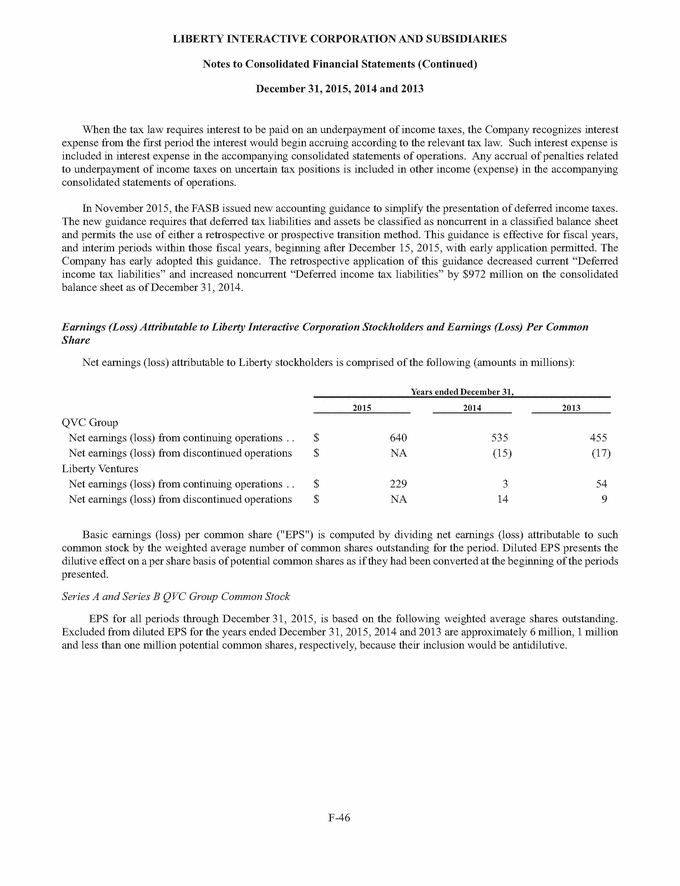
LIBERTY INTERACTIVE CORPORATION AND SUBSIDIARIES Notes to Consolidated Financial Statements (Continued) December 31, 2015, 2014 and 2013 Years ended December 31, 2015 2014 2013 number of shares in millions Basic WASO Potentially dilutive shares Diluted WASO 475 6 484 8 519 8 481 492 527 Series A and Series B Liberty Ventures Common Stock As discussed in note 2, Liberty completed a two for one stock split on April 11, 2014 on its Series A and Series B Liberty Ventures common stock. Therefore, all prior period outstanding share amounts have been retroactively adjusted for comparability. Additionally, as discussed in note 2, on October 3, 2014, Liberty attributed from the QVC Group to the Ventures Group its Digital Commerce companies. In exchange for the Reattributed Assets, Inter-Group Interest Shares in the Ventures Group were created in favor of the QVC Group. Immediately following the reattribution on October 3, 2014, Liberty's board declared a dividend of the Inter-Group Interest Shares to the holders of Series A and Series B Liberty Interactive common stock in full elimination of the inter-group interest. The Inter-Group Interest Shares were allocated, pro-rata, to the outstanding shares of Series A and Series B Liberty Interactive common stock at 5:00 p.m., New York City time, on October 13, 2014, the record date for the dividend, such that each holder of Liberty Interactive common stock received 0.14217 of a share of the corresponding series of Liberty Ventures common stock for each share of Liberty Interactive common stock held as of the record date, with cash paid in lieu of fractional shares. The distribution date for the dividend was on October 20, 2014, and the Liberty Interactive common stock began trading ex-dividend on October 15, 2014. The reattribution of the Digital Commerce companies is presented on a prospective basis from the date of the reattribution in Liberty’s consolidated financial statements, with October 1, 2014 used as a proxy for the date of the reattribution. EPS for all periods through December 31, 2015, is based on the following weighted average shares outstanding. Excluded from diluted EPS for the year ended December 31, 2015 are less than a million potential common shares because their inclusion would be antidilutive. Years ended December 31, 2015 2014 2013 number of shares in millions Basic WASO Potentially dilutive shares Diluted WASO 142 1 87 1 73 1 143 88 74 Reclasses and adjustments Certain prior period amounts have been reclassified for comparability with the current year presentation. Such reclassifications include $135 million and $130 million reclassifications from operating expense to selling, general and administrative, including stock based compensation on the consolidated statements of operations for the years ended December 31, 2014 and 2013, respectively, related to a change in classification of certain broadcasting expenses at QVC. In April 2015, the FASB issued new accounting guidance on the presentation of debt issuance costs, which requires debt issuance costs related to a recognized debt liability to be presented on the balance sheet as a direct deduction from the debt liability. The new guidance intends to simplify the presentation of debt issuance costs. In August 2015, the FASB issued new accounting guidance on the presentation or subsequent measurement of debt issuance costs related to line of F-47
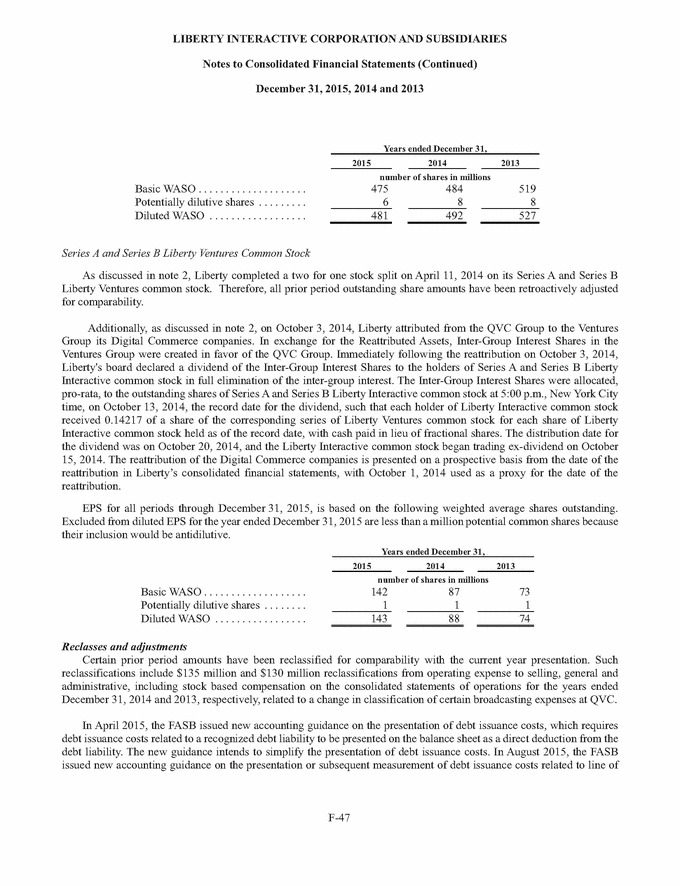
LIBERTY INTERACTIVE CORPORATION AND SUBSIDIARIES Notes to Consolidated Financial Statements (Continued) December 31, 2015, 2014 and 2013 credit arrangements, which provides that such cost may be presented as an asset and amortized ratably over the term of the line of credit arrangement, regardless of whether there are outstanding borrowings on the arrangement. The amendments in these new accounting standards are effective for financial statements issued for fiscal years beginning after December 15, 2015, and interim periods within those years. Early adoption is permitted for financial statements that have not been previously issued and retrospective application is required for each balance sheet presented. Liberty early adopted this guidance in the fourth quarter of 2015. The retrospective application of this guidance decreased “Other assets” and “Long-term debt” by $43 million in the accompanying consolidated balance sheet as of December 31, 2014. Refer to “Note 11 – Debt” below for the current year presentation. Estimates The preparation of financial statements in conformity with GAAP requires management to make estimates and assumptions that affect the reported amounts of assets and liabilities at the date of the financial statements and the reported amounts of revenue and expenses during the reporting period. Actual results could differ from those estimates. Liberty considers (i) recurring and non-recurring fair value measurements, (ii) accounting for income taxes, (iii) assessments of other-than-temporary declines in fair value of its investments and (iv) estimates of retail-related adjustments and allowances to be its most significant estimates. Liberty holds investments that are accounted for using the equity method. Liberty does not control the decision making process or business management practices of these affiliates. Accordingly, Liberty relies on management of these affiliates to provide it with accurate financial information prepared in accordance with GAAP that Liberty uses in the application of the equity method. In addition, Liberty relies on audit reports that are provided by the affiliates' independent auditors on the financial statements of such affiliates. The Company is not aware, however, of any errors in or possible misstatements of the financial information provided by its equity affiliates that would have a material effect on Liberty's consolidated financial statements. (4) Supplemental Disclosures to Consolidated Statements of Cash Flows Years ended December 31, 2015 2014 2013 amounts in millions Cash paid for acquisitions: Fair value of assets acquired Intangibles not subject to amortization Intangibles subject to amortization Net liabilities assumed Deferred tax assets (liabilities). Fair value of equity consideration Cash paid for acquisitions, net of cash acquired $ 154 1,791 837 (214) (637) (1,087) — — — — — — 7 12 2 (7) 10 — $ 844 — 24 Cash paid for interest. $ 374 362 362 Cash paid for income taxes (5) Acquisitions $ 318 44 410 On October 1, 2015, Liberty acquired zulily for consideration of approximately $2.3 billion, comprised of $9.375 of cash and 0.3098 newly issued shares of QVCA for each zulily share, with cash paid in lieu of any fractional shares. The fair value of the issued shares was determined based on the trading price of QVCA shares on the last trading day prior to the acquisition. Funding for the $1.2 billion cash portion of the consideration came from cash on hand at zulily and a F-48
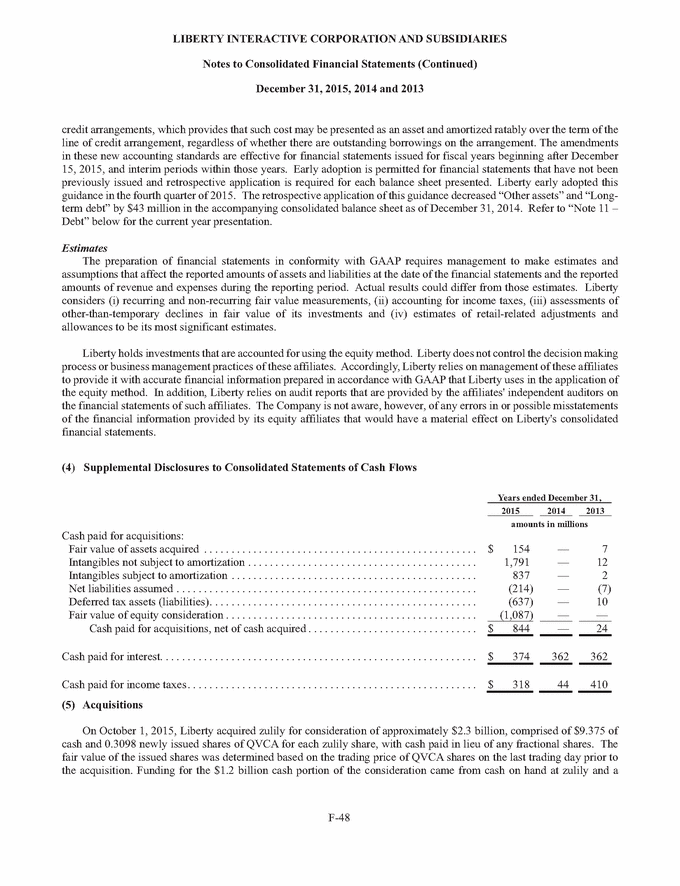
LIBERTY INTERACTIVE CORPORATION AND SUBSIDIARIES Notes to Consolidated Financial Statements (Continued) December 31, 2015, 2014 and 2013 distribution from QVC funded by a drawdown under its revolving credit facility (see note 11). zulily is attributed to the QVC Group and we believe that its business is complementary to QVC’s. The initial purchase price allocation for zulily is as follows (amounts in millions): Cash and cash equivalents Property and equipment Other assets Goodwill Trademarks Intangible assets subject to amortization Accounts payable & Accrued liabilities Other liabilities assumed Deferred tax liabilities $ 341 105 46 860 920 830 (145) (65) (640) $ 2,252 Intangible assets acquired during 2015 were comprised of customer relationships of $515 million with a weighted average life of approximately 4 years, email lists of $265 million with a weighted average life of approximately 2 years, and capitalized software of $50 million with a weighted average life of approximately 3 years. None of the acquired goodwill is expected to be deductible for tax purposes. As of December 31, 2015, the valuation related to the purchase is not final and the purchase price allocation is preliminary and subject to revision. The primary areas of the purchase price allocation that are not yet finalized are related to certain intangible assets, liabilities and tax balances. Included in net earnings (loss) from continuing operations for the year ended December 31, 2015 is $34 million related to zulily’s operations since the date of acquisition. The Pro Forma revenue and net earnings from continuing operations of Liberty, prepared utilizing the historical financial statements of zulily, giving effect to purchase accounting related adjustments made at the time of acquisition, as if the transaction discussed above occurred on January 1, 2014, are as follows: Years Ended December 31, 2015 2014 amounts in millions (unaudited) Revenue Net earnings (loss) from continuing operations $ 10,907 750 11,700 419 The Pro Forma information is not representative of Liberty’s future financial position, future results of operations or future cash flows nor does it reflect what Liberty’s financial position, results of operations or cash flows would have been as if the transaction had happened previously and Liberty controlled zulily during the periods presented. (6) Disposals On August 27, 2014, Liberty completed the TripAdvisor Holdings Spin-Off to holders of its Liberty Ventures common stock shares of its former wholly-owned subsidiary, TripAdvisor Holdings. TripAdvisor Holdings is comprised of Liberty’s former 22% economic and 57% voting interest in TripAdvisor, as well as BuySeasons, Liberty’s former wholly-owned subsidiary, and a corporate level net debt balance of $350 million. In connection with the TripAdvisor Holdings Spin-Off during August 2014, TripAdvisor Holdings drew down $400 million in margin loans and distributed approximately $350 million to Liberty. Concurrently with the margin loans, Liberty and TripAdvisor Holdings entered into a promissory note F-49
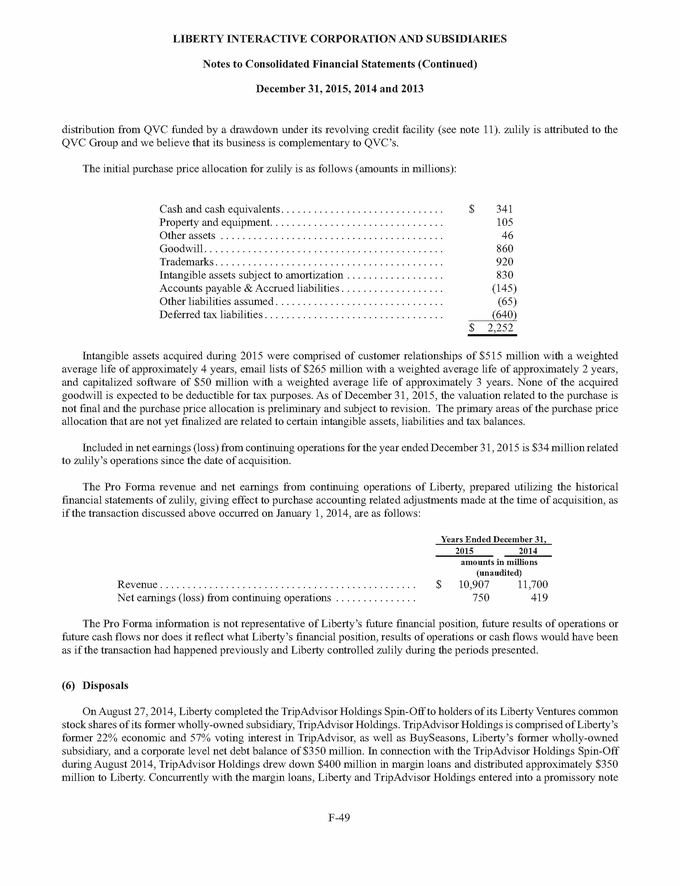
LIBERTY INTERACTIVE CORPORATION AND SUBSIDIARIES Notes to Consolidated Financial Statements (Continued) December 31, 2015, 2014 and 2013 whereby TripAdvisor Holdings may request, if the closing price per share of TripAdvisor common stock were to fall below certain minimum values, up to $200 million in funds from Liberty. The TripAdvisor Holdings Spin-Off has been recorded at historical cost due to the pro rata nature of the distribution. Following the completion of the TripAdvisor Holdings Spin-Off, Liberty and TripAdvisor Holdings operate as separate, publicly traded companies, and neither has any stock ownership, beneficial or otherwise, in the other. The consolidated financial statements of Liberty have been prepared to reflect TripAdvisor Holdings as discontinued operations. Accordingly, the assets and liabilities, revenue, costs and expenses, and cash flows of the businesses, assets and liabilities owned by TripAdvisor Holdings at the time of the TripAdvisor Holdings Spin-Off have been excluded from the respective captions in the accompanying consolidated balance sheets, statements of operations, comprehensive earnings and cash flows in such consolidated financial statements. In connection with the TripAdvisor Holdings Spin-off, Liberty and TripAdvisor Holdings entered into a tax sharing agreement (the “Tax Sharing Agreement”). The Tax Sharing Agreement provides for the allocation and indemnification of tax liabilities and benefits between Liberty and TripAdvisor Holdings and other agreements related to tax matters. Among other things, pursuant to the Tax Sharing Agreement, TripAdvisor Holdings has agreed to indemnify Liberty, subject to certain limited exceptions, for losses and taxes resulting from the TripAdvisor Holdings Spin-Off to the extent such losses or taxes result primarily from, individually or in the aggregate, the breach of certain restrictive covenants made by TripAdvisor Holdings (applicable to actions or failures to act by TripAdvisor Holdings and its subsidiaries following the completion of the TripAdvisor Holdings Spin-Off). In October 2014, the IRS completed its examination of the TripAdvisor Holdings Spin-Off and notified Liberty that it agreed with the nontaxable characterization of the transaction. Liberty executed a Closing Agreement with the IRS documenting this conclusion during 2015. Certain combined financial information for TripAdvisor Holdings, which is included in earnings (loss) from discontinued operations, is as follows (amounts in millions, except per share amounts): Years ended December 31, 2014 2013 Revenue Earnings (loss) before income taxes Income tax (expense) benefit Earnings (loss) attributable to Liberty Interactive Corporation shareholders $ $ $ $ 883 68 (20) (1) 1,033 (27) 53 (8) Earnings per share impact of discontinued operations The combined impact from discontinued operations, discussed above, is as follows: Years ended December 31, 2014 2013 Basic earnings (loss) from discontinued operations attributable to Liberty shareholders per common share (note 3): Series A and Series B QVC Group common stock Series A and Series B Liberty Ventures common stock Diluted earnings (loss) from discontinued operations attributable to Liberty shareholders per common share (note 3): Series A and Series B QVC Group common stock Series A and Series B Liberty Ventures common stock $ $ (0.03) 0.16 (0.03) 0.12 $ $ (0.03) 0.16 (0.03) 0.12 F-50
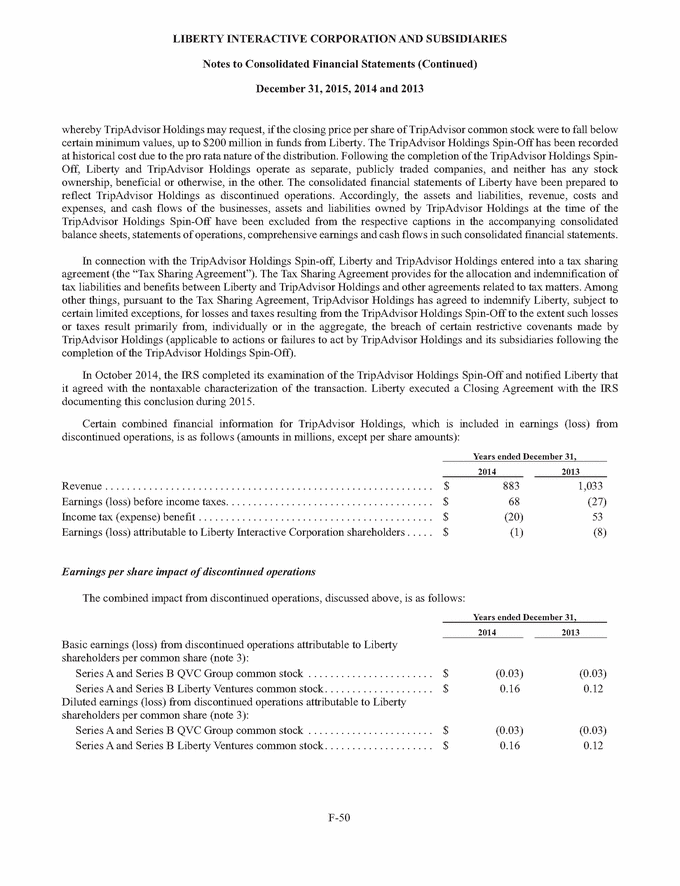
LIBERTY INTERACTIVE CORPORATION AND SUBSIDIARIES Notes to Consolidated Financial Statements (Continued) December 31, 2015, 2014 and 2013 The assets and liabilities included in the TripAdvisor Holdings Spin-Off, and their resulting impacts on the attributed consolidated statements of operations, were included in discontinued operations based on which group owned the assets at the time of the TripAdvisor Holdings Spin-Off. Provide was included in the Corporate and other segment prior to the sale of Provide to FTD on December 31, 2014 in exchange for cash and shares of FTD common stock representing approximately 35% of the combined company (see note 9 for additional information related to this transaction). Subsequent to this transaction, the Company’s interest in FTD, accounted for under the equity method, is included in Corporate and other. Given Liberty’s significant continuing involvement with FTD, Provide is not presented as a discontinued operation in the Company’s consolidated financial statements. On June 30, 2015, Liberty sold Backcountry for aggregate consideration, including assumption of debt, amounts held in escrow, and a noncontrolling interest, of approximately $350 million. The sale resulted in a $105 million gain, which is included in “Gains (losses) on transactions, net” in the accompanying consolidated statements of operations. Backcountry is not presented as a discontinued operation as the sale did not represent a strategic shift that has a major effect on Liberty’s operations and financial results. Included in revenue in the accompanying consolidated statements of operations is $227 million, $471 million and $433 million for the years ended December 31, 2015, 2014 and 2013, respectively, related to Backcountry. Included in net earnings (loss) in the accompanying consolidated statements of operations are losses of $3 million, earnings of $1 million and losses of $3 million for the years ended December 31, 2015, 2014 and 2013, respectively, related to Backcountry. Included in total assets in the accompanying consolidated balance sheets as of December 31, 2014 is $323 million related to Backcountry. (7) Assets and Liabilities Measured at Fair Value For assets and liabilities required to be reported at fair value, GAAP provides a hierarchy that prioritizes inputs to valuation techniques used to measure fair value into three broad levels. Level 1 inputs are quoted market prices in active markets for identical assets or liabilities that the reporting entity has the ability to access at the measurement date. Level 2 inputs, other than quoted market prices included within Level 1, are observable for the asset or liability, either directly or indirectly. Level 3 inputs are unobservable inputs for the asset or liability. The Company does not have any recurring assets or liabilities measured at fair value that would be considered Level 3. The Company's assets and liabilities measured at fair value are as follows: December 31, 2015 December 31, 2014 Quoted prices in active markets for identical assets (Level 1) Quoted prices in active markets for identical assets (Level 1) Significant other observable inputs (Level 2) Significant other observable inputs (Level 2) Description Total Total amounts in millions Cash equivalents Short term marketable securities Available-for-sale securities Debt $ $ $ $ 2,225 910 1,294 2,480 2,225 331 1,287 — — 579 7 2,480 2,147 889 1,220 2,574 2,147 277 1,203 — — 612 17 2,574 The majority of the Company's Level 2 financial assets and liabilities are debt instruments with quoted market prices that are not considered to be traded on "active markets," as defined in GAAP. Accordingly, the debt instruments are reported in the foregoing table as Level 2 fair value. F-51
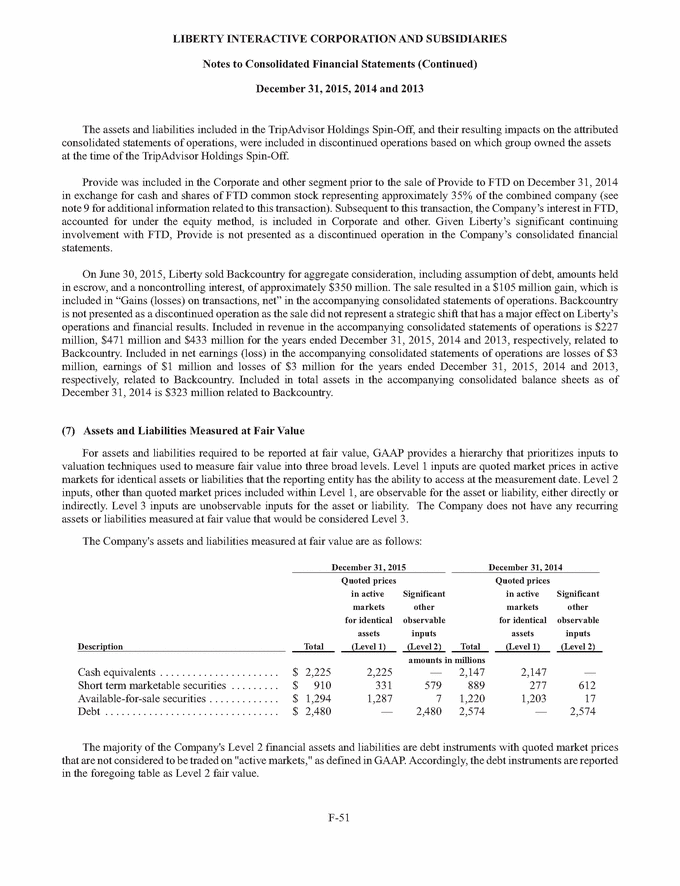
LIBERTY INTERACTIVE CORPORATION AND SUBSIDIARIES Notes to Consolidated Financial Statements (Continued) December 31, 2015, 2014 and 2013 Realized and Unrealized Gains (Losses) on Financial Instruments Realized and unrealized gains (losses) on financial instruments are comprised of changes in the fair value of the following: Years ended December 31, 2015 2014 2013 amounts in millions Fair Value Option Securities Exchangeable senior debentures Other financial instruments $ 84 30 — 173 (230) — 514 (553) 17 $ 114 (57) (22) (8) Investments in Available-for-Sale Securities and Other Cost Investments All marketable equity and debt securities held by the Company are classified as available-for-sale ("AFS") and are carried at fair value generally based on quoted market prices. GAAP permits entities to choose to measure many financial instruments, such as AFS securities, and certain other items at fair value and to recognize the changes in fair value of such instruments in the entity's statements of operations (the "fair value option"). Liberty has elected the fair value option for those of its AFS securities which it considers to be non-strategic ("Fair Value Option Securities"). Accordingly, changes in the fair value of Fair Value Option Securities, as determined by quoted market prices, are reported in realized and unrealized gains (losses) on financial instruments in the accompanying consolidated statements of operations. Investments in AFS securities, the majority of which are considered Fair Value Option Securities and other cost investments, are summarized as follows: December 31,December 31, 2015 2014 amounts in millions QVC Group Other cost investments Total attributed QVC Group Ventures Group Time Warner Inc. Time Warner Cable Inc. Other AFS investments. Total attributed Ventures Group Consolidated Liberty. $ 4 4 $ 4 4 $ 284 994 71 375 815 30 1,349 1,220 $ 1,353 1,224 F-52
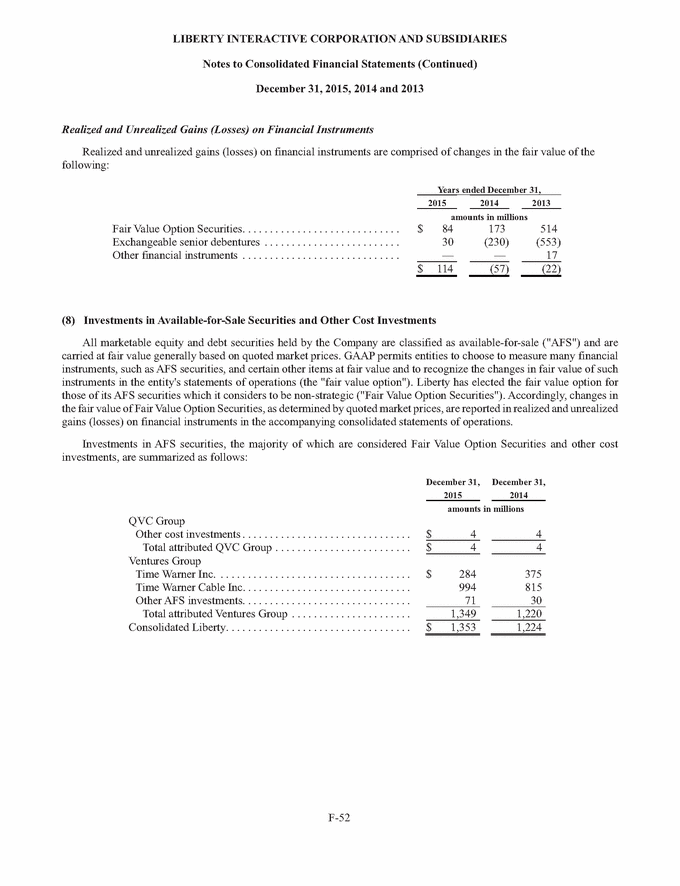
LIBERTY INTERACTIVE CORPORATION AND SUBSIDIARIES Notes to Consolidated Financial Statements (Continued) December 31, 2015, 2014 and 2013 (9) Investments in Affiliates Accounted for Using the Equity Method Liberty has various investments accounted for using the equity method. The following table includes Liberty's carrying amount and percentage ownership of the more significant investments in affiliates at December 31, 2015 and the carrying amount at December 31, 2014: December 31, 2015 December 31, 2014 Percentage ownership Market value Carrying amount Carrying amount dollars in millions QVC Group HSN, Inc. (2) Other Total QVC Group Ventures Group Expedia (1)(2) FTD (3) Other (4) Total Ventures Group Consolidated Liberty 38 % $ 1,014 $ 165 43 328 47 various N/A 208 375 16 % $ 2,934 927 267 239 514 355 389 37 % $ various 267 N/A 1,433 1,258 $ 1,641 1,633 The following table presents Liberty's share of earnings (losses) of affiliates: Years ended December 31, 2015 2014 2013 amounts in millions QVC Group HSN, Inc. Other Total QVC Group Ventures Group Expedia, Inc. (1) FTD, Inc. Other (4) Total Ventures Group Consolidated Liberty $ 64 (9) 60 (9) 61 (13) 55 51 48 118 (83) (150) 58 — (70) 31 — (46) (115) (12) (15) $ (60) 39 33 (1) Liberty owns an approximate 16% equity interest and 52% voting interest in Expedia. Liberty has entered into governance arrangements pursuant to which Mr. Barry Diller, Chairman of the Board and Senior Executive Officer of Expedia, may vote its interests of Expedia, subject to certain limitations. Additionally, through our governance arrangements with Mr. Diller, we have the right to appoint and have appointed 20% of the members of Expedia's board of directors, which is currently comprised of 13 members. Therefore, we determined based on these arrangements that we have significant influence and have accounted for the investment as an equity method affiliate. The increase in our share of Expedia’s earnings during the year ended December 31, 2015 is primarily due to our share of a significant gain recognized by Expedia related to the sale of one of its subsidiaries. (2) During the years ended December 31, 2015, 2014 and 2013, Expedia, Inc. paid dividends aggregating $20 million, $15 million and $13 million, respectively, and HSN, Inc. (“HSNi”) paid dividends of $228 million, $22 million, and $16 million during the years ended December 31, 2015, 2014 and 2013, respectively, which were recorded as reductions to the investment balances. Dividends from HSNi during the year ended December 31, 2015 included a special dividend of $10 per share from which Liberty received approximately $200 million in cash. F-53
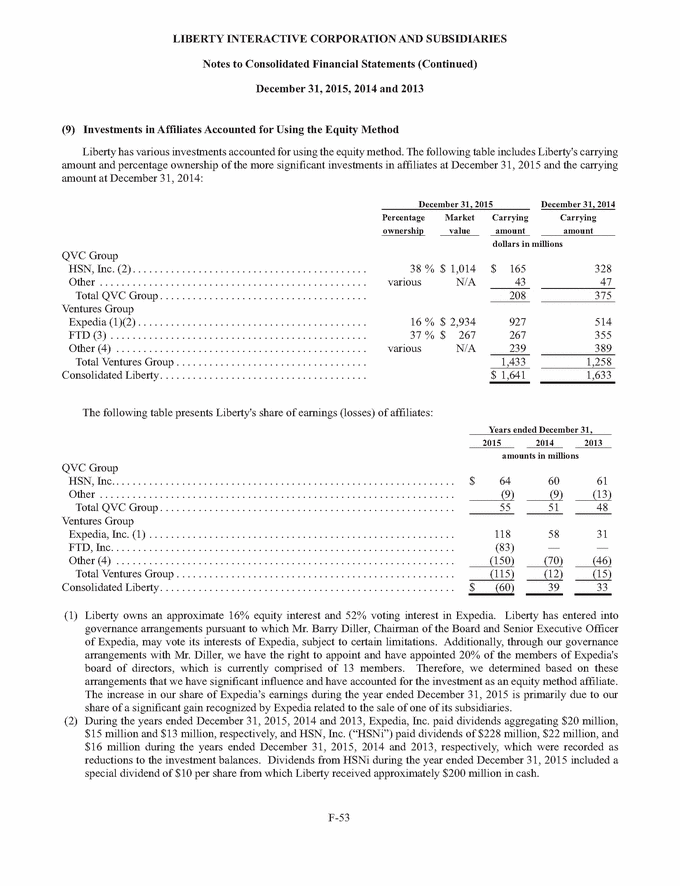
LIBERTY INTERACTIVE CORPORATION AND SUBSIDIARIES Notes to Consolidated Financial Statements (Continued) December 31, 2015, 2014 and 2013 (3) FTD acquired Liberty’s formerly wholly-owned subsidiary, Provide, on December 31, 2014. In exchange for Provide, Liberty received approximately 10.2 million shares of FTD common stock representing approximately 35% of the combined company and approximately $145 million in cash. Subsequent to completion of the transaction, Liberty accounts for FTD as an equity-method affiliate based on the ownership level and board representation. The carrying value of Liberty’s investment in FTD was impaired to the fair value (based on the closing price (level 1)) as of December 31, 2015. (4) The Other category for the Ventures Group is comprised of investments in LendingTree, Interval Leisure Group, alternative energy investments and other investments. The alternative energy investments generally operate at a loss but provide favorable tax attributes recorded through the income tax (expense) benefit line item in the consolidated statements of operations. During the year ended December 31, 2015, Liberty recorded an impairment of approximately $98 million, based on a discounted cash flow valuation (level 3), related to one of its alternative energy investments which has underperformed operationally. Liberty recognized gains on dilution of investments in affiliates of $314 million during the year ended December 31, 2015, losses of $2 million during the year ended December 31, 2014 and gains of $1 million during the year ended December 31, 2013. The significant dilution gain in 2015 is due to an acquisition by Expedia that was executed through the issuance of stock. This diluted Liberty’s ownership percentage at a price greater than our cost basis. Expedia, Inc. Summarized unaudited financial information for Expedia, Inc. is as follows: Expedia, Inc. Consolidated Balance Sheets December 31,December 31, 2015 2014 amounts in millions Current assets Property and equipment, net Goodwill Intangible assets Other assets Total assets Current liabilities Deferred income taxes Long-term debt Other liabilities Equity Total liabilities and equity $ 2,979 1,064 7,993 2,794 674 2,924 553 3,956 1,290 298 $ 15,504 9,021 $ 5,926 474 3,201 973 4,930 4,187 453 1,747 740 1,894 $ 15,504 9,021 F-54
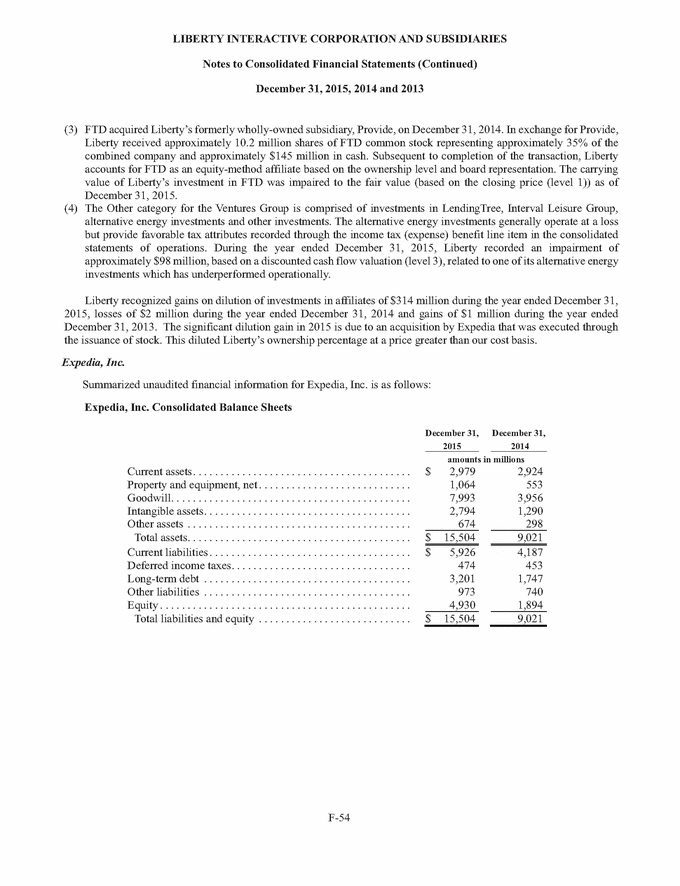
LIBERTY INTERACTIVE CORPORATION AND SUBSIDIARIES Notes to Consolidated Financial Statements (Continued) December 31, 2015, 2014 and 2013 Expedia, Inc. Consolidated Statements of Operations Years Ending December 31, 2015 2014 2013 amounts in millions Revenue Cost of revenue Gross profit Selling, general and administrative expenses Amortization Operating income Interest expense Gain on sale of business Other income (expense), net Income tax (expense) benefit Income (loss) from continuing operations Net loss attributable to noncontrolling interests Net earnings (loss) attributable to Expedia shareholders $ 6,672 (1,309) 5,763 (1,179) 4,771 (1,038) 5,363 (4,785) (164) 4,584 (3,986) (80) 3,733 (3,295) (72) 414 518 366 (126) 509 129 (203) (98) — 45 (92) (87) — 21 (84) 723 41 373 25 216 17 $ 764 398 233 (10) Goodwill and Other Intangible Assets Goodwill Changes in the carrying amount of goodwill are as follows: Corporate and Other QVC zulily Total amounts in millions Balance at January 1, 2014 Impairments Sale of subsidiary Foreign currency translation adjustments Other Balance at December 31, 2014 Acquisitions Sale of subsidiary Foreign currency translation adjustments Balance at December 31, 2015 $ 5,312 — — (106) — — — — — — 560 (7) (352) — (3) 5,872 (7) (352) (106) (3) $ 5,206 — 198 5,404 — — (57) 860 — — 10 (105) — 870 (105) (57) $ 5,149 860 103 6,112 Goodwill recognized from acquisitions primarily relates to assembled workforces, website community and other intangible assets that do not qualify for separate recognition. As presented in the accompanying consolidated balance sheets, trademarks is the other significant indefinite lived intangible asset. F-55
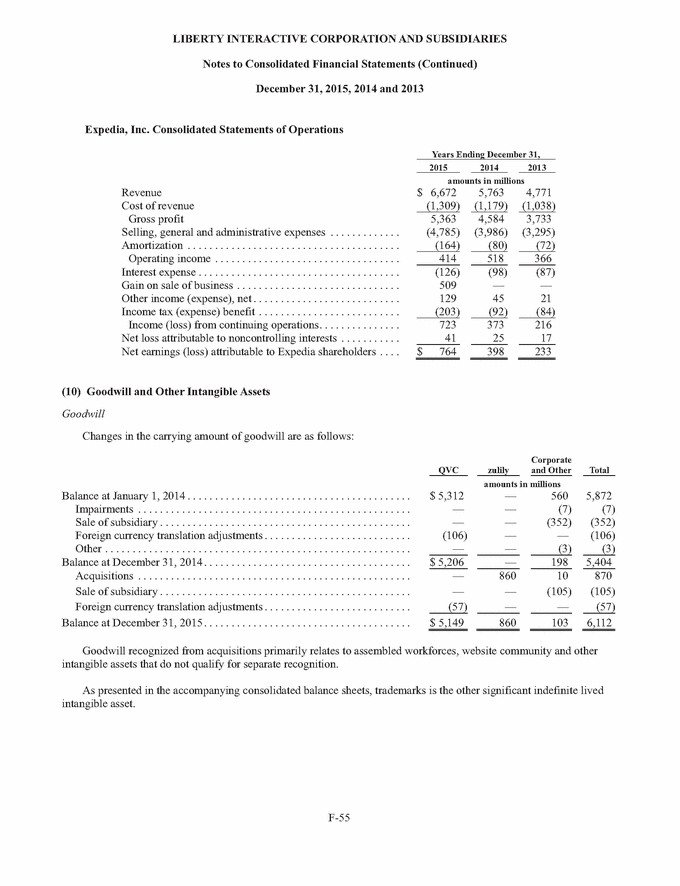
LIBERTY INTERACTIVE CORPORATION AND SUBSIDIARIES Notes to Consolidated Financial Statements (Continued) December 31, 2015, 2014 and 2013 Intangible Assets Subject to Amortization Intangible assets subject to amortization are comprised of the following: December 31, 2015 December 31, 2014 Gross carrying amount Net carrying amount Gross carrying amount Net carrying amount Accumulated amortization Accumulated amortization amounts in millions Television distribution rights Customer relationships Other Total $ 2,259 2,950 1,077 (1,920) (2,141) (578) 339 809 499 2,308 2,488 735 (1,847) (2,015) (484) 461 473 251 $ 6,286 (4,639) 1,647 5,531 (4,346) 1,185 The weighted average life of these amortizable intangible assets was approximately 9 years, at the time of acquisition. However, amortization is expected to match the usage of the related asset and will be on an accelerated basis as demonstrated in table below. Amortization expense for intangible assets with finite useful lives was $550 million, $504 million and $482 million for the years ended December 31, 2015, 2014 and 2013, respectively. Based on its amortizable intangible assets as of December 31, 2015, Liberty expects that amortization expense will be as follows for the next five years (amounts in millions): 2016 2017 2018 2019 2020 $ $ $ $ $ 709 506 228 97 69 Impairments During the years ended December 31, 2014 and 2013, declining operating results as compared to budgeted results and certain trends related to certain e-commerce companies required a Step 2 impairment test and a determination of fair value for those subsidiaries. Fair value for those subsidiaries, including the related intangibles and goodwill, were determined using the respective companies' projections of future operating performance and applying a combination of market multiples (market approach) and discounted cash flow (income approach) calculations (Level 3). As of December 31, 2015 accumulated goodwill impairment losses for certain e-commerce companies was $87 million. F-56
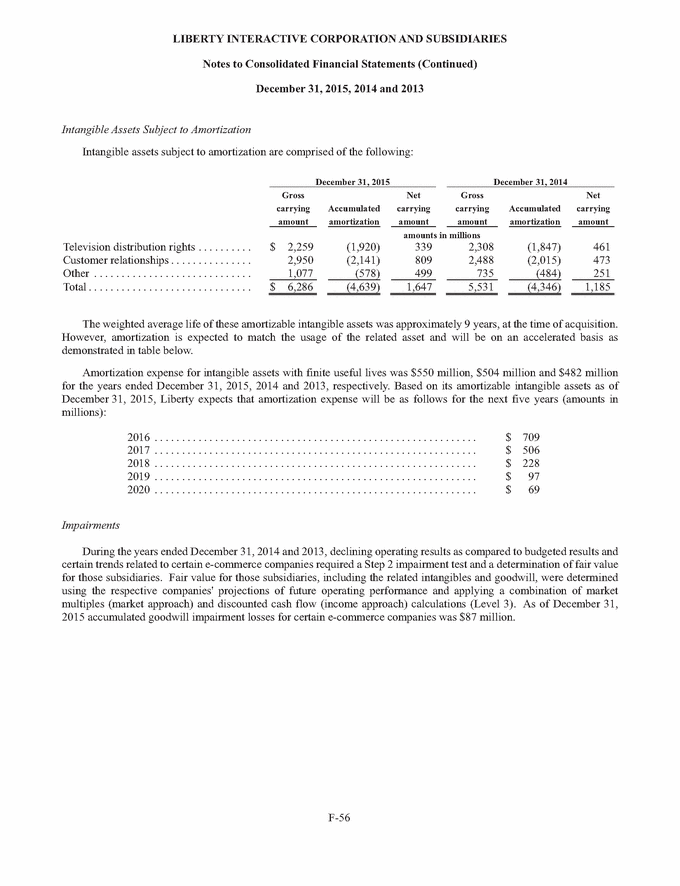
LIBERTY INTERACTIVE CORPORATION AND SUBSIDIARIES Notes to Consolidated Financial Statements (Continued) December 31, 2015, 2014 and 2013 (11) Debt Debt is summarized as follows: Outstanding principal December 31, 2015 Carrying value December 31, December 31, 2015 2014 amounts in millions QVC Group Corporate level notes and debentures 8.5% Senior Debentures due 2029 8.25% Senior Debentures due 2030 1% Exchangeable Senior Debentures due 2043 Subsidiary level notes and facilities QVC 3.125% Senior Secured Notes due 2019 QVC 7.375% Senior Secured Notes due 2020 QVC 5.125% Senior Secured Notes due 2022 QVC 4.375% Senior Secured Notes due 2023 QVC 4.85% Senior Secured Notes due 2024 QVC 4.45% Senior Secured Notes due 2025 QVC 5.45% Senior Secured Notes due 2034 QVC 5.95% Senior Secured Notes due 2043 QVC Bank Credit Facilities Other subsidiary debt Deferred loan costs Total QVC Group Ventures Group Corporate level debentures 4% Exchangeable Senior Debentures due 2029 3.75% Exchangeable Senior Debentures due 2030 3.5% Exchangeable Senior Debentures due 2031 0.75% Exchangeable Senior Debentures due 2043 Subsidiary level notes and facilities Other subsidiary debt Total Ventures Group Total consolidated Liberty debt Less debt classified as current Total long-term debt $ 287 504 346 285 501 349 285 501 444 400 — 500 750 600 600 400 300 1,815 72 399 — 500 750 600 599 399 300 1,815 72 (34) 399 500 500 750 600 599 399 300 508 75 (43) $ 6,574 6,535 5,817 $ 437 437 346 850 257 275 312 1,287 294 291 325 1,220 41 41 61 $ 2,111 2,172 2,191 $ 8,685 8,707 (1,226) 8,008 (946) 7,481 7,062 Exchangeable Senior Debentures Each $1,000 original principal amount of the 0.75% Exchangeable Senior Debentures is exchangeable for a basket of 6.3040 shares of common stock of Time Warner Cable Inc., 5.1635 shares of common stock of Time Warner Inc. and 0.6454 shares of Time, Inc., which may change over time to include other publicly traded common equity securities that may be distributed on or in respect of those shares of Time Warner Cable Inc. and Time Warner Inc. (or into which any of those securities may be converted or exchanged). This basket of shares for which each Debenture in the original principal amount of $1,000 may be exchanged is referred to as the Reference Shares attributable to such Debenture, and to each issuer of Reference Shares as a Reference Company. Each Debenture is exchangeable at the option of the holder at any time, upon which they will be entitled to receive the Reference Shares attributable to such Debenture or, at the election of Liberty Interactive LLC (“Liberty LLC”), cash or a combination of Reference Shares and cash having a value equal to F-57
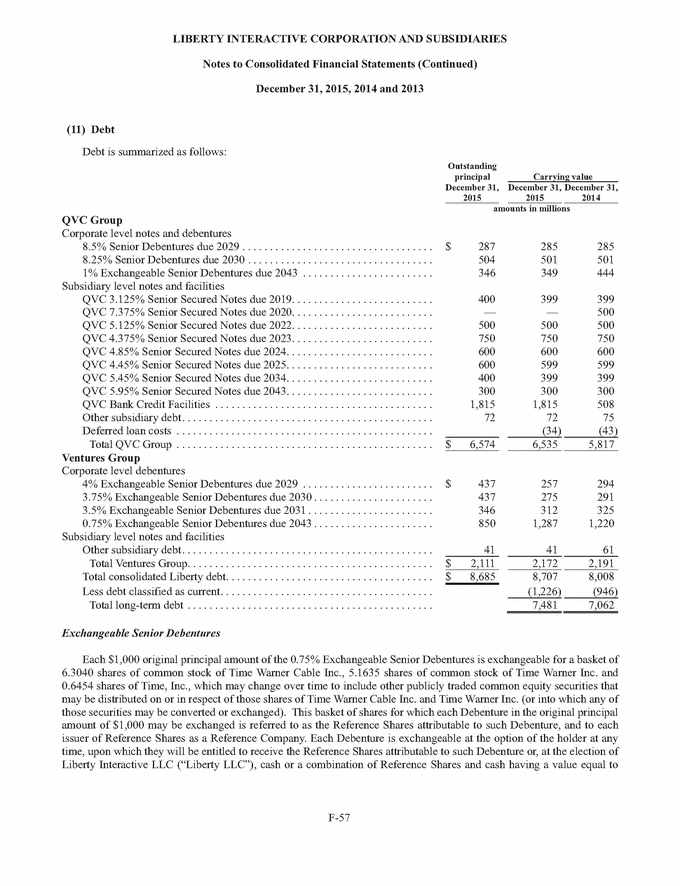
LIBERTY INTERACTIVE CORPORATION AND SUBSIDIARIES Notes to Consolidated Financial Statements (Continued) December 31, 2015, 2014 and 2013 such Reference Shares. Upon exchange, holders will not be entitled to any cash payment representing accrued interest or outstanding additional distributions. Each $1,000 debenture of Liberty LLC's 4% Exchangeable Senior Debentures is exchangeable at the holder's option for the value of 3.2265 shares of Sprint common stock and 0.7860 shares of CenturyLink, Inc. ("CenturyLink") common stock. Liberty LLC may, at its election, pay the exchange value in cash, Sprint and CenturyLink common stock or a combination thereof. Liberty LLC, at its option, may redeem the debentures, in whole or in part, for cash generally equal to the face amount of the debentures plus accrued interest. Each $1,000 debenture of Liberty LLC's 3.75% Exchangeable Senior Debentures is exchangeable at the holder's option for the value of 2.3578 shares of Sprint common stock and 0.5746 shares of CenturyLink common stock. Liberty LLC may, at its election, pay the exchange value in cash, Sprint and CenturyLink common stock or a combination thereof. Liberty, at its option, may redeem the debentures, in whole or in part, for cash equal to the face amount of the debentures plus accrued interest. Each $1,000 debenture of Liberty LLC's 3.5% Exchangeable Senior Debentures (the "Motorola Exchangeables") was exchangeable at the holder's option for the value of 5.2598 shares of Motorola Solutions, Inc. and 4.6024 shares of Motorola Mobility Holdings, Inc., as a result of Motorola Inc.'s separation of Motorola Mobility Holdings, Inc. ("MMI") in a 1 for 8 stock distribution, and the subsequent 1 for 7 reverse stock split of Motorola, Inc. (which has been renamed Motorola Solutions, Inc. ("MSI")), effective January 4, 2011. MMI was acquired on May 22, 2012 for $40 per share in cash. Pursuant to the indenture, the cash paid to shareholders in the MMI acquisition was to be paid to the holders of the Motorola Exchangeables as an extraordinary distribution. Liberty LLC made a cash payment of $184.096 per debenture in the second quarter of 2012 for a total payment of $111 million. The remaining exchange value is payable, at Liberty's option, in cash or MSI stock or a combination thereof. Liberty LLC, at its option, may redeem the debentures, in whole or in part, for cash generally equal to the adjusted principal amount of the debentures plus accrued interest. As a result of a cash distribution made by Liberty LLC in 2007, the cash disbursement discussed above and various principal payments made to holders of the Motorola Exchangeables, the adjusted principal amount of each $1,000 debenture is $577 as of December 31, 2015. Each $1,000 original principal amount of the 1% Exchangeable Senior Debentures due 2043 (the “HSNi Exchangeables”) is initially exchangeable for 13.4580 shares of common stock of HSNi (the "HSNi Reference Shares"). Each of the HSNi Exchangeables is exchangeable at the option of the holder, for certain triggering events (primarily the increase in an average trading period at the end of the quarter for HSNi reference shares above 130% or below 98% of the adjusted principal amount at the end of a quarter) after the calendar quarter ended March 31, 2014, upon achieving certain trading prices of the underlying HSNi Reference Shares. Upon exchange, holders of HSNi Exchangeables will be entitled to receive the HSNi Reference Shares attributable to such HSNi Exchangeables or, at the election of Liberty LLC, cash or a combination of HSNi Reference Shares and cash having a value equal to such HSNi Reference Shares. For purposes of the HSNi Exchangeables, Liberty LLC is treated as an affiliate of HSNi under the Securities Act. Therefore, for as long as Liberty LLC is treated as an affiliate of HSNi for purposes of the HSNi Exchangeables, any reference shares consisting of HSNi common stock (or common stock of any other reference company of which Liberty LLC is treated as an affiliate for purposes of the HSNi Exchangeables) delivered by Liberty LLC upon exchange or purchase of a HSNi Exchangeables will be "restricted securities" under the Securities Act and subject to restrictions on transfer. Liberty LLC may deliver HSNi Reference Shares upon exchange or purchase of the HSNi Exchangeables only if (1) permitted under certain contractual arrangements between the Company and HSNi and (2) such Reference Shares would be freely transferable by the holders of the HSNi Reference Shares (other than by affiliates of HSNi) under the Securities Act, or if not freely transferable, there is at that time an effective registration statement under a registration rights agreement that Liberty LLC has with HSNi (or such other Reference Company) pursuant to which the recipients of such HSNi Reference Shares may sell those shares in a registered transaction under the Securities Act. F-58
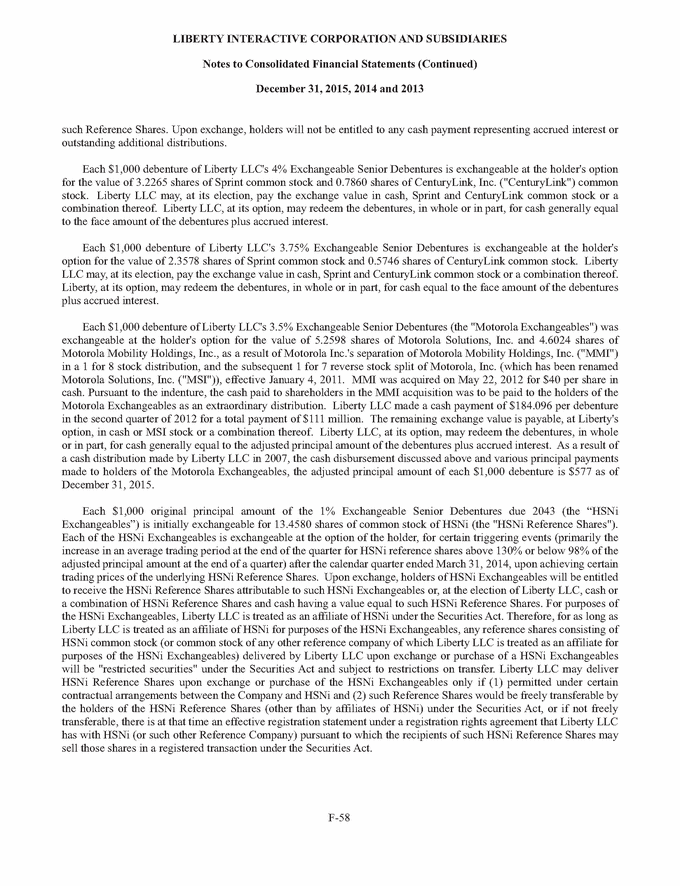
LIBERTY INTERACTIVE CORPORATION AND SUBSIDIARIES Notes to Consolidated Financial Statements (Continued) December 31, 2015, 2014 and 2013 Liberty LLC will make an additional distribution on the HSNi Exchangeables if HSNi makes a distribution of cash (an “Excess Regular Cash Dividend”) in excess of $0.18, currently paid by the HSNi securities (other than publicly traded common equity securities) or other property with respect to the HSNi Reference Shares. The principal amount of the HSNi Exchangeables will not be reduced by any amount we pay that corresponds to any Excess Regular Cash Dividends on the HSNi Reference Shares. In January 2015, HSNi declared a special dividend of $10 per share from which Liberty received approximately $200 million in cash in February 2015. Pursuant to the terms of the debentures, a portion of the special dividend ($54 million) was passed through to the holders of the notes and the outstanding principal balance was reduced in March 2015. Additionally, HSNi declared cash dividends of $0.35 per share on March 9, 2015, June 1, 2015, August 31, 2015 and November 30, 2015. The portion of the quarterly dividend in excess of the regular cash dividend of $0.18 per share was passed through to bondholders during 2015. On October 5, 2016, Liberty LLC may, at its option, redeem the HSNi Exchangeables, in whole or in part, in each case at a redemption price, in cash, equal to the adjusted principal amount of the HSNi Exchangeables plus accrued and unpaid interest to the date of redemption plus any final period distribution. Additionally, as of such date, holders may tender HSNi Exchangeables for purchase by Liberty LLC, at a purchase price equal to the adjusted principal amount plus accrued and unpaid interest to the purchase date plus any final period distribution. Liberty LLC may pay the purchase price, at its election, in cash or through delivery of HSNi Reference Shares (subject to the restrictions discussed previously) having a value equal to the purchase price or a combination of HSNi Reference Shares and cash. If Liberty LLC makes a partial redemption, HSNi Exchangeables in an aggregate original principal amount of at least $100 million must remain outstanding. The HSNi Exchangeables are included in “current portion of debt” on the consolidated balance sheet as of December 31, 2015. Liberty has elected to account for all of its Exchangeables using the fair value option. Accordingly, changes in the fair value of these instruments are recognized as unrealized gains (losses) in the statements of operations. Liberty will review the triggering events on a quarterly basis to determine whether a triggering event has occurred to require current classification of certain Exchangeables, see additional discussion below. Liberty has sold, split-off or otherwise disposed of all of its shares of Motorola, Sprint and CenturyLink common stock which underlie the respective Exchangeable Senior Debentures. Because such exchangeable debentures are exchangeable at the option of the holder at any time and Liberty can no longer use owned shares to redeem the debentures, Liberty has classified for financial reporting purposes the portion of the debentures that could be redeemed for cash as a current liability. Such amount aggregated $844 million at December 31, 2015. Although such amount has been classified as a current liability for financial reporting purposes, the Company believes the probability that the holders of such instruments will exchange a significant principal amount of the debentures prior to maturity is remote. Interest on the Company's exchangeable debentures is payable semi-annually based on the date of issuance. At maturity, all of the Company's exchangeable debentures are payable in cash. Senior Debentures Interest on the Senior Debentures is payable semi-annually based on the date of issuance. The Senior Debentures are stated net of an aggregate unamortized discount of $5 million at December 31, 2015 and 2014. Such discount is being amortized to interest expense in the accompanying consolidated statements of operations. QVC Senior Secured Notes On March 18, 2014, QVC issued $400 million principal amount of 3.125% Senior Secured Notes due 2019 at an issue price of 99.828% and $600 million principal amount of 4.85% Senior Secured Notes due 2024 at an issue price of 99.927% (collectively, the “March Notes”). The March Notes are secured by the capital stock of QVC and certain of QVC’s F-59
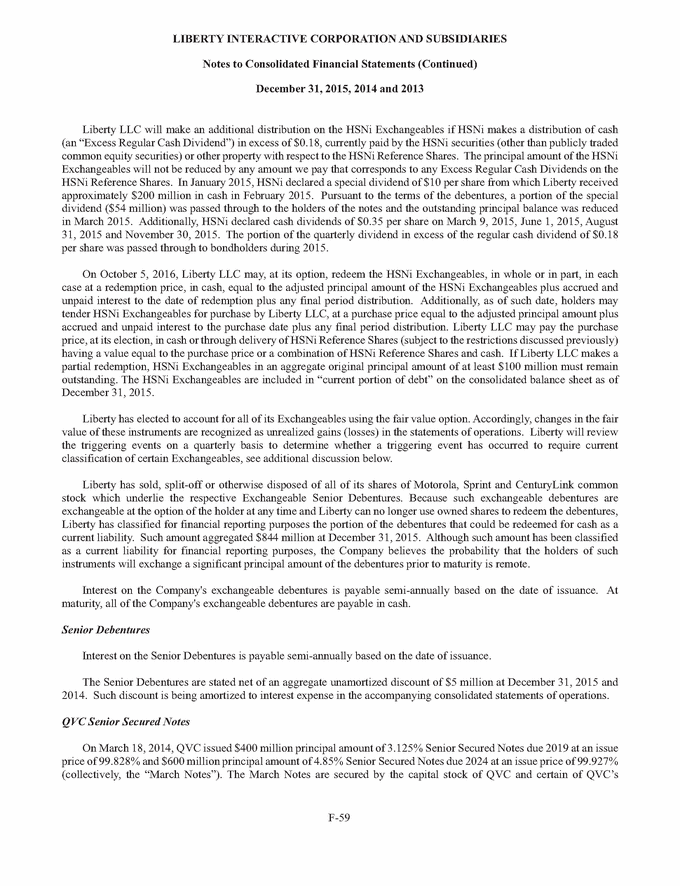
LIBERTY INTERACTIVE CORPORATION AND SUBSIDIARIES Notes to Consolidated Financial Statements (Continued) December 31, 2015, 2014 and 2013 subsidiaries and have equal priority to QVC’s senior secured credit facility. The net proceeds from the March Notes offerings were used to repay indebtedness under QVC’s senior secured credit facility and for working capital and other general corporate purposes. On August 21, 2014, QVC issued $600 million principal amount of 4.45% Senior Secured Notes due 2025 at an issue price of 99.860% and $400 million principal amount 5.45% Senior Secured Notes due 2034 at an issue price of 99.784% (collectively, the “August Notes”). The August Notes are secured by the capital stock of QVC and certain of QVC’s subsidiaries and have equal priority to QVC’s senior secured credit facility. The net proceeds from the August Notes offerings were used for the redemption of QVC’s 7.5% Senior Secured Notes due 2019 (the “Redemption”) on September 9, 2014 and for working capital and other general corporate purposes. As a result of the Redemption, QVC incurred an extinguishment loss of $48 million for the year ended December 31, 2014. As a result of refinancing transactions in the prior year, QVC recorded extinguishment losses of $57 million for the year ended December 31, 2013. Losses on early extinguishment of debt are recorded in other, net in the Company's consolidated statements of operations. During prior years, QVC issued $500 million principal amount of 7.375% Senior Secured Notes due 2020 at par, $1,000 million principal amount of QVC 7.50% Senior Secured Notes due 2019 at an issue price of 98.278% of par, $500 million principal amount of 5.125% Senior Secured Notes due 2022 at par, $750 million principal amount of 4.375% Senior Secured Notes due 2023 at par and $300 million principal amount of 5.95% Senior Secured Notes due 2043 at par. On April 15, 2015, QVC completed the redemption of $500 million principal amount of its 7.375% Senior Secured Notes due 2020, whereby holders received consideration of $1,036.88 for each $1,000 of principal tendered. As a result of the redemption, a $21 million extinguishment loss is included in “Other, net” in the accompanying consolidated statement of operations for the year ended December 31, 2015. QVC was in compliance with all of its debt covenants related to its outstanding senior notes at December 31, 2015. QVC Bank Credit Facilities On March 9, 2015, QVC amended and restated its senior secured credit facility (the "Second Amended and Restated Credit Agreement"), which is a multi-currency facility that provides for a $2.25 billion revolving credit facility with a $250 million sub-limit for standby letters of credit and $1.5 billion of uncommitted incremental revolving loan commitments or incremental term loans. QVC may elect that the loans extended under the senior secured credit facility bear interest at a rate per annum equal to the ABR or LIBOR, as each is defined in the senior secured credit facility agreement, plus a margin of 0.25% to 1.75% depending on various factors. Each loan may be prepaid in whole or in part without penalty at any time other than customary breakage costs. Any amounts prepaid on the revolving credit facility may be reborrowed. Payment of loans may be accelerated following certain customary events of default. The purpose of the amendment was to, among other things, extend the maturity of QVC’s senior secured credit facility to March 9, 2020 and lower the interest rate on borrowings. The senior secured credit facility is secured by the capital stock of QVC. QVC had $434.8 million available under the terms of the senior secured credit facility at December 31, 2015. The interest rate on the senior secured credit facility was 1.9% at December 31, 2015. F-60
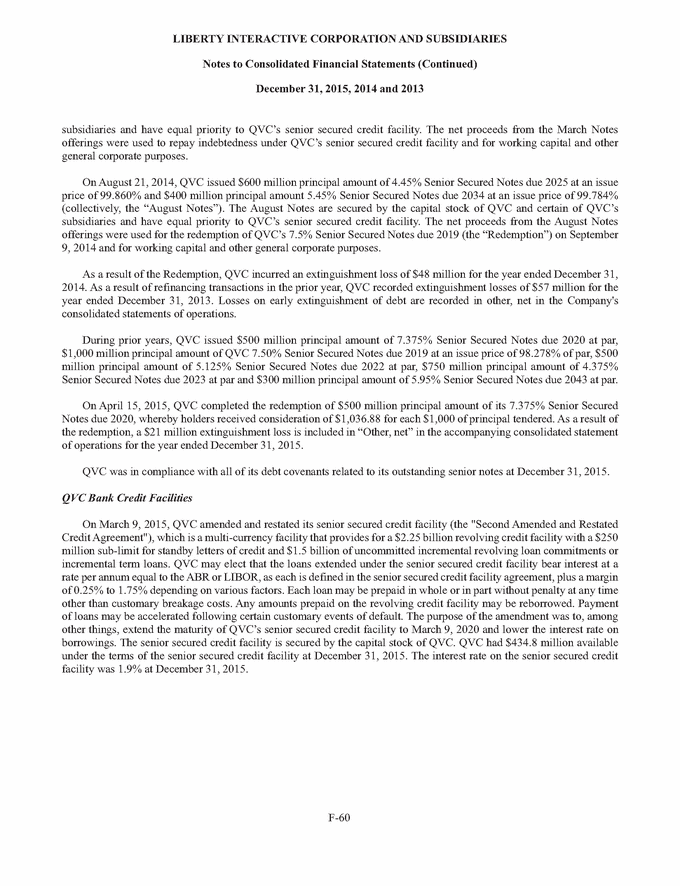
LIBERTY INTERACTIVE CORPORATION AND SUBSIDIARIES Notes to Consolidated Financial Statements (Continued) December 31, 2015, 2014 and 2013 The Second Amended and Restated Credit Agreement contains certain affirmative and negative covenants, including certain restrictions on the Company and each of its restricted subsidiaries (subject to certain exceptions) with respect to, among other things: incurring additional indebtedness; creating liens on property or assets; making certain loans or investments; selling or disposing of assets; paying certain dividends and other restricted payments; dissolving, consolidating or merging; entering into certain transactions with affiliates; entering into sale or leaseback transactions; restricting subsidiary distributions; and limiting the Company’s consolidated leverage ratio, which is defined in QVC’s senior secured credit facility as the ratio of consolidated total debt to consolidated Adjusted OIBDA for the most recent four fiscal quarter period. The Company defines Adjusted OIBDA as revenue less cost of goods sold, operating expenses, and selling, general and administrative expenses (excluding stock-based compensation). QVC was in compliance with all debt covenants related to the bank Credit Facility at December 31, 2015. QVC Interest Rate Swap Arrangements In prior years QVC entered into forward interest rate swap arrangements with an aggregate notional amount of $3.1 billion. Such arrangements matured in March 2013 and no further interest swap arrangements were entered into. These swap arrangements did not qualify as cash flow hedges under GAAP. Accordingly, changes in the fair value of the swaps were reflected in realized and unrealized gains or losses on financial instruments in the accompanying consolidated statements of operations. Other Subsidiary Debt Other subsidiary debt at December 31, 2015 is comprised of capitalized satellite transponder lease obligations and bank debt of certain subsidiaries. Five Year Maturities The annual principal maturities of Liberty's debt, based on stated maturity dates, for each of the next five years is as follows (amounts in millions): 2016 2017 2018 2019 2020 $ $ $ $ $ 390 27 29 428 1,837 Fair Value of Debt Liberty estimates the fair value of its debt based on the quoted market prices for the same or similar issues or on the current rate offered to Liberty for debt of the same remaining maturities. The fair value, based on quoted prices of instruments but not considered to be active markets (Level 2), of Liberty's publicly traded debt securities that are not reported at fair value in the accompanying consolidated balance sheets is as follows (amounts in millions): December 31, 2015 2014 Senior debentures QVC senior secured notes $ $ 809 3,374 882 4,118 F-61
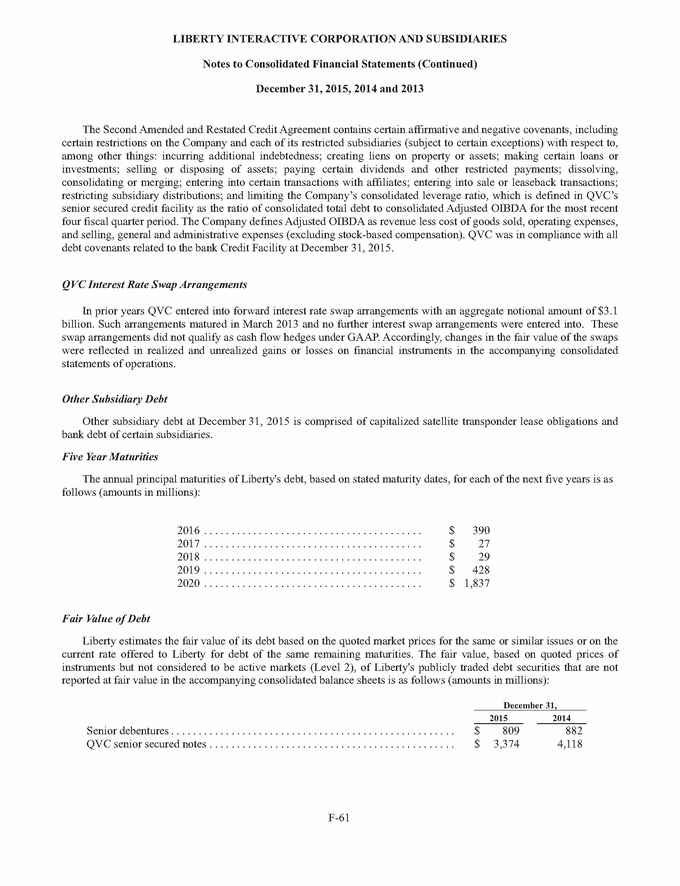
LIBERTY INTERACTIVE CORPORATION AND SUBSIDIARIES Notes to Consolidated Financial Statements (Continued) December 31, 2015, 2014 and 2013 Due to the variable rate nature, Liberty believes that the carrying amount of its subsidiary debt not discussed above approximated fair value at December 31, 2015. (12) Income Taxes Income tax benefit (expense) consists of: Years ended December 31, 2015 2014 2013 amounts in millions Current: Federal State and local Foreign $ (191) (26) (74) (157) (32) (110) (97) (26) (82) $ (291) (299) (205) Deferred: Federal State and local Foreign $ (67) 8 8 59 (23) 5 (19) 47 (6) (51) 41 22 Income tax benefit (expense) $ (342) (258) (183) The following table presents a summary of our domestic and foreign earnings from continuing operations before income taxes: Years ended December 31, 2015 2014 2013 amounts in millions Domestic Foreign Total $ 1,111 142 676 160 575 162 $ 1,253 836 737 Income tax benefit (expense) differs from the amounts computed by applying the U.S. federal income tax rate of 35% as a result of the following: Years ended December 31, 2015 2014 2013 amounts in millions Computed expected tax benefit (expense) State and local income taxes, net of federal income taxes Foreign taxes, net of foreign tax credits Sale of consolidated subsidiary Impairment of intangible assets not deductible for tax purposes Dividends received deductions Alternative energy tax credits Change in valuation allowance affecting tax expense Impact of change in state rate on deferred taxes Other, net Income tax benefit (expense) $ (439) (24) (4) — — 56 61 6 (7) 9 (293) (7) (2) 14 (3) 10 58 (2) (28) (5) (258) (15) (7) — (2) 9 54 (27) 66 (3) $ (342) (258) (183) F-62
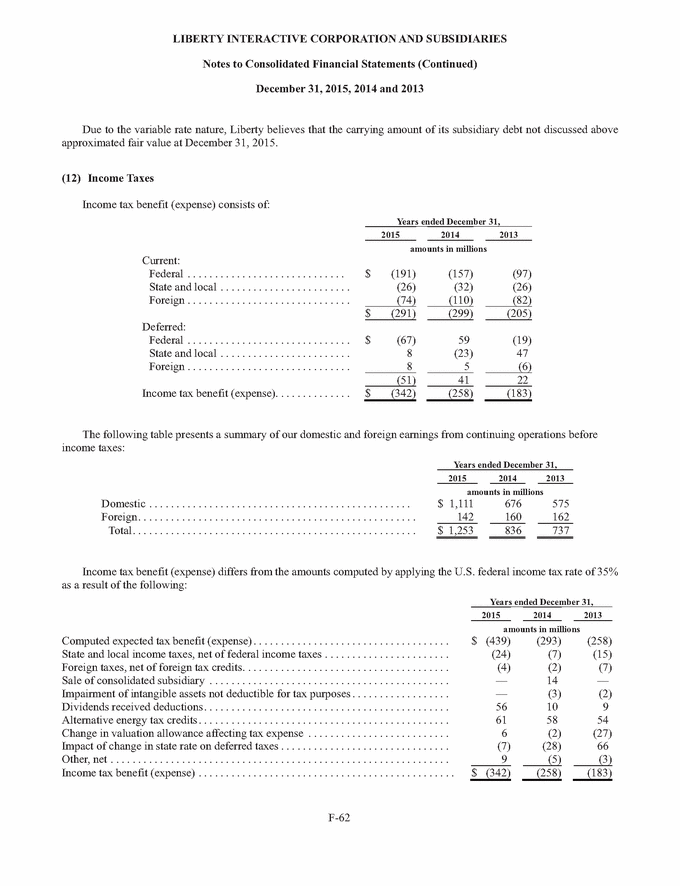
LIBERTY INTERACTIVE CORPORATION AND SUBSIDIARIES Notes to Consolidated Financial Statements (Continued) December 31, 2015, 2014 and 2013 Income tax expense was lower than the U.S. statutory tax rate of 35% in 2015 due to the receipt of taxable dividends that are subject to a dividends received deduction. During 2014 and 2013, Liberty changed its estimate of the effective state tax rate used to measure its net deferred tax liabilities, based on expected changes to the Company’s state apportionment factors. The change in 2014 was caused by the sale of a consolidated subsidiary (Provide) on December 31, 2014. The change in state apportionment factors during 2013 also changed the potential utilization of the Company’s state net operating loss carryforwards, which resulted in a valuation allowance being recorded for certain state net operating loss carryforwards that may expire unused. In both years, the rate change required an adjustment to the recognized deferred taxes at the corporate level. During 2015, 2014 and 2013, Liberty offset federal tax liabilities with tax credits derived from its alternative energy investments. The tax effects of temporary differences that give rise to significant portions of the deferred income tax assets and deferred income tax liabilities are presented below: December 31, 2015 2014 amounts in millions Deferred tax assets: Net operating and capital loss carryforwards Foreign tax credit carryforwards Accrued stock compensation Other accrued liabilities Other future deductible amounts Deferred tax assets Valuation allowance Net deferred tax assets $ 99 72 83 165 163 90 88 41 181 96 582 (48) 496 (54) 534 442 Deferred tax liabilities: Investments Intangible assets Discount on exchangeable debentures Deferred gain on debt retirements Other Deferred tax liabilities Net deferred tax liabilities 883 1,788 1,148 193 24 703 1,284 1,009 257 10 4,036 3,263 $ 3,502 2,821 The Company's valuation allowance decreased $6 million in 2015. The entire change in valuation allowance affected tax expense. At December 31, 2015, Liberty had net operating losses (on a tax effected basis) and foreign tax credit carryforwards for income tax purposes aggregating approximately $99 million and $72 million, respectively, which will begin to expire in 2020 and beyond if not utilized to reduce domestic, state or foreign income tax liabilities in future periods. These net operating losses and foreign tax credit carryforwards are expected to be utilized prior to expiration, except for $48 million of net operating losses which based on current projections of domestic, state and foreign income may expire unused. F-63
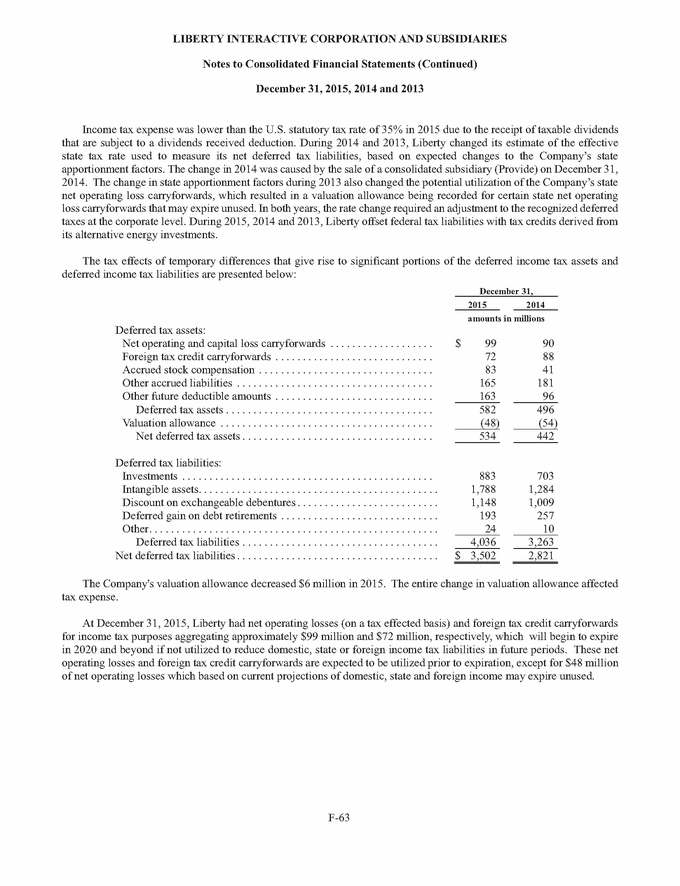
LIBERTY INTERACTIVE CORPORATION AND SUBSIDIARIES Notes to Consolidated Financial Statements (Continued) December 31, 2015, 2014 and 2013 A reconciliation of unrecognized tax benefits is as follows: Years ended December 31, 2015 2014 2013 amounts in millions Balance at beginning of year Additions based on tax positions related to the current year Additions for tax positions of prior years Reductions for tax positions of prior years Lapse of statute and settlements Balance at end of year $ 136 14 — (12) (34) 124 16 20 (3) (21) 122 19 1 (3) (15) $ 104 136 124 As of December 31, 2015, 2014 and 2013 the Company had recorded tax reserves of $104 million, $136 million and $124 million, respectively, related to unrecognized tax benefits for uncertain tax positions. If such tax benefits were to be recognized for financial statement purposes, $47 million, $68 million and $84 million for the years ended December 31, 2015, 2014 and 2013, respectively, would be reflected in the Company's tax expense and affect its effective tax rate. Liberty's estimate of its unrecognized tax benefits related to uncertain tax positions requires a high degree of judgment. The Company has tax positions for which the amount of related unrecognized tax benefits could change during 2016. The amount of unrecognized tax benefits related to these issues could change as a result of potential settlements, lapsing of statute of limitations and revisions of estimates. It is reasonably possible that the amount of the Company's gross unrecognized tax benefits may increase within the next twelve months by up to $5 million. As of December 31, 2015, the Company's tax years prior to 2012 are closed for federal income tax purposes, and the IRS has completed its examination of the Company's 2012 and 2013 tax year. The Company's tax loss carryforwards from its 2011 through 2014 tax years are still subject to adjustment. The Company's 2014 and 2015 tax years are being examined currently as part of the IRS's Compliance Assurance Process ("CAP") program. Various states are currently examining the Company's prior years state income tax returns. QVC is currently under audit in the U.K., Germany and Italy. The Company received an assessment related to an examination in Germany. The Company believes that any amounts ultimately paid in connection with that assessment will be creditable against its U.S. federal income tax liability. As of December 31, 2015, the Company had recorded $17 million of accrued interest and penalties related to uncertain tax positions. (13) Stockholders' Equity Preferred Stock Liberty's preferred stock is issuable, from time to time, with such designations, preferences and relative participating, optional or other rights, qualifications, limitations or restrictions thereof, as shall be stated and expressed in a resolution or resolutions providing for the issue of such preferred stock adopted by Liberty's Board of Directors. As of December 31, 2015, no shares of preferred stock were issued. F-64
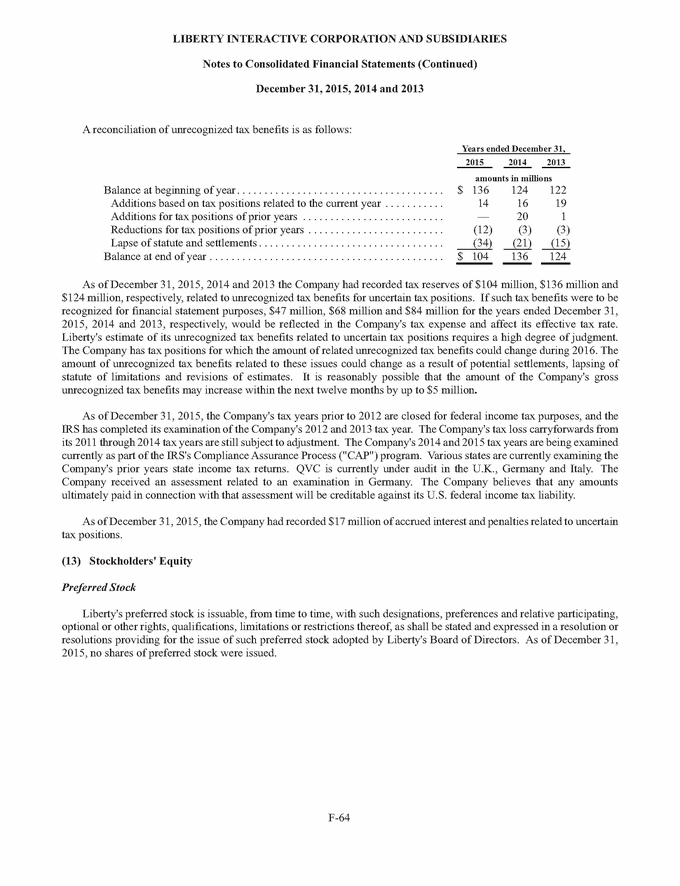
LIBERTY INTERACTIVE CORPORATION AND SUBSIDIARIES Notes to Consolidated Financial Statements (Continued) December 31, 2015, 2014 and 2013 Common Stock Series A QVC Group and Liberty Ventures common stock has one vote per share, and Series B QVC Group and Liberty Ventures common stock has ten votes per share. Each share of the Series B common stock is exchangeable at the option of the holder for one share of Series A common stock of the same group. The Series A and Series B common stock participate on an equal basis with respect to dividends and distributions. At the Annual Meeting of Stockholders held on June 2, 2015, the Company’s stockholders approved an amendment to the Restated Certificate of Incorporation that increased (i) the total number of shares of the Company’s capital stock which the Company will have the authority to issue to 9,015 million shares, (ii) the number of shares of the Company’s capital stock designated as “Common Stock” to 8,965 million shares and (iii) the number of shares of Common Stock designated as “Series A Liberty Ventures Common Stock,” “Series B Liberty Ventures Common Stock” and “Series C Liberty Ventures Common Stock” to 400 million shares, 15 million shares and 400 million shares, respectively. As of December 31, 2015, Liberty reserved for issuance upon exercise of outstanding stock options approximately 31.5 million shares of Series A QVC Group common stock and approximately 0.8 million shares of Series B QVC Group common stock. As of December 31, 2015, Liberty reserved for issuance upon exercise of outstanding stock options approximately 3.7 million shares of Series A Liberty Ventures common stock and approximately 1.5 million shares of Series B Liberty Ventures common stock. In addition to the Series A and Series B QVC Group and Ventures common stock there are 4 billion and 400 million shares of Series C QVC Group and Ventures common stock authorized for issuance, respectively. As of December 31, 2015, no shares of any Series C QVC Group and Ventures common stock were issued or outstanding. As discussed in note 2, on February 27, 2014, Liberty’s board approved a two for one stock split of Series A and Series B Liberty Ventures common stock, to be effected by means of a dividend. The stock split was done in order to bring Liberty into compliance with a Nasdaq listing requirement regarding the minimum number of publicly held shares of the Series B Liberty Ventures common stock. In the stock split, a dividend was paid on April 11, 2014 to holders of Series A and Series B Liberty Ventures common stock of one share of Series A or Series B Liberty Ventures common stock for each share of Series A or Series B Liberty Ventures common stock, respectively, held by them as of 5:00 pm, New York City time, on April 4, 2014. The stock split has been recorded retroactively for all periods presented for comparability purposes. Additionally, as discussed in note 2, on October 3, 2014, Liberty attributed from the QVC Group to the Ventures Group its Digital Commerce companies. Holders of Liberty Interactive common shares received 0.14217 shares of Liberty Ventures common shares for each share of Liberty Interactive common shares held, as of the record date. The shares issued and subsequently distributed to Liberty Interactive common stock shareholders in the form of a dividend did not require retroactive treatment. On October 1, 2015, in conjunction with the acquisition of zulily, as discussed in note 5, Liberty issued 38.5 million shares of Series A QVC Group Common Stock. Purchases of Common Stock During the year ended December 31, 2013 the Company repurchased 46,305,637 shares of Series A QVC Group common stock for aggregate cash consideration of $1,089 million. During the year ended December 31, 2014 the Company repurchased 27,356,993 shares of Series A QVC Group common stock for aggregate cash consideration of $785 million. During the year ended December 31, 2015 the Company repurchased 28,134,498 shares of Series A QVC Group common stock for aggregate cash consideration of $785 million. F-65
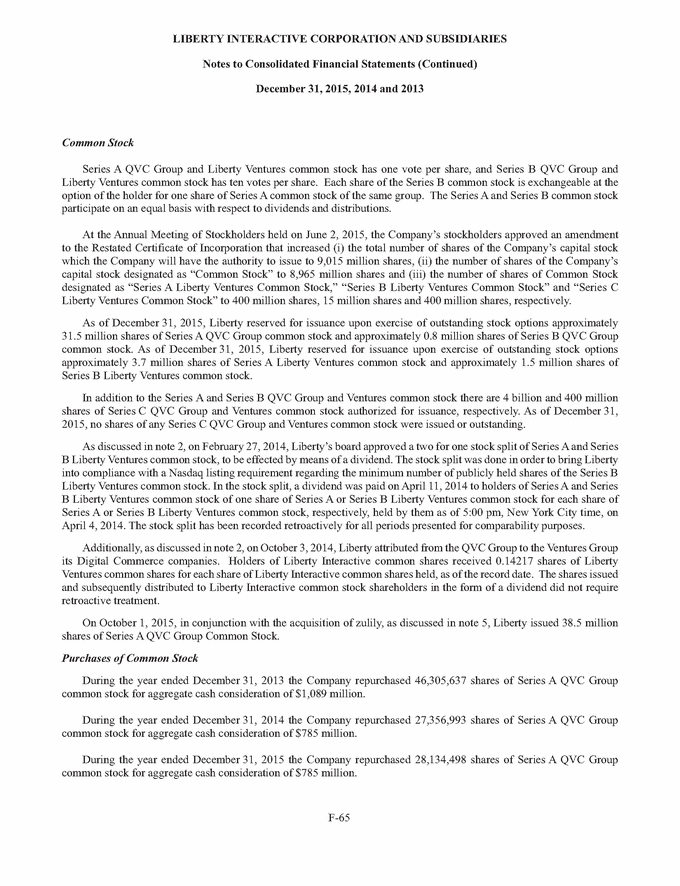
LIBERTY INTERACTIVE CORPORATION AND SUBSIDIARIES Notes to Consolidated Financial Statements (Continued) December 31, 2015, 2014 and 2013 All of the foregoing shares were repurchased pursuant to a previously announced share repurchase program and have been retired and returned to the status of authorized and available for issuance. (14) Transactions with Officers and Directors Chief Executive Officer Compensation Arrangement In December 2014, the Compensation Committee (the "Committee") of Liberty approved a compensation arrangement, including term options discussed in note 15, for its President and Chief Executive Officer (the "CEO"). The arrangement provides for a five year employment term beginning January 1, 2015 and ending December 31, 2019, with an annual base salary of $960,750, increasing annually by 5% of the prior year's base salary, and an annual target cash bonus equal to 250% of the applicable year's annual base salary. The arrangement also provides that, in the event the CEO is terminated for "cause," he will be entitled only to his accrued base salary and any amounts due under applicable law and he will forfeit all rights to his unvested term options. If, however, the CEO is terminated by Liberty without cause or if he terminates his employment for “good reason,” the arrangement provides for him to receive his accrued base salary, his accrued but unpaid bonus and any amounts due under applicable law, a severance payment of 1.5 times his base salary during the year of his termination, a payment equal to $11,750,000 pro rated based upon the elapsed number of days in the calendar year of termination, a payment equal to $17.5 million, and for his unvested term options to generally vest pro rata based on the portion of the term elapsed through the termination date plus 18 months and for all vested and accelerated options to remain exercisable until their respective expiration dates. If the CEO terminates his employment without “good reason,” he will be entitled to his accrued base salary, his accrued but unpaid bonus and any amounts due under applicable law and a payment of the $11,750,000 and for his unvested term options to generally vest pro rata based on the portion of the term elapsed through the termination date and all vested and accelerated options to remain exercisable until their respective expiration dates. Lastly, in the case of the CEO's death or his disability, the arrangement provides that he will be entitled only to his accrued base salary and any amounts due under applicable law, a payment of 1.5 times his base salary during that year, a payment equal to $11,750,000 pro rated based upon the elapsed number of days in the calendar year of termination, a payment equal to $17.5 million and for his unvested term options to fully vest and for his vested and accelerated term options to remain exercisable until their respective expiration dates. In addition, beginning in 2015, the CEO will receive annual performance-based options to purchase shares of QVCB and LVNTB with a term of 7 years (the “Performance Options”) and performance-based restricted stock units with respect to QVCB and LVNTB (the “Performance RSUs” and together with the Performance Options, the “Performance Awards”) during the employment term. Grants of Performance Awards will be allocated between Liberty and Liberty Media Corporation. The aggregate target amount to be allocated between Liberty and Liberty Media was $16 million with respect to calendar year 2015, and will be $17 million with respect to calendar year 2016, $18 million with respect to calendar year 2017, $19 million with respect to calendar year 2018 and $20 million with respect to calendar year 2019. Vesting of the Performance Awards will be determined based on satisfaction of performance metrics that will be set by Liberty and Liberty Media’s respective compensation committees in the first quarter of each applicable year, except that the CEO will forfeit his unvested Performance Awards if his employment is terminated for any reason before the end of the applicable year. In addition, Liberty and Liberty Media’s compensation committees may grant additional Performance Awards, with a value of up to 50% of the target amount allocated to Liberty for the relevant year (the “Above Target Awards”), and the compensation committees may determine to establish additional performance metrics with respect to such Above Target Awards. F-66
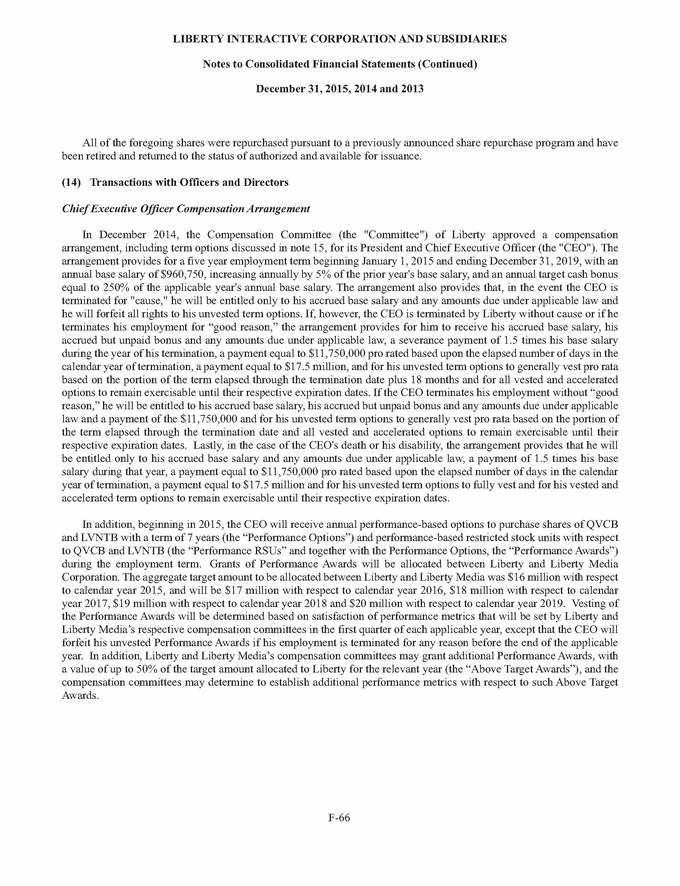
LIBERTY INTERACTIVE CORPORATION AND SUBSIDIARIES Notes to Consolidated Financial Statements (Continued) December 31, 2015, 2014 and 2013 (15) Stock-Based Compensation Liberty - Incentive Plans Pursuant to the Liberty Interactive Corporation 2012 Incentive Plan, as amended (the "2012 Plan"), the Company may grant stock options (“Awards”) to purchase shares of Series A and Series B QVC Group common stock and Liberty Ventures common stock. The 2012 Plan provides for Awards to be made in respect of a maximum of 47 million shares of Liberty common stock. Awards generally vest over 4-5 years and have a term of 7-10 years. Liberty issues new shares upon exercise of equity awards. The Company measures the cost of employee services received in exchange for an Award of equity instruments (such as stock options and restricted stock) based on the grant-date fair value of the Award, and recognizes that cost over the period during which the employee is required to provide service (usually the vesting period of the Award). Pursuant to the Liberty Interactive Corporation 2011 Nonemployee Director Incentive Plan, as amended (the "2011 NDIP"), the Liberty Board of Directors has the full power and authority to grant eligible nonemployee directors stock options, SARs, stock options with tandem SARs, and restricted stock. In connection with the zulily acquisition in October 2015 (see note 5), outstanding awards to purchase shares of zulily Class A and Class B common stock (a “zulily Award”) were exchanged for awards to purchase shares of Series A QVC Group common stock (a “QVCA Award”). The exercise prices and number of shares subject to the QVCA Award were determined based on 1) the exercise prices and number of shares subject to the zulily Award and 2) a conversion ratio which was calculated using the acquisition exchange ratio, acquisition cash consideration, and pre-distribution trading price of the Series A QVC Group common stock, such that all of the pre-distribution intrinsic value of the zulily Award was allocated to the QVCA Award. The exchange of such awards was considered a modification under ASC 805 – Business Combinations. A portion of the fair value of the replacement QVCA Awards was attributed to the consideration paid in the acquisition. The remaining portion of the fair value will be recognized in the consolidated financial statements over the remaining vesting period of each individual award. In connection with the TripAdvisor Holdings Spin-Off during 2014, the holder of an outstanding Award to purchase shares of Liberty Ventures Series A and Series B common stock on the record date (a “Liberty Ventures Award”) received an Award to purchase shares of the corresponding series of TripAdvisor Holdings common stock and an adjustment to the exercise price and number of shares subject to the original Liberty Ventures Award (as so adjusted, an “adjusted Liberty Ventures Award”). Following the TripAdvisor Holdings Spin-Off, employees of Liberty hold Awards in both Liberty Ventures common stock and TripAdvisor Holdings common stock. The compensation expense relating to employees of Liberty is recorded at Liberty. Additionally, outstanding stock options, relating to QVC Group common stock, were adjusted, using a similar methodology as described above, in connection with the stock dividend related to the reattribution of the Digital Commerce businesses from the QVC Group to the Ventures Group during October 2014. F-67
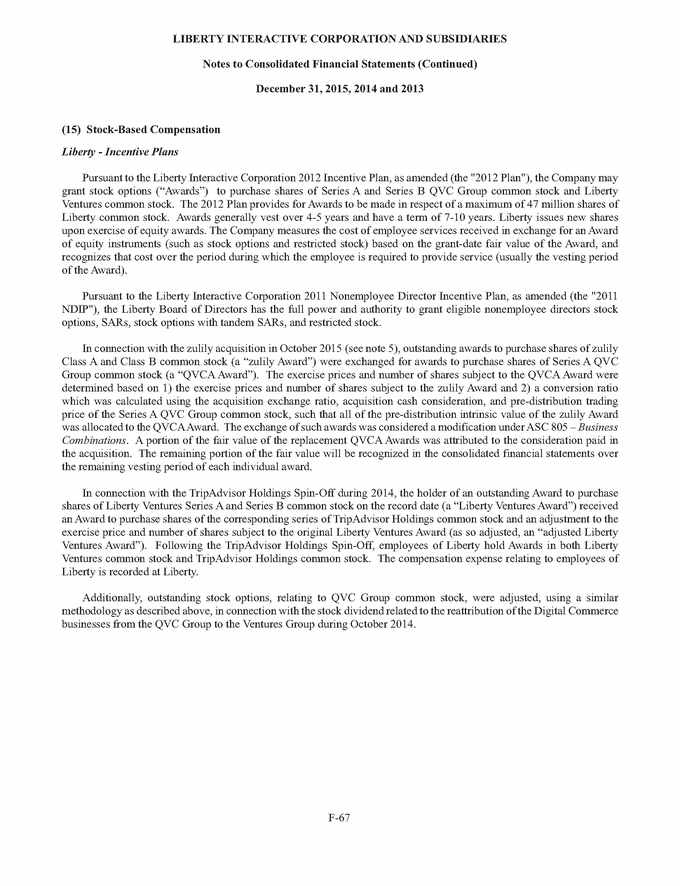
LIBERTY INTERACTIVE CORPORATION AND SUBSIDIARIES Notes to Consolidated Financial Statements (Continued) December 31, 2015, 2014 and 2013 Liberty – Grants During the year ended December 31, 2015, Liberty granted: • 2.2 million options, primarily to QVC employees, to purchase shares of Series A QVC Group common stock which had a weighted average grant-date fair value of $11.63 per share and vest semi-annually over four years. 1.7 million options to QVC’s CEO in connection with a new compensation arrangement, to purchase shares of Series A QVC Group common stock which had a weighted average grant-date fair value of $10.40 per share and vest 50% on each of December 31, 2019 and 2020. 2.5 million options, to Liberty employees, to purchase shares of Series A QVC Group common stock which had a weighted average grant-date fair value of $11.63 per share. 652 thousand of the options vest annually over 3 years and 1.7 million of the options vest 50% on each of December 31, 2019 and 2020. 683 thousand options to purchase shares of Series A Liberty Ventures common stock which had a weighted average grant-date fair value of $18.10 per share. Such options primarily vest 50% on each of December 31, 2019 and 2020. 132 thousand performance-based options of Series B QVC Group common stock and 135 thousand performance-based options of Series B Liberty Ventures common stock to the CEO of Liberty in connection with our CEO’s employment agreement. Such options had a fair value of $10.10 per share and $16.94 per share, respectively, at the time they were granted. Liberty also granted 182 thousand and 13 thousand performance-based restricted stock units of Series B QVC Group common stock and Series B Liberty Ventures common stock, respectively. The restricted stock units had a fair value of $29.41 per share and $42.33 per share, respectively, at the time they were granted. The performance-based options and restricted stock units cliff vest in one year, subject to satisfaction of certain performance objectives. • • • • During the year ended December 31, 2014, Liberty granted: • 1.9 million options, primarily to QVC employees, to purchase shares of Series A QVC Group common stock which had a weighted average grant-date fair value of $12.04 per share and vest semi-annually over four years. 20 thousand options to purchase shares of Series A Liberty Ventures common stock which had a weighted average grant-date fair value of $16.55 per share and vest quarterly over four years. 646 thousand options of Series B QVC Group common stock and 1.4 million options of Series B Liberty Ventures common stock to the CEO of Liberty in connection with a new employment agreement (see note 14). Such options had a weighted average grant-date fair value of $10.50 per share and $15.52 per share, respectively, and vest 50% on each of December 24, 2018 and 2019. • • During the year ended December 31, 2013, Liberty granted, primarily to QVC employees, 4.3 million options to purchase shares of Series A QVC Group common stock. Such options had a weighted average grant-date fair value of $8.26 per share. The Company has calculated the grant-date fair value for all of its equity classified awards using the Black-Scholes-Merton Model. The Company estimates the expected term of the Awards based on historical exercise and forfeiture data. For grants made in 2015, 2014 and 2013, the range of expected terms was 5.8 to 7.9 years. The volatility used in the calculation for Awards is based on the historical volatility of Liberty's stocks and the implied volatility of publicly traded Liberty options. The Company uses a zero dividend rate and the risk-free rate for Treasury Bonds with a term similar to that of the subject options. F-68
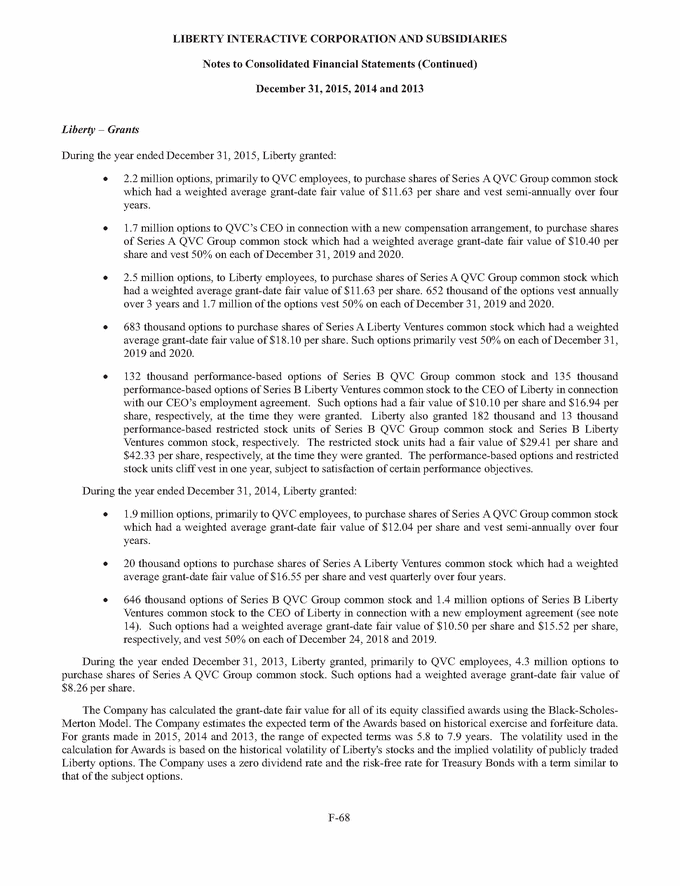
LIBERTY INTERACTIVE CORPORATION AND SUBSIDIARIES Notes to Consolidated Financial Statements (Continued) December 31, 2015, 2014 and 2013 The following table presents the range of volatilities used by Liberty in the Black-Scholes-Merton Model for the 2015, 2014, and 2013 QVC Group and Liberty Ventures grants. Volatility 2015 grants QVC Group options Liberty Ventures options 2014 grants QVC Group options Liberty Ventures options 2013 grants QVC Group options Liberty Ventures options 27.4 30.6 % % - - 39.7 42.4 % % 33.6 41.1 % % - - 39.7 43.7 % % 38.3 43.7 % % - - 38.7 49.9 % % Liberty - Outstanding Awards The following table presents the number and weighted average exercise price ("WAEP") of the Awards to purchase QVC Group and Liberty Ventures common stock granted to certain officers, employees and directors of the Company, as well as the weighted average remaining life and aggregate intrinsic value of the Awards. QVC Group Series A Series B Weighted average remaining life Aggregate intrinsic value (in millions) Weighted average remaining life Aggregate intrinsic value (in millions) Awards (000's) Awards (000's) WAEP WAEP Outstanding at January 1, 2015 zulily acquisition Granted Exercised Forfeited/Cancelled Outstanding at December 31, 2015 Exercisable at December 31, 2015 24,900 7,612 6,406 (6,419) (1,017) 31,482 $ 17.49 $ 16.04 $ 28.06 $ 14.83 $ 25.50 $ 19.57 $ 16.75 1,044 — 132 (398) — 778 $ 24.78 $— $ 29.41 $ 16.51 $— $ 29.79 $— 5.0 years 3.9 years $ $ 261 207 6.0 years — years $ $ — — 19,018 — Liberty Ventures Series A Series B Weighted average remaining life Aggregate intrinsic value (in millions) Weighted average remaining life Aggregate intrinsic value (in millions) Awards (000's) Awards (000's) WAEP WAEP Outstanding at January 1, 2015 Granted Exercised Forfeited/Cancelled Outstanding at December 31, 2015 Exercisable at December 31, 2015 3,997 683 (993) (3) $ 19.10 $ 41.50 $ 18.94 $ 26.62 $ 23.29 $ 18.97 1,507 135 (100) — $ 36.24 $ 42.33 $ 16.82 $— $ 38.04 $— 3,684 4.2 years 3.3 years $ $ 80 75 1,542 6.0 years — years $ $ 11 — 2,876 — As of December 31, 2015, the total unrecognized compensation cost related to unvested Liberty Awards was approximately $113 million. Such amount will be recognized in the Company's consolidated statements of operations over a weighted average period of approximately 2.4 years. F-69
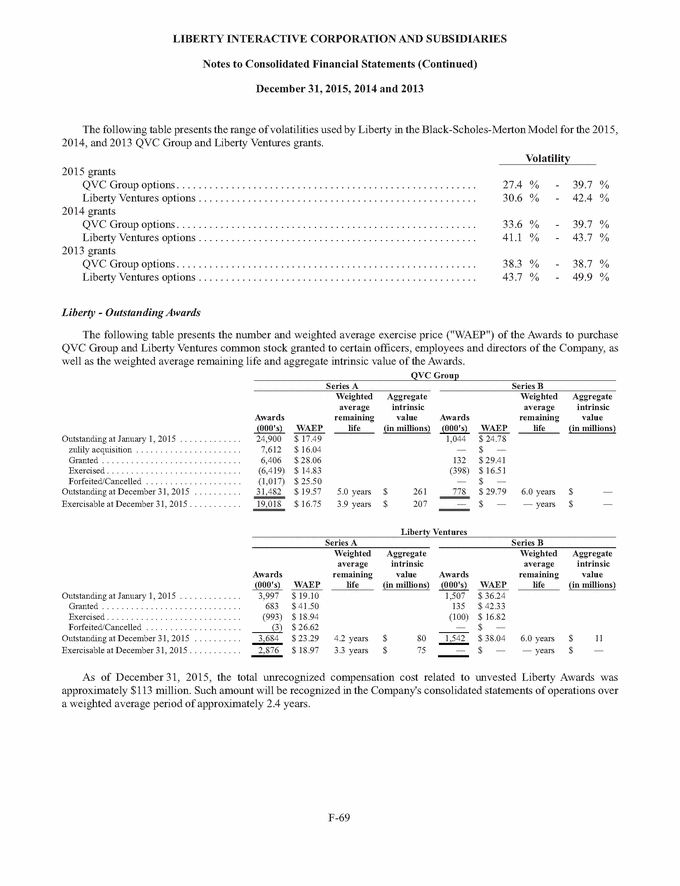
LIBERTY INTERACTIVE CORPORATION AND SUBSIDIARIES Notes to Consolidated Financial Statements (Continued) December 31, 2015, 2014 and 2013 Liberty - Exercises The aggregate intrinsic value of all options exercised during the years ended December 31, 2015, 2014 and 2013 was $115 million, $91 million and $76 million, respectively. Liberty - Restricted Stock The Company had approximately 3 million and 149 thousand unvested restricted shares of QVC Group and Liberty Ventures common stock, respectively, held by certain directors, officers and employees of the Company as of December 31, 2015. These Series A and Series B unvested restricted shares of QVC Group and Liberty Ventures had a weighted average grant date fair value of $24.93 and $9.08 per share, respectively. The aggregate fair value of all restricted shares of Liberty common stock that vested during the years ended December 31, 2015, 2014 and 2013 was $16 million, $19 million and $16 million, respectively. Other Certain of the Company's other subsidiaries have stock-based compensation plans under which employees and non-employees are granted options or similar stock-based awards. Awards made under these plans vest and become exercisable over various terms and are typically cash settled and recorded as liability awards. Stock-based compensation expense related to CommerceHub more than doubled to $51 million during the year ended December 31, 2015. The increase was primarily related to an increase in the fair value of CommerceHub (determined by a valuation based on discounted cash flows and market comparables (level 3)) and the continued vesting of outstanding awards. The awards and compensation recorded, if any, under the plans at the other subsidiaries are not significant to Liberty. (16) Employee Benefit Plans Subsidiaries of Liberty sponsor 401(k) plans, which provide their employees an opportunity to make contributions to a trust for investment in Liberty common stock, as well as other mutual funds. The Company's subsidiaries make matching contributions to their plans based on a percentage of the amount contributed by employees. Employer cash contributions to all plans aggregated $27 million, $27 million and $24 million, respectively, for the years ended December 31, 2015, 2014 and 2013, respectively. (17) Other Comprehensive Earnings (Loss) Accumulated other comprehensive earnings (loss) included in Liberty's consolidated balance sheets and consolidated statements of equity reflect the aggregate of foreign currency translation adjustments, unrealized holding gains and losses on AFS securities and Liberty's share of accumulated other comprehensive earnings of affiliates. F-70
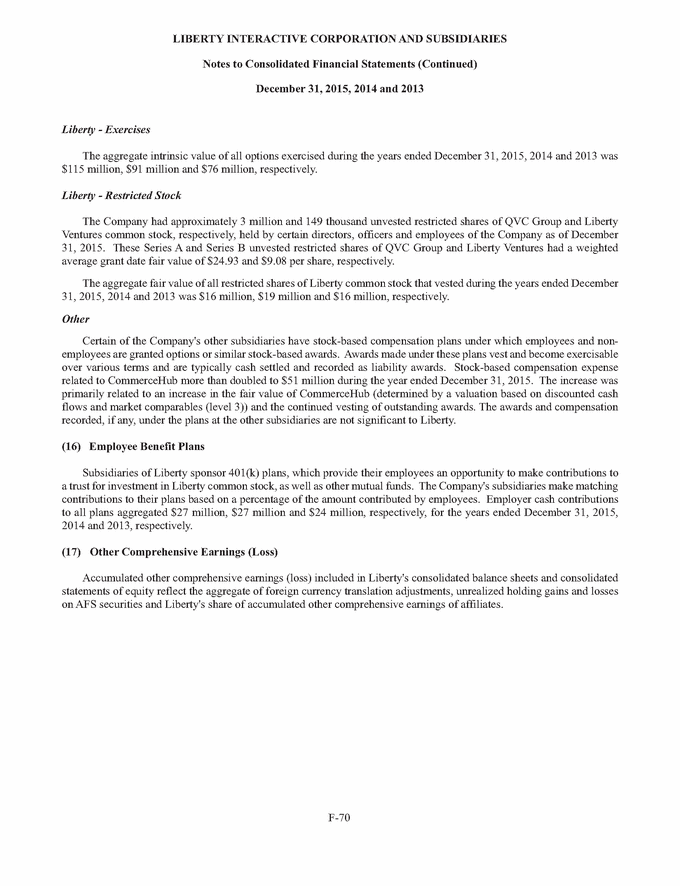
LIBERTY INTERACTIVE CORPORATION AND SUBSIDIARIES Notes to Consolidated Financial Statements (Continued) December 31, 2015, 2014 and 2013 The change in the components of accumulated other comprehensive earnings (loss), net of taxes ("AOCI"), is summarized as follows: Foreign currency translation adjustments Share of AOCI of equity affiliates AOCI of discontinued operations AOCI amounts in millions (3) Balance at January 1, 2013 Other comprehensive earnings (loss) attributable to Liberty Interactive Corporation stockholders Balance at December 31, 2013 Other comprehensive earnings (loss) attributable to Liberty Interactive Corporation stockholders Distribution to stockholders for TripAdvisor Holdings Spin-Off Balance at December 31, 2014 Other comprehensive earnings (loss) attributable to Liberty Interactive Corporation stockholders Balance at December 31, 2015 $ 151 — 148 (48) 2 (3) (49) 103 (1) (3) 99 (178) — (18) — (3) 6 (199) 6 $ (75) (19) — (94) (100) (21) — (121) $ (175) (40) — (215) The components of other comprehensive earnings (loss) are reflected in Liberty's consolidated statements of comprehensive earnings (loss) net of taxes. The following table summarizes the tax effects related to each component of other comprehensive earnings (loss). Tax Before-tax (expense) Net-of-tax amount benefit amount amounts in millions Year ended December 31, 2015: Foreign currency translation adjustments Share of other comprehensive earnings (loss) of equity affiliates Other comprehensive earnings (loss) Year ended December 31, 2014: Foreign currency translation adjustments Share of other comprehensive earnings (loss) of equity affiliates Other comprehensive earnings (loss) from discontinued operations Other comprehensive earnings (loss) Year ended December 31, 2013: Foreign currency translation adjustments Share of other comprehensive earnings (loss) of equity affiliates Other comprehensive earnings (loss) from discontinued operations Other comprehensive earnings (loss) $ (118) (33) 17 12 (101) (21) $ (151) 29 (122) $ (241) (29) (2) 49 11 1 (192) (18) (1) $ (272) 61 (211) $ (65) 3 (5) (8) (1) 2 (73) 2 (3) $ (67) (7) (74) F-71
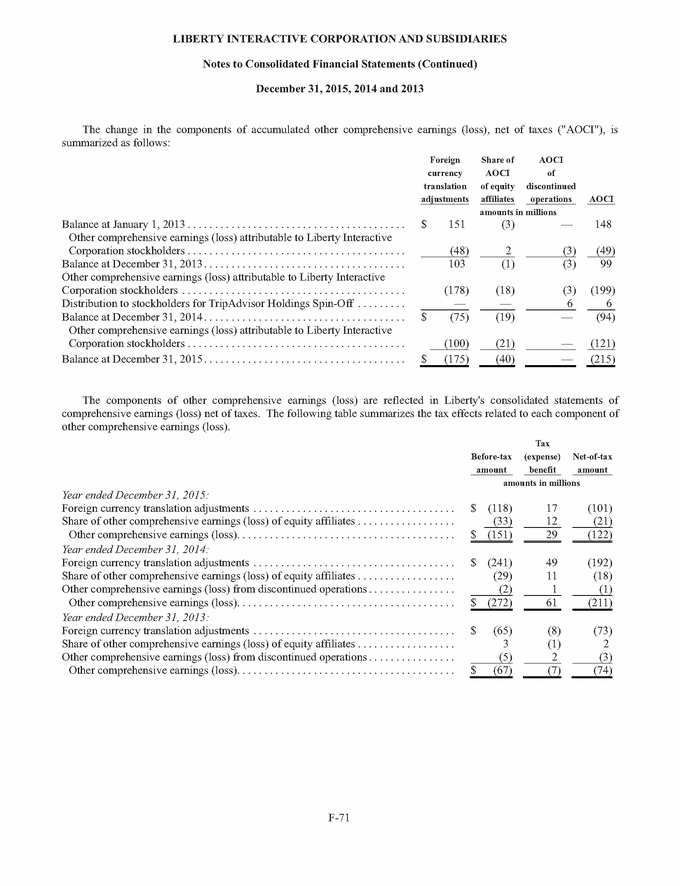
LIBERTY INTERACTIVE CORPORATION AND SUBSIDIARIES Notes to Consolidated Financial Statements (Continued) December 31, 2015, 2014 and 2013 (18) Commitments and Contingencies Operating Leases Liberty leases business offices, has entered into satellite transponder lease agreements and uses certain equipment under lease arrangements. Rental expense under such arrangements amounted to $39 million, $47 million and $50 million for the years ended December 31, 2015, 2014 and 2013, respectively. A summary of future minimum lease payments under noncancelable operating leases and build to suit leases as of December 31, 2015 follows (amounts in millions): Years ending December 31: 2016 $ 2017 $ 2018 $ 2019 $ 2020 $ Thereafter $ 41 43 41 37 34 210 It is expected that in the normal course of business, leases that expire generally will be renewed or replaced by leases on other properties; thus, it is anticipated that future lease commitments will not be less than the amount shown for 2015. Litigation Liberty has contingent liabilities related to legal and tax proceedings and other matters arising in the ordinary course of business. Although it is reasonably possible Liberty may incur losses upon conclusion of such matters, an estimate of any loss or range of loss cannot be made. In the opinion of management, it is expected that amounts, if any, which may be required to satisfy such contingencies will not be material in relation to the accompanying consolidated financial statements. (19) Information About Liberty's Operating Segments Liberty, through its ownership interests in subsidiaries and other companies, is primarily engaged in the video and on-line commerce industries. Liberty identifies its reportable segments as (A) those consolidated subsidiaries that represent 10% or more of its consolidated annual revenue, annual Adjusted OIBDA or total assets and (B) those equity method affiliates whose share of earnings represent 10% or more of Liberty's annual pre-tax earnings. The segment presentation for prior periods has been conformed to the current period segment presentation. Liberty evaluates performance and makes decisions about allocating resources to its operating segments based on financial measures such as revenue, Adjusted OIBDA, gross margin, average sales price per unit, number of units shipped and revenue or sales per customer equivalent. In addition, Liberty reviews nonfinancial measures such as unique website visitors, conversion rates and active customers, as appropriate. Liberty defines Adjusted OIBDA as revenue less cost of sales, operating expenses, and selling, general and administrative expenses (excluding stock-based compensation). Liberty believes this measure is an important indicator of the operational strength and performance of its businesses, including each business's ability to service debt and fund capital expenditures. In addition, this measure allows management to view operating results and perform analytical comparisons and benchmarking between businesses and identify strategies to improve performance. This measure of performance excludes depreciation and amortization, stock-based compensation, certain purchase accounting adjustments, separately F-72
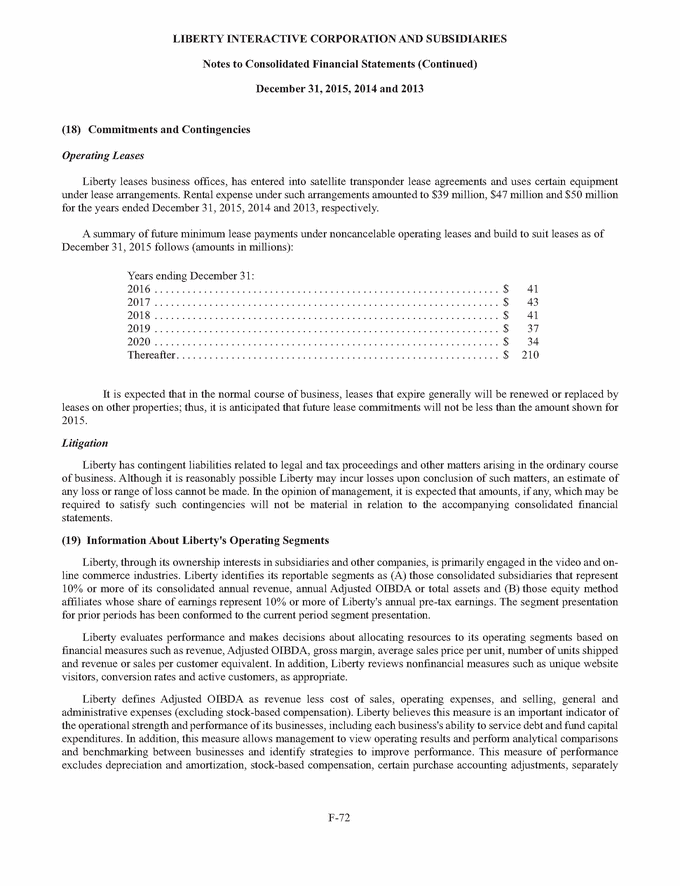
LIBERTY INTERACTIVE CORPORATION AND SUBSIDIARIES Notes to Consolidated Financial Statements (Continued) December 31, 2015, 2014 and 2013 reported litigation settlements and restructuring and impairment charges that are included in the measurement of operating income pursuant to GAAP. Accordingly, Adjusted OIBDA should be considered in addition to, but not as a substitute for, operating income, net income, cash flow provided by operating activities and other measures of financial performance prepared in accordance with GAAP. Liberty generally accounts for intersegment sales and transfers as if the sales or transfers were to third parties, that is, at current prices. For the year ended December 31, 2015, Liberty has identified the following consolidated subsidiaries as its reportable segments: • QVC—consolidated subsidiary that markets and sells a wide variety of consumer products in the United States and several foreign countries, primarily by means of its televised shopping programs and via the Internet and mobile transactions through its domestic and international websites. zulily – consolidated subsidiary that markets and sells unique products in the United States and several foreign countries through flash sales events, primarily through its desktop and mobile websites and mobile applications. • In prior years, Liberty voluntarily provided financial information for the Digital Commerce businesses on an aggregated basis. Due to the sale of Provide and Backcountry and due to Liberty’s announced intention to pursue a plan to spin-off Bodybuilding and CommerceHub (as described in note 1), Liberty no longer provides separate financial information for the Digital Commerce businesses. The Digital Commerce businesses are now included in Corporate and other. Liberty's operating segments are strategic business units that offer different products and services. They are managed separately because each segment requires different technologies, distribution channels and marketing strategies. The accounting policies of the segments that are also consolidated subsidiaries are the same as those described in the Company's summary of significant accounting policies. Performance Measures Years ended December 31, 2015 2014 2013 Adjusted OIBDA Adjusted Revenue OIBDA Adjusted OIBDA Revenue Revenue amounts in millions QVC Group QVC zulily Corporate and other (1) Total QVC Group Ventures Group Corporate and other (1) Total Ventures Group Consolidated Liberty $ 8,743 426 — 1,894 21 (28) 8,801 NA 1,227 1,910 NA 29 8,623 NA 1,596 1,841 NA 83 9,169 1,887 10,028 1,939 10,219 1,924 820 59 471 26 — (11) 820 59 471 26 — (11) $ 9,989 1,946 10,499 1,965 10,219 1,913 (1) As discussed in note 2, on October 3, 2014, Liberty completed the reattribution from the QVC Group (formerly referred to as the Interactive Group, prior to the reattribution), to the Ventures Group its Digital Commerce companies. The reattribution of the Digital Commerce companies is presented on a prospective basis from the date of the reattribution in Liberty’s consolidated financial statements, with October 1, 2014 used as a proxy for the date of the reattribution. Accordingly, Revenue and Adjusted OIBDA attributable to the Digital Commerce companies are included in the QVC Group for the period through September 30, 2014 and are included in the Ventures Group for the period beginning October 1, 2014. F-73
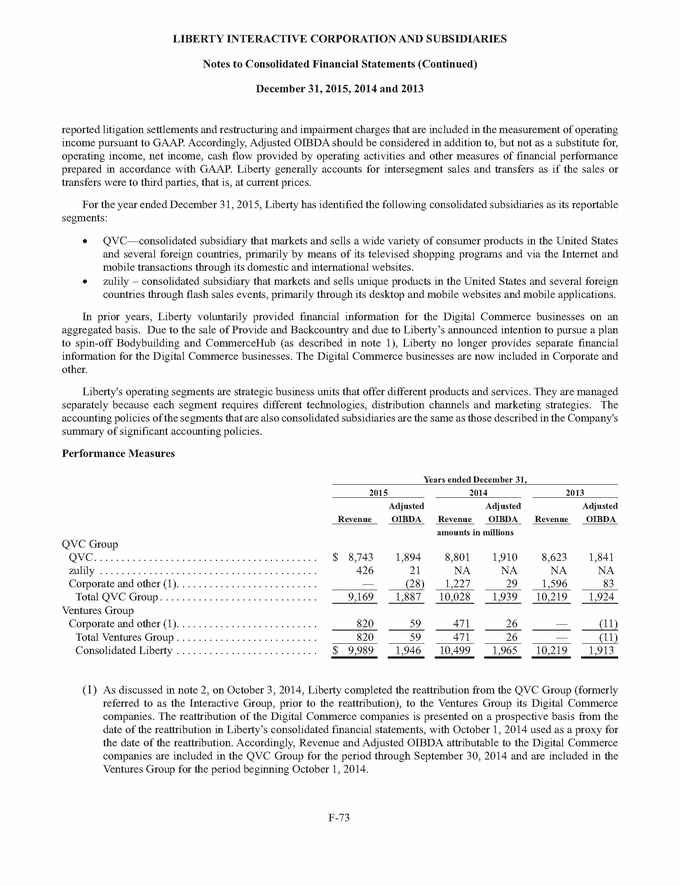
LIBERTY INTERACTIVE CORPORATION AND SUBSIDIARIES Notes to Consolidated Financial Statements (Continued) December 31, 2015, 2014 and 2013 Other Information December 31, 2015 December 31, 2014 Investments in affiliates Investments in affiliates Total assets Capital expenditures Total assets Capital expenditures amounts in millions QVC Group QVC zulily Corporate and other Total QVC Group Ventures Group Corporate and other Total Ventures Group Consolidated Liberty $ 12,058 2,741 342 43 — 165 215 3 — 12,226 NA 544 47 NA 328 183 NA 43 15,141 208 218 12,770 375 226 6,039 1,433 40 5,828 1,258 15 6,039 1,433 40 5,828 1,258 15 $ 21,180 1,641 258 18,598 1,633 241 The following table provides a reconciliation of segment Adjusted OIBDA to earnings (loss) from continuing operations before income taxes: Years ended December 31, 2015 2014 2013 amounts in millions Consolidated segment Adjusted OIBDA Stock-based compensation Depreciation and amortization Impairment of intangible assets Interest expense Share of earnings (loss) of affiliates, net Realized and unrealized gains (losses) on financial instruments, net. Gains (losses) on transactions, net Gains (losses) on dilution of investments in affiliates. Other, net Earnings (loss) from continuing operations before income taxes $ 1,946 (127) (703) — (360) (60) 114 110 314 19 1,965 (108) (662) (7) (387) 39 (57) 74 (2) (19) 1,913 (118) (629) (30) (380) 33 (22) (1) 1 (30) $ 1,253 836 737 F-74
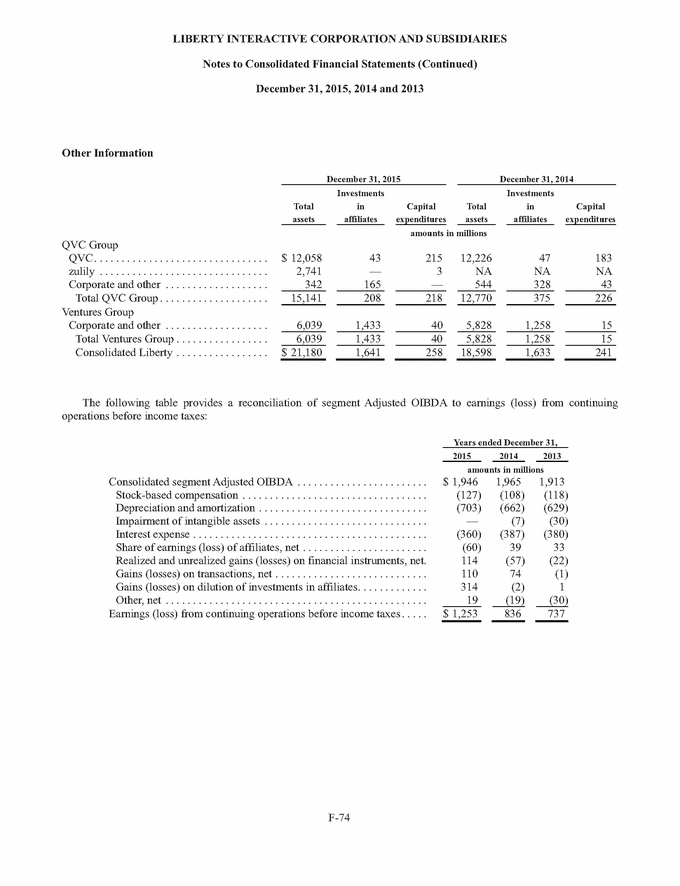
LIBERTY INTERACTIVE CORPORATION AND SUBSIDIARIES Notes to Consolidated Financial Statements (Continued) December 31, 2015, 2014 and 2013 Revenue by Geographic Area Revenue by geographic area based on the location of customers is as follows: Years ended December 31, 2015 2014 2013 amounts in millions 7,617 912 1,003 United States Japan Germany Other foreign countries $ 7,412 811 850 916 7,332 1,029 971 887 967 $ 9,989 10,499 10,219 Long-lived Assets by Geographic Area December 31, 2015 2014 amounts in millions United States Japan Germany Other foreign countries $ 637 156 173 174 529 176 210 178 $ 1,140 1,093 F-75
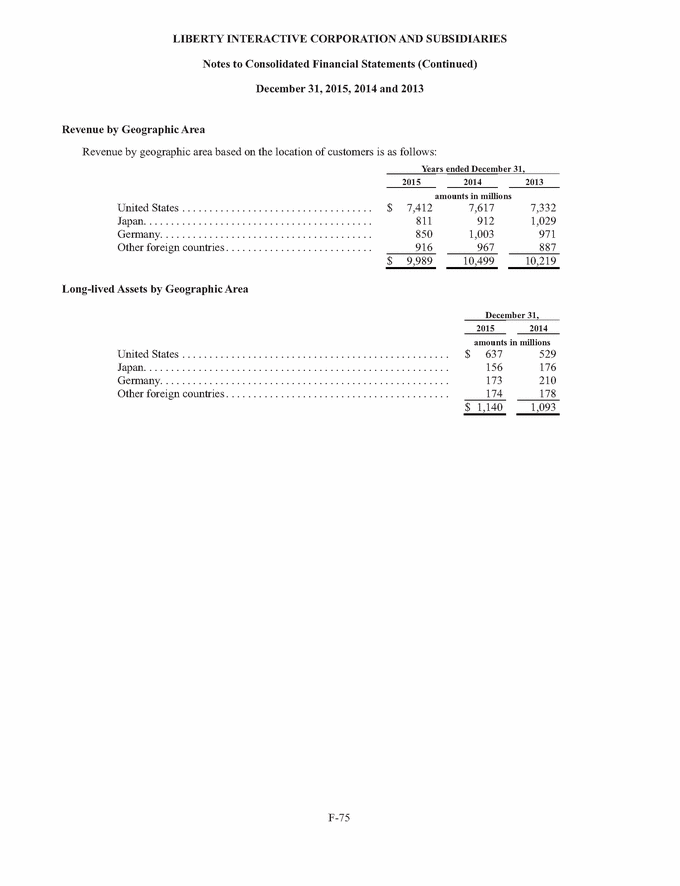
LIBERTY INTERACTIVE CORPORATION AND SUBSIDIARIES Notes to Consolidated Financial Statements (Continued) December 31, 2015, 2014 and 2013 (20) Quarterly Financial Information (Unaudited) 1st 2nd 3rd 4th Quarter Quarter Quarter Quarter amounts in millions, except per share amounts 2015: Revenue Operating income Earnings from continuing operations. Net earnings (loss) attributable to Liberty Interactive Corporation stockholders: Series A and Series B QVC Group common stock Series A and Series B Liberty Ventures common stock Basic net earnings (loss) from continuing operations attributable to Liberty Interactive Corporation stockholders per common share: Series A and Series B QVC Group common stock Series A and Series B Liberty Ventures common stock Diluted net earnings (loss) from continuing operations attributable to Liberty Interactive Corporation stockholders per common share: Series A and Series B QVC Group common stock Series A and Series B Liberty Ventures common stock Basic net earnings (loss) attributable to Liberty Interactive Corporation stockholders per common share: Series A and Series B QVC Group common stock Series A and Series B Liberty Ventures common stock Diluted net earnings (loss) attributable to Liberty Interactive Corporation stockholders per common share: Series A and Series B QVC Group common stock Series A and Series B Liberty Ventures common stock $ $ $ 2,214 236 152 2,252 269 258 2,153 247 198 3,370 364 303 $ $ 151 (8) 112 130 154 36 223 71 $ $ 0.32 (0.06) 0.24 0.92 0.33 0.26 0.45 0.50 $ $ 0.31 (0.06) 0.24 0.91 0.33 0.25 0.44 0.50 $ $ 0.32 (0.06) 0.24 0.92 0.33 0.26 0.45 0.50 $ $ 0.31 (0.06) 0.24 0.91 0.33 0.25 0.44 0.50 F-76
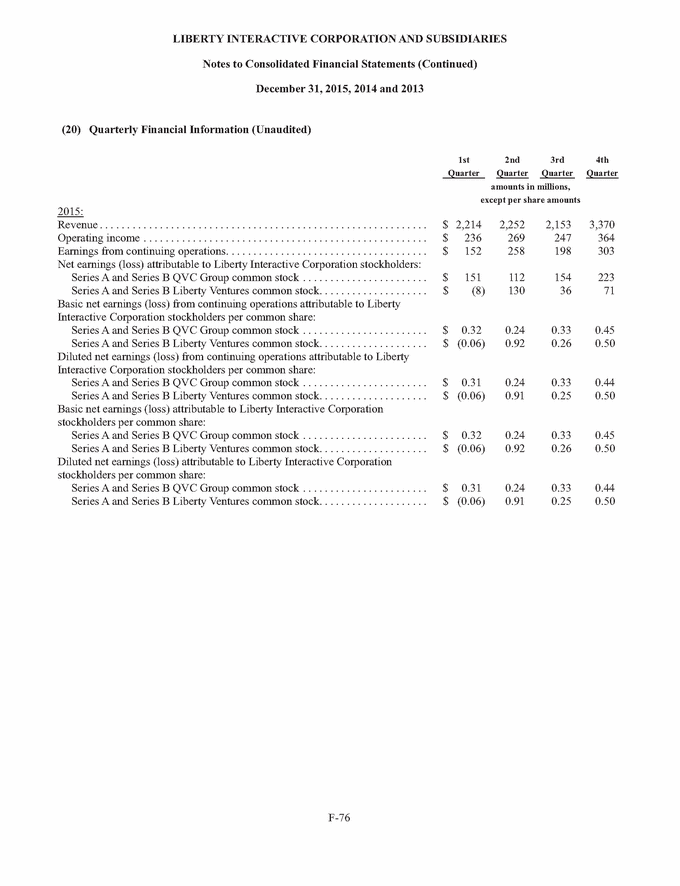
LIBERTY INTERACTIVE CORPORATION AND SUBSIDIARIES Notes to Consolidated Financial Statements (Continued) December 31, 2015, 2014 and 2013 1st 2nd 3rd 4th Quarter Quarter Quarter Quarter amounts in millions, except per share amounts 2014: Revenue Operating income Earnings from continuing operations Net earnings (loss) attributable to Liberty Interactive Corporation stockholders: Series A and Series B QVC Group common stock Series A and Series B Liberty Ventures common stock Basic net earnings (loss) from continuing operations attributable to Liberty Interactive Corporation stockholders per common share: Series A and Series B QVC Group common stock Series A and Series B Liberty Ventures common stock Diluted net earnings (loss) from continuing operations attributable to Liberty Interactive Corporation stockholders per common share: Series A and Series B QVC Group common stock Series A and Series B Liberty Ventures common stock Basic net earnings (loss) attributable to Liberty Interactive Corporation stockholders per common share: Series A and Series B QVC Group common stock Series A and Series B Liberty Ventures common stock Diluted net earnings (loss) attributable to Liberty Interactive Corporation stockholders per common share: Series A and Series B QVC Group common stock Series A and Series B Liberty Ventures common stock $ $ $ 2,434 246 91 2,483 259 87 2,330 239 129 3,252 444 271 $ $ 110 (28) 105 (28) 83 37 222 36 $ $ 0.23 (0.45) 0.23 (0.47) 0.18 0.47 0.47 0.28 $ $ 0.23 (0.45) 0.23 (0.47) 0.18 0.46 0.46 0.28 $ $ 0.22 (0.38) 0.22 (0.38) 0.17 0.51 0.47 0.28 $ $ 0.22 (0.38) 0.21 (0.38) 0.17 0.50 0.46 0.28 F-77
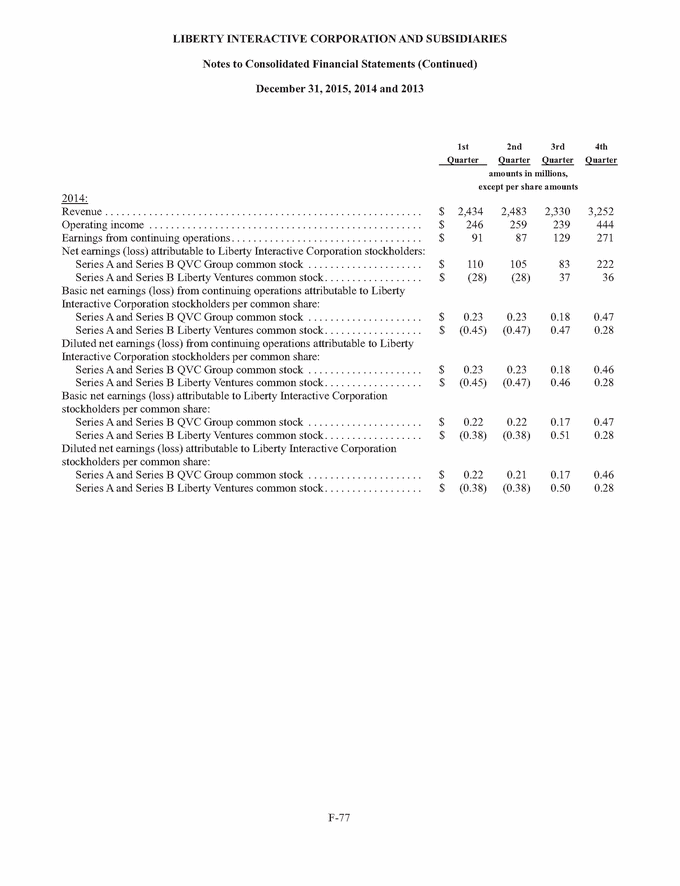
Unaudited Attributed Financial Information for Tracking Stock Groups Our QVC Group common stock is intended to reflect the separate performance of our QVC Group, which, subsequent to the reattribution, is comprised of our subsidiaries, QVC, Inc. (“QVC”) and zulily (defined below) (as of October 1, 2015), and our interest in HSN, Inc. Our Liberty Ventures common stock is intended to reflect the separate performance of our Ventures Group which, subsequent to the reattribution, consists of our on-line commerce businesses, Bodybuilding.com, LLC ("Bodybuilding"), CommerceHub, Evite, Inc. (“Evite”), Provide Commerce, Inc. (“Provide”) (through December 31, 2014) and Backcountry.com, Inc. ("Backcountry") (through June 30, 2015) (collectively, the “Digital Commerce” companies), and our interest in equity method investments of Expedia, Inc., FTD Companies, Inc. (“FTD”), Interval Leisure Group, Inc. and LendingTree, Inc. (“LendingTree”), and available-for-sale securities Time Warner, Time Warner Cable and AOL. As discussed in note 2 to the accompanying consolidated financial statements, on October 3, 2014, the QVC Group (referred to as the “Interactive Group” prior to the reattribution) attributed to the Ventures Group its Digital Commerce businesses, which were valued at $1.5 billion, and approximately $1 billion in cash. In connection with the reattribution, each holder of Liberty Interactive common stock received 0.14217 of a share of the corresponding series of Liberty Ventures common stock for each share of Liberty Interactive common stock held as of the record date, with cash paid in lieu of fractional shares. The distribution date for the dividend was on October 20, 2014, and the Liberty Interactive common stock began trading ex-dividend on October 15, 2014. The Interactive Group is referred to as the QVC Group subsequent to the reattribution. The reattribution of the Digital Commerce companies is presented on a prospective basis from the date of the reattribution in Liberty’s consolidated financial statements, with October 1, 2014 used as a proxy for the date of the reattribution. Additionally, as discussed in note 6 and note 9 of the accompanying consolidated financial statements, Liberty’s former wholly-owned subsidiary, Provide, was sold to FTD on December 31, 2014, in exchange for cash and shares of FTD common stock representing approximately 35% of the combined company. Subsequent to completion of the transaction, Liberty accounts for FTD as an equity-method affiliate based on the ownership level and board representation. Given our significant continuing involvement with FTD, Provide is not presented as a discontinued operation in the consolidated financial statements of Liberty. As discussed in note 6 of the accompanying consolidated financial statements, Liberty sold Backcountry, a Digital Commerce company attributed to the Ventures Group, on June 30, 2015. Backcountry is not presented as a discontinued operation as the sale did not represent a strategic shift that has a major effect on Liberty’s operations and financial results. As discussed in note 5 of the accompanying consolidated financial statements, on October 1, 2015, Liberty acquired all of the outstanding shares of zulily, inc. (“zulily”) (now known as zulily, llc) for consideration of approximately $2.3 billion. zulily is an online retailer offering customers a fun and entertaining shopping experience with a fresh selection of new product styles launched each day. zulily is attributed to the QVC Group. The following tables present our assets and liabilities as of December 31, 2015 and 2014 and revenue, expenses and cash flows for the three years ended December 31, 2015, 2014 and 2013. The earnings attributed to the QVC Group and Ventures Group for purposes of those financial statements only relate to the period after the tracking stocks were issued. The financial information in this Exhibit should be read in conjunction with our consolidated financial statements for the year ended December 31, 2015 included in this Annual Report on Form 10-K. Notwithstanding the following attribution of assets, liabilities, revenue, expenses and cash flows to the QVC Group and the Ventures Group, our tracking stock structure does not affect the ownership or the respective legal title to our assets or responsibility for our liabilities. We and our subsidiaries are each responsible for our respective liabilities. Holders of QVC Group common stock and Liberty Ventures common stock are holders of our common stock and are subject to risks associated with an investment in our company and all of our businesses, assets and liabilities. The issuance of QVC Group common stock and Liberty Ventures common stock does not affect the rights of our creditors or creditors of our subsidiaries. F-78
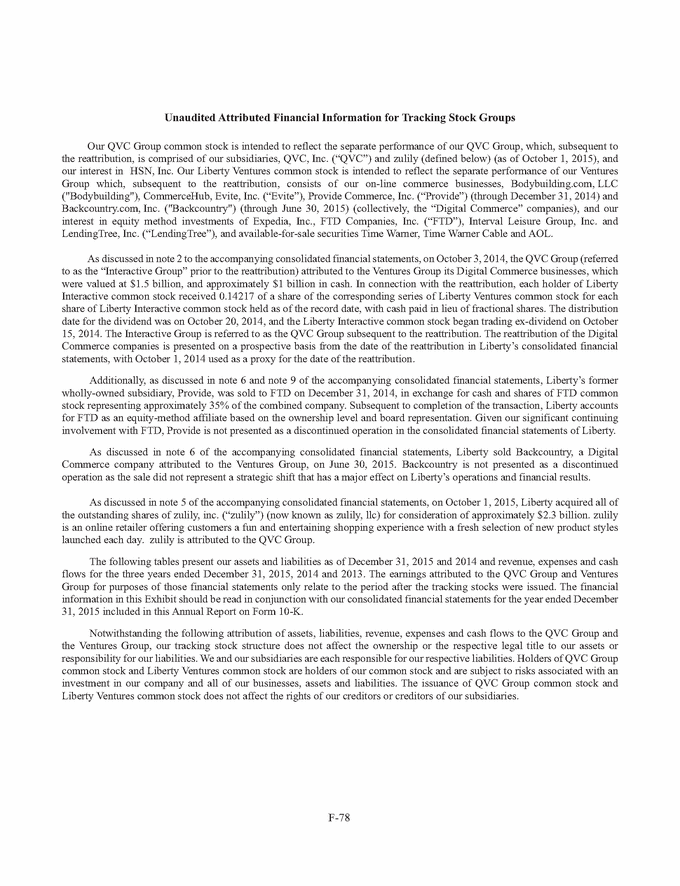
SUMMARY ATTRIBUTED FINANCIAL DATA QVC Group December 31, 2015 December 31, 2014 amounts in millions Summary balance sheet data: Current assets Investments in affiliates, accounted for using the equity method Intangible assets not subject to amortization, net Total assets Long-term debt, including current portion Deferred tax liabilities Attributed net assets $ $ $ $ $ $ $ 2,827 208 9,358 15,141 6,535 1,359 5,195 2,584 375 7,634 12,770 5,817 834 4,280 Years ended December 31, 2015 2014 2013 amounts in millions Summary operations data: Revenue Cost of sales Operating expenses Selling, general and administrative expenses (1) Depreciation and amortization Impairment of intangible assets Operating income (loss) Interest expense Share of earnings (losses) of affiliates, net Realized and unrealized gains (losses) on financial instruments, net Gains (losses) on transactions, net Gains (losses) on dilution of investments in affiliates (note 3) Other income (expense), net Income tax benefit (expense) Earnings (loss) from continuing operations Earnings (loss) from discontinued operations, net of taxes Net earnings (loss) Less net earnings (loss) attributable to noncontrolling interests Net earnings (loss) attributable to Liberty Interactive Corporation shareholders $ 9,169 (5,847) (620) (875) (657) — 10,028 (6,378) (719) (1,075) (643) (7) 10,219 (6,533) (732) (1,140) (629) (30) 1,170 (283) 55 42 — — (6) (304) 1,206 (312) 51 (22) — (2) (41) (306) 1,155 (290) 48 (12) (1) 4 (58) (346) 674 — 574 (15) 500 (17) 674 34 559 39 483 45 $ 640 520 438 (1) Includes stock-based compensation of $60 million, $83 million and $110 million for the years ended December 31, 2015, 2014 and 2013, respectively. F-79
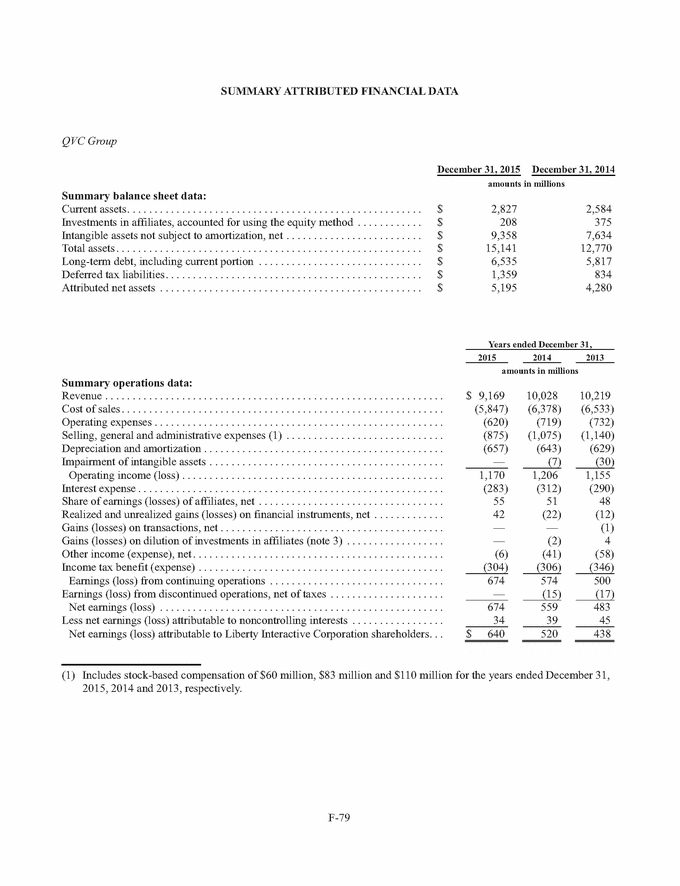
SUMMARY ATTRIBUTED FINANCIAL DATA (Continued) Ventures Group December 31, 2015 December 31, 2014 amounts in millions Summary balance sheet data: Cash and cash equivalents Short term marketable securities Investments in available-for-sale securities and other cost investments Investments in affiliates, accounted for using the equity method Intangible assets not subject to amortization, net Long-term debt, including current portion Deferred tax liabilities Attributed net assets (liabilities) $ $ $ $ $ $ $ $ 2,023 898 1,349 1,433 127 2,172 2,143 1,592 1,884 868 1,220 1,258 259 2,191 1,987 1,393 Years ended December 31, 2015 2014 2013 amounts in millions Summary operations data: Revenue Cost of sales Operating expenses Selling, general and administrative expenses (1) Depreciation and amortization Operating income (loss) Interest expense Share of earnings (losses) of affiliates, net Realized and unrealized gains (losses) on financial instruments, net Gains (losses) on transactions, net Gains (losses) on dilution of investments in affiliates (note 3) Other, net Income tax benefit (expense) Earnings (loss) from continuing operations Earnings (loss) from discontinued operations, net of taxes Net earnings (loss) Less net earnings (loss) attributable to noncontrolling interests Net earnings (loss) attributable to Liberty Interactive Corporation shareholders $ 820 (546) (79) (203) (46) 471 (306) (37) (127) (19) — — — (19) — (54) (77) (115) 72 110 314 25 (38) (18) (75) (12) (35) 74 — 22 48 (19) (90) (15) (10) — (3) 28 163 237 — 4 63 54 43 237 8 67 50 97 34 $ 229 17 63 (1) Includes stock-based compensation of $67 million, $25 million and $8 million for the years ended December 31, 2015, 2014 and 2013, respectively. F-80
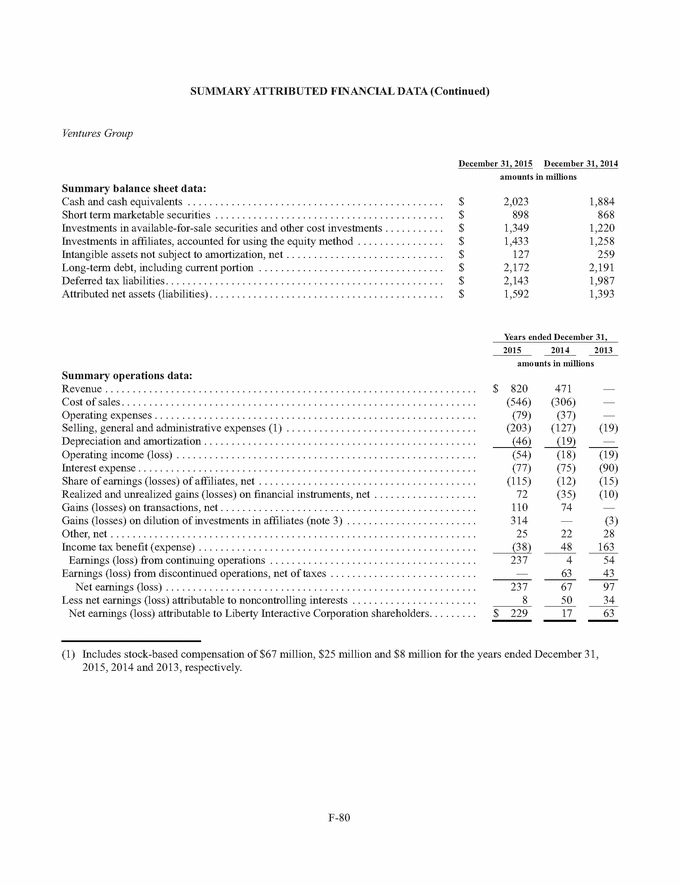
BALANCE SHEET INFORMATION December 31, 2015 (unaudited) Attributed (note 1) QVC Ventures Consolidated Group Group Liberty amounts in millions Assets Current assets: Cash and cash equivalents Trade and other receivables, net. Inventory, net. Short-term marketable securities Other current assets Total current assets Investments in available-for-sale securities and other cost investments (note 2) Investments in affiliates, accounted for using the equity method (note 3) Property and equipment, net Intangible assets not subject to amortization, net Intangible assets subject to amortization, net Other assets, at cost, net of accumulated amortization Total assets Liabilities and Equity Current liabilities: Intergroup payable (receivable) Accounts payable Accrued liabilities Current portion of debt (note 4) Other current liabilities Total current liabilities Long-term debt (note 4) Deferred income tax liabilities Other liabilities Total liabilities Equity/Attributed net assets (liabilities) Noncontrolling interests in equity of subsidiaries Total liabilities and equity $ 426 1,379 945 12 2,023 64 55 898 8 2,449 1,443 1,000 910 73 65 2,827 3,048 5,875 4 208 1,104 9,358 1,607 33 1,349 1,433 36 127 40 6 1,353 1,641 1,140 9,485 1,647 39 $ 15,141 6,039 21,180 $ 45 736 745 358 (45) 26 39 868 109 — 762 784 1,226 328 219 2,103 997 3,100 6,177 1,359 209 1,304 2,143 13 7,481 3,502 222 9,848 5,195 98 4,457 1,592 (10) 14,305 6,787 88 $ 15,141 6,039 21,180 F-81
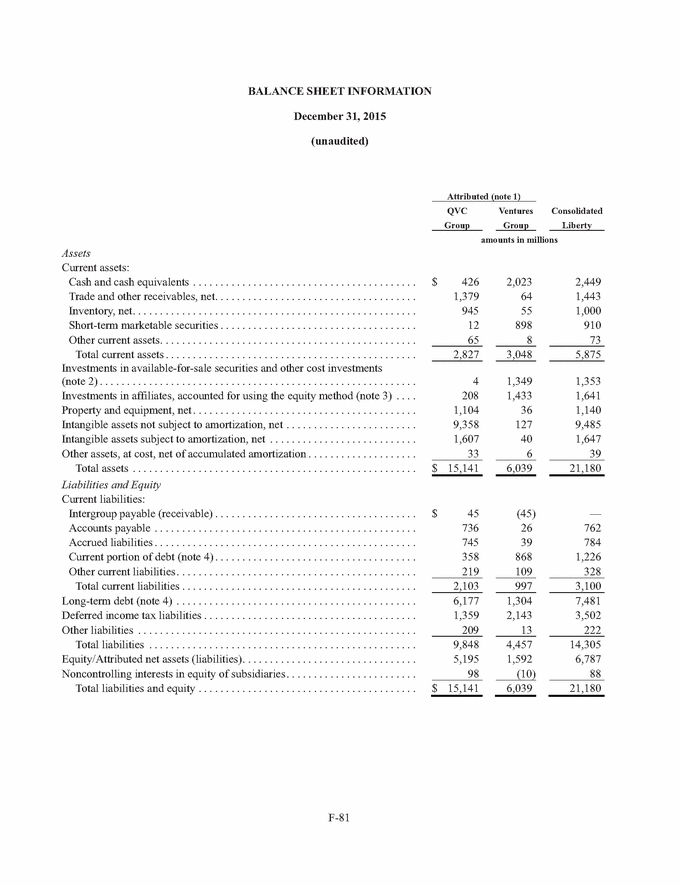
BALANCE SHEET INFORMATION December 31, 2014 (unaudited) Attributed (note 1) QVC Group Ventures Group Consolidated Liberty amounts in millions Assets Current assets: Cash and cash equivalents Trade and other receivables, net Inventory, net Short-term marketable securities Other current assets Total current assets Investments in available-for-sale securities and other cost investments (note 2) Investments in affiliates, accounted for using the equity method (note 3) Property and equipment, net Intangible assets not subject to amortization, net Intangible assets subject to amortization, net Other assets, at cost, net of accumulated amortization Total assets Liabilities and Equity Current liabilities: Intergroup payable (receivable) Accounts payable Accrued liabilities Current portion of debt (note 4) Other current liabilities Total current liabilities Long-term debt (note 4) Deferred income tax liabilities Other liabilities Total liabilities Equity/Attributed net assets (liabilities) Noncontrolling interests in equity of subsidiaries Total liabilities and equity $ 422 1,196 882 21 1,884 36 167 868 9 2,306 1,232 1,049 889 72 63 2,584 2,964 5,548 4 375 1,026 7,634 1,130 17 1,220 1,258 67 259 55 5 1,224 1,633 1,093 7,893 1,185 22 $ 12,770 5,828 18,598 $ (5) 629 688 9 5 106 55 937 74 — 735 743 946 343 269 1,590 1,177 2,767 5,808 834 157 1,254 1,987 11 7,062 2,821 168 8,389 4,429 12,818 4,280 101 1,393 6 5,673 107 $ 12,770 5,828 18,598 F-82
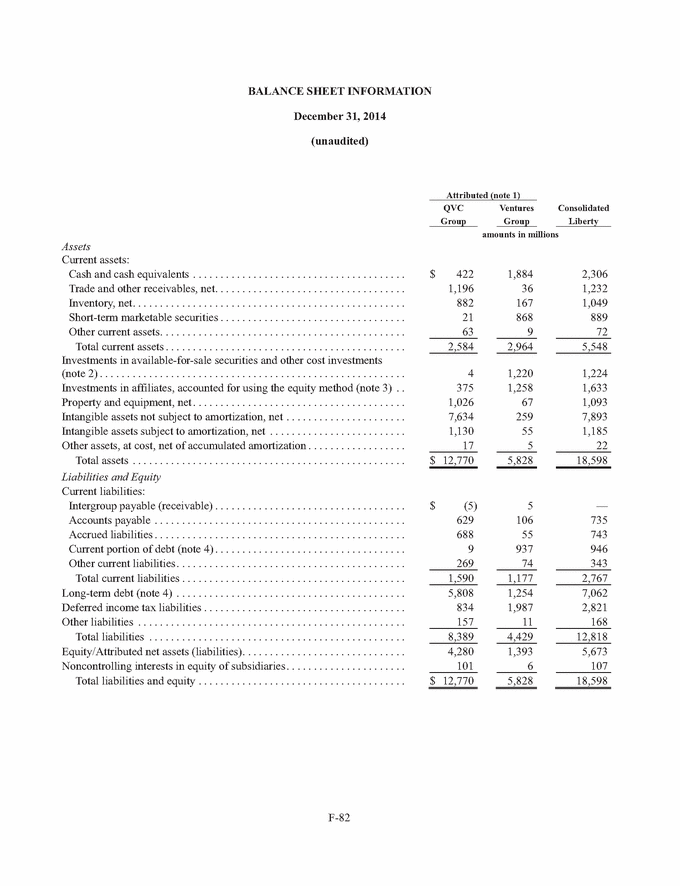
STATEMENT OF OPERATIONS INFORMATION Year ended December 31, 2015 (unaudited) Attributed (note 1) Consolidated Liberty QVC Group Ventures Group amounts in millions 820 Total revenue, net Operating costs and expenses: Cost of retail sales (exclusive of depreciation shown separately below) Operating Selling, general and administrative, including stock-based compensation (note 5). Depreciation and amortization $ 9,169 9,989 5,847 620 546 79 6,393 699 875 657 203 46 1,078 703 7,999 874 8,873 Operating income (loss) Other income (expense): Interest expense Share of earnings (losses) of affiliates, net (note 3) Realized and unrealized gains (losses) on financial instruments, net Gains (losses) on transactions, net Gains (losses) on dilution of investments in affiliates (note 3) Other, net 1,170 (54) 1,116 (283) 55 42 — — (6) (77) (115) 72 110 314 25 (360) (60) 114 110 314 19 (192) 329 137 Earnings (loss) from continuing operations before income taxes Income tax benefit (expense) Net earnings (loss) Less net earnings (loss) attributable to noncontrolling interests Net earnings (loss) attributable to Liberty Interactive Corporation shareholders 978 (304) 275 (38) 1,253 (342) 674 34 237 8 911 42 $ 640 229 869 F-83
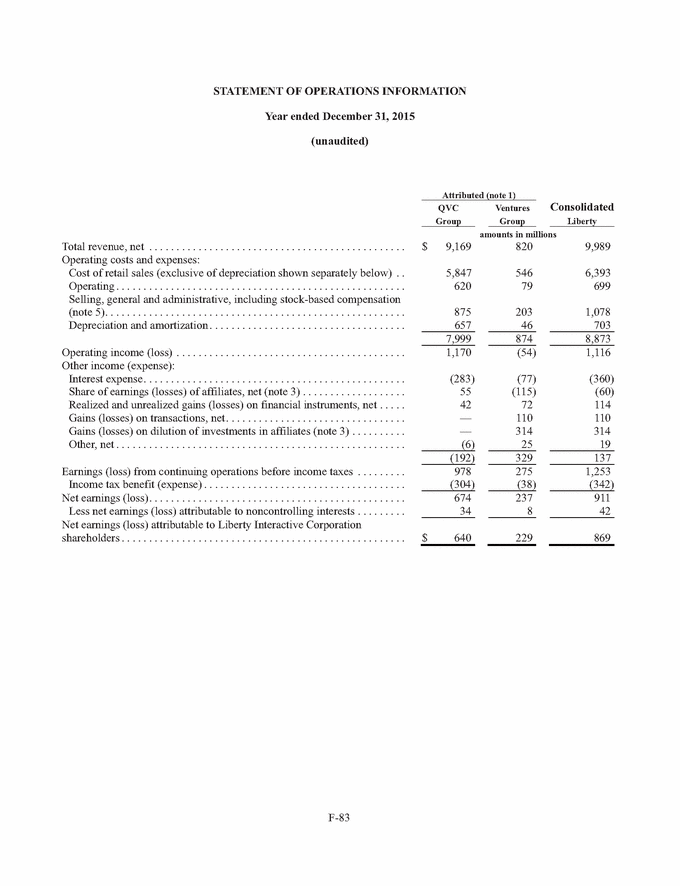
STATEMENT OF OPERATIONS INFORMATION Year ended December 31, 2014 (unaudited) Attributed (note 1) Consolidated QVC Group Ventures Group Liberty amounts in millions 471 Total revenue, net Operating costs and expenses: Cost of retail sales (exclusive of depreciation shown separately below) Operating Selling, general and administrative, including stock-based compensation (note 5). Depreciation and amortization Impairment of intangible assets $ 10,028 10,499 6,378 719 306 37 6,684 756 1,075 643 7 127 19 — 1,202 662 7 8,822 489 9,311 Operating income (loss) Other income (expense): Interest expense Share of earnings (losses) of affiliates, net (note 3) Realized and unrealized gains (losses) on financial instruments, net Gains (losses) on transactions, net Gains (losses) on dilution of investments in affiliates (note 3) Other, net 1,206 (18) 1,188 (312) 51 (22) — (2) (41) (75) (12) (35) 74 — 22 (387) 39 (57) 74 (2) (19) (326) (26) (352) Earnings (loss) from continuing operations before income taxes Income tax benefit (expense) Earnings (loss) from continuing operations, net of taxes Earnings (loss) from discontinued operations, net of taxes Net earnings (loss) Less net earnings (loss) attributable to noncontrolling interests Net earnings (loss) attributable to Liberty Interactive Corporation shareholders 880 (306) (44) 48 836 (258) 574 (15) 4 63 578 48 559 67 626 39 50 89 $ 520 17 537 F-84
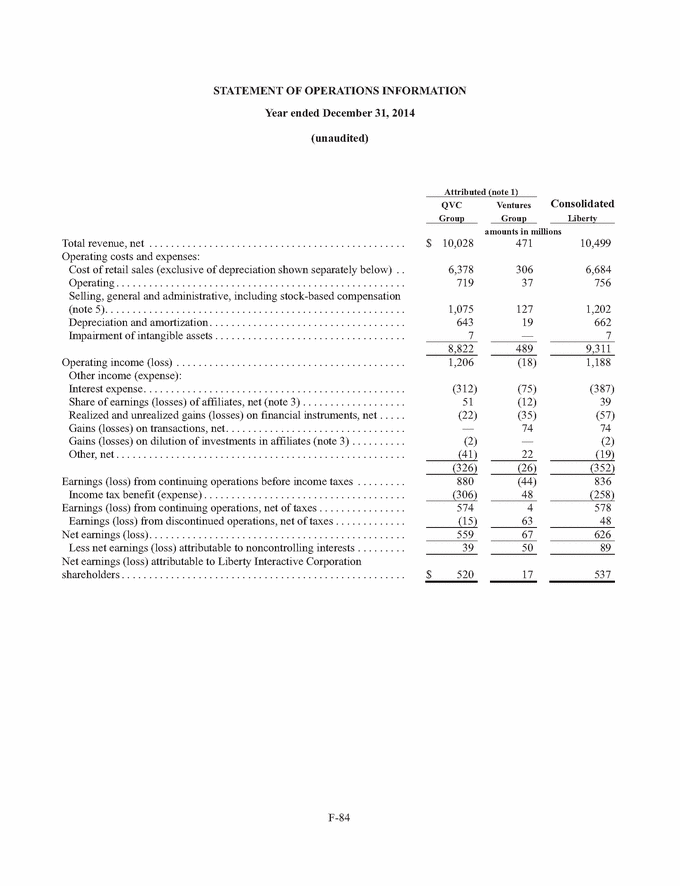
STATEMENT OF OPERATIONS INFORMATION Year ended December 31, 2013 (unaudited) Attributed (note 1) Consolidated Liberty QVC Group Ventures Group amounts in millions — Total revenue, net Operating costs and expenses: Cost of retail sales (exclusive of depreciation shown separately below) Operating Selling, general and administrative, including stock-based compensation (note 5). Depreciation and amortization Impairment of intangible assets $ 10,219 10,219 6,533 732 — — 6,533 732 1,140 629 30 19 — — 1,159 629 30 9,064 19 9,083 Operating income (loss) Other income (expense): Interest expense Share of earnings (losses) of affiliates, net (note 3) Realized and unrealized gains (losses) on financial instruments, net Gains (losses) on transactions, net Gains (losses) on dilution of investments in affiliates (note 3) Other, net 1,155 (19) 1,136 (290) 48 (12) (1) 4 (58) (90) (15) (10) — (3) 28 (380) 33 (22) (1) 1 (30) (309) (90) (399) Earnings (loss) before income taxes Income tax benefit (expense) Earnings (loss) from continuing operations Earnings (loss) from discontinued operations, net of taxes Net earnings (loss) Less net earnings (loss) attributable to noncontrolling interests Net earnings (loss) attributable to Liberty Interactive Corporation shareholders 846 (346) (109) 163 737 (183) 500 (17) 54 43 554 26 483 45 97 34 580 79 $ 438 63 501 F-85
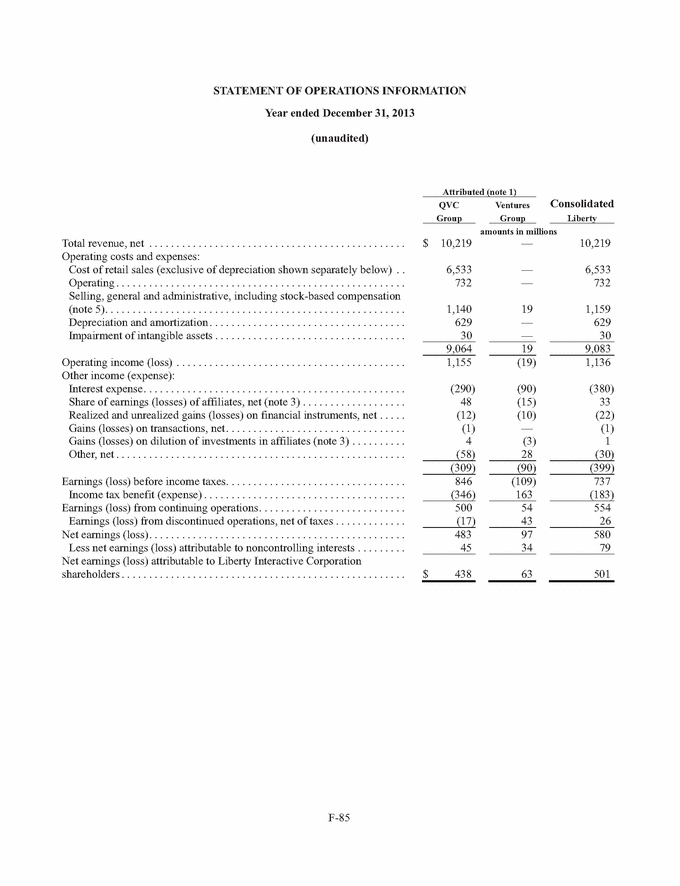
STATEMENT OF CASH FLOWS INFORMATION Year ended December 31, 2015 (unaudited) Attributed (note 1) QVC Group Ventures Group Consolidated Liberty amounts in millions Cash flows from operating activities: Net earnings (loss) Adjustments to reconcile net earnings to net cash provided by operating activities: Depreciation and amortization Stock-based compensation Cash payments for stock-based compensation Excess tax benefit from stock-based compensation Noncash interest expense Share of (earnings) losses of affiliates, net Cash receipts from returns on equity investments Realized and unrealized (gains) losses on financial instruments, net (Gains) losses on transactions, net (Gains) losses on dilution of investments in affiliates (Gains) losses on extinguishment of debt Deferred income tax expense (benefit). Intergroup tax allocation. Intergroup tax payments Other noncash charges (credits), net. Changes in operating assets and liabilities Current and other assets Payables and other liabilities Net cash provided (used) by operating activities. Cash flows from investing activities: Cash paid for acquisitions, net of cash acquired Cash proceeds from dispositions. Investment in and loans to cost and equity investees Cash receipts from returns of equity investments Capital expended for property and equipment Purchases of short term investments and other marketable securities Sales of short term investments and other marketable securities Other investing activities, net Net cash provided (used) by investing activities Cash flows from financing activities: Borrowings of debt Repayments of debt. Repurchases of QVC Group common stock Minimum withholding taxes on net share settlements of stock-based compensation Excess tax benefit from stock-based compensation Purchase of noncontrolling interest. Other financing activities, net Net cash provided (used) by financing activities Effect of foreign currency exchange rates on cash Net increase (decrease) in cash and cash equivalents Cash and cash equivalents at beginning of period Cash and cash equivalents at end of period $ 674 237 911 657 60 — (24) 6 (55) 22 (42) — — 21 (122) 141 (101) (14) 46 67 (16) (9) (1) 115 30 (72) (110) (314) — 173 (141) 101 (2) 703 127 (16) (33) 5 60 52 (114) (110) (314) 21 51 — — (16) (245) 3 8 (47) (237) (44) 981 65 1,046 (824) — — 200 (218) (184) 193 (76) (20) 271 (143) 50 (40) (1,186) 1,166 — (844) 271 (143) 250 (258) (1,370) 1,359 (76) (909) 98 (811) 3,969 (3,244) (785) 589 (567) — 4,558 (3,811) (785) (25) 24 — (4) (5) 9 (33) (17) (30) 33 (33) (21) (65) (24) (89) (3) — (3) 4 422 139 1,884 143 2,306 $ 426 2,023 2,449 F-86
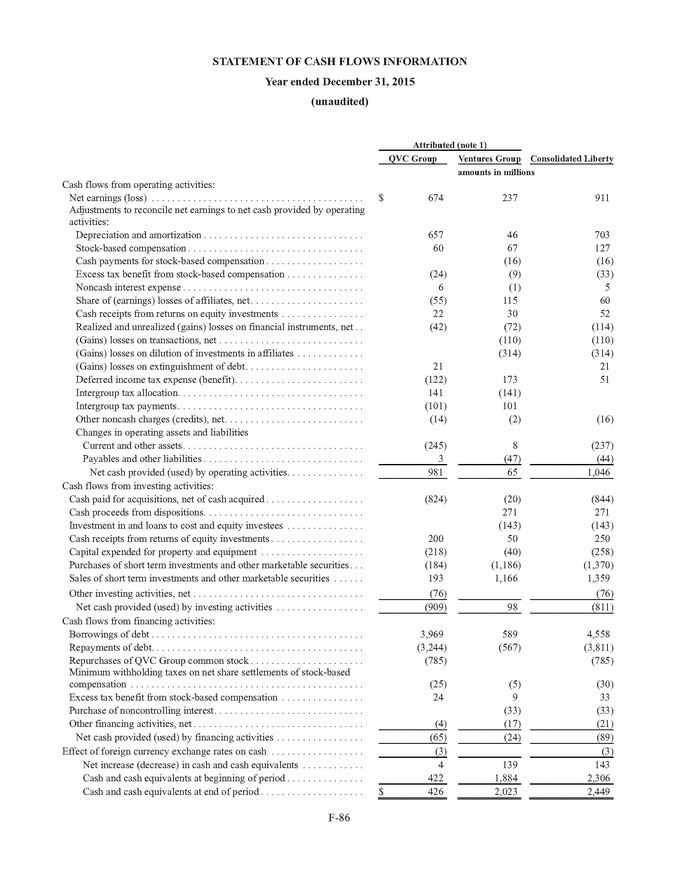
STATEMENT OF CASH FLOWS INFORMATION Year ended December 31, 2014 (unaudited) Attributed (note 1) Consolidated Liberty QVC Group Ventures Group amounts in millions Cash flows from operating activities: Net earnings (loss). Adjustments to reconcile net earnings to net cash provided by operating activities: (Earnings) loss from discontinued operations Depreciation and amortization Stock-based compensation Cash payments for stock-based compensation Excess tax benefit from stock-based compensation Noncash interest expense Share of losses (earnings) of affiliates, net Cash receipts from return on equity investments Realized and unrealized gains (losses) on financial instruments, net (Gains) losses on transactions, net. (Gains) losses on dilution of investments in affiliates (Gains) losses on extinguishment of debt Impairment of intangible assets. Deferred income tax (benefit) expense Intergroup tax allocation Intergroup tax payments Other noncash charges (credits), net Changes in operating assets and liabilities Current and other assets Payables and other current liabilities Net cash provided (used) by operating activities. Cash flows from investing activities: Cash proceeds from dispositions Investments in and loans to cost and equity investees Capital expended for property and equipment Purchases of short term and other marketable securities. Sales of short term investments and other marketable securities. Other investing activities, net Net cash provided (used) by investing activities Cash flows from financing activities: Borrowings of debt Repayments of debt Intergroup receipts (payments), net Repurchases of Liberty Interactive common stock Minimum withholding taxes on net share settlements of stock-based compensation Excess tax benefit from stock-based compensation Other financing activities, net Net cash provided (used) by financing activities. Effect of foreign currency rates on cash Net cash provided (used) by discontinued operations: Cash provided (used) by operating activities Cash provided (used) by investing activities Cash provided (used) by financing activities Change in available cash held by discontinued operations Net cash provided (used) by discontinued operations Net increase (decrease) in cash and cash equivalents Cash and cash equivalents at beginning of period Cash and cash equivalents at end period $ 559 67 626 15 643 83 (13) (20) 6 (51) 22 22 — 2 48 7 (160) 169 (388) (5) (63) 19 25 (2) (1) — 12 23 35 (74) — — — 119 (169) 388 1 (48) 662 108 (15) (21) 6 (39) 45 57 (74) 2 48 7 (41) — — (4) (80) 345 (4) 60 (84) 405 1,204 436 1,640 — (4) (226) (73) 52 (30) 163 (87) (15) (791) 539 14 163 (91) (241) (864) 591 (16) (281) (177) (458) 4,360 (3,563) (1,035) (785) 146 (186) 1,035 — 4,506 (3,749) — (785) (25) 20 (8) (1) 1 (25) (26) 21 (33) (1,036) 970 (66) (46) — (46) (20) — 3 3 293 (194) 368 (119) 273 (194) 371 (116) (14) 348 334 (173) 595 1,577 307 1,404 902 $ 422 1,884 2,306 F-87
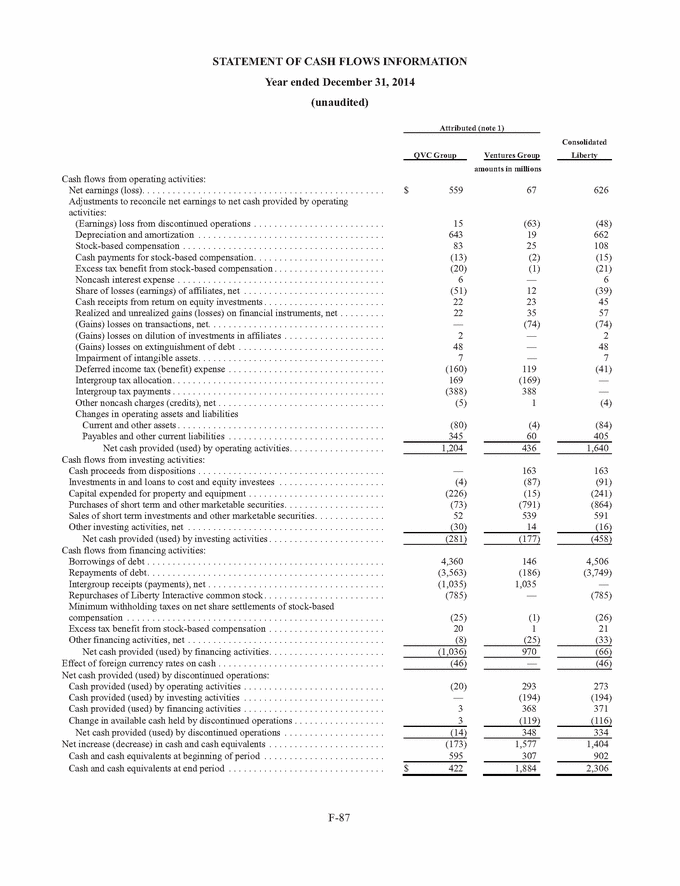
STATEMENT OF CASH FLOWS INFORMATION Year ended December 31, 2013 (unaudited) Attributed (note 1) Consolidated Liberty QVC Group Ventures Group amounts in millions Cash flows from operating activities: Net earnings (loss) Adjustments to reconcile net earnings to net cash provided by operating activities: (Earnings) loss from discontinued operations Depreciation and amortization Stock-based compensation Cash payments for stock-based compensation. Excess tax benefit from stock-based compensation Noncash interest expense Share of losses (earnings) of affiliates, net Cash receipts from return on equity investments Realized and unrealized gains (losses) on financial instruments, net (Gains) losses on transactions, net (Gains) losses on dilution of investments in affiliates (Gains) losses on extinguishment of debt Impairment of intangible assets Deferred income tax (benefit) expense Intergroup tax allocation Intergroup tax payments. Other noncash charges (credits), net Changes in operating assets and liabilities Current and other assets Payables and other current liabilities Net cash provided (used) by operating activities Cash flows from investing activities: Cash proceeds from dispositions Investments in and loans to cost and equity investees. Capital expended for property and equipment Cash paid for acquisitions, net of cash acquired Purchases of short term investments and other marketable securities Sales of short term investments and other marketable securities Other investing activities, net Net cash provided (used) by investing activities Cash flows from financing activities: Borrowings of debt Repayments of debt Repurchases of Liberty common stock Minimum withholding taxes on net share settlements of stock-based compensation Excess tax benefit from stock-based compensation Other financing activities, net Net cash provided (used) by financing activities Effect of foreign currency rates on cash Net cash provided (used) by discontinued operations: Cash provided (used) by operating activities Cash provided (used) by investing activities Cash provided (used) by financing activities Change in available cash held by discontinued operations Net cash provided (used) by discontinued operations Net increase (decrease) in cash and cash equivalents Cash and cash equivalents at beginning of period Cash and cash equivalents at end period $ 483 97 580 17 629 110 (8) (13) 12 (48) 16 12 1 (4) 57 30 (132) 272 (52) (10) (43) — 8 — — 1 15 19 10 — 3 — — 110 (272) 52 8 (26) 629 118 (8) (13) 13 (33) 35 22 1 (1) 57 30 (22) — — (2) (81) (306) (3) 37 (84) (269) 985 42 1,027 1 (4) (291) (24) — — (38) 1,136 (380) — — (959) 400 (3) 1,137 (384) (291) (24) (959) 400 (41) (356) 194 (162) 3,520 (3,052) (1,089) (21) 13 (57) 841 (2,363) — — — — 4,361 (5,415) (1,089) (21) 13 (57) (686) (1,522) (2,208) (24) — (24) (13) (6) (1) (2) 346 (192) (171) 17 333 (198) (172) 15 (22) — (22) (103) 698 (1,286) 1,593 (1,389) 2,291 $ 595 307 902 F-88
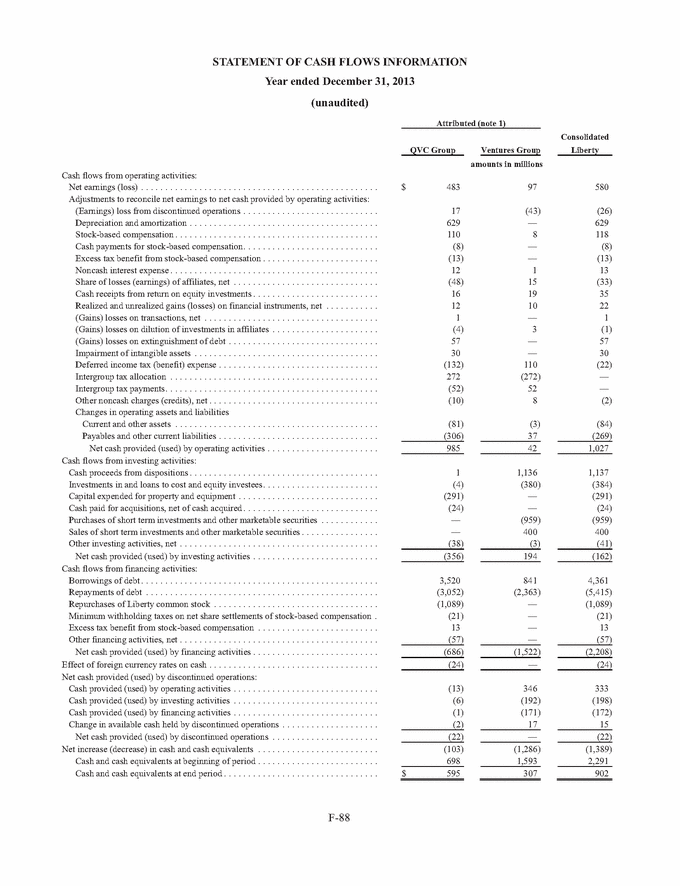
Notes to Attributed Financial Information (unaudited) (1) On October 3, 2014, Liberty reattributed from the QVC Group to the Ventures Group its Digital Commerce companies, which were valued at $1.5 billion, and approximately $1 billion in cash. In connection with the reattribution, each holder of Liberty Interactive common stock received 0.14217 of a share of the corresponding series of Liberty Ventures common stock for each share of Liberty Interactive common stock held as of the record date, with cash paid in lieu of fractional shares. The distribution date for the dividend was on October 20, 2014, and the Liberty Interactive common stock began trading ex-dividend on October 15, 2014. The reattribution of the Digital Commerce companies is presented on a prospective basis from the date of the reattribution in Liberty’s consolidated financial statements, with October 1, 2014 used as a proxy for the date of the reattribution. Accordingly, the financial results of the Digital Commerce companies are reflected in the QVC Group through the period ending September 30, 2014 and are reflected in the Ventures group for the period beginning October 1, 2014. Subsequent to the reattribution, the QVC Group is comprised of our consolidated subsidiaries, QVC and zulily (as of October 1, 2015), and our interest in HSN, Inc. Accordingly, the accompanying attributed financial information for the QVC Group includes the foregoing investment, as well as the assets, liabilities, revenue, expenses and cash flows of QVC and zulily. We have also attributed certain of our debt obligations (and related interest expense) to the QVC Group based upon a number of factors, including the cash flow available to the QVC Group and its ability to pay debt service and our assessment of the optimal capitalization for the QVC Group. The specific debt obligations attributed to each of the QVC Group and the Ventures Group are described in note 4 below. In addition, we have allocated certain corporate general and administrative expenses between the QVC Group and the Ventures Group as described in note 5 below. The QVC Group is primarily comprised of our merchandise-focused televised-shopping programs, Internet and mobile application businesses. Accordingly, we expect that businesses that we may acquire in the future that we believe are complementary to this strategy will also be attributed to the QVC Group. Subsequent to the reattribution, the Ventures Group consists of all of our businesses not included in the QVC Group including our Digital Commerce businesses and interests in equity method investments of Expedia, Inc., FTD, Interval Leisure Group, Inc. and LendingTree and available-for-sale securities, Time Warner and Time Warner Cable. Accordingly, the accompanying attributed financial information for the Ventures Group includes these investments, as well as the assets, liabilities, revenue, expenses and cash flows of the Digital Commerce businesses. In addition, we have attributed to the Ventures Group all of our senior exchangeable debentures (and related interest expense). See note 4 below for the debt obligations attributed to the Ventures Group. Any businesses that we may acquire in the future that we do not attribute to the QVC Group will be attributed to the Ventures Group. F-89
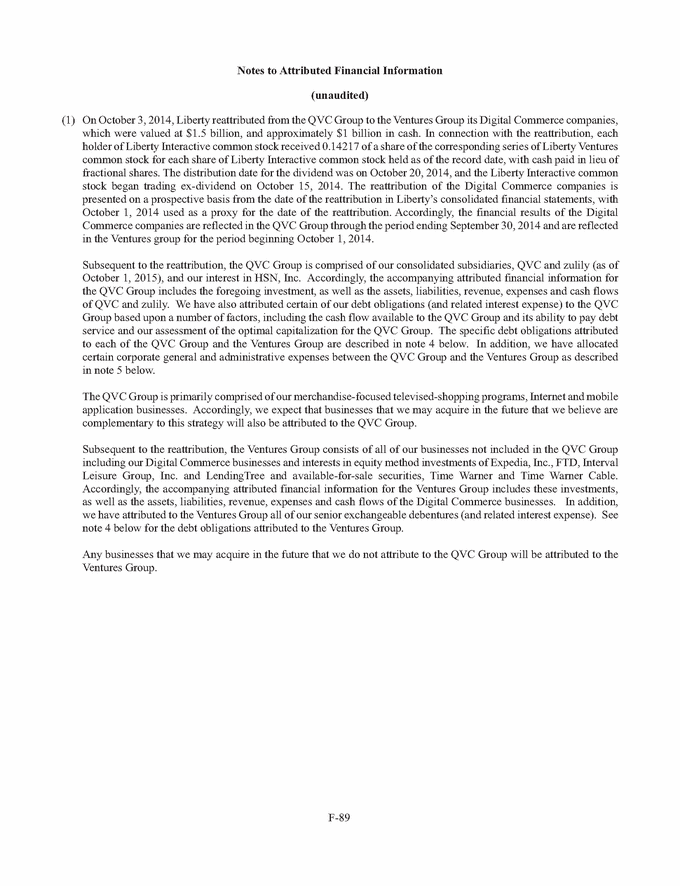
(2) Investments in available-for-sale securities, including non-strategic securities, and other cost investments are summarized as follows: December 31, 2015 December 31, 2014 amounts in millions QVC Group Other cost investments Total QVC Group Ventures Group Time Warner Inc. Time Warner Cable Inc. Other AFS investments Total Ventures Group Consolidated Liberty $ 4 4 4 4 284 994 71 375 815 30 1,349 1,220 $ 1,353 1,224 (3) The following table presents information regarding certain equity method investments: Share of earnings (losses) December 31, 2015 Percentage ownership Carrying value Market value Years ended December 31, 2015 2014 2013 dollar amounts in millions QVC Group HSN, Inc. (2) Other Total QVC Group Ventures Group Expedia, Inc. (1)(2) FTD (3) Other (4) Total Ventures Group Consolidated Liberty 38 % various $ 165 43 1,014 N/A 64 (9) 60 (9) 61 (13) 208 55 51 48 16 % 37 % various 927 267 239 2,934 267 N/A 118 (83) (150) 58 N/A (70) 31 N/A (46) 1,433 (115) (12) (15) $ 1,641 (60) 39 33 (1) Liberty owns an approximate 16% equity interest and 52% voting interest in Expedia. Liberty has entered into governance arrangements pursuant to which Mr. Barry Diller, Chairman of the Board and Senior Executive Officer of Expedia, may vote its interests of Expedia, subject to certain limitations. Additionally, through our governance arrangements with Mr. Diller, we have the right to appoint and have appointed 20% of the members of Expedia's board of directors, which is currently comprised of 13 members. Therefore, we determined based on these arrangements that we have significant influence through our arrangements with Expedia and have accounted for the investment as an equity method affiliate. The increase in our share of Expedia’s earnings during the year ended December 31, 2015 is primarily due to our share of a significant gain recognized by Expedia related to the sale of one of its subsidiaries. During the years ended December 31, 2015, 2014 and 2013, Expedia, Inc. paid dividends aggregating $20 million, $15 million and $13 million, respectively and HSN, Inc. (“HSNi”) paid dividends of $228 million, $22 million and $16 million during the years ended December 31, 2015, 2014 and 2013, respectively, which were recorded as reductions to the investment balances. Dividends from HSNi during the year ended December 31, 2015 included a special dividend of $10 per share from which Liberty received approximately $200 million in cash. FTD acquired Liberty’s formerly wholly-owned subsidiary, Provide, on December 31, 2014. In exchange for Provide, Liberty received approximately 10.2 million shares of FTD common stock representing approximately 35% of the combined company and approximately $145 million in cash. Subsequent to completion of the transaction, Liberty accounts for FTD as an equity-method affiliate based on the ownership level and board representation. The carrying (2) (3) F-90
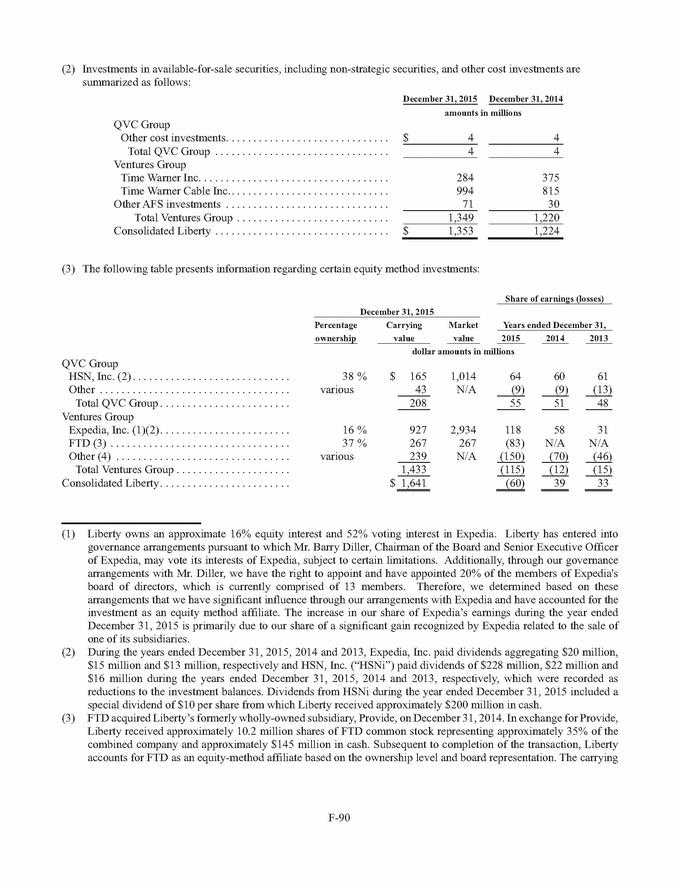
value of Liberty’s investment in FTD was impaired to the fair value (based on the closing price (level 1)) as of December 31, 2015. (4) The Other category for the Ventures Group is comprised of investments in LendingTree, Interval Leisure Group, alternative energy investments and other investments. The alternative energy investments generally operate at a loss but provide favorable tax attributes recorded through the income tax (expense) benefit line item in the consolidated statement of operations. During the year ended December 31, 2015, Liberty recorded an impairment of approximately $98 million, based on a discounted cash flow valuation (level 3), related to one of its alternative energy investments which has underperformed operationally. Liberty recognized gains on dilution of investments in affiliates of $314 million during the year ended December 31, 2015, losses of $2 million during the year ended December 31, 2014 and gains of $1 million during the year ended December 31, 2013. The significant dilution gain in 2015 is due to an acquisition by Expedia that was executed through the issuance of stock. This diluted Liberty’s ownership percentage at a price greater than our basis. (4) Debt attributed to the QVC Group and the Ventures Group is comprised of the following: December 31, 2015 Outstanding principal Carrying value amounts in millions QVC Group Corporate level notes and debentures 8.5% Senior Debentures due 2029 8.25% Senior Debentures due 2030 1% Exchangeable Senior Debentures due 2043 Subsidiary level notes and facilities QVC 3.125% Senior Secured Notes due 2019. QVC 5.125% Senior Secured Notes due 2022. QVC 4.375% Senior Secured Notes due 2023. QVC 4.85% Senior Secured Notes due 2024 QVC 4.45% Senior Secured Notes due 2025 QVC 5.45% Senior Secured Notes due 2034 QVC 5.95% Senior Secured Notes due 2043 QVC Bank Credit Facilities Other subsidiary debt Deferred loan costs Total QVC Group Ventures Group Corporate level debentures 4% Exchangeable Senior Debentures due 2029 3.75% Exchangeable Senior Debentures due 2030 3.5% Exchangeable Senior Debentures due 2031 0.75% Exchangeable Senior Debentures due 2043 Subsidiary level notes and facilities Other subsidiary debt Total Ventures Group Total consolidated Liberty debt. Less debt classified as current Total long-term debt $ 287 504 346 285 501 349 400 500 750 600 600 400 300 1,815 72 399 500 750 600 599 399 300 1,815 72 (34) 6,574 6,535 437 437 346 850 257 275 312 1,287 41 41 2,111 2,172 $ 8,685 8,707 (1,226) 7,481 (5) Cash compensation expense for our corporate employees will be allocated among the QVC Group and the Ventures Group based on the estimated percentage of time spent providing services for each group. On a semi-F-91
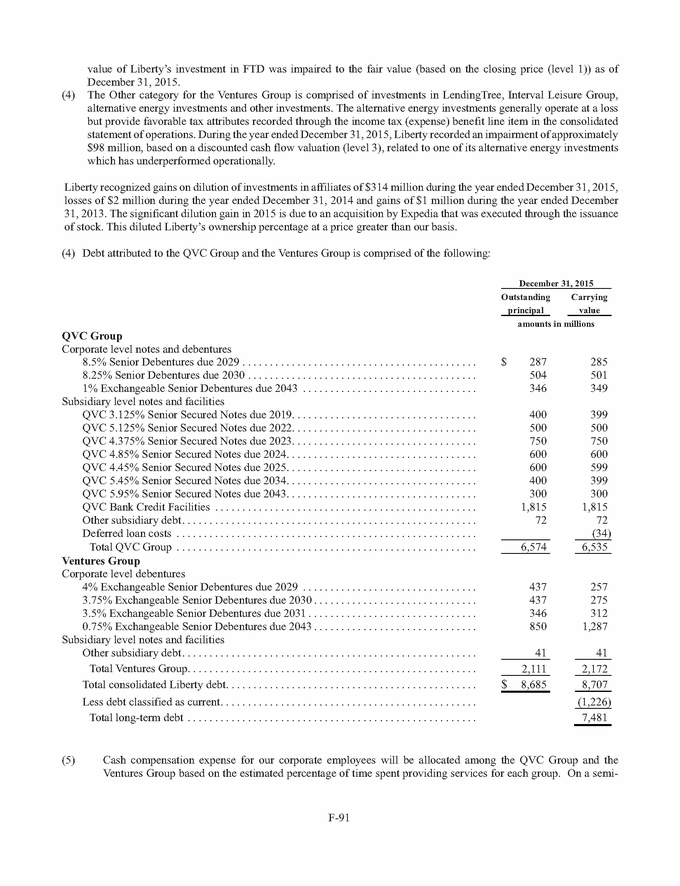
annual basis estimated time spent will be determined through an interview process and a review of personnel duties unless transactions significantly change the composition of companies and investments in either respective group which would require a more timely reevaluation of estimated time spent. Other general and administrative expenses will be charged directly to the groups whenever possible and are otherwise allocated based on estimated usage or some other reasonably determined methodology. Amounts allocated from the QVC Group to the Ventures Group was determined to be $20 million, $18 million and $11 million for the years ended December 31, 2015, 2014 and 2013, respectively. We note that stock compensation related to each tracking stock group is determined based on actual options outstanding for each respective tracking stock group, therefore, as it relates to periods prior to the LMC Split-Off (as defined in note 1 to the accompanying consolidated financial statements), no stock compensation expense was recognized by the Ventures group. While we believe that this allocation method is reasonable and fair to each group, we may elect to change the allocation methodology or percentages used to allocate general and administrative expenses in the future. (6) We have accounted for income taxes for the QVC Group and the Ventures Group in the accompanying attributed financial information in a manner similar to a stand-alone company basis. To the extent this methodology differs from our tax sharing policy, differences have been reflected in the attributed net assets of the groups. QVC Group Income tax benefit (expense) consists of: Years ended December 31, 2015 2014 2013 amounts in millions Current: Federal State and local Foreign $ (331) (20) (75) (325) (31) (110) (370) (26) (82) $ (426) (466) (478) Deferred: Federal State and local Foreign $ 101 14 7 143 12 5 195 (57) (6) 122 160 132 Income tax benefit (expense) $ (304) (306) (346) F-92
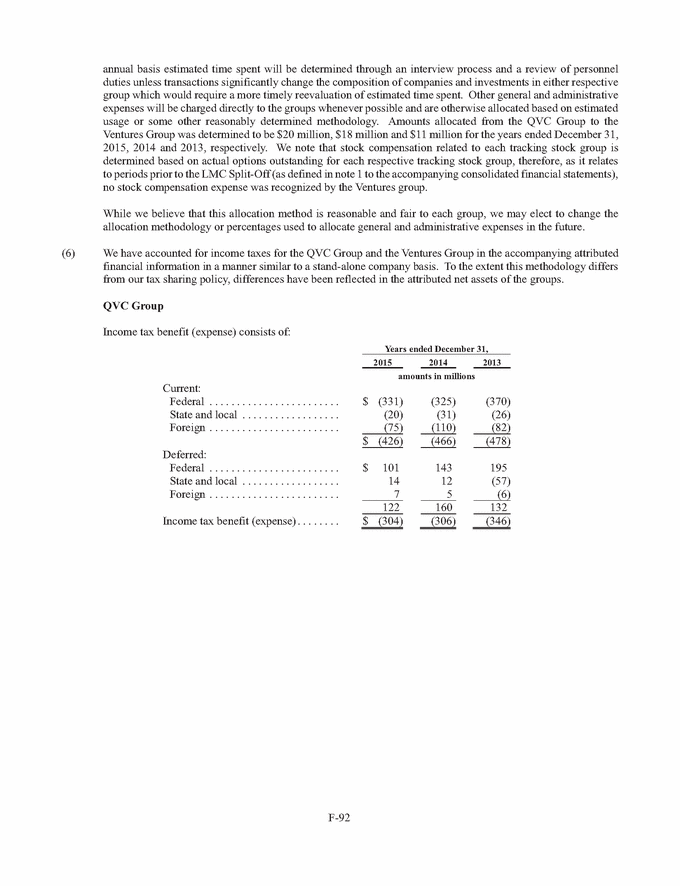
Income tax benefit (expense) differs from the amounts computed by applying the U.S. federal income tax rate of 35% as a result of the following: Years ended December 31, 2015 2014 2013 amounts in millions (308) (14) (2) 14 2 Computed expected tax benefit (expense) State and local income taxes, net of federal income taxes Foreign taxes, net of foreign tax credits Sale of consolidated subsidiary Change in valuation allowance affecting tax expense Impairment of intangible assets not deductible for tax purposes Dividends received deductions Impact of change in state rate on deferred taxes Other, net Income tax benefit (expense) $ (343) (296) (24) (7) — (23) (12) (5) — 2 — 49 (4) 9 (3) 4 1 — (2) 5 3 (2) $ (304) (306) (346) The tax effects of temporary differences that give rise to significant portions of the deferred income tax assets and deferred income tax liabilities are presented below: December 31, 2015 2014 amounts in millions Deferred tax assets: Net operating and capital loss carryforwards Foreign tax credit carryforwards Accrued stock compensation Other accrued liabilities Other future deductible amounts Deferred tax assets Valuation allowance Net deferred tax assets $ 44 71 39 161 150 40 88 18 177 154 465 (44) 477 (46) 421 431 Deferred tax liabilities: Intangible assets Other deferred tax liabilities Deferred tax liabilities Net deferred tax liabilities 1,765 15 1,242 23 1,780 1,265 $ 1,359 834 F-93
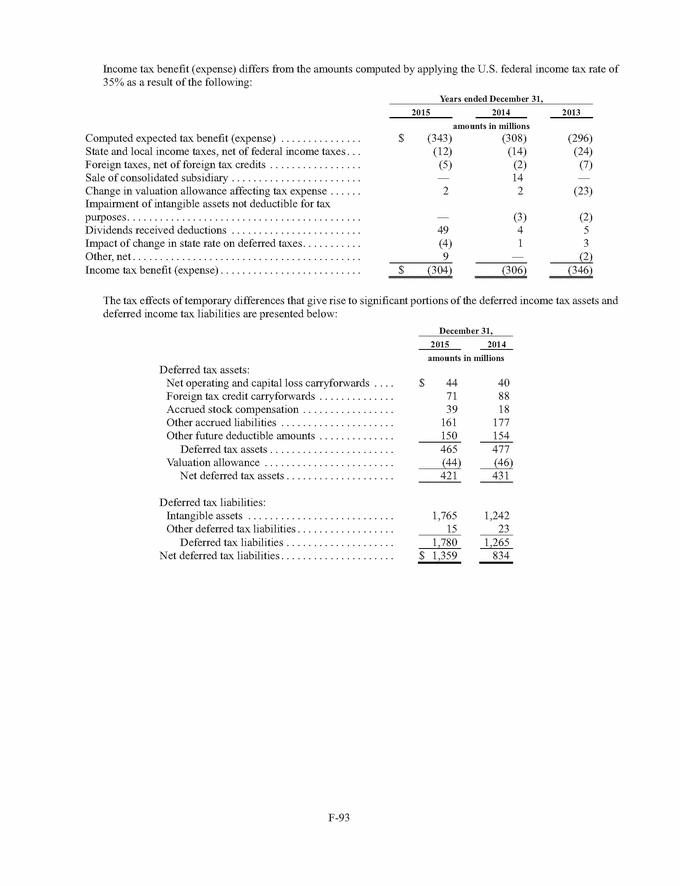
The Company's deferred tax assets and liabilities are reported in the accompanying balance sheet information as follows: Ventures Group Income tax benefit (expense) consists of: Years ended December 31, 2015 2014 2013 amounts in millions Current: Federal State and local Foreign $ 140 (6) 1 168 (1) — 273 — — $ 135 167 273 Deferred: Federal State and local Foreign $ (168) (6) 1 (84) (35) — (214) 104 — (173) (119) (110) Income tax benefit (expense) $ (38) 48 163 Income tax benefit (expense) differs from the amounts computed by applying the U.S. federal income tax rate of 35% as a result of the following: Years ended December 31, 2015 2014 2013 amounts in millions Computed expected tax benefit (expense) State and local income taxes, net of federal income taxes Foreign taxes, net of foreign tax credits Impact of change in state rate on deferred taxes Change in valuation allowance affecting tax expense Dividends received deductions Alternative energy tax credits Other, net Income tax benefit (expense) $ (96) (12) 1 (3) 4 7 61 — 15 7 — (29) (4) 6 58 (5) 38 9 — 63 (4) 4 54 (1) $ (38) 48 163 F-94
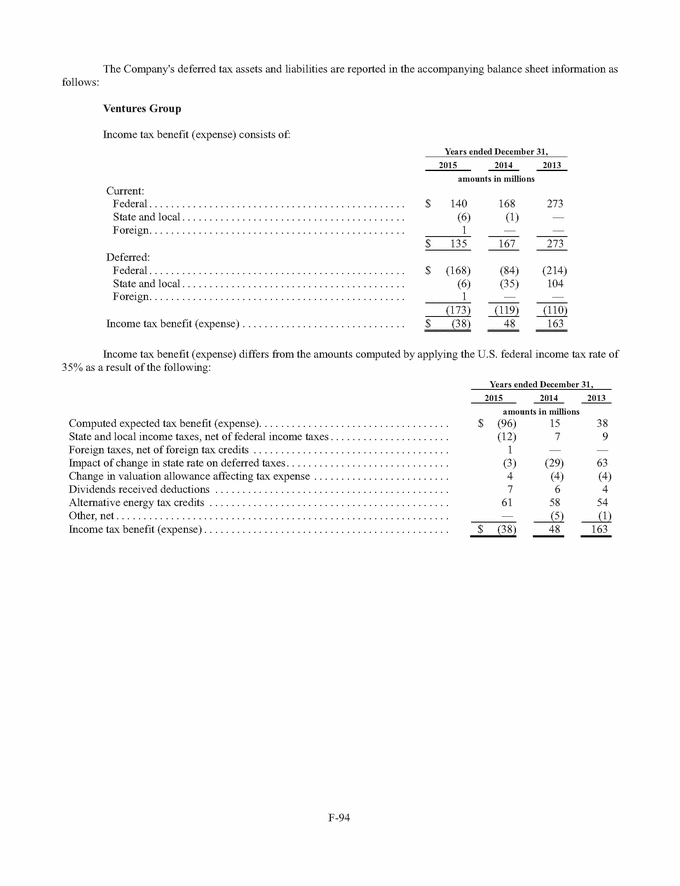
The tax effects of temporary differences that give rise to significant portions of the deferred income tax assets and deferred income tax liabilities are presented below: December 31, 2015 2014 amounts in millions Deferred tax assets: Net operating and capital loss carryforwards Accrued stock compensation Other future deductible amounts Deferred tax assets Valuation allowance Net deferred tax assets $ 55 44 18 50 24 15 117 (4) 89 (8) 113 81 Deferred tax liabilities: Investments Intangible assets Discount on exchangeable debentures. Deferred gain on debt retirements Other deferred tax liabilities Deferred tax liabilities Net deferred tax liabilities 908 23 1,129 193 3 746 43 1,022 257 — 2,256 2,068 $ 2,143 1,987 Intergroup payable (receivable) The intergroup balances, at December 31, 2015 and 2014, are primarily a result of timing of tax benefits. (7) The QVC Group Stock and the Liberty Ventures Stock have voting and conversion rights under our restated charter. Following is a summary of those rights. Holders of Series A common stock of each group is entitled to one vote per share, and holders of Series B common stock of each group are entitled to ten votes per share. Holders of Series C common stock of each group, if issued, are entitled to 1/100th of a vote per share in certain limited cases and will otherwise not be entitled to vote. In general, holders of Series A and Series B common stock will vote as a single class. In certain limited circumstances, the board may elect to seek the approval of the holders of only Series A and Series B QVC Group Stock or the approval of the holders of only Series A and Series B Liberty Ventures Stock. At the option of the holder, each share of Series B common stock will be convertible into one share of Series A common stock of the same group. At the discretion of our board, the common stock related to one group may be converted into common stock of the same series that is related to the other group. F-95
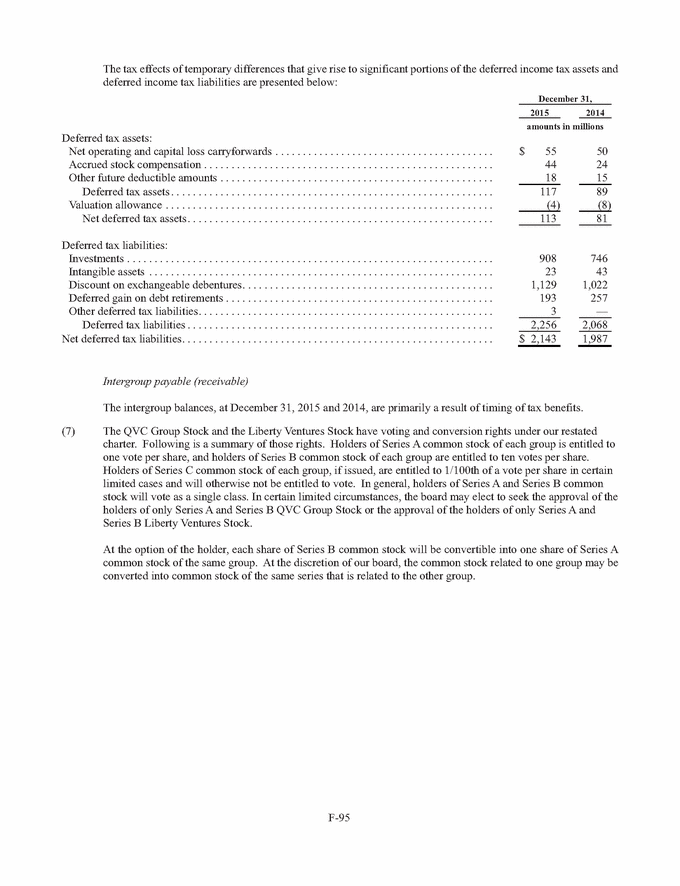
This page has been intentionally left blank.

BOARD OF DIRECTORS John C. Malone Chairman of the Board Liberty Interactive Corporation EXECUTIVE COMMITTEE Michael A. George Gregory B. Maffei John C. Malone STOCK INFORMATION Series A and B QVC Group Common Stock (QVCA/B) and Series A and B Liberty Ventures Common Stock (LVNTA/B) trade on the NASDAQ Global Select Market. Michael A. George President and Chief Executive Officer QVC, Inc. COMPENSATION COMMITTEE M. Ian G. Gilchrist (Chairman) David E. Rapley Andrea L. Wong CUSIP NUMBERS QVCA – 53071M 104 QVCB – 53071M 203 LVNTA – 53071M 880 LVNTB – 53071M 872 M. Ian G. Gilchrist Retired Investment Banker AUDIT COMMITTEE M. LaVoy Robison (Chairman) M. Ian G. Gilchrist David E. Rapley Larry E. Romrell Gregory B. Maffei President and Chief Executive Officer Liberty Interactive Corporation TRANSFER AGENT Liberty Interactive Corporation Shareholder Services c/o Computershare P.O. Box 43023 Providence, RI 02940-3023 Phone: (781) 575-4593 Toll free: (866) 367-6355 www.computershare.com Telecommunication Device for the Deaf (TDD) (800) 952-9245 NOMINATING & CORPORATE GOVERNANCE COMMITTEE David E. Rapley (Chairman) M. Ian G. Gilchrist Larry E. Romrell Mark Vadon Andrea L. Wong Evan D. Malone, Ph.D. President NextFab Studio, LLC David E. Rapley Retired President and Chief Executive Officer Rapley Consulting, Inc. SENIOR OFFICERS John C. Malone Chairman of the Board INVESTOR RELATIONS Courtnee Chun investor@libertyinteractive.com (866) 876-0461 M. LaVoy Robison Director The Anschutz Foundation Gregory B. Maffei President and Chief Executive Officer Larry E. Romrell Retired Executive Vice President Tele-Communications, Inc. ON THE INTERNET Visit the Liberty Interactive Corporation website at www.libertyinteractive.com Richard N. Baer Chief Legal Officer Mark Vadon Co-Founder and Former Chairman of the Board zulily Mark D. Carleton Chief Development Officer FINANCIAL STATEMENTS Liberty Interactive Corporation financial statements are filed with the Securities and Exchange Commission. Copies of these financial statements can be obtained from the Transfer Agent or through the Liberty Interactive Corporation website. Albert E. Rosenthaler Chief Tax Officer Andrea L. Wong President, International Production Sony Pictures Television President, International Sony Pictures Entertainment Christopher W. Shean Chief Financial Officer CORPORATE SECRETARY Pamela L. Coe CORPORATE HEADQUARTERS 12300 Liberty Boulevard Englewood, CO 80112 (720) 875-5300 ANNU AL REPOR T 20 15
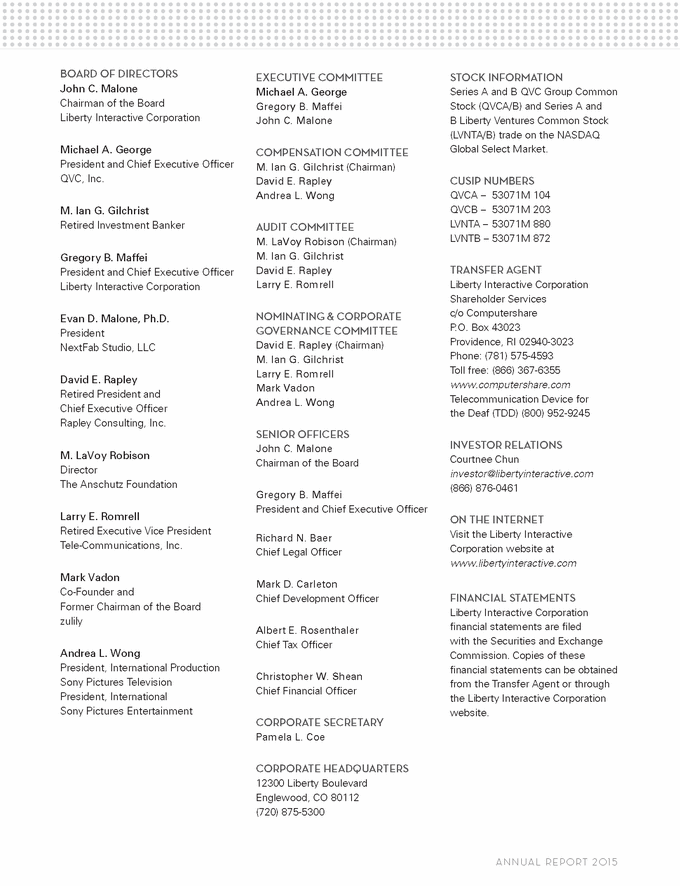
[LOGO]
